CPCCBC4007A Plan building or construction work Assessment Pack
VerifiedAdded on 2023/05/30
|72
|24805
|393
AI Summary
This assessment pack is for the unit CPCCBC4007A Plan building or construction work under the course Certificate IV in Building and Construction (Building) with student and trainer/assessor details, due date, submission date, and student declaration.
Contribute Materials
Your contribution can guide someone’s learning journey. Share your
documents today.
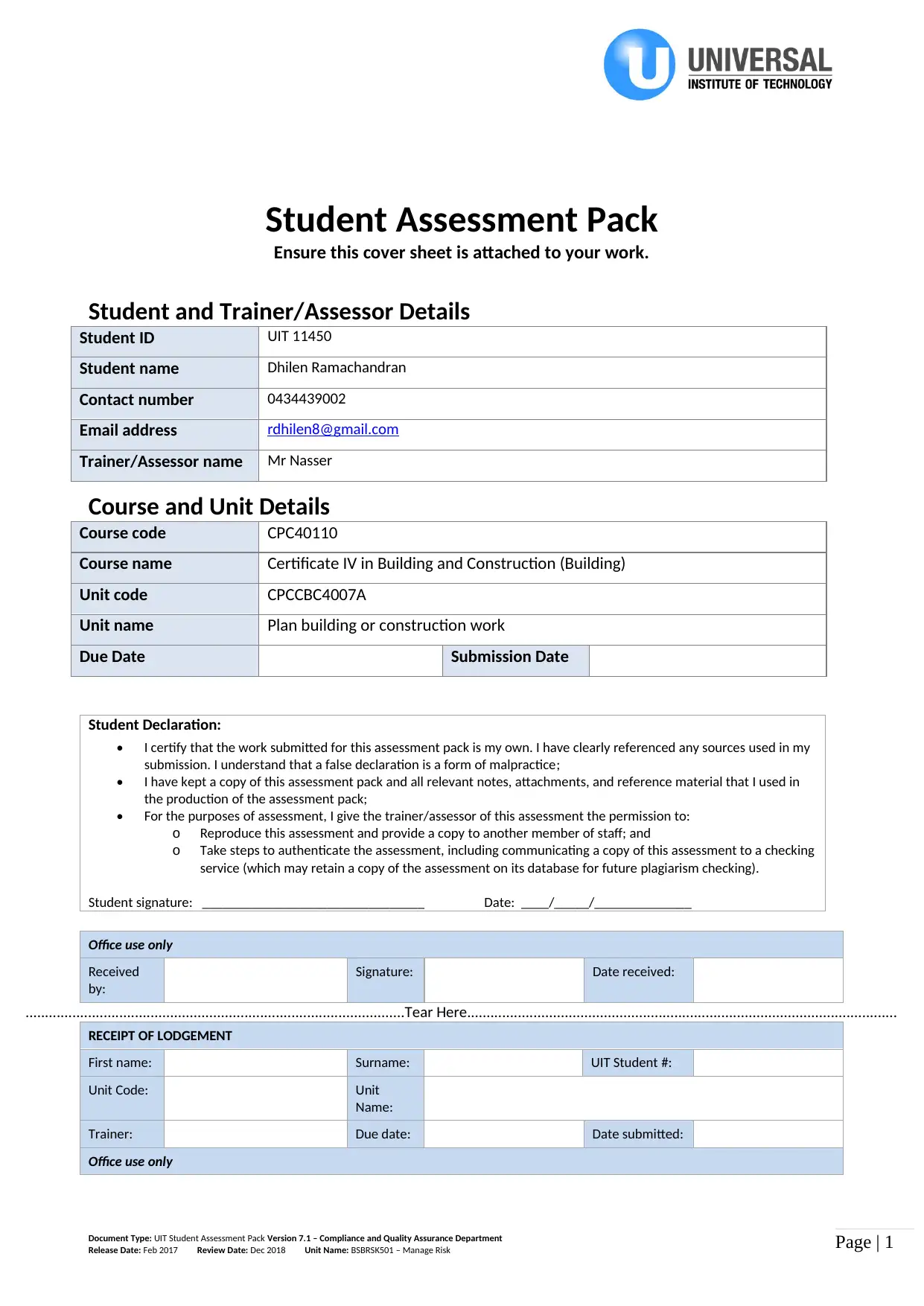
Page | 1
Student Assessment Pack
Ensure this cover sheet is attached to your work.
Student and Trainer/Assessor Details
Student ID UIT 11450
Student name Dhilen Ramachandran
Contact number 0434439002
Email address rdhilen8@gmail.com
Trainer/Assessor name Mr Nasser
Course and Unit Details
Course code CPC40110
Course name Certificate IV in Building and Construction (Building)
Unit code CPCCBC4007A
Unit name Plan building or construction work
Due Date Submission Date
Student Declaration:
• I certify that the work submitted for this assessment pack is my own. I have clearly referenced any sources used in my
submission. I understand that a false declaration is a form of malpractice;
• I have kept a copy of this assessment pack and all relevant notes, attachments, and reference material that I used in
the production of the assessment pack;
• For the purposes of assessment, I give the trainer/assessor of this assessment the permission to:
o Reproduce this assessment and provide a copy to another member of staff; and
o Take steps to authenticate the assessment, including communicating a copy of this assessment to a checking
service (which may retain a copy of the assessment on its database for future plagiarism checking).
Student signature: ________________________________ Date: ____/_____/______________
Office use only
Received
by:
Signature: Date received:
.................................................................................................Tear Here..............................................................................................................
RECEIPT OF LODGEMENT
First name: Surname: UIT Student #:
Unit Code: Unit
Name:
Trainer: Due date: Date submitted:
Office use only
Document Type: UIT Student Assessment Pack Version 7.1 – Compliance and Quality Assurance Department
Release Date: Feb 2017 Review Date: Dec 2018 Unit Name: BSBRSK501 – Manage Risk
Student Assessment Pack
Ensure this cover sheet is attached to your work.
Student and Trainer/Assessor Details
Student ID UIT 11450
Student name Dhilen Ramachandran
Contact number 0434439002
Email address rdhilen8@gmail.com
Trainer/Assessor name Mr Nasser
Course and Unit Details
Course code CPC40110
Course name Certificate IV in Building and Construction (Building)
Unit code CPCCBC4007A
Unit name Plan building or construction work
Due Date Submission Date
Student Declaration:
• I certify that the work submitted for this assessment pack is my own. I have clearly referenced any sources used in my
submission. I understand that a false declaration is a form of malpractice;
• I have kept a copy of this assessment pack and all relevant notes, attachments, and reference material that I used in
the production of the assessment pack;
• For the purposes of assessment, I give the trainer/assessor of this assessment the permission to:
o Reproduce this assessment and provide a copy to another member of staff; and
o Take steps to authenticate the assessment, including communicating a copy of this assessment to a checking
service (which may retain a copy of the assessment on its database for future plagiarism checking).
Student signature: ________________________________ Date: ____/_____/______________
Office use only
Received
by:
Signature: Date received:
.................................................................................................Tear Here..............................................................................................................
RECEIPT OF LODGEMENT
First name: Surname: UIT Student #:
Unit Code: Unit
Name:
Trainer: Due date: Date submitted:
Office use only
Document Type: UIT Student Assessment Pack Version 7.1 – Compliance and Quality Assurance Department
Release Date: Feb 2017 Review Date: Dec 2018 Unit Name: BSBRSK501 – Manage Risk
Secure Best Marks with AI Grader
Need help grading? Try our AI Grader for instant feedback on your assignments.
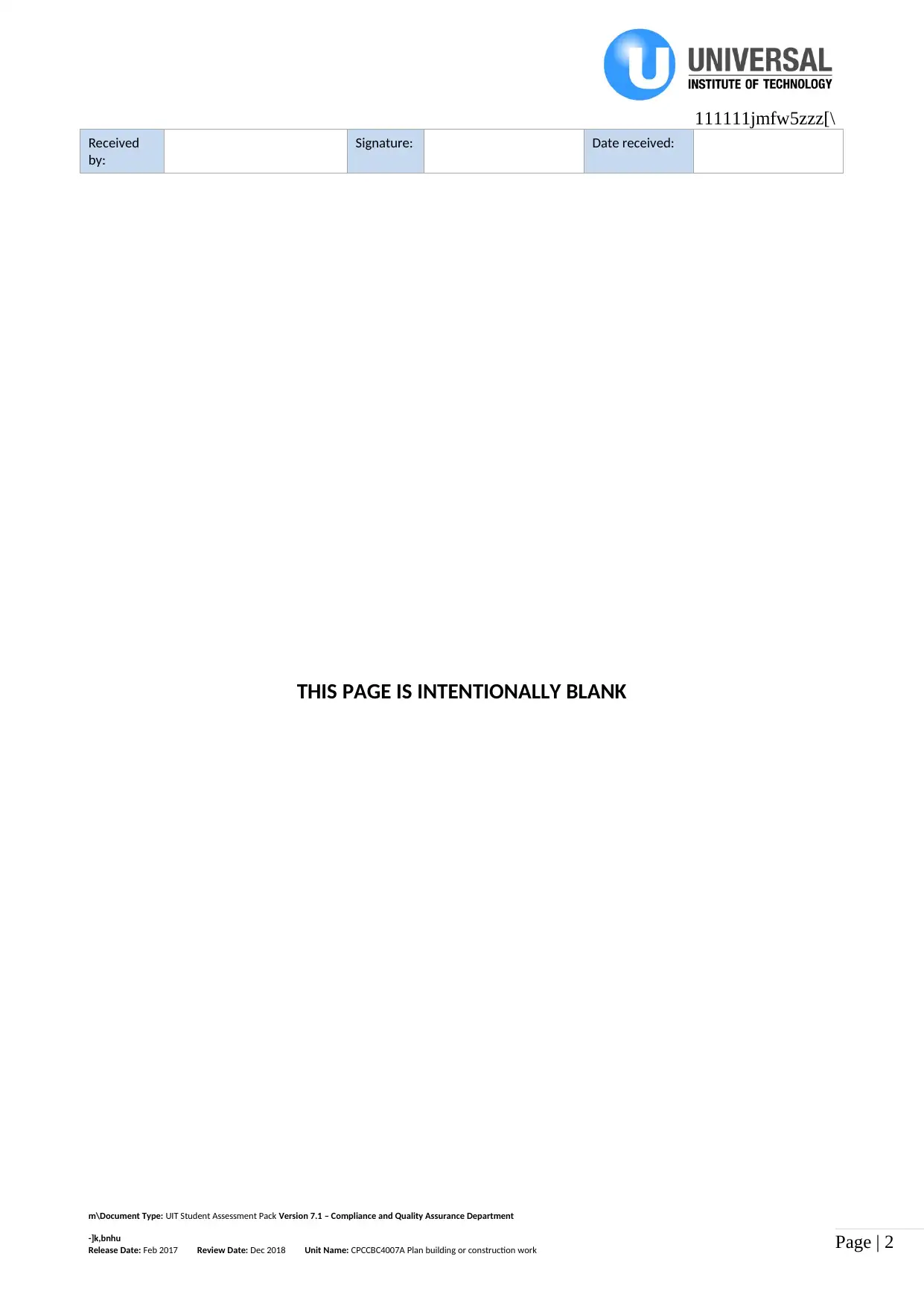
Page | 2
111111jmfw5zzz[\
Received
by:
Signature: Date received:
THIS PAGE IS INTENTIONALLY BLANK
m\Document Type: UIT Student Assessment Pack Version 7.1 – Compliance and Quality Assurance Department
-]k,bnhu
Release Date: Feb 2017 Review Date: Dec 2018 Unit Name: CPCCBC4007A Plan building or construction work
111111jmfw5zzz[\
Received
by:
Signature: Date received:
THIS PAGE IS INTENTIONALLY BLANK
m\Document Type: UIT Student Assessment Pack Version 7.1 – Compliance and Quality Assurance Department
-]k,bnhu
Release Date: Feb 2017 Review Date: Dec 2018 Unit Name: CPCCBC4007A Plan building or construction work
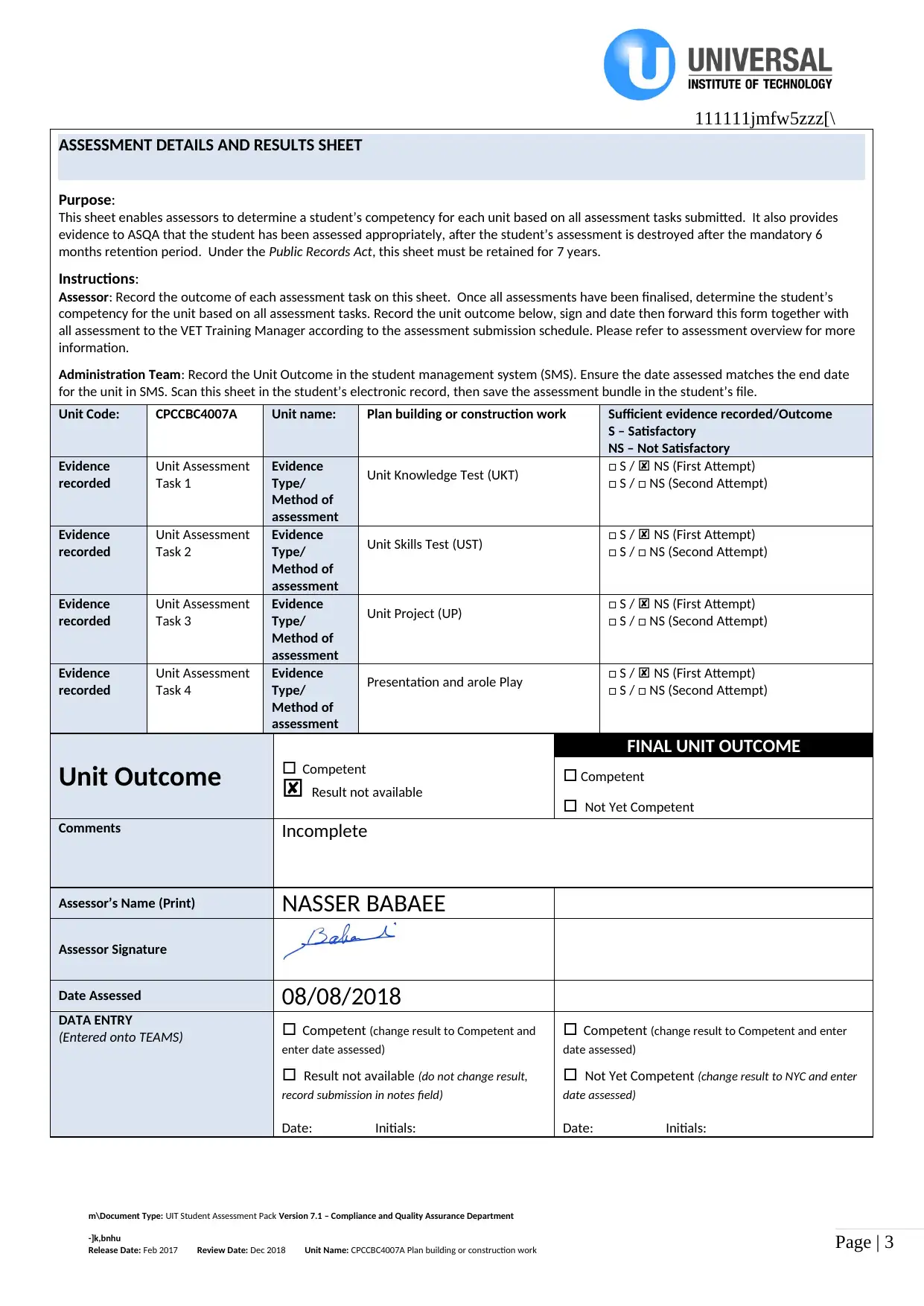
Page | 3
111111jmfw5zzz[\
ASSESSMENT DETAILS AND RESULTS SHEET
Purpose:
This sheet enables assessors to determine a student’s competency for each unit based on all assessment tasks submitted. It also provides
evidence to ASQA that the student has been assessed appropriately, after the student’s assessment is destroyed after the mandatory 6
months retention period. Under the Public Records Act, this sheet must be retained for 7 years.
Instructions:
Assessor: Record the outcome of each assessment task on this sheet. Once all assessments have been finalised, determine the student’s
competency for the unit based on all assessment tasks. Record the unit outcome below, sign and date then forward this form together with
all assessment to the VET Training Manager according to the assessment submission schedule. Please refer to assessment overview for more
information.
Administration Team: Record the Unit Outcome in the student management system (SMS). Ensure the date assessed matches the end date
for the unit in SMS. Scan this sheet in the student’s electronic record, then save the assessment bundle in the student’s file.
Unit Code: CPCCBC4007A Unit name: Plan building or construction work Sufficient evidence recorded/Outcome
S – Satisfactory
NS – Not Satisfactory
Evidence
recorded
Unit Assessment
Task 1
Evidence
Type/
Method of
assessment
Unit Knowledge Test (UKT) □ S / NS (First Attempt)
□ S / □ NS (Second Attempt)
Evidence
recorded
Unit Assessment
Task 2
Evidence
Type/
Method of
assessment
Unit Skills Test (UST) □ S / NS (First Attempt)
□ S / □ NS (Second Attempt)
Evidence
recorded
Unit Assessment
Task 3
Evidence
Type/
Method of
assessment
Unit Project (UP) □ S / NS (First Attempt)
□ S / □ NS (Second Attempt)
Evidence
recorded
Unit Assessment
Task 4
Evidence
Type/
Method of
assessment
Presentation and arole Play □ S / NS (First Attempt)
□ S / □ NS (Second Attempt)
Unit Outcome □ Competent
Result not available
FINAL UNIT OUTCOME
□ Competent
□ Not Yet Competent
Comments Incomplete
Assessor’s Name (Print) NASSER BABAEE
Assessor Signature
Date Assessed 08/08/2018
DATA ENTRY
(Entered onto TEAMS) □ Competent (change result to Competent and
enter date assessed)
□ Result not available (do not change result,
record submission in notes field)
Date: Initials:
□ Competent (change result to Competent and enter
date assessed)
□ Not Yet Competent (change result to NYC and enter
date assessed)
Date: Initials:
m\Document Type: UIT Student Assessment Pack Version 7.1 – Compliance and Quality Assurance Department
-]k,bnhu
Release Date: Feb 2017 Review Date: Dec 2018 Unit Name: CPCCBC4007A Plan building or construction work
111111jmfw5zzz[\
ASSESSMENT DETAILS AND RESULTS SHEET
Purpose:
This sheet enables assessors to determine a student’s competency for each unit based on all assessment tasks submitted. It also provides
evidence to ASQA that the student has been assessed appropriately, after the student’s assessment is destroyed after the mandatory 6
months retention period. Under the Public Records Act, this sheet must be retained for 7 years.
Instructions:
Assessor: Record the outcome of each assessment task on this sheet. Once all assessments have been finalised, determine the student’s
competency for the unit based on all assessment tasks. Record the unit outcome below, sign and date then forward this form together with
all assessment to the VET Training Manager according to the assessment submission schedule. Please refer to assessment overview for more
information.
Administration Team: Record the Unit Outcome in the student management system (SMS). Ensure the date assessed matches the end date
for the unit in SMS. Scan this sheet in the student’s electronic record, then save the assessment bundle in the student’s file.
Unit Code: CPCCBC4007A Unit name: Plan building or construction work Sufficient evidence recorded/Outcome
S – Satisfactory
NS – Not Satisfactory
Evidence
recorded
Unit Assessment
Task 1
Evidence
Type/
Method of
assessment
Unit Knowledge Test (UKT) □ S / NS (First Attempt)
□ S / □ NS (Second Attempt)
Evidence
recorded
Unit Assessment
Task 2
Evidence
Type/
Method of
assessment
Unit Skills Test (UST) □ S / NS (First Attempt)
□ S / □ NS (Second Attempt)
Evidence
recorded
Unit Assessment
Task 3
Evidence
Type/
Method of
assessment
Unit Project (UP) □ S / NS (First Attempt)
□ S / □ NS (Second Attempt)
Evidence
recorded
Unit Assessment
Task 4
Evidence
Type/
Method of
assessment
Presentation and arole Play □ S / NS (First Attempt)
□ S / □ NS (Second Attempt)
Unit Outcome □ Competent
Result not available
FINAL UNIT OUTCOME
□ Competent
□ Not Yet Competent
Comments Incomplete
Assessor’s Name (Print) NASSER BABAEE
Assessor Signature
Date Assessed 08/08/2018
DATA ENTRY
(Entered onto TEAMS) □ Competent (change result to Competent and
enter date assessed)
□ Result not available (do not change result,
record submission in notes field)
Date: Initials:
□ Competent (change result to Competent and enter
date assessed)
□ Not Yet Competent (change result to NYC and enter
date assessed)
Date: Initials:
m\Document Type: UIT Student Assessment Pack Version 7.1 – Compliance and Quality Assurance Department
-]k,bnhu
Release Date: Feb 2017 Review Date: Dec 2018 Unit Name: CPCCBC4007A Plan building or construction work
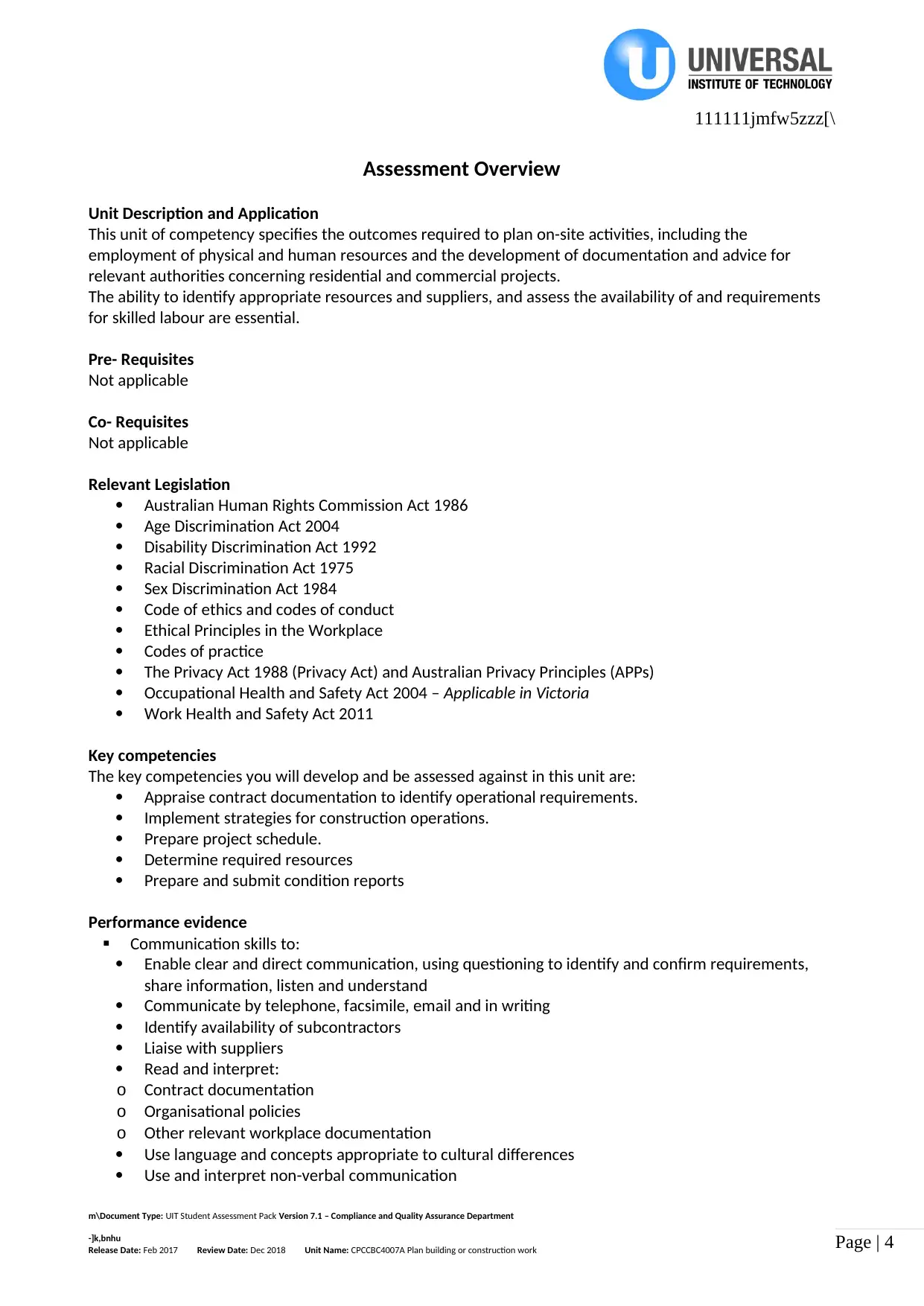
Page | 4
111111jmfw5zzz[\
Assessment Overview
Unit Description and Application
This unit of competency specifies the outcomes required to plan on-site activities, including the
employment of physical and human resources and the development of documentation and advice for
relevant authorities concerning residential and commercial projects.
The ability to identify appropriate resources and suppliers, and assess the availability of and requirements
for skilled labour are essential.
Pre- Requisites
Not applicable
Co- Requisites
Not applicable
Relevant Legislation
Australian Human Rights Commission Act 1986
Age Discrimination Act 2004
Disability Discrimination Act 1992
Racial Discrimination Act 1975
Sex Discrimination Act 1984
Code of ethics and codes of conduct
Ethical Principles in the Workplace
Codes of practice
The Privacy Act 1988 (Privacy Act) and Australian Privacy Principles (APPs)
Occupational Health and Safety Act 2004 – Applicable in Victoria
Work Health and Safety Act 2011
Key competencies
The key competencies you will develop and be assessed against in this unit are:
Appraise contract documentation to identify operational requirements.
Implement strategies for construction operations.
Prepare project schedule.
Determine required resources
Prepare and submit condition reports
Performance evidence
Communication skills to:
Enable clear and direct communication, using questioning to identify and confirm requirements,
share information, listen and understand
Communicate by telephone, facsimile, email and in writing
Identify availability of subcontractors
Liaise with suppliers
Read and interpret:
o Contract documentation
o Organisational policies
o Other relevant workplace documentation
Use language and concepts appropriate to cultural differences
Use and interpret non-verbal communication
m\Document Type: UIT Student Assessment Pack Version 7.1 – Compliance and Quality Assurance Department
-]k,bnhu
Release Date: Feb 2017 Review Date: Dec 2018 Unit Name: CPCCBC4007A Plan building or construction work
111111jmfw5zzz[\
Assessment Overview
Unit Description and Application
This unit of competency specifies the outcomes required to plan on-site activities, including the
employment of physical and human resources and the development of documentation and advice for
relevant authorities concerning residential and commercial projects.
The ability to identify appropriate resources and suppliers, and assess the availability of and requirements
for skilled labour are essential.
Pre- Requisites
Not applicable
Co- Requisites
Not applicable
Relevant Legislation
Australian Human Rights Commission Act 1986
Age Discrimination Act 2004
Disability Discrimination Act 1992
Racial Discrimination Act 1975
Sex Discrimination Act 1984
Code of ethics and codes of conduct
Ethical Principles in the Workplace
Codes of practice
The Privacy Act 1988 (Privacy Act) and Australian Privacy Principles (APPs)
Occupational Health and Safety Act 2004 – Applicable in Victoria
Work Health and Safety Act 2011
Key competencies
The key competencies you will develop and be assessed against in this unit are:
Appraise contract documentation to identify operational requirements.
Implement strategies for construction operations.
Prepare project schedule.
Determine required resources
Prepare and submit condition reports
Performance evidence
Communication skills to:
Enable clear and direct communication, using questioning to identify and confirm requirements,
share information, listen and understand
Communicate by telephone, facsimile, email and in writing
Identify availability of subcontractors
Liaise with suppliers
Read and interpret:
o Contract documentation
o Organisational policies
o Other relevant workplace documentation
Use language and concepts appropriate to cultural differences
Use and interpret non-verbal communication
m\Document Type: UIT Student Assessment Pack Version 7.1 – Compliance and Quality Assurance Department
-]k,bnhu
Release Date: Feb 2017 Review Date: Dec 2018 Unit Name: CPCCBC4007A Plan building or construction work
Secure Best Marks with AI Grader
Need help grading? Try our AI Grader for instant feedback on your assignments.
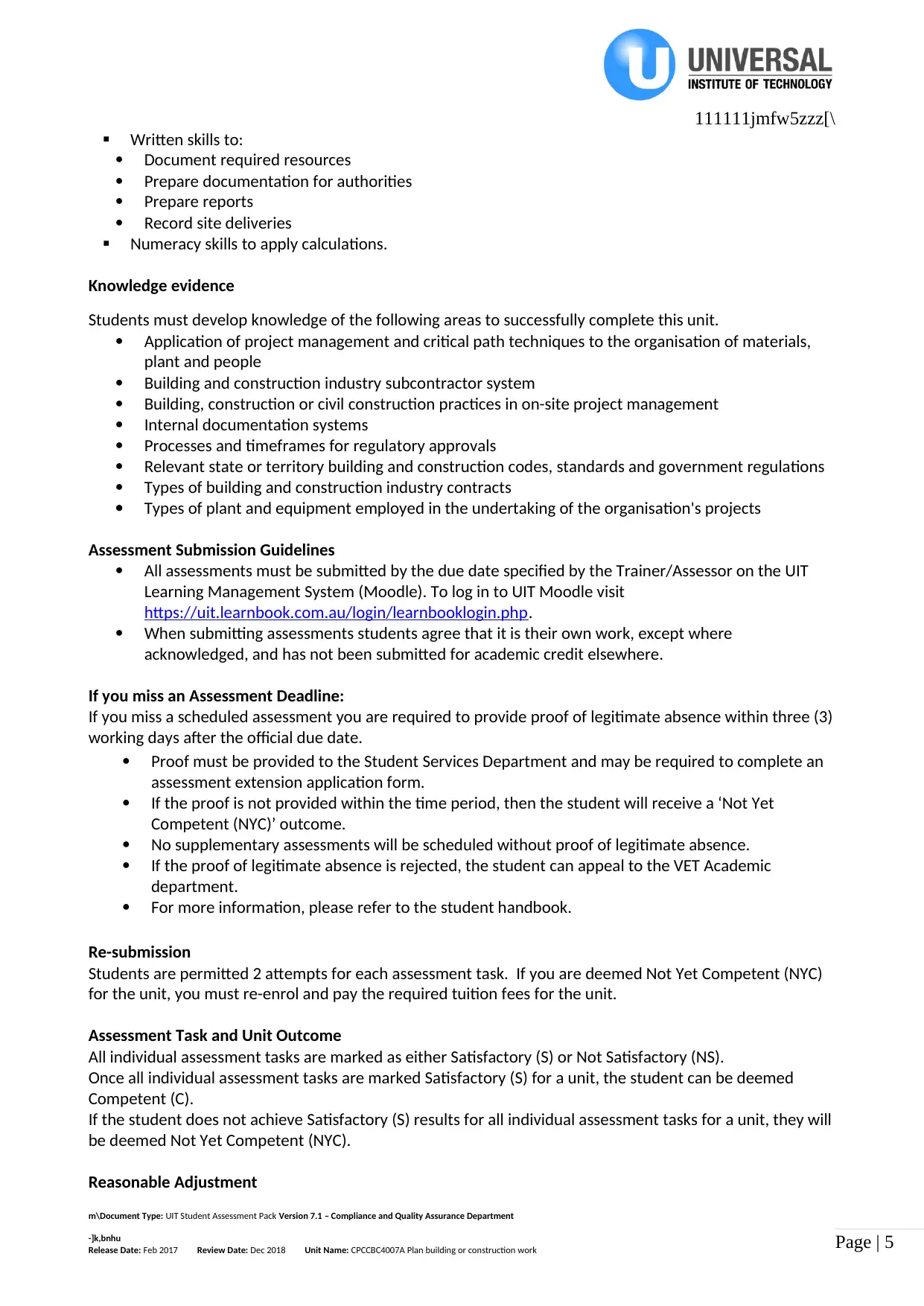
Page | 5
111111jmfw5zzz[\
Written skills to:
Document required resources
Prepare documentation for authorities
Prepare reports
Record site deliveries
Numeracy skills to apply calculations.
Knowledge evidence
Students must develop knowledge of the following areas to successfully complete this unit.
Application of project management and critical path techniques to the organisation of materials,
plant and people
Building and construction industry subcontractor system
Building, construction or civil construction practices in on-site project management
Internal documentation systems
Processes and timeframes for regulatory approvals
Relevant state or territory building and construction codes, standards and government regulations
Types of building and construction industry contracts
Types of plant and equipment employed in the undertaking of the organisation's projects
Assessment Submission Guidelines
All assessments must be submitted by the due date specified by the Trainer/Assessor on the UIT
Learning Management System (Moodle). To log in to UIT Moodle visit
https://uit.learnbook.com.au/login/learnbooklogin.php.
When submitting assessments students agree that it is their own work, except where
acknowledged, and has not been submitted for academic credit elsewhere.
If you miss an Assessment Deadline:
If you miss a scheduled assessment you are required to provide proof of legitimate absence within three (3)
working days after the official due date.
Proof must be provided to the Student Services Department and may be required to complete an
assessment extension application form.
If the proof is not provided within the time period, then the student will receive a ‘Not Yet
Competent (NYC)’ outcome.
No supplementary assessments will be scheduled without proof of legitimate absence.
If the proof of legitimate absence is rejected, the student can appeal to the VET Academic
department.
For more information, please refer to the student handbook.
Re-submission
Students are permitted 2 attempts for each assessment task. If you are deemed Not Yet Competent (NYC)
for the unit, you must re-enrol and pay the required tuition fees for the unit.
Assessment Task and Unit Outcome
All individual assessment tasks are marked as either Satisfactory (S) or Not Satisfactory (NS).
Once all individual assessment tasks are marked Satisfactory (S) for a unit, the student can be deemed
Competent (C).
If the student does not achieve Satisfactory (S) results for all individual assessment tasks for a unit, they will
be deemed Not Yet Competent (NYC).
Reasonable Adjustment
m\Document Type: UIT Student Assessment Pack Version 7.1 – Compliance and Quality Assurance Department
-]k,bnhu
Release Date: Feb 2017 Review Date: Dec 2018 Unit Name: CPCCBC4007A Plan building or construction work
111111jmfw5zzz[\
Written skills to:
Document required resources
Prepare documentation for authorities
Prepare reports
Record site deliveries
Numeracy skills to apply calculations.
Knowledge evidence
Students must develop knowledge of the following areas to successfully complete this unit.
Application of project management and critical path techniques to the organisation of materials,
plant and people
Building and construction industry subcontractor system
Building, construction or civil construction practices in on-site project management
Internal documentation systems
Processes and timeframes for regulatory approvals
Relevant state or territory building and construction codes, standards and government regulations
Types of building and construction industry contracts
Types of plant and equipment employed in the undertaking of the organisation's projects
Assessment Submission Guidelines
All assessments must be submitted by the due date specified by the Trainer/Assessor on the UIT
Learning Management System (Moodle). To log in to UIT Moodle visit
https://uit.learnbook.com.au/login/learnbooklogin.php.
When submitting assessments students agree that it is their own work, except where
acknowledged, and has not been submitted for academic credit elsewhere.
If you miss an Assessment Deadline:
If you miss a scheduled assessment you are required to provide proof of legitimate absence within three (3)
working days after the official due date.
Proof must be provided to the Student Services Department and may be required to complete an
assessment extension application form.
If the proof is not provided within the time period, then the student will receive a ‘Not Yet
Competent (NYC)’ outcome.
No supplementary assessments will be scheduled without proof of legitimate absence.
If the proof of legitimate absence is rejected, the student can appeal to the VET Academic
department.
For more information, please refer to the student handbook.
Re-submission
Students are permitted 2 attempts for each assessment task. If you are deemed Not Yet Competent (NYC)
for the unit, you must re-enrol and pay the required tuition fees for the unit.
Assessment Task and Unit Outcome
All individual assessment tasks are marked as either Satisfactory (S) or Not Satisfactory (NS).
Once all individual assessment tasks are marked Satisfactory (S) for a unit, the student can be deemed
Competent (C).
If the student does not achieve Satisfactory (S) results for all individual assessment tasks for a unit, they will
be deemed Not Yet Competent (NYC).
Reasonable Adjustment
m\Document Type: UIT Student Assessment Pack Version 7.1 – Compliance and Quality Assurance Department
-]k,bnhu
Release Date: Feb 2017 Review Date: Dec 2018 Unit Name: CPCCBC4007A Plan building or construction work
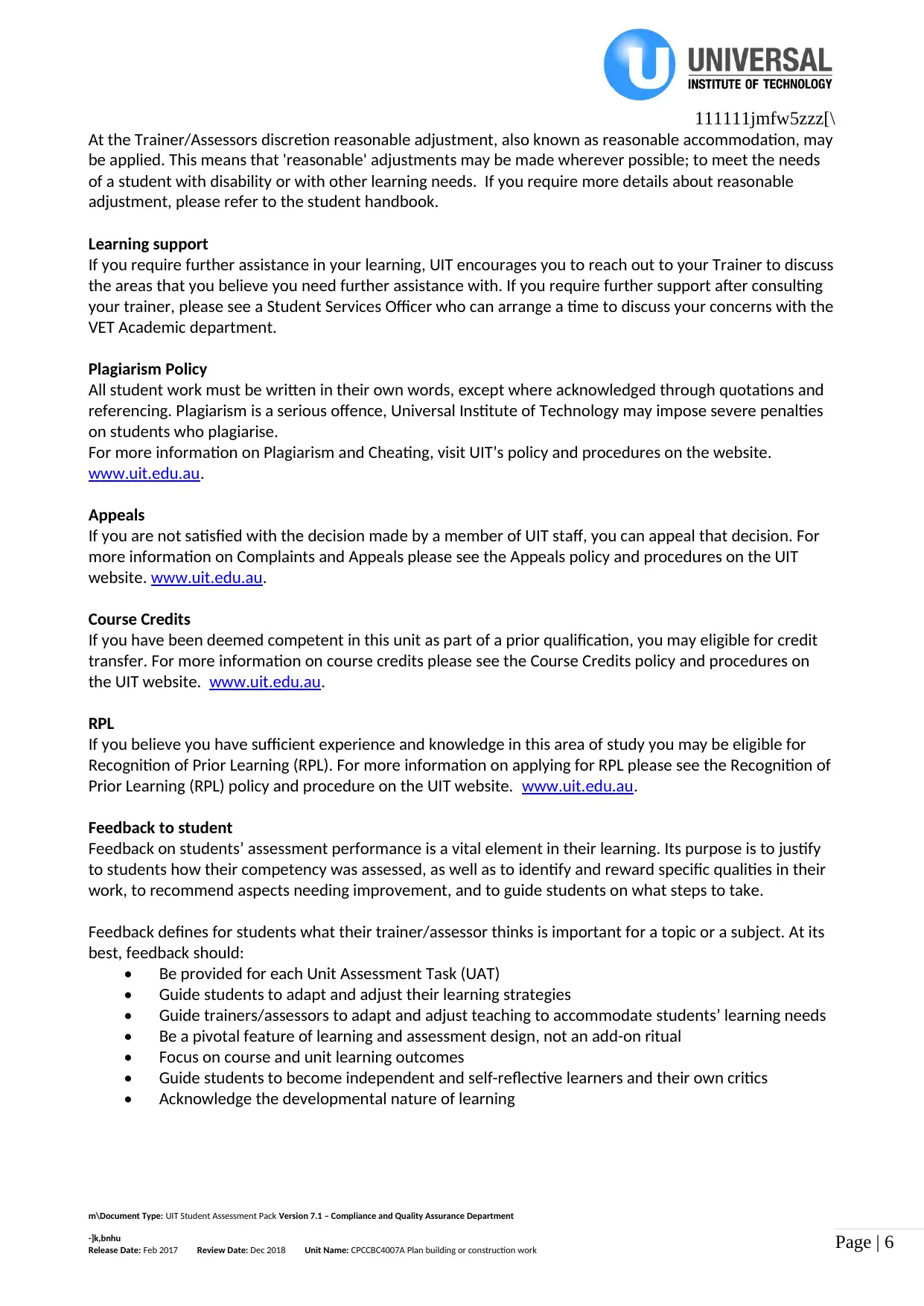
Page | 6
111111jmfw5zzz[\
At the Trainer/Assessors discretion reasonable adjustment, also known as reasonable accommodation, may
be applied. This means that 'reasonable' adjustments may be made wherever possible; to meet the needs
of a student with disability or with other learning needs. If you require more details about reasonable
adjustment, please refer to the student handbook.
Learning support
If you require further assistance in your learning, UIT encourages you to reach out to your Trainer to discuss
the areas that you believe you need further assistance with. If you require further support after consulting
your trainer, please see a Student Services Officer who can arrange a time to discuss your concerns with the
VET Academic department.
Plagiarism Policy
All student work must be written in their own words, except where acknowledged through quotations and
referencing. Plagiarism is a serious offence, Universal Institute of Technology may impose severe penalties
on students who plagiarise.
For more information on Plagiarism and Cheating, visit UIT’s policy and procedures on the website.
www.uit.edu.au.
Appeals
If you are not satisfied with the decision made by a member of UIT staff, you can appeal that decision. For
more information on Complaints and Appeals please see the Appeals policy and procedures on the UIT
website. www.uit.edu.au.
Course Credits
If you have been deemed competent in this unit as part of a prior qualification, you may eligible for credit
transfer. For more information on course credits please see the Course Credits policy and procedures on
the UIT website. www.uit.edu.au.
RPL
If you believe you have sufficient experience and knowledge in this area of study you may be eligible for
Recognition of Prior Learning (RPL). For more information on applying for RPL please see the Recognition of
Prior Learning (RPL) policy and procedure on the UIT website. www.uit.edu.au.
Feedback to student
Feedback on students’ assessment performance is a vital element in their learning. Its purpose is to justify
to students how their competency was assessed, as well as to identify and reward specific qualities in their
work, to recommend aspects needing improvement, and to guide students on what steps to take.
Feedback defines for students what their trainer/assessor thinks is important for a topic or a subject. At its
best, feedback should:
• Be provided for each Unit Assessment Task (UAT)
• Guide students to adapt and adjust their learning strategies
• Guide trainers/assessors to adapt and adjust teaching to accommodate students’ learning needs
• Be a pivotal feature of learning and assessment design, not an add-on ritual
• Focus on course and unit learning outcomes
• Guide students to become independent and self-reflective learners and their own critics
• Acknowledge the developmental nature of learning
m\Document Type: UIT Student Assessment Pack Version 7.1 – Compliance and Quality Assurance Department
-]k,bnhu
Release Date: Feb 2017 Review Date: Dec 2018 Unit Name: CPCCBC4007A Plan building or construction work
111111jmfw5zzz[\
At the Trainer/Assessors discretion reasonable adjustment, also known as reasonable accommodation, may
be applied. This means that 'reasonable' adjustments may be made wherever possible; to meet the needs
of a student with disability or with other learning needs. If you require more details about reasonable
adjustment, please refer to the student handbook.
Learning support
If you require further assistance in your learning, UIT encourages you to reach out to your Trainer to discuss
the areas that you believe you need further assistance with. If you require further support after consulting
your trainer, please see a Student Services Officer who can arrange a time to discuss your concerns with the
VET Academic department.
Plagiarism Policy
All student work must be written in their own words, except where acknowledged through quotations and
referencing. Plagiarism is a serious offence, Universal Institute of Technology may impose severe penalties
on students who plagiarise.
For more information on Plagiarism and Cheating, visit UIT’s policy and procedures on the website.
www.uit.edu.au.
Appeals
If you are not satisfied with the decision made by a member of UIT staff, you can appeal that decision. For
more information on Complaints and Appeals please see the Appeals policy and procedures on the UIT
website. www.uit.edu.au.
Course Credits
If you have been deemed competent in this unit as part of a prior qualification, you may eligible for credit
transfer. For more information on course credits please see the Course Credits policy and procedures on
the UIT website. www.uit.edu.au.
RPL
If you believe you have sufficient experience and knowledge in this area of study you may be eligible for
Recognition of Prior Learning (RPL). For more information on applying for RPL please see the Recognition of
Prior Learning (RPL) policy and procedure on the UIT website. www.uit.edu.au.
Feedback to student
Feedback on students’ assessment performance is a vital element in their learning. Its purpose is to justify
to students how their competency was assessed, as well as to identify and reward specific qualities in their
work, to recommend aspects needing improvement, and to guide students on what steps to take.
Feedback defines for students what their trainer/assessor thinks is important for a topic or a subject. At its
best, feedback should:
• Be provided for each Unit Assessment Task (UAT)
• Guide students to adapt and adjust their learning strategies
• Guide trainers/assessors to adapt and adjust teaching to accommodate students’ learning needs
• Be a pivotal feature of learning and assessment design, not an add-on ritual
• Focus on course and unit learning outcomes
• Guide students to become independent and self-reflective learners and their own critics
• Acknowledge the developmental nature of learning
m\Document Type: UIT Student Assessment Pack Version 7.1 – Compliance and Quality Assurance Department
-]k,bnhu
Release Date: Feb 2017 Review Date: Dec 2018 Unit Name: CPCCBC4007A Plan building or construction work

Page | 7
111111jmfw5zzz[\
If students have not received proper feedback, they must speak to VET department/administration
department in the RTO/person responsible for looking after the VET department/administration of the RTO.
For more information, please refer to the RTO Student Handbook.
m\Document Type: UIT Student Assessment Pack Version 7.1 – Compliance and Quality Assurance Department
-]k,bnhu
Release Date: Feb 2017 Review Date: Dec 2018 Unit Name: CPCCBC4007A Plan building or construction work
111111jmfw5zzz[\
If students have not received proper feedback, they must speak to VET department/administration
department in the RTO/person responsible for looking after the VET department/administration of the RTO.
For more information, please refer to the RTO Student Handbook.
m\Document Type: UIT Student Assessment Pack Version 7.1 – Compliance and Quality Assurance Department
-]k,bnhu
Release Date: Feb 2017 Review Date: Dec 2018 Unit Name: CPCCBC4007A Plan building or construction work
Paraphrase This Document
Need a fresh take? Get an instant paraphrase of this document with our AI Paraphraser
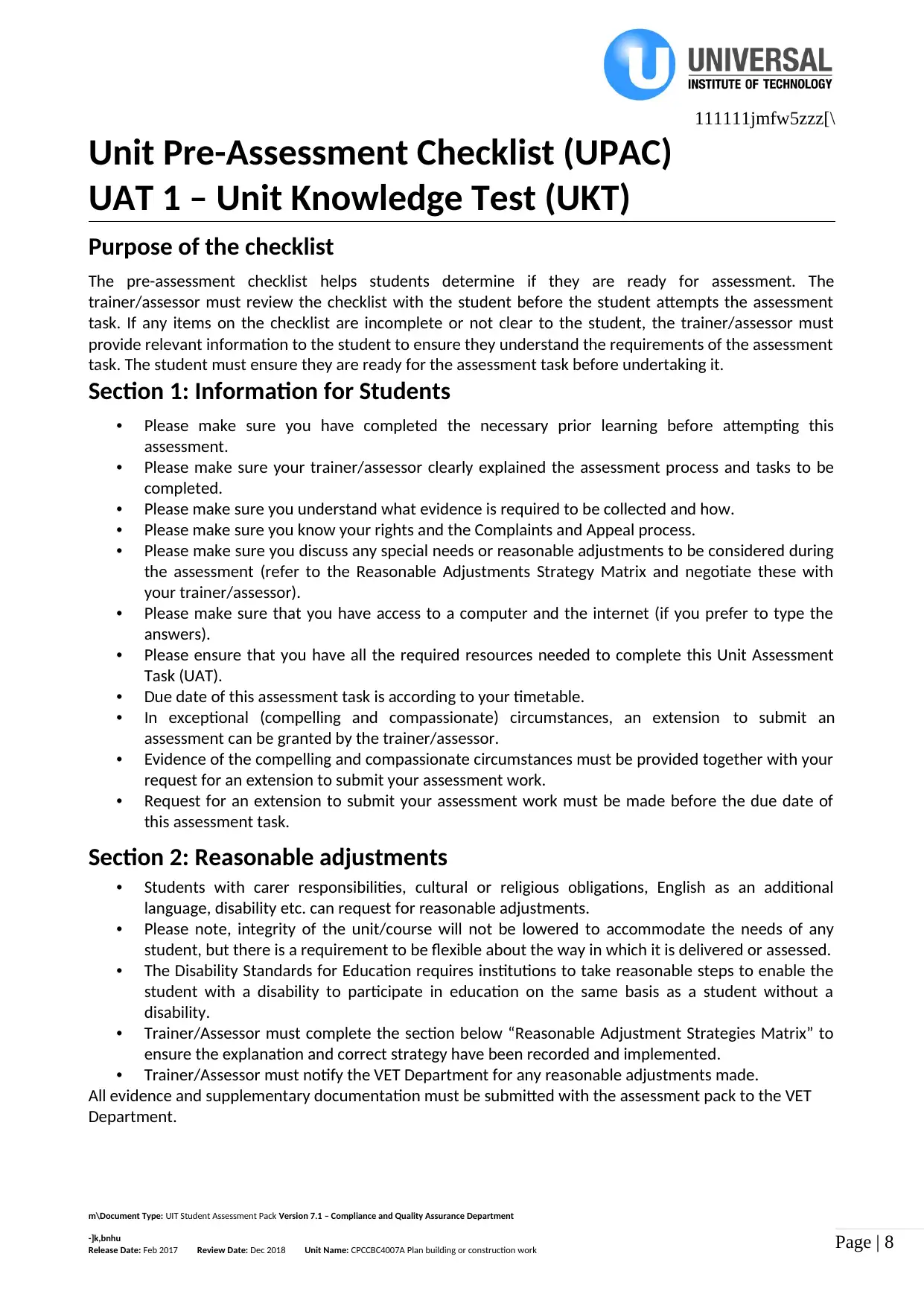
Page | 8
111111jmfw5zzz[\
Unit Pre-Assessment Checklist (UPAC)
UAT 1 – Unit Knowledge Test (UKT)
Purpose of the checklist
The pre-assessment checklist helps students determine if they are ready for assessment. The
trainer/assessor must review the checklist with the student before the student attempts the assessment
task. If any items on the checklist are incomplete or not clear to the student, the trainer/assessor must
provide relevant information to the student to ensure they understand the requirements of the assessment
task. The student must ensure they are ready for the assessment task before undertaking it.
Section 1: Information for Students
• Please make sure you have completed the necessary prior learning before attempting this
assessment.
• Please make sure your trainer/assessor clearly explained the assessment process and tasks to be
completed.
• Please make sure you understand what evidence is required to be collected and how.
• Please make sure you know your rights and the Complaints and Appeal process.
• Please make sure you discuss any special needs or reasonable adjustments to be considered during
the assessment (refer to the Reasonable Adjustments Strategy Matrix and negotiate these with
your trainer/assessor).
• Please make sure that you have access to a computer and the internet (if you prefer to type the
answers).
• Please ensure that you have all the required resources needed to complete this Unit Assessment
Task (UAT).
• Due date of this assessment task is according to your timetable.
• In exceptional (compelling and compassionate) circumstances, an extension to submit an
assessment can be granted by the trainer/assessor.
• Evidence of the compelling and compassionate circumstances must be provided together with your
request for an extension to submit your assessment work.
• Request for an extension to submit your assessment work must be made before the due date of
this assessment task.
Section 2: Reasonable adjustments
• Students with carer responsibilities, cultural or religious obligations, English as an additional
language, disability etc. can request for reasonable adjustments.
• Please note, integrity of the unit/course will not be lowered to accommodate the needs of any
student, but there is a requirement to be flexible about the way in which it is delivered or assessed.
• The Disability Standards for Education requires institutions to take reasonable steps to enable the
student with a disability to participate in education on the same basis as a student without a
disability.
• Trainer/Assessor must complete the section below “Reasonable Adjustment Strategies Matrix” to
ensure the explanation and correct strategy have been recorded and implemented.
• Trainer/Assessor must notify the VET Department for any reasonable adjustments made.
All evidence and supplementary documentation must be submitted with the assessment pack to the VET
Department.
m\Document Type: UIT Student Assessment Pack Version 7.1 – Compliance and Quality Assurance Department
-]k,bnhu
Release Date: Feb 2017 Review Date: Dec 2018 Unit Name: CPCCBC4007A Plan building or construction work
111111jmfw5zzz[\
Unit Pre-Assessment Checklist (UPAC)
UAT 1 – Unit Knowledge Test (UKT)
Purpose of the checklist
The pre-assessment checklist helps students determine if they are ready for assessment. The
trainer/assessor must review the checklist with the student before the student attempts the assessment
task. If any items on the checklist are incomplete or not clear to the student, the trainer/assessor must
provide relevant information to the student to ensure they understand the requirements of the assessment
task. The student must ensure they are ready for the assessment task before undertaking it.
Section 1: Information for Students
• Please make sure you have completed the necessary prior learning before attempting this
assessment.
• Please make sure your trainer/assessor clearly explained the assessment process and tasks to be
completed.
• Please make sure you understand what evidence is required to be collected and how.
• Please make sure you know your rights and the Complaints and Appeal process.
• Please make sure you discuss any special needs or reasonable adjustments to be considered during
the assessment (refer to the Reasonable Adjustments Strategy Matrix and negotiate these with
your trainer/assessor).
• Please make sure that you have access to a computer and the internet (if you prefer to type the
answers).
• Please ensure that you have all the required resources needed to complete this Unit Assessment
Task (UAT).
• Due date of this assessment task is according to your timetable.
• In exceptional (compelling and compassionate) circumstances, an extension to submit an
assessment can be granted by the trainer/assessor.
• Evidence of the compelling and compassionate circumstances must be provided together with your
request for an extension to submit your assessment work.
• Request for an extension to submit your assessment work must be made before the due date of
this assessment task.
Section 2: Reasonable adjustments
• Students with carer responsibilities, cultural or religious obligations, English as an additional
language, disability etc. can request for reasonable adjustments.
• Please note, integrity of the unit/course will not be lowered to accommodate the needs of any
student, but there is a requirement to be flexible about the way in which it is delivered or assessed.
• The Disability Standards for Education requires institutions to take reasonable steps to enable the
student with a disability to participate in education on the same basis as a student without a
disability.
• Trainer/Assessor must complete the section below “Reasonable Adjustment Strategies Matrix” to
ensure the explanation and correct strategy have been recorded and implemented.
• Trainer/Assessor must notify the VET Department for any reasonable adjustments made.
All evidence and supplementary documentation must be submitted with the assessment pack to the VET
Department.
m\Document Type: UIT Student Assessment Pack Version 7.1 – Compliance and Quality Assurance Department
-]k,bnhu
Release Date: Feb 2017 Review Date: Dec 2018 Unit Name: CPCCBC4007A Plan building or construction work
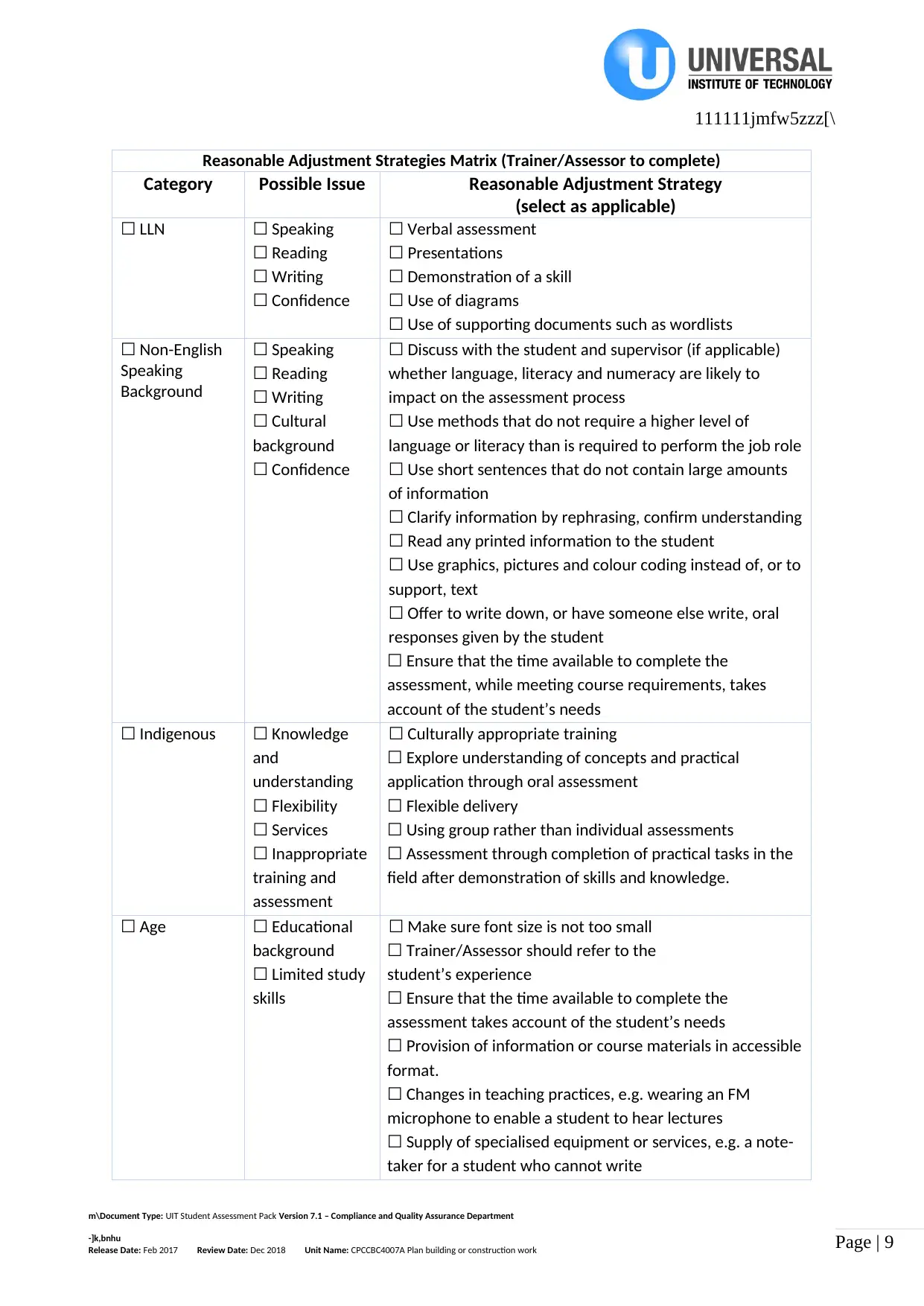
Page | 9
111111jmfw5zzz[\
Reasonable Adjustment Strategies Matrix (Trainer/Assessor to complete)
Category Possible Issue Reasonable Adjustment Strategy
(select as applicable)
☐ LLN ☐ Speaking
☐ Reading
☐ Writing
☐ Confidence
☐ Verbal assessment
☐ Presentations
☐ Demonstration of a skill
☐ Use of diagrams
☐ Use of supporting documents such as wordlists
☐ Non-English
Speaking
Background
☐ Speaking
☐ Reading
☐ Writing
☐ Cultural
background
☐ Confidence
☐ Discuss with the student and supervisor (if applicable)
whether language, literacy and numeracy are likely to
impact on the assessment process
☐ Use methods that do not require a higher level of
language or literacy than is required to perform the job role
☐ Use short sentences that do not contain large amounts
of information
☐ Clarify information by rephrasing, confirm understanding
☐ Read any printed information to the student
☐ Use graphics, pictures and colour coding instead of, or to
support, text
☐ Offer to write down, or have someone else write, oral
responses given by the student
☐ Ensure that the time available to complete the
assessment, while meeting course requirements, takes
account of the student’s needs
☐ Indigenous ☐ Knowledge
and
understanding
☐ Flexibility
☐ Services
☐ Inappropriate
training and
assessment
☐ Culturally appropriate training
☐ Explore understanding of concepts and practical
application through oral assessment
☐ Flexible delivery
☐ Using group rather than individual assessments
☐ Assessment through completion of practical tasks in the
field after demonstration of skills and knowledge.
☐ Age ☐ Educational
background
☐ Limited study
skills
☐ Make sure font size is not too small
☐ Trainer/Assessor should refer to the
student’s experience
☐ Ensure that the time available to complete the
assessment takes account of the student’s needs
☐ Provision of information or course materials in accessible
format.
☐ Changes in teaching practices, e.g. wearing an FM
microphone to enable a student to hear lectures
☐ Supply of specialised equipment or services, e.g. a note-
taker for a student who cannot write
m\Document Type: UIT Student Assessment Pack Version 7.1 – Compliance and Quality Assurance Department
-]k,bnhu
Release Date: Feb 2017 Review Date: Dec 2018 Unit Name: CPCCBC4007A Plan building or construction work
111111jmfw5zzz[\
Reasonable Adjustment Strategies Matrix (Trainer/Assessor to complete)
Category Possible Issue Reasonable Adjustment Strategy
(select as applicable)
☐ LLN ☐ Speaking
☐ Reading
☐ Writing
☐ Confidence
☐ Verbal assessment
☐ Presentations
☐ Demonstration of a skill
☐ Use of diagrams
☐ Use of supporting documents such as wordlists
☐ Non-English
Speaking
Background
☐ Speaking
☐ Reading
☐ Writing
☐ Cultural
background
☐ Confidence
☐ Discuss with the student and supervisor (if applicable)
whether language, literacy and numeracy are likely to
impact on the assessment process
☐ Use methods that do not require a higher level of
language or literacy than is required to perform the job role
☐ Use short sentences that do not contain large amounts
of information
☐ Clarify information by rephrasing, confirm understanding
☐ Read any printed information to the student
☐ Use graphics, pictures and colour coding instead of, or to
support, text
☐ Offer to write down, or have someone else write, oral
responses given by the student
☐ Ensure that the time available to complete the
assessment, while meeting course requirements, takes
account of the student’s needs
☐ Indigenous ☐ Knowledge
and
understanding
☐ Flexibility
☐ Services
☐ Inappropriate
training and
assessment
☐ Culturally appropriate training
☐ Explore understanding of concepts and practical
application through oral assessment
☐ Flexible delivery
☐ Using group rather than individual assessments
☐ Assessment through completion of practical tasks in the
field after demonstration of skills and knowledge.
☐ Age ☐ Educational
background
☐ Limited study
skills
☐ Make sure font size is not too small
☐ Trainer/Assessor should refer to the
student’s experience
☐ Ensure that the time available to complete the
assessment takes account of the student’s needs
☐ Provision of information or course materials in accessible
format.
☐ Changes in teaching practices, e.g. wearing an FM
microphone to enable a student to hear lectures
☐ Supply of specialised equipment or services, e.g. a note-
taker for a student who cannot write
m\Document Type: UIT Student Assessment Pack Version 7.1 – Compliance and Quality Assurance Department
-]k,bnhu
Release Date: Feb 2017 Review Date: Dec 2018 Unit Name: CPCCBC4007A Plan building or construction work
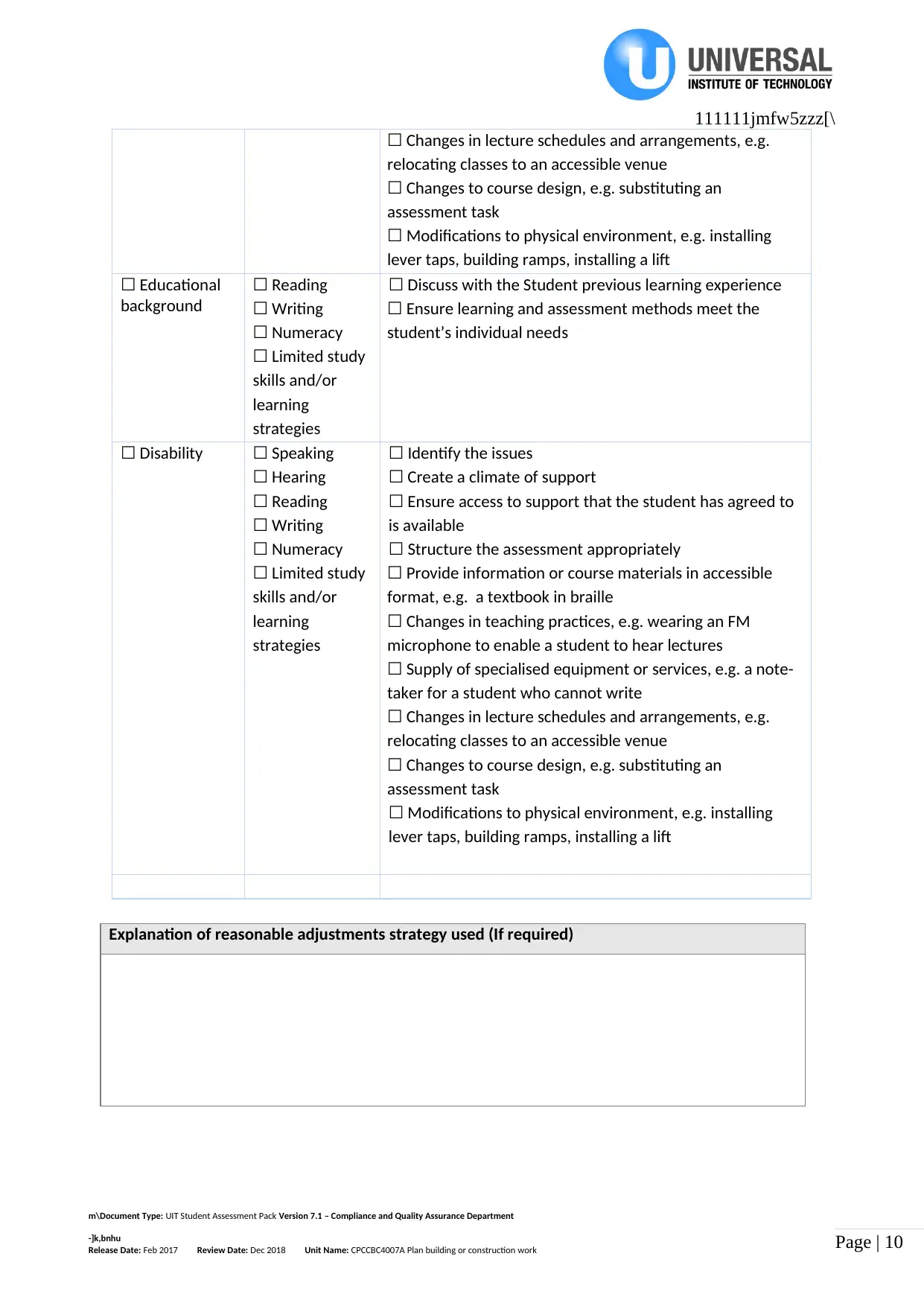
Page | 10
111111jmfw5zzz[\
☐ Changes in lecture schedules and arrangements, e.g.
relocating classes to an accessible venue
☐ Changes to course design, e.g. substituting an
assessment task
☐ Modifications to physical environment, e.g. installing
lever taps, building ramps, installing a lift
☐ Educational
background
☐ Reading
☐ Writing
☐ Numeracy
☐ Limited study
skills and/or
learning
strategies
☐ Discuss with the Student previous learning experience
☐ Ensure learning and assessment methods meet the
student’s individual needs
☐ Disability ☐ Speaking
☐ Hearing
☐ Reading
☐ Writing
☐ Numeracy
☐ Limited study
skills and/or
learning
strategies
☐ Identify the issues
☐ Create a climate of support
☐ Ensure access to support that the student has agreed to
is available
☐ Structure the assessment appropriately
☐ Provide information or course materials in accessible
format, e.g. a textbook in braille
☐ Changes in teaching practices, e.g. wearing an FM
microphone to enable a student to hear lectures
☐ Supply of specialised equipment or services, e.g. a note-
taker for a student who cannot write
☐ Changes in lecture schedules and arrangements, e.g.
relocating classes to an accessible venue
☐ Changes to course design, e.g. substituting an
assessment task
☐ Modifications to physical environment, e.g. installing
lever taps, building ramps, installing a lift
Explanation of reasonable adjustments strategy used (If required)
m\Document Type: UIT Student Assessment Pack Version 7.1 – Compliance and Quality Assurance Department
-]k,bnhu
Release Date: Feb 2017 Review Date: Dec 2018 Unit Name: CPCCBC4007A Plan building or construction work
111111jmfw5zzz[\
☐ Changes in lecture schedules and arrangements, e.g.
relocating classes to an accessible venue
☐ Changes to course design, e.g. substituting an
assessment task
☐ Modifications to physical environment, e.g. installing
lever taps, building ramps, installing a lift
☐ Educational
background
☐ Reading
☐ Writing
☐ Numeracy
☐ Limited study
skills and/or
learning
strategies
☐ Discuss with the Student previous learning experience
☐ Ensure learning and assessment methods meet the
student’s individual needs
☐ Disability ☐ Speaking
☐ Hearing
☐ Reading
☐ Writing
☐ Numeracy
☐ Limited study
skills and/or
learning
strategies
☐ Identify the issues
☐ Create a climate of support
☐ Ensure access to support that the student has agreed to
is available
☐ Structure the assessment appropriately
☐ Provide information or course materials in accessible
format, e.g. a textbook in braille
☐ Changes in teaching practices, e.g. wearing an FM
microphone to enable a student to hear lectures
☐ Supply of specialised equipment or services, e.g. a note-
taker for a student who cannot write
☐ Changes in lecture schedules and arrangements, e.g.
relocating classes to an accessible venue
☐ Changes to course design, e.g. substituting an
assessment task
☐ Modifications to physical environment, e.g. installing
lever taps, building ramps, installing a lift
Explanation of reasonable adjustments strategy used (If required)
m\Document Type: UIT Student Assessment Pack Version 7.1 – Compliance and Quality Assurance Department
-]k,bnhu
Release Date: Feb 2017 Review Date: Dec 2018 Unit Name: CPCCBC4007A Plan building or construction work
Secure Best Marks with AI Grader
Need help grading? Try our AI Grader for instant feedback on your assignments.
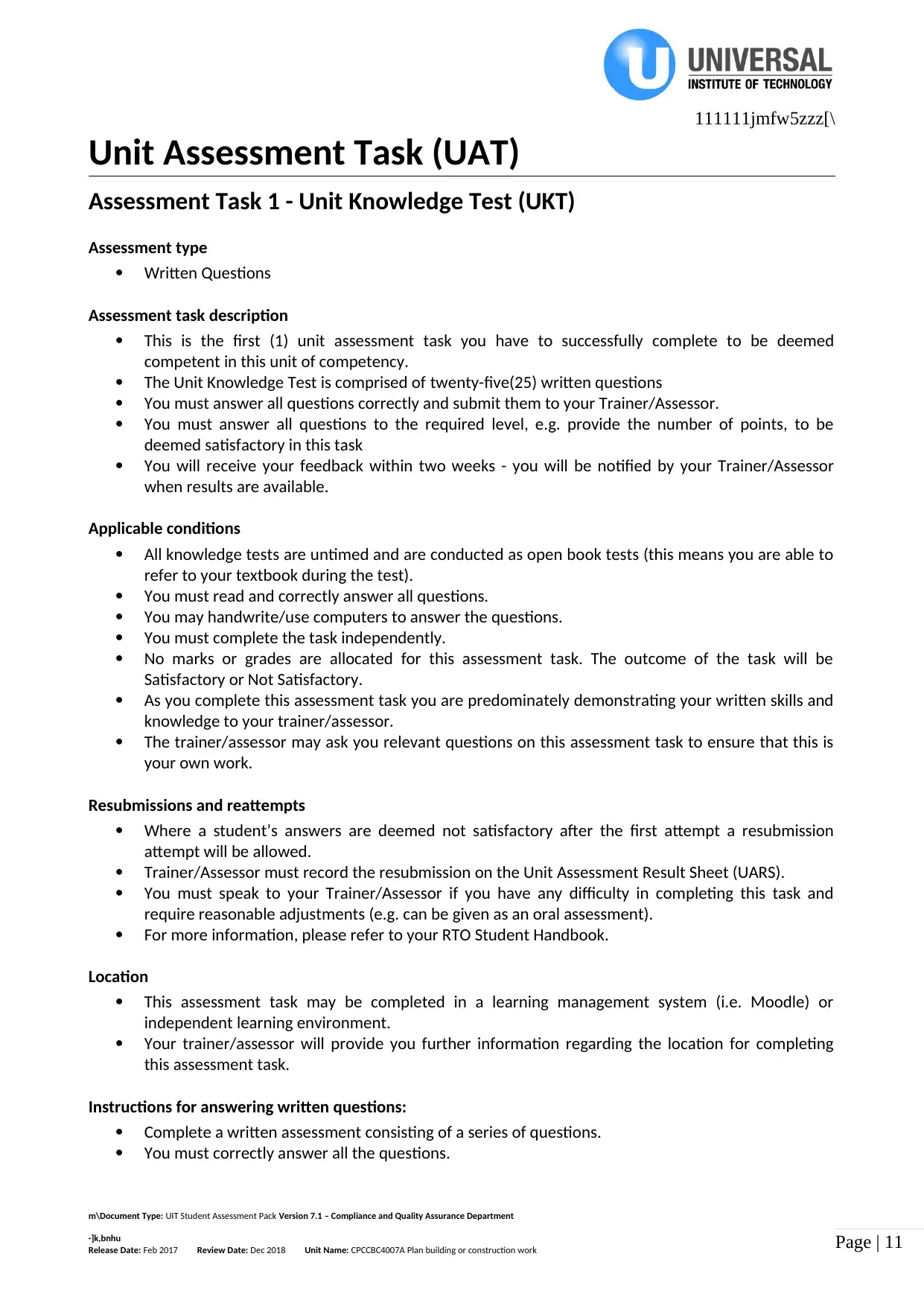
Page | 11
111111jmfw5zzz[\
Unit Assessment Task (UAT)
Assessment Task 1 - Unit Knowledge Test (UKT)
Assessment type
Written Questions
Assessment task description
This is the first (1) unit assessment task you have to successfully complete to be deemed
competent in this unit of competency.
The Unit Knowledge Test is comprised of twenty-five(25) written questions
You must answer all questions correctly and submit them to your Trainer/Assessor.
You must answer all questions to the required level, e.g. provide the number of points, to be
deemed satisfactory in this task
You will receive your feedback within two weeks - you will be notified by your Trainer/Assessor
when results are available.
Applicable conditions
All knowledge tests are untimed and are conducted as open book tests (this means you are able to
refer to your textbook during the test).
You must read and correctly answer all questions.
You may handwrite/use computers to answer the questions.
You must complete the task independently.
No marks or grades are allocated for this assessment task. The outcome of the task will be
Satisfactory or Not Satisfactory.
As you complete this assessment task you are predominately demonstrating your written skills and
knowledge to your trainer/assessor.
The trainer/assessor may ask you relevant questions on this assessment task to ensure that this is
your own work.
Resubmissions and reattempts
Where a student’s answers are deemed not satisfactory after the first attempt a resubmission
attempt will be allowed.
Trainer/Assessor must record the resubmission on the Unit Assessment Result Sheet (UARS).
You must speak to your Trainer/Assessor if you have any difficulty in completing this task and
require reasonable adjustments (e.g. can be given as an oral assessment).
For more information, please refer to your RTO Student Handbook.
Location
This assessment task may be completed in a learning management system (i.e. Moodle) or
independent learning environment.
Your trainer/assessor will provide you further information regarding the location for completing
this assessment task.
Instructions for answering written questions:
Complete a written assessment consisting of a series of questions.
You must correctly answer all the questions.
m\Document Type: UIT Student Assessment Pack Version 7.1 – Compliance and Quality Assurance Department
-]k,bnhu
Release Date: Feb 2017 Review Date: Dec 2018 Unit Name: CPCCBC4007A Plan building or construction work
111111jmfw5zzz[\
Unit Assessment Task (UAT)
Assessment Task 1 - Unit Knowledge Test (UKT)
Assessment type
Written Questions
Assessment task description
This is the first (1) unit assessment task you have to successfully complete to be deemed
competent in this unit of competency.
The Unit Knowledge Test is comprised of twenty-five(25) written questions
You must answer all questions correctly and submit them to your Trainer/Assessor.
You must answer all questions to the required level, e.g. provide the number of points, to be
deemed satisfactory in this task
You will receive your feedback within two weeks - you will be notified by your Trainer/Assessor
when results are available.
Applicable conditions
All knowledge tests are untimed and are conducted as open book tests (this means you are able to
refer to your textbook during the test).
You must read and correctly answer all questions.
You may handwrite/use computers to answer the questions.
You must complete the task independently.
No marks or grades are allocated for this assessment task. The outcome of the task will be
Satisfactory or Not Satisfactory.
As you complete this assessment task you are predominately demonstrating your written skills and
knowledge to your trainer/assessor.
The trainer/assessor may ask you relevant questions on this assessment task to ensure that this is
your own work.
Resubmissions and reattempts
Where a student’s answers are deemed not satisfactory after the first attempt a resubmission
attempt will be allowed.
Trainer/Assessor must record the resubmission on the Unit Assessment Result Sheet (UARS).
You must speak to your Trainer/Assessor if you have any difficulty in completing this task and
require reasonable adjustments (e.g. can be given as an oral assessment).
For more information, please refer to your RTO Student Handbook.
Location
This assessment task may be completed in a learning management system (i.e. Moodle) or
independent learning environment.
Your trainer/assessor will provide you further information regarding the location for completing
this assessment task.
Instructions for answering written questions:
Complete a written assessment consisting of a series of questions.
You must correctly answer all the questions.
m\Document Type: UIT Student Assessment Pack Version 7.1 – Compliance and Quality Assurance Department
-]k,bnhu
Release Date: Feb 2017 Review Date: Dec 2018 Unit Name: CPCCBC4007A Plan building or construction work
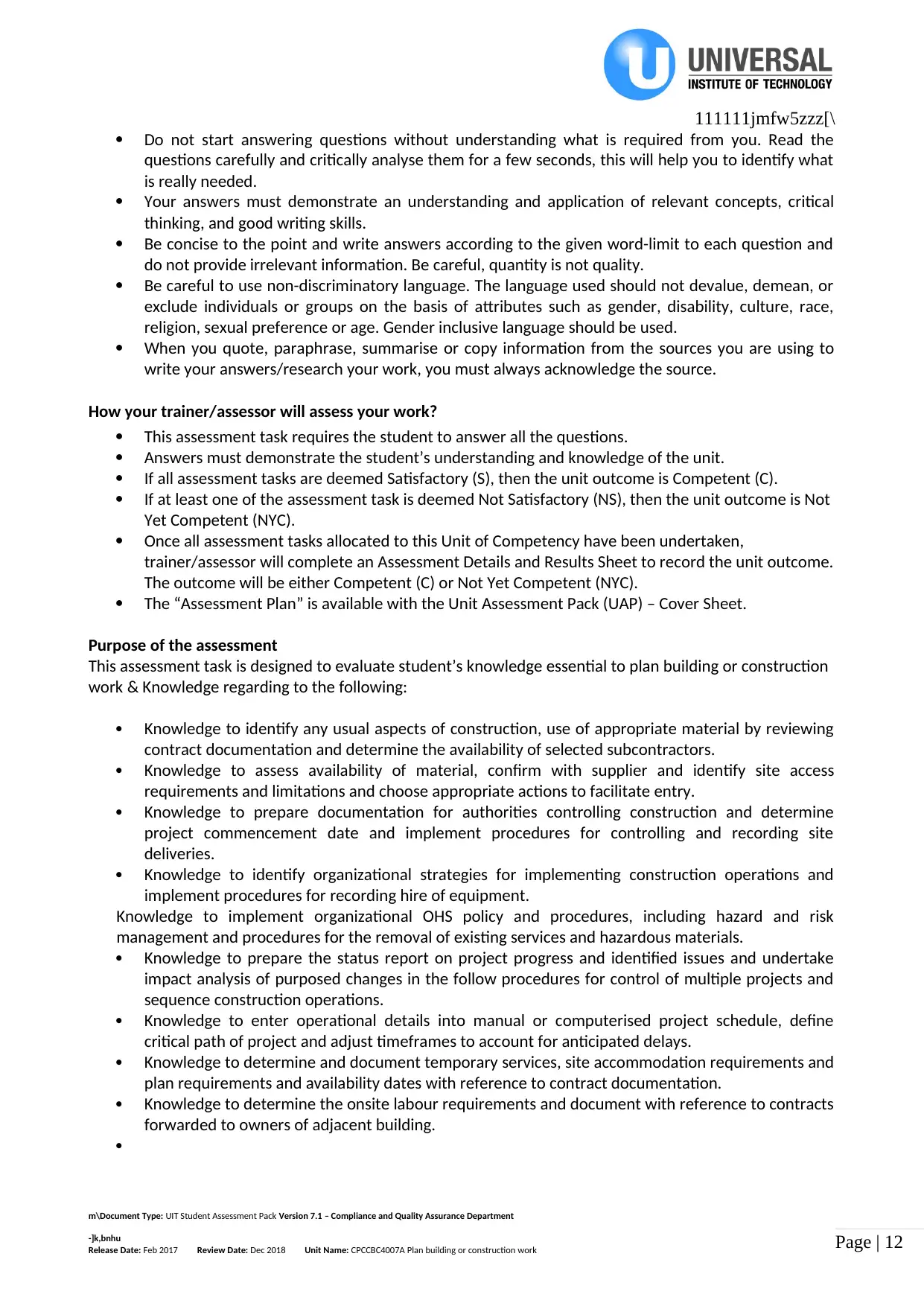
Page | 12
111111jmfw5zzz[\
Do not start answering questions without understanding what is required from you. Read the
questions carefully and critically analyse them for a few seconds, this will help you to identify what
is really needed.
Your answers must demonstrate an understanding and application of relevant concepts, critical
thinking, and good writing skills.
Be concise to the point and write answers according to the given word-limit to each question and
do not provide irrelevant information. Be careful, quantity is not quality.
Be careful to use non-discriminatory language. The language used should not devalue, demean, or
exclude individuals or groups on the basis of attributes such as gender, disability, culture, race,
religion, sexual preference or age. Gender inclusive language should be used.
When you quote, paraphrase, summarise or copy information from the sources you are using to
write your answers/research your work, you must always acknowledge the source.
How your trainer/assessor will assess your work?
This assessment task requires the student to answer all the questions.
Answers must demonstrate the student’s understanding and knowledge of the unit.
If all assessment tasks are deemed Satisfactory (S), then the unit outcome is Competent (C).
If at least one of the assessment task is deemed Not Satisfactory (NS), then the unit outcome is Not
Yet Competent (NYC).
Once all assessment tasks allocated to this Unit of Competency have been undertaken,
trainer/assessor will complete an Assessment Details and Results Sheet to record the unit outcome.
The outcome will be either Competent (C) or Not Yet Competent (NYC).
The “Assessment Plan” is available with the Unit Assessment Pack (UAP) – Cover Sheet.
Purpose of the assessment
This assessment task is designed to evaluate student’s knowledge essential to plan building or construction
work & Knowledge regarding to the following:
Knowledge to identify any usual aspects of construction, use of appropriate material by reviewing
contract documentation and determine the availability of selected subcontractors.
Knowledge to assess availability of material, confirm with supplier and identify site access
requirements and limitations and choose appropriate actions to facilitate entry.
Knowledge to prepare documentation for authorities controlling construction and determine
project commencement date and implement procedures for controlling and recording site
deliveries.
Knowledge to identify organizational strategies for implementing construction operations and
implement procedures for recording hire of equipment.
Knowledge to implement organizational OHS policy and procedures, including hazard and risk
management and procedures for the removal of existing services and hazardous materials.
Knowledge to prepare the status report on project progress and identified issues and undertake
impact analysis of purposed changes in the follow procedures for control of multiple projects and
sequence construction operations.
Knowledge to enter operational details into manual or computerised project schedule, define
critical path of project and adjust timeframes to account for anticipated delays.
Knowledge to determine and document temporary services, site accommodation requirements and
plan requirements and availability dates with reference to contract documentation.
Knowledge to determine the onsite labour requirements and document with reference to contracts
forwarded to owners of adjacent building.
m\Document Type: UIT Student Assessment Pack Version 7.1 – Compliance and Quality Assurance Department
-]k,bnhu
Release Date: Feb 2017 Review Date: Dec 2018 Unit Name: CPCCBC4007A Plan building or construction work
111111jmfw5zzz[\
Do not start answering questions without understanding what is required from you. Read the
questions carefully and critically analyse them for a few seconds, this will help you to identify what
is really needed.
Your answers must demonstrate an understanding and application of relevant concepts, critical
thinking, and good writing skills.
Be concise to the point and write answers according to the given word-limit to each question and
do not provide irrelevant information. Be careful, quantity is not quality.
Be careful to use non-discriminatory language. The language used should not devalue, demean, or
exclude individuals or groups on the basis of attributes such as gender, disability, culture, race,
religion, sexual preference or age. Gender inclusive language should be used.
When you quote, paraphrase, summarise or copy information from the sources you are using to
write your answers/research your work, you must always acknowledge the source.
How your trainer/assessor will assess your work?
This assessment task requires the student to answer all the questions.
Answers must demonstrate the student’s understanding and knowledge of the unit.
If all assessment tasks are deemed Satisfactory (S), then the unit outcome is Competent (C).
If at least one of the assessment task is deemed Not Satisfactory (NS), then the unit outcome is Not
Yet Competent (NYC).
Once all assessment tasks allocated to this Unit of Competency have been undertaken,
trainer/assessor will complete an Assessment Details and Results Sheet to record the unit outcome.
The outcome will be either Competent (C) or Not Yet Competent (NYC).
The “Assessment Plan” is available with the Unit Assessment Pack (UAP) – Cover Sheet.
Purpose of the assessment
This assessment task is designed to evaluate student’s knowledge essential to plan building or construction
work & Knowledge regarding to the following:
Knowledge to identify any usual aspects of construction, use of appropriate material by reviewing
contract documentation and determine the availability of selected subcontractors.
Knowledge to assess availability of material, confirm with supplier and identify site access
requirements and limitations and choose appropriate actions to facilitate entry.
Knowledge to prepare documentation for authorities controlling construction and determine
project commencement date and implement procedures for controlling and recording site
deliveries.
Knowledge to identify organizational strategies for implementing construction operations and
implement procedures for recording hire of equipment.
Knowledge to implement organizational OHS policy and procedures, including hazard and risk
management and procedures for the removal of existing services and hazardous materials.
Knowledge to prepare the status report on project progress and identified issues and undertake
impact analysis of purposed changes in the follow procedures for control of multiple projects and
sequence construction operations.
Knowledge to enter operational details into manual or computerised project schedule, define
critical path of project and adjust timeframes to account for anticipated delays.
Knowledge to determine and document temporary services, site accommodation requirements and
plan requirements and availability dates with reference to contract documentation.
Knowledge to determine the onsite labour requirements and document with reference to contracts
forwarded to owners of adjacent building.
m\Document Type: UIT Student Assessment Pack Version 7.1 – Compliance and Quality Assurance Department
-]k,bnhu
Release Date: Feb 2017 Review Date: Dec 2018 Unit Name: CPCCBC4007A Plan building or construction work
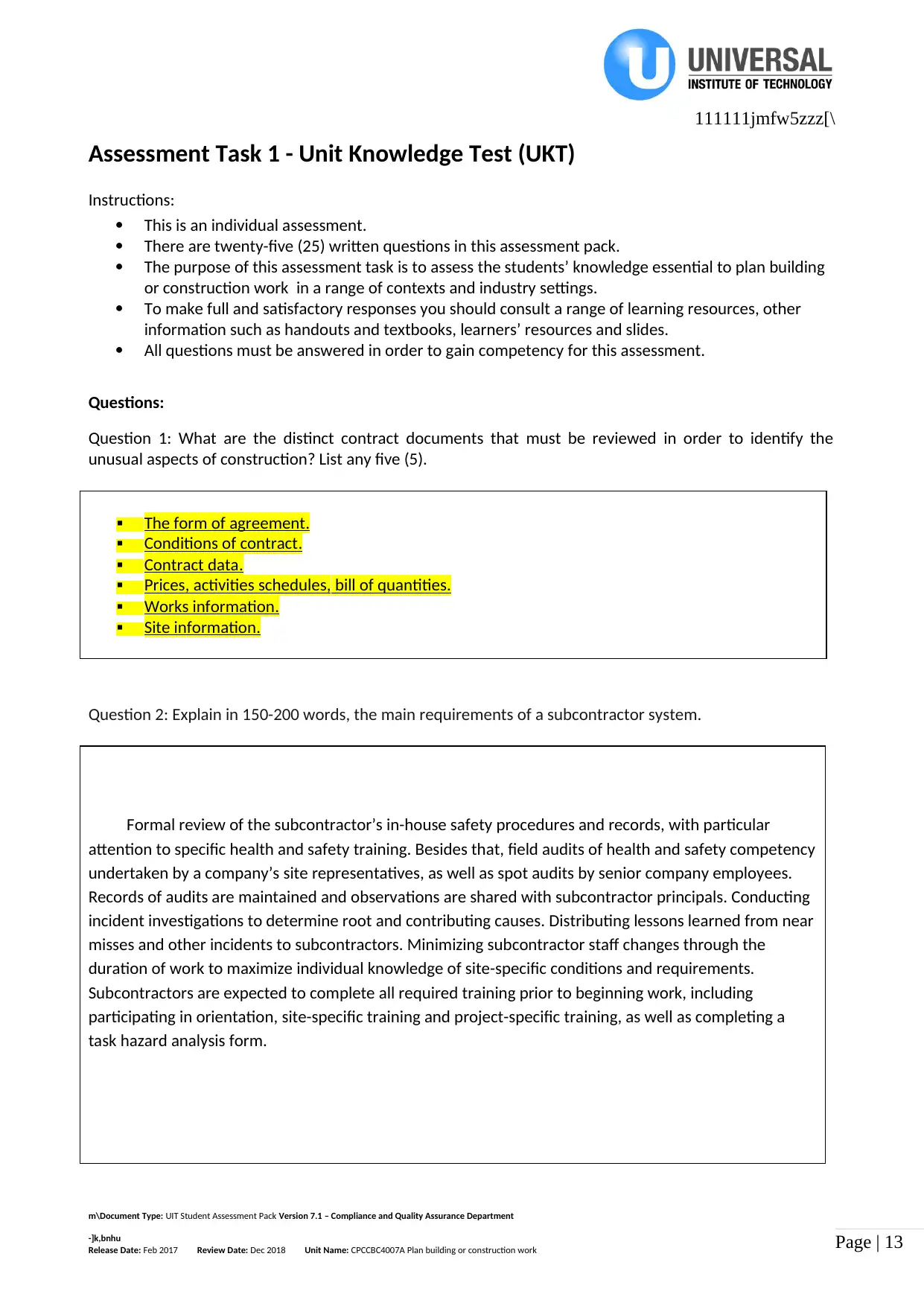
Page | 13
111111jmfw5zzz[\
Assessment Task 1 - Unit Knowledge Test (UKT)
Instructions:
This is an individual assessment.
There are twenty-five (25) written questions in this assessment pack.
The purpose of this assessment task is to assess the students’ knowledge essential to plan building
or construction work in a range of contexts and industry settings.
To make full and satisfactory responses you should consult a range of learning resources, other
information such as handouts and textbooks, learners’ resources and slides.
All questions must be answered in order to gain competency for this assessment.
Questions:
Question 1: What are the distinct contract documents that must be reviewed in order to identify the
unusual aspects of construction? List any five (5).
The form of agreement.
Conditions of contract.
Contract data.
Prices, activities schedules, bill of quantities.
Works information.
Site information.
Question 2: Explain in 150-200 words, the main requirements of a subcontractor system.
Formal review of the subcontractor’s in-house safety procedures and records, with particular
attention to specific health and safety training. Besides that, field audits of health and safety competency
undertaken by a company’s site representatives, as well as spot audits by senior company employees.
Records of audits are maintained and observations are shared with subcontractor principals. Conducting
incident investigations to determine root and contributing causes. Distributing lessons learned from near
misses and other incidents to subcontractors. Minimizing subcontractor staff changes through the
duration of work to maximize individual knowledge of site-specific conditions and requirements.
Subcontractors are expected to complete all required training prior to beginning work, including
participating in orientation, site-specific training and project-specific training, as well as completing a
task hazard analysis form.
m\Document Type: UIT Student Assessment Pack Version 7.1 – Compliance and Quality Assurance Department
-]k,bnhu
Release Date: Feb 2017 Review Date: Dec 2018 Unit Name: CPCCBC4007A Plan building or construction work
111111jmfw5zzz[\
Assessment Task 1 - Unit Knowledge Test (UKT)
Instructions:
This is an individual assessment.
There are twenty-five (25) written questions in this assessment pack.
The purpose of this assessment task is to assess the students’ knowledge essential to plan building
or construction work in a range of contexts and industry settings.
To make full and satisfactory responses you should consult a range of learning resources, other
information such as handouts and textbooks, learners’ resources and slides.
All questions must be answered in order to gain competency for this assessment.
Questions:
Question 1: What are the distinct contract documents that must be reviewed in order to identify the
unusual aspects of construction? List any five (5).
The form of agreement.
Conditions of contract.
Contract data.
Prices, activities schedules, bill of quantities.
Works information.
Site information.
Question 2: Explain in 150-200 words, the main requirements of a subcontractor system.
Formal review of the subcontractor’s in-house safety procedures and records, with particular
attention to specific health and safety training. Besides that, field audits of health and safety competency
undertaken by a company’s site representatives, as well as spot audits by senior company employees.
Records of audits are maintained and observations are shared with subcontractor principals. Conducting
incident investigations to determine root and contributing causes. Distributing lessons learned from near
misses and other incidents to subcontractors. Minimizing subcontractor staff changes through the
duration of work to maximize individual knowledge of site-specific conditions and requirements.
Subcontractors are expected to complete all required training prior to beginning work, including
participating in orientation, site-specific training and project-specific training, as well as completing a
task hazard analysis form.
m\Document Type: UIT Student Assessment Pack Version 7.1 – Compliance and Quality Assurance Department
-]k,bnhu
Release Date: Feb 2017 Review Date: Dec 2018 Unit Name: CPCCBC4007A Plan building or construction work
Paraphrase This Document
Need a fresh take? Get an instant paraphrase of this document with our AI Paraphraser
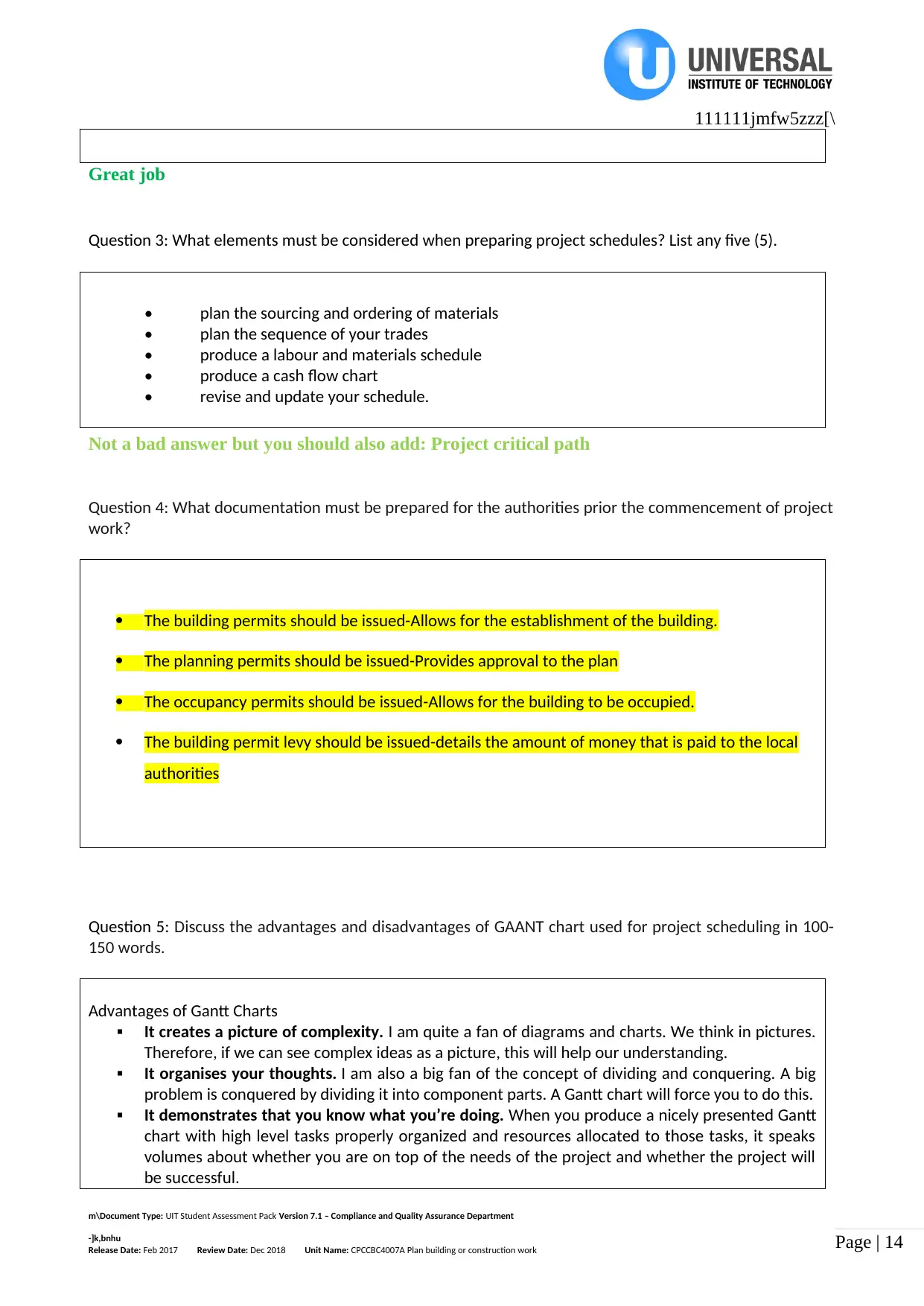
Page | 14
111111jmfw5zzz[\
Great job
Question 3: What elements must be considered when preparing project schedules? List any five (5).
• plan the sourcing and ordering of materials
• plan the sequence of your trades
• produce a labour and materials schedule
• produce a cash flow chart
• revise and update your schedule.
Not a bad answer but you should also add: Project critical path
Question 4: What documentation must be prepared for the authorities prior the commencement of project
work?
The building permits should be issued-Allows for the establishment of the building.
The planning permits should be issued-Provides approval to the plan
The occupancy permits should be issued-Allows for the building to be occupied.
The building permit levy should be issued-details the amount of money that is paid to the local
authorities
Question 5: Discuss the advantages and disadvantages of GAANT chart used for project scheduling in 100-
150 words.
Advantages of Gantt Charts
It creates a picture of complexity. I am quite a fan of diagrams and charts. We think in pictures.
Therefore, if we can see complex ideas as a picture, this will help our understanding.
It organises your thoughts. I am also a big fan of the concept of dividing and conquering. A big
problem is conquered by dividing it into component parts. A Gantt chart will force you to do this.
It demonstrates that you know what you’re doing. When you produce a nicely presented Gantt
chart with high level tasks properly organized and resources allocated to those tasks, it speaks
volumes about whether you are on top of the needs of the project and whether the project will
be successful.
m\Document Type: UIT Student Assessment Pack Version 7.1 – Compliance and Quality Assurance Department
-]k,bnhu
Release Date: Feb 2017 Review Date: Dec 2018 Unit Name: CPCCBC4007A Plan building or construction work
111111jmfw5zzz[\
Great job
Question 3: What elements must be considered when preparing project schedules? List any five (5).
• plan the sourcing and ordering of materials
• plan the sequence of your trades
• produce a labour and materials schedule
• produce a cash flow chart
• revise and update your schedule.
Not a bad answer but you should also add: Project critical path
Question 4: What documentation must be prepared for the authorities prior the commencement of project
work?
The building permits should be issued-Allows for the establishment of the building.
The planning permits should be issued-Provides approval to the plan
The occupancy permits should be issued-Allows for the building to be occupied.
The building permit levy should be issued-details the amount of money that is paid to the local
authorities
Question 5: Discuss the advantages and disadvantages of GAANT chart used for project scheduling in 100-
150 words.
Advantages of Gantt Charts
It creates a picture of complexity. I am quite a fan of diagrams and charts. We think in pictures.
Therefore, if we can see complex ideas as a picture, this will help our understanding.
It organises your thoughts. I am also a big fan of the concept of dividing and conquering. A big
problem is conquered by dividing it into component parts. A Gantt chart will force you to do this.
It demonstrates that you know what you’re doing. When you produce a nicely presented Gantt
chart with high level tasks properly organized and resources allocated to those tasks, it speaks
volumes about whether you are on top of the needs of the project and whether the project will
be successful.
m\Document Type: UIT Student Assessment Pack Version 7.1 – Compliance and Quality Assurance Department
-]k,bnhu
Release Date: Feb 2017 Review Date: Dec 2018 Unit Name: CPCCBC4007A Plan building or construction work
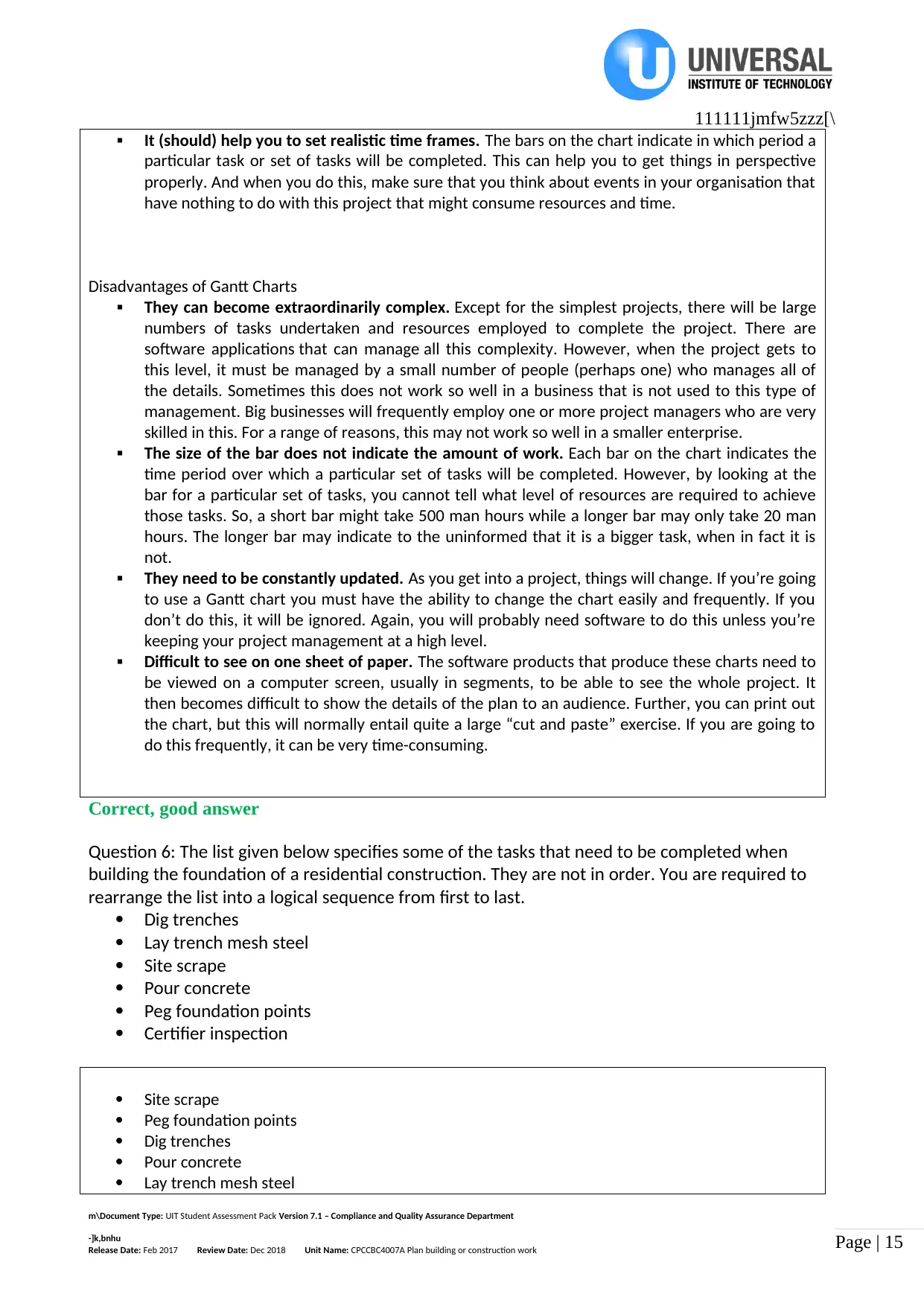
Page | 15
111111jmfw5zzz[\
It (should) help you to set realistic time frames. The bars on the chart indicate in which period a
particular task or set of tasks will be completed. This can help you to get things in perspective
properly. And when you do this, make sure that you think about events in your organisation that
have nothing to do with this project that might consume resources and time.
Disadvantages of Gantt Charts
They can become extraordinarily complex. Except for the simplest projects, there will be large
numbers of tasks undertaken and resources employed to complete the project. There are
software applications that can manage all this complexity. However, when the project gets to
this level, it must be managed by a small number of people (perhaps one) who manages all of
the details. Sometimes this does not work so well in a business that is not used to this type of
management. Big businesses will frequently employ one or more project managers who are very
skilled in this. For a range of reasons, this may not work so well in a smaller enterprise.
The size of the bar does not indicate the amount of work. Each bar on the chart indicates the
time period over which a particular set of tasks will be completed. However, by looking at the
bar for a particular set of tasks, you cannot tell what level of resources are required to achieve
those tasks. So, a short bar might take 500 man hours while a longer bar may only take 20 man
hours. The longer bar may indicate to the uninformed that it is a bigger task, when in fact it is
not.
They need to be constantly updated. As you get into a project, things will change. If you’re going
to use a Gantt chart you must have the ability to change the chart easily and frequently. If you
don’t do this, it will be ignored. Again, you will probably need software to do this unless you’re
keeping your project management at a high level.
Difficult to see on one sheet of paper. The software products that produce these charts need to
be viewed on a computer screen, usually in segments, to be able to see the whole project. It
then becomes difficult to show the details of the plan to an audience. Further, you can print out
the chart, but this will normally entail quite a large “cut and paste” exercise. If you are going to
do this frequently, it can be very time-consuming.
Correct, good answer
Question 6: The list given below specifies some of the tasks that need to be completed when
building the foundation of a residential construction. They are not in order. You are required to
rearrange the list into a logical sequence from first to last.
Dig trenches
Lay trench mesh steel
Site scrape
Pour concrete
Peg foundation points
Certifier inspection
Site scrape
Peg foundation points
Dig trenches
Pour concrete
Lay trench mesh steel
m\Document Type: UIT Student Assessment Pack Version 7.1 – Compliance and Quality Assurance Department
-]k,bnhu
Release Date: Feb 2017 Review Date: Dec 2018 Unit Name: CPCCBC4007A Plan building or construction work
111111jmfw5zzz[\
It (should) help you to set realistic time frames. The bars on the chart indicate in which period a
particular task or set of tasks will be completed. This can help you to get things in perspective
properly. And when you do this, make sure that you think about events in your organisation that
have nothing to do with this project that might consume resources and time.
Disadvantages of Gantt Charts
They can become extraordinarily complex. Except for the simplest projects, there will be large
numbers of tasks undertaken and resources employed to complete the project. There are
software applications that can manage all this complexity. However, when the project gets to
this level, it must be managed by a small number of people (perhaps one) who manages all of
the details. Sometimes this does not work so well in a business that is not used to this type of
management. Big businesses will frequently employ one or more project managers who are very
skilled in this. For a range of reasons, this may not work so well in a smaller enterprise.
The size of the bar does not indicate the amount of work. Each bar on the chart indicates the
time period over which a particular set of tasks will be completed. However, by looking at the
bar for a particular set of tasks, you cannot tell what level of resources are required to achieve
those tasks. So, a short bar might take 500 man hours while a longer bar may only take 20 man
hours. The longer bar may indicate to the uninformed that it is a bigger task, when in fact it is
not.
They need to be constantly updated. As you get into a project, things will change. If you’re going
to use a Gantt chart you must have the ability to change the chart easily and frequently. If you
don’t do this, it will be ignored. Again, you will probably need software to do this unless you’re
keeping your project management at a high level.
Difficult to see on one sheet of paper. The software products that produce these charts need to
be viewed on a computer screen, usually in segments, to be able to see the whole project. It
then becomes difficult to show the details of the plan to an audience. Further, you can print out
the chart, but this will normally entail quite a large “cut and paste” exercise. If you are going to
do this frequently, it can be very time-consuming.
Correct, good answer
Question 6: The list given below specifies some of the tasks that need to be completed when
building the foundation of a residential construction. They are not in order. You are required to
rearrange the list into a logical sequence from first to last.
Dig trenches
Lay trench mesh steel
Site scrape
Pour concrete
Peg foundation points
Certifier inspection
Site scrape
Peg foundation points
Dig trenches
Pour concrete
Lay trench mesh steel
m\Document Type: UIT Student Assessment Pack Version 7.1 – Compliance and Quality Assurance Department
-]k,bnhu
Release Date: Feb 2017 Review Date: Dec 2018 Unit Name: CPCCBC4007A Plan building or construction work
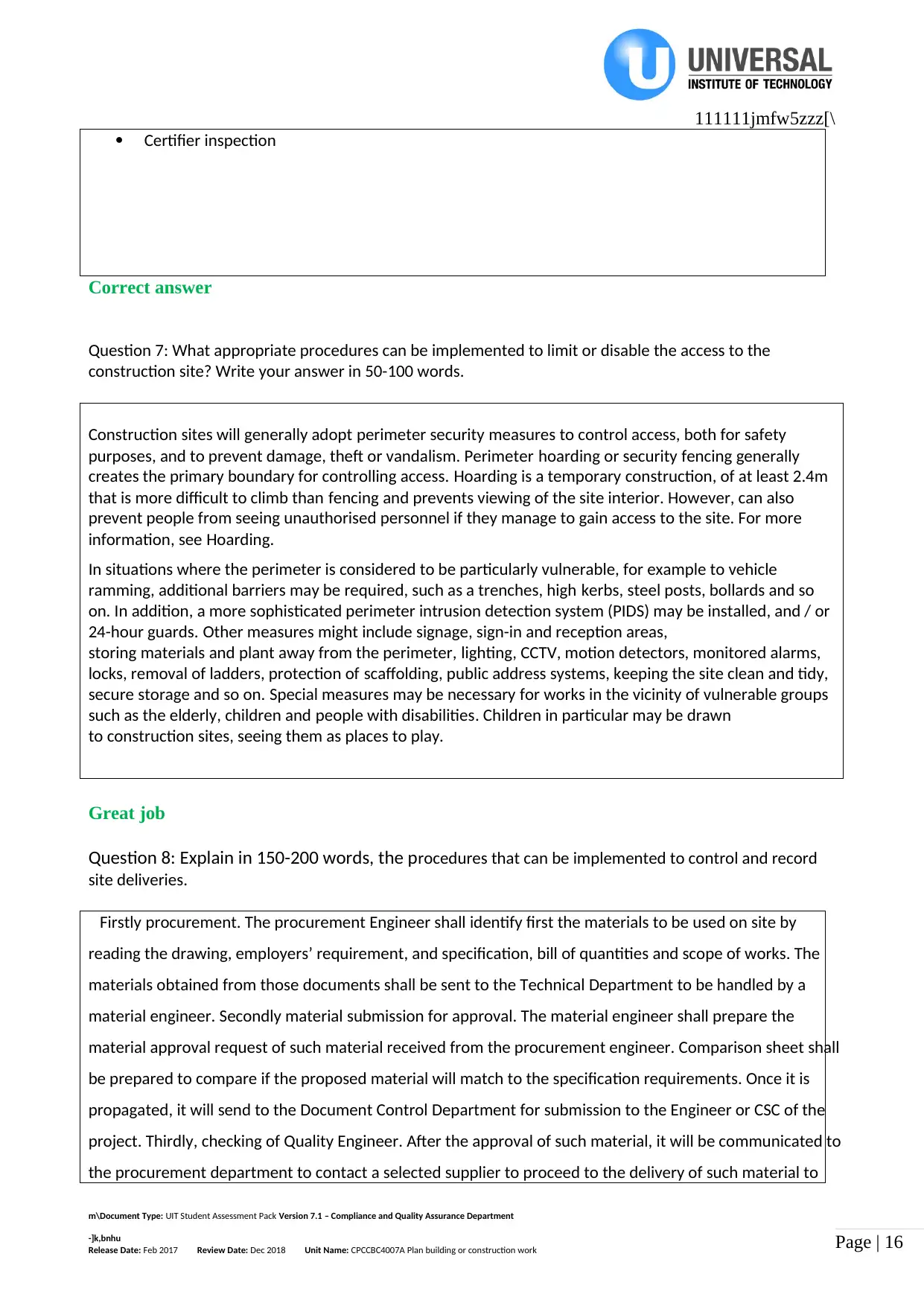
Page | 16
111111jmfw5zzz[\
Certifier inspection
Correct answer
Question 7: What appropriate procedures can be implemented to limit or disable the access to the
construction site? Write your answer in 50-100 words.
Construction sites will generally adopt perimeter security measures to control access, both for safety
purposes, and to prevent damage, theft or vandalism. Perimeter hoarding or security fencing generally
creates the primary boundary for controlling access. Hoarding is a temporary construction, of at least 2.4m
that is more difficult to climb than fencing and prevents viewing of the site interior. However, can also
prevent people from seeing unauthorised personnel if they manage to gain access to the site. For more
information, see Hoarding.
In situations where the perimeter is considered to be particularly vulnerable, for example to vehicle
ramming, additional barriers may be required, such as a trenches, high kerbs, steel posts, bollards and so
on. In addition, a more sophisticated perimeter intrusion detection system (PIDS) may be installed, and / or
24-hour guards. Other measures might include signage, sign-in and reception areas,
storing materials and plant away from the perimeter, lighting, CCTV, motion detectors, monitored alarms,
locks, removal of ladders, protection of scaffolding, public address systems, keeping the site clean and tidy,
secure storage and so on. Special measures may be necessary for works in the vicinity of vulnerable groups
such as the elderly, children and people with disabilities. Children in particular may be drawn
to construction sites, seeing them as places to play.
Great job
Question 8: Explain in 150-200 words, the procedures that can be implemented to control and record
site deliveries.
Firstly procurement. The procurement Engineer shall identify first the materials to be used on site by
reading the drawing, employers’ requirement, and specification, bill of quantities and scope of works. The
materials obtained from those documents shall be sent to the Technical Department to be handled by a
material engineer. Secondly material submission for approval. The material engineer shall prepare the
material approval request of such material received from the procurement engineer. Comparison sheet shall
be prepared to compare if the proposed material will match to the specification requirements. Once it is
propagated, it will send to the Document Control Department for submission to the Engineer or CSC of the
project. Thirdly, checking of Quality Engineer. After the approval of such material, it will be communicated to
the procurement department to contact a selected supplier to proceed to the delivery of such material to
m\Document Type: UIT Student Assessment Pack Version 7.1 – Compliance and Quality Assurance Department
-]k,bnhu
Release Date: Feb 2017 Review Date: Dec 2018 Unit Name: CPCCBC4007A Plan building or construction work
111111jmfw5zzz[\
Certifier inspection
Correct answer
Question 7: What appropriate procedures can be implemented to limit or disable the access to the
construction site? Write your answer in 50-100 words.
Construction sites will generally adopt perimeter security measures to control access, both for safety
purposes, and to prevent damage, theft or vandalism. Perimeter hoarding or security fencing generally
creates the primary boundary for controlling access. Hoarding is a temporary construction, of at least 2.4m
that is more difficult to climb than fencing and prevents viewing of the site interior. However, can also
prevent people from seeing unauthorised personnel if they manage to gain access to the site. For more
information, see Hoarding.
In situations where the perimeter is considered to be particularly vulnerable, for example to vehicle
ramming, additional barriers may be required, such as a trenches, high kerbs, steel posts, bollards and so
on. In addition, a more sophisticated perimeter intrusion detection system (PIDS) may be installed, and / or
24-hour guards. Other measures might include signage, sign-in and reception areas,
storing materials and plant away from the perimeter, lighting, CCTV, motion detectors, monitored alarms,
locks, removal of ladders, protection of scaffolding, public address systems, keeping the site clean and tidy,
secure storage and so on. Special measures may be necessary for works in the vicinity of vulnerable groups
such as the elderly, children and people with disabilities. Children in particular may be drawn
to construction sites, seeing them as places to play.
Great job
Question 8: Explain in 150-200 words, the procedures that can be implemented to control and record
site deliveries.
Firstly procurement. The procurement Engineer shall identify first the materials to be used on site by
reading the drawing, employers’ requirement, and specification, bill of quantities and scope of works. The
materials obtained from those documents shall be sent to the Technical Department to be handled by a
material engineer. Secondly material submission for approval. The material engineer shall prepare the
material approval request of such material received from the procurement engineer. Comparison sheet shall
be prepared to compare if the proposed material will match to the specification requirements. Once it is
propagated, it will send to the Document Control Department for submission to the Engineer or CSC of the
project. Thirdly, checking of Quality Engineer. After the approval of such material, it will be communicated to
the procurement department to contact a selected supplier to proceed to the delivery of such material to
m\Document Type: UIT Student Assessment Pack Version 7.1 – Compliance and Quality Assurance Department
-]k,bnhu
Release Date: Feb 2017 Review Date: Dec 2018 Unit Name: CPCCBC4007A Plan building or construction work
Secure Best Marks with AI Grader
Need help grading? Try our AI Grader for instant feedback on your assignments.
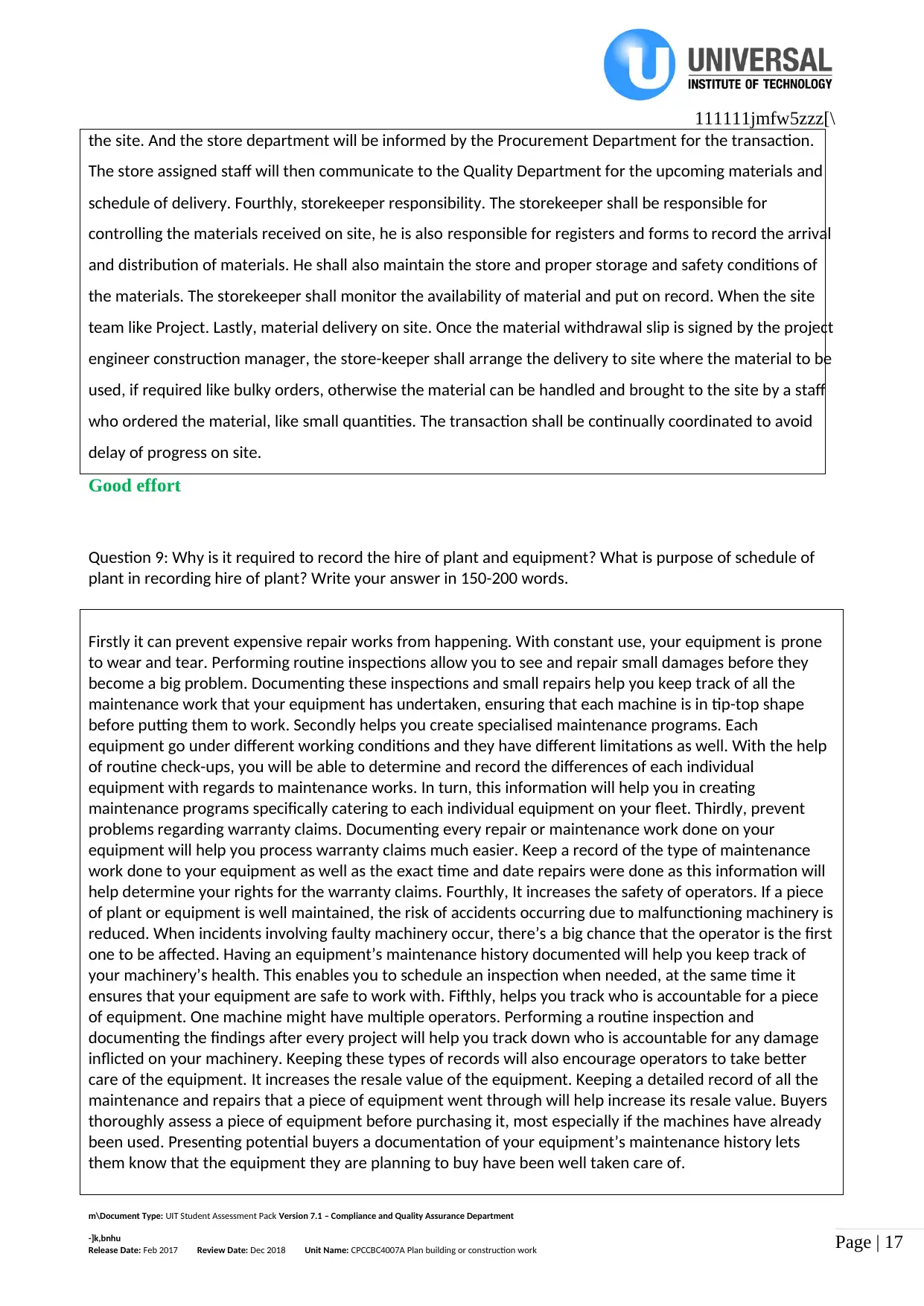
Page | 17
111111jmfw5zzz[\
the site. And the store department will be informed by the Procurement Department for the transaction.
The store assigned staff will then communicate to the Quality Department for the upcoming materials and
schedule of delivery. Fourthly, storekeeper responsibility. The storekeeper shall be responsible for
controlling the materials received on site, he is also responsible for registers and forms to record the arrival
and distribution of materials. He shall also maintain the store and proper storage and safety conditions of
the materials. The storekeeper shall monitor the availability of material and put on record. When the site
team like Project. Lastly, material delivery on site. Once the material withdrawal slip is signed by the project
engineer construction manager, the store-keeper shall arrange the delivery to site where the material to be
used, if required like bulky orders, otherwise the material can be handled and brought to the site by a staff
who ordered the material, like small quantities. The transaction shall be continually coordinated to avoid
delay of progress on site.
Good effort
Question 9: Why is it required to record the hire of plant and equipment? What is purpose of schedule of
plant in recording hire of plant? Write your answer in 150-200 words.
Firstly it can prevent expensive repair works from happening. With constant use, your equipment is prone
to wear and tear. Performing routine inspections allow you to see and repair small damages before they
become a big problem. Documenting these inspections and small repairs help you keep track of all the
maintenance work that your equipment has undertaken, ensuring that each machine is in tip-top shape
before putting them to work. Secondly helps you create specialised maintenance programs. Each
equipment go under different working conditions and they have different limitations as well. With the help
of routine check-ups, you will be able to determine and record the differences of each individual
equipment with regards to maintenance works. In turn, this information will help you in creating
maintenance programs specifically catering to each individual equipment on your fleet. Thirdly, prevent
problems regarding warranty claims. Documenting every repair or maintenance work done on your
equipment will help you process warranty claims much easier. Keep a record of the type of maintenance
work done to your equipment as well as the exact time and date repairs were done as this information will
help determine your rights for the warranty claims. Fourthly, It increases the safety of operators. If a piece
of plant or equipment is well maintained, the risk of accidents occurring due to malfunctioning machinery is
reduced. When incidents involving faulty machinery occur, there’s a big chance that the operator is the first
one to be affected. Having an equipment’s maintenance history documented will help you keep track of
your machinery’s health. This enables you to schedule an inspection when needed, at the same time it
ensures that your equipment are safe to work with. Fifthly, helps you track who is accountable for a piece
of equipment. One machine might have multiple operators. Performing a routine inspection and
documenting the findings after every project will help you track down who is accountable for any damage
inflicted on your machinery. Keeping these types of records will also encourage operators to take better
care of the equipment. It increases the resale value of the equipment. Keeping a detailed record of all the
maintenance and repairs that a piece of equipment went through will help increase its resale value. Buyers
thoroughly assess a piece of equipment before purchasing it, most especially if the machines have already
been used. Presenting potential buyers a documentation of your equipment’s maintenance history lets
them know that the equipment they are planning to buy have been well taken care of.
m\Document Type: UIT Student Assessment Pack Version 7.1 – Compliance and Quality Assurance Department
-]k,bnhu
Release Date: Feb 2017 Review Date: Dec 2018 Unit Name: CPCCBC4007A Plan building or construction work
111111jmfw5zzz[\
the site. And the store department will be informed by the Procurement Department for the transaction.
The store assigned staff will then communicate to the Quality Department for the upcoming materials and
schedule of delivery. Fourthly, storekeeper responsibility. The storekeeper shall be responsible for
controlling the materials received on site, he is also responsible for registers and forms to record the arrival
and distribution of materials. He shall also maintain the store and proper storage and safety conditions of
the materials. The storekeeper shall monitor the availability of material and put on record. When the site
team like Project. Lastly, material delivery on site. Once the material withdrawal slip is signed by the project
engineer construction manager, the store-keeper shall arrange the delivery to site where the material to be
used, if required like bulky orders, otherwise the material can be handled and brought to the site by a staff
who ordered the material, like small quantities. The transaction shall be continually coordinated to avoid
delay of progress on site.
Good effort
Question 9: Why is it required to record the hire of plant and equipment? What is purpose of schedule of
plant in recording hire of plant? Write your answer in 150-200 words.
Firstly it can prevent expensive repair works from happening. With constant use, your equipment is prone
to wear and tear. Performing routine inspections allow you to see and repair small damages before they
become a big problem. Documenting these inspections and small repairs help you keep track of all the
maintenance work that your equipment has undertaken, ensuring that each machine is in tip-top shape
before putting them to work. Secondly helps you create specialised maintenance programs. Each
equipment go under different working conditions and they have different limitations as well. With the help
of routine check-ups, you will be able to determine and record the differences of each individual
equipment with regards to maintenance works. In turn, this information will help you in creating
maintenance programs specifically catering to each individual equipment on your fleet. Thirdly, prevent
problems regarding warranty claims. Documenting every repair or maintenance work done on your
equipment will help you process warranty claims much easier. Keep a record of the type of maintenance
work done to your equipment as well as the exact time and date repairs were done as this information will
help determine your rights for the warranty claims. Fourthly, It increases the safety of operators. If a piece
of plant or equipment is well maintained, the risk of accidents occurring due to malfunctioning machinery is
reduced. When incidents involving faulty machinery occur, there’s a big chance that the operator is the first
one to be affected. Having an equipment’s maintenance history documented will help you keep track of
your machinery’s health. This enables you to schedule an inspection when needed, at the same time it
ensures that your equipment are safe to work with. Fifthly, helps you track who is accountable for a piece
of equipment. One machine might have multiple operators. Performing a routine inspection and
documenting the findings after every project will help you track down who is accountable for any damage
inflicted on your machinery. Keeping these types of records will also encourage operators to take better
care of the equipment. It increases the resale value of the equipment. Keeping a detailed record of all the
maintenance and repairs that a piece of equipment went through will help increase its resale value. Buyers
thoroughly assess a piece of equipment before purchasing it, most especially if the machines have already
been used. Presenting potential buyers a documentation of your equipment’s maintenance history lets
them know that the equipment they are planning to buy have been well taken care of.
m\Document Type: UIT Student Assessment Pack Version 7.1 – Compliance and Quality Assurance Department
-]k,bnhu
Release Date: Feb 2017 Review Date: Dec 2018 Unit Name: CPCCBC4007A Plan building or construction work
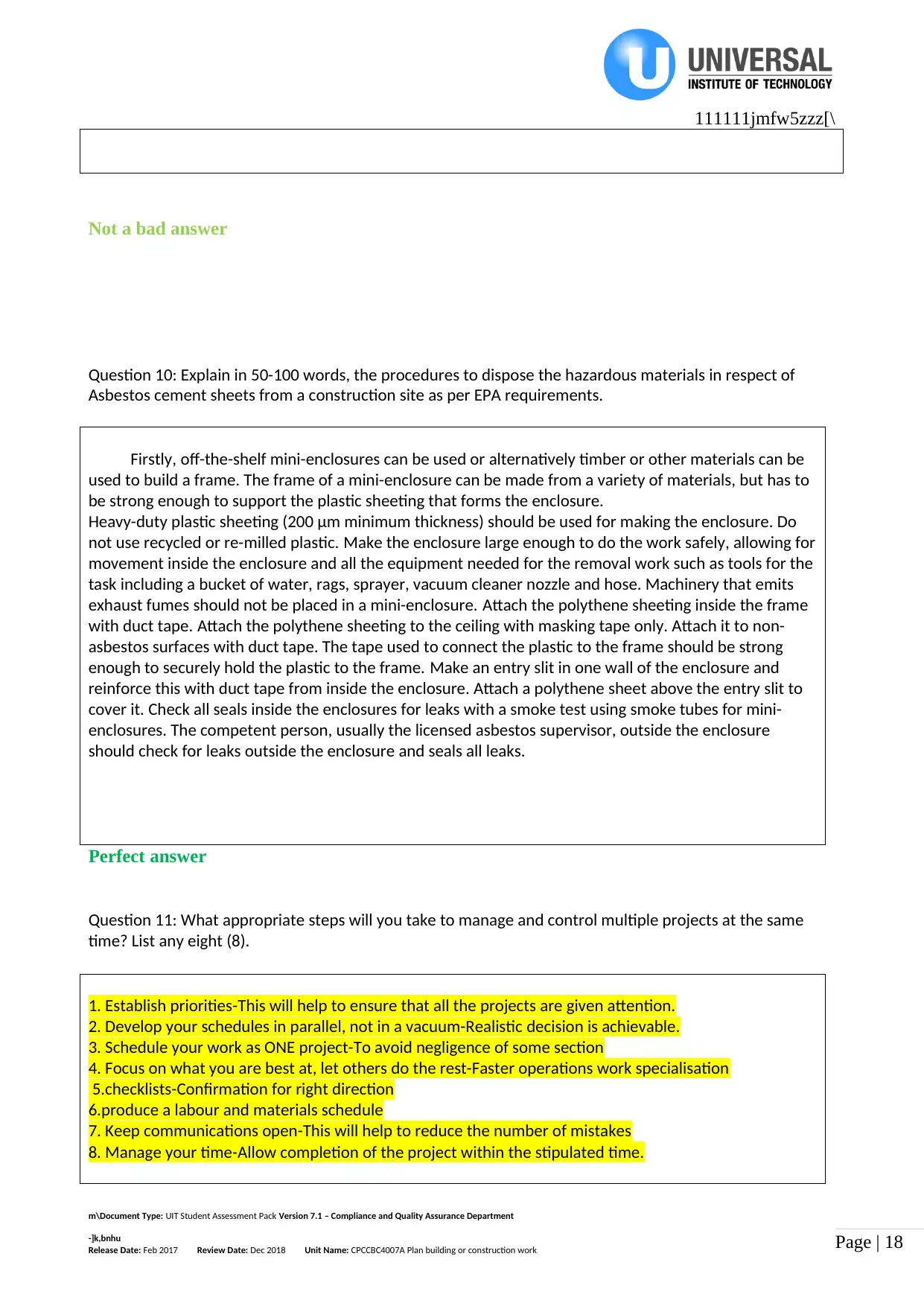
Page | 18
111111jmfw5zzz[\
Not a bad answer
Question 10: Explain in 50-100 words, the procedures to dispose the hazardous materials in respect of
Asbestos cement sheets from a construction site as per EPA requirements.
Firstly, off-the-shelf mini-enclosures can be used or alternatively timber or other materials can be
used to build a frame. The frame of a mini-enclosure can be made from a variety of materials, but has to
be strong enough to support the plastic sheeting that forms the enclosure.
Heavy-duty plastic sheeting (200 μm minimum thickness) should be used for making the enclosure. Do
not use recycled or re-milled plastic. Make the enclosure large enough to do the work safely, allowing for
movement inside the enclosure and all the equipment needed for the removal work such as tools for the
task including a bucket of water, rags, sprayer, vacuum cleaner nozzle and hose. Machinery that emits
exhaust fumes should not be placed in a mini-enclosure. Attach the polythene sheeting inside the frame
with duct tape. Attach the polythene sheeting to the ceiling with masking tape only. Attach it to non-
asbestos surfaces with duct tape. The tape used to connect the plastic to the frame should be strong
enough to securely hold the plastic to the frame. Make an entry slit in one wall of the enclosure and
reinforce this with duct tape from inside the enclosure. Attach a polythene sheet above the entry slit to
cover it. Check all seals inside the enclosures for leaks with a smoke test using smoke tubes for mini-
enclosures. The competent person, usually the licensed asbestos supervisor, outside the enclosure
should check for leaks outside the enclosure and seals all leaks.
Perfect answer
Question 11: What appropriate steps will you take to manage and control multiple projects at the same
time? List any eight (8).
1. Establish priorities-This will help to ensure that all the projects are given attention.
2. Develop your schedules in parallel, not in a vacuum-Realistic decision is achievable.
3. Schedule your work as ONE project-To avoid negligence of some section
4. Focus on what you are best at, let others do the rest-Faster operations work specialisation
5.checklists-Confirmation for right direction
6.produce a labour and materials schedule
7. Keep communications open-This will help to reduce the number of mistakes
8. Manage your time-Allow completion of the project within the stipulated time.
m\Document Type: UIT Student Assessment Pack Version 7.1 – Compliance and Quality Assurance Department
-]k,bnhu
Release Date: Feb 2017 Review Date: Dec 2018 Unit Name: CPCCBC4007A Plan building or construction work
111111jmfw5zzz[\
Not a bad answer
Question 10: Explain in 50-100 words, the procedures to dispose the hazardous materials in respect of
Asbestos cement sheets from a construction site as per EPA requirements.
Firstly, off-the-shelf mini-enclosures can be used or alternatively timber or other materials can be
used to build a frame. The frame of a mini-enclosure can be made from a variety of materials, but has to
be strong enough to support the plastic sheeting that forms the enclosure.
Heavy-duty plastic sheeting (200 μm minimum thickness) should be used for making the enclosure. Do
not use recycled or re-milled plastic. Make the enclosure large enough to do the work safely, allowing for
movement inside the enclosure and all the equipment needed for the removal work such as tools for the
task including a bucket of water, rags, sprayer, vacuum cleaner nozzle and hose. Machinery that emits
exhaust fumes should not be placed in a mini-enclosure. Attach the polythene sheeting inside the frame
with duct tape. Attach the polythene sheeting to the ceiling with masking tape only. Attach it to non-
asbestos surfaces with duct tape. The tape used to connect the plastic to the frame should be strong
enough to securely hold the plastic to the frame. Make an entry slit in one wall of the enclosure and
reinforce this with duct tape from inside the enclosure. Attach a polythene sheet above the entry slit to
cover it. Check all seals inside the enclosures for leaks with a smoke test using smoke tubes for mini-
enclosures. The competent person, usually the licensed asbestos supervisor, outside the enclosure
should check for leaks outside the enclosure and seals all leaks.
Perfect answer
Question 11: What appropriate steps will you take to manage and control multiple projects at the same
time? List any eight (8).
1. Establish priorities-This will help to ensure that all the projects are given attention.
2. Develop your schedules in parallel, not in a vacuum-Realistic decision is achievable.
3. Schedule your work as ONE project-To avoid negligence of some section
4. Focus on what you are best at, let others do the rest-Faster operations work specialisation
5.checklists-Confirmation for right direction
6.produce a labour and materials schedule
7. Keep communications open-This will help to reduce the number of mistakes
8. Manage your time-Allow completion of the project within the stipulated time.
m\Document Type: UIT Student Assessment Pack Version 7.1 – Compliance and Quality Assurance Department
-]k,bnhu
Release Date: Feb 2017 Review Date: Dec 2018 Unit Name: CPCCBC4007A Plan building or construction work
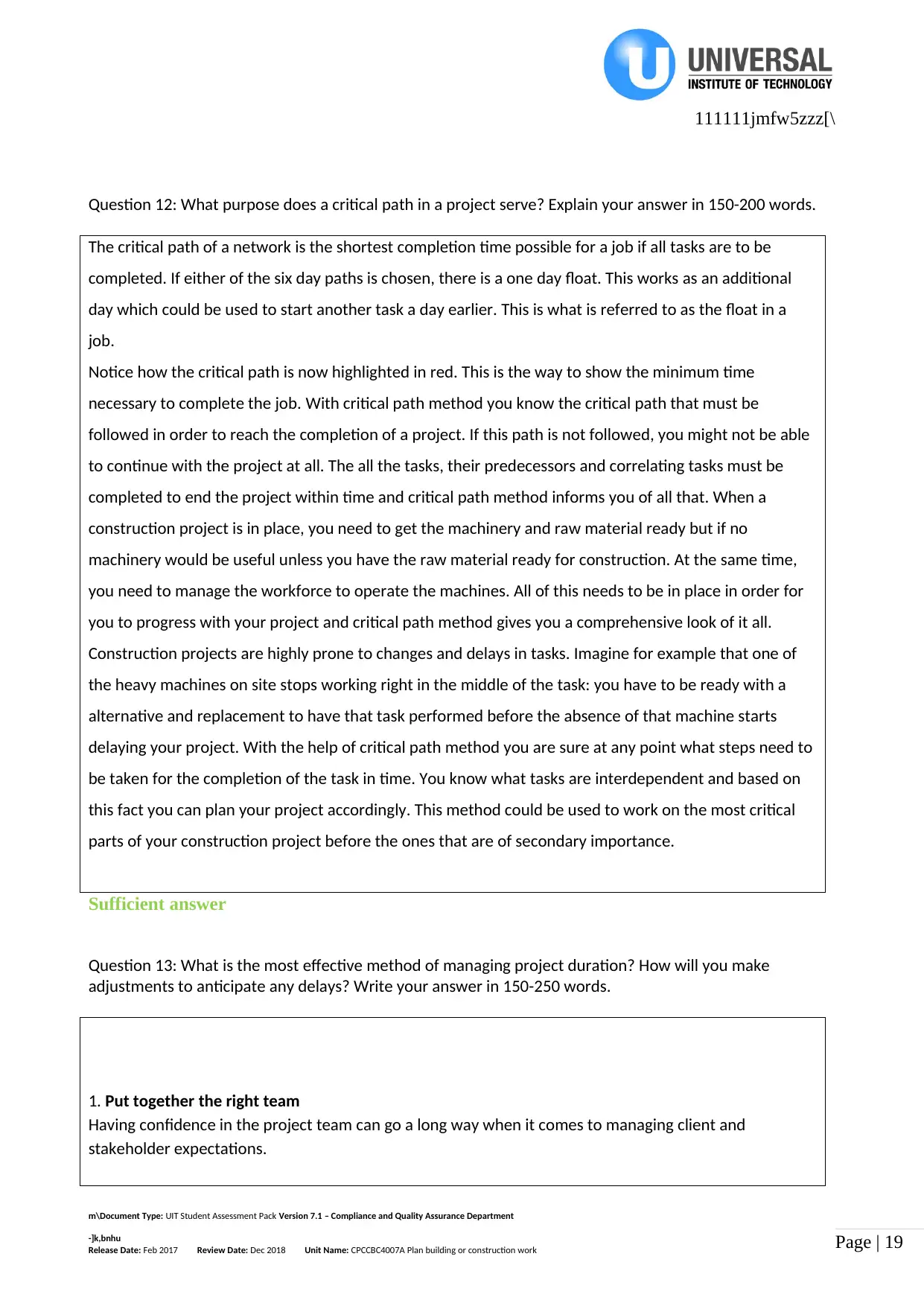
Page | 19
111111jmfw5zzz[\
Question 12: What purpose does a critical path in a project serve? Explain your answer in 150-200 words.
The critical path of a network is the shortest completion time possible for a job if all tasks are to be
completed. If either of the six day paths is chosen, there is a one day float. This works as an additional
day which could be used to start another task a day earlier. This is what is referred to as the float in a
job.
Notice how the critical path is now highlighted in red. This is the way to show the minimum time
necessary to complete the job. With critical path method you know the critical path that must be
followed in order to reach the completion of a project. If this path is not followed, you might not be able
to continue with the project at all. The all the tasks, their predecessors and correlating tasks must be
completed to end the project within time and critical path method informs you of all that. When a
construction project is in place, you need to get the machinery and raw material ready but if no
machinery would be useful unless you have the raw material ready for construction. At the same time,
you need to manage the workforce to operate the machines. All of this needs to be in place in order for
you to progress with your project and critical path method gives you a comprehensive look of it all.
Construction projects are highly prone to changes and delays in tasks. Imagine for example that one of
the heavy machines on site stops working right in the middle of the task: you have to be ready with a
alternative and replacement to have that task performed before the absence of that machine starts
delaying your project. With the help of critical path method you are sure at any point what steps need to
be taken for the completion of the task in time. You know what tasks are interdependent and based on
this fact you can plan your project accordingly. This method could be used to work on the most critical
parts of your construction project before the ones that are of secondary importance.
Sufficient answer
Question 13: What is the most effective method of managing project duration? How will you make
adjustments to anticipate any delays? Write your answer in 150-250 words.
1. Put together the right team
Having confidence in the project team can go a long way when it comes to managing client and
stakeholder expectations.
m\Document Type: UIT Student Assessment Pack Version 7.1 – Compliance and Quality Assurance Department
-]k,bnhu
Release Date: Feb 2017 Review Date: Dec 2018 Unit Name: CPCCBC4007A Plan building or construction work
111111jmfw5zzz[\
Question 12: What purpose does a critical path in a project serve? Explain your answer in 150-200 words.
The critical path of a network is the shortest completion time possible for a job if all tasks are to be
completed. If either of the six day paths is chosen, there is a one day float. This works as an additional
day which could be used to start another task a day earlier. This is what is referred to as the float in a
job.
Notice how the critical path is now highlighted in red. This is the way to show the minimum time
necessary to complete the job. With critical path method you know the critical path that must be
followed in order to reach the completion of a project. If this path is not followed, you might not be able
to continue with the project at all. The all the tasks, their predecessors and correlating tasks must be
completed to end the project within time and critical path method informs you of all that. When a
construction project is in place, you need to get the machinery and raw material ready but if no
machinery would be useful unless you have the raw material ready for construction. At the same time,
you need to manage the workforce to operate the machines. All of this needs to be in place in order for
you to progress with your project and critical path method gives you a comprehensive look of it all.
Construction projects are highly prone to changes and delays in tasks. Imagine for example that one of
the heavy machines on site stops working right in the middle of the task: you have to be ready with a
alternative and replacement to have that task performed before the absence of that machine starts
delaying your project. With the help of critical path method you are sure at any point what steps need to
be taken for the completion of the task in time. You know what tasks are interdependent and based on
this fact you can plan your project accordingly. This method could be used to work on the most critical
parts of your construction project before the ones that are of secondary importance.
Sufficient answer
Question 13: What is the most effective method of managing project duration? How will you make
adjustments to anticipate any delays? Write your answer in 150-250 words.
1. Put together the right team
Having confidence in the project team can go a long way when it comes to managing client and
stakeholder expectations.
m\Document Type: UIT Student Assessment Pack Version 7.1 – Compliance and Quality Assurance Department
-]k,bnhu
Release Date: Feb 2017 Review Date: Dec 2018 Unit Name: CPCCBC4007A Plan building or construction work
Paraphrase This Document
Need a fresh take? Get an instant paraphrase of this document with our AI Paraphraser
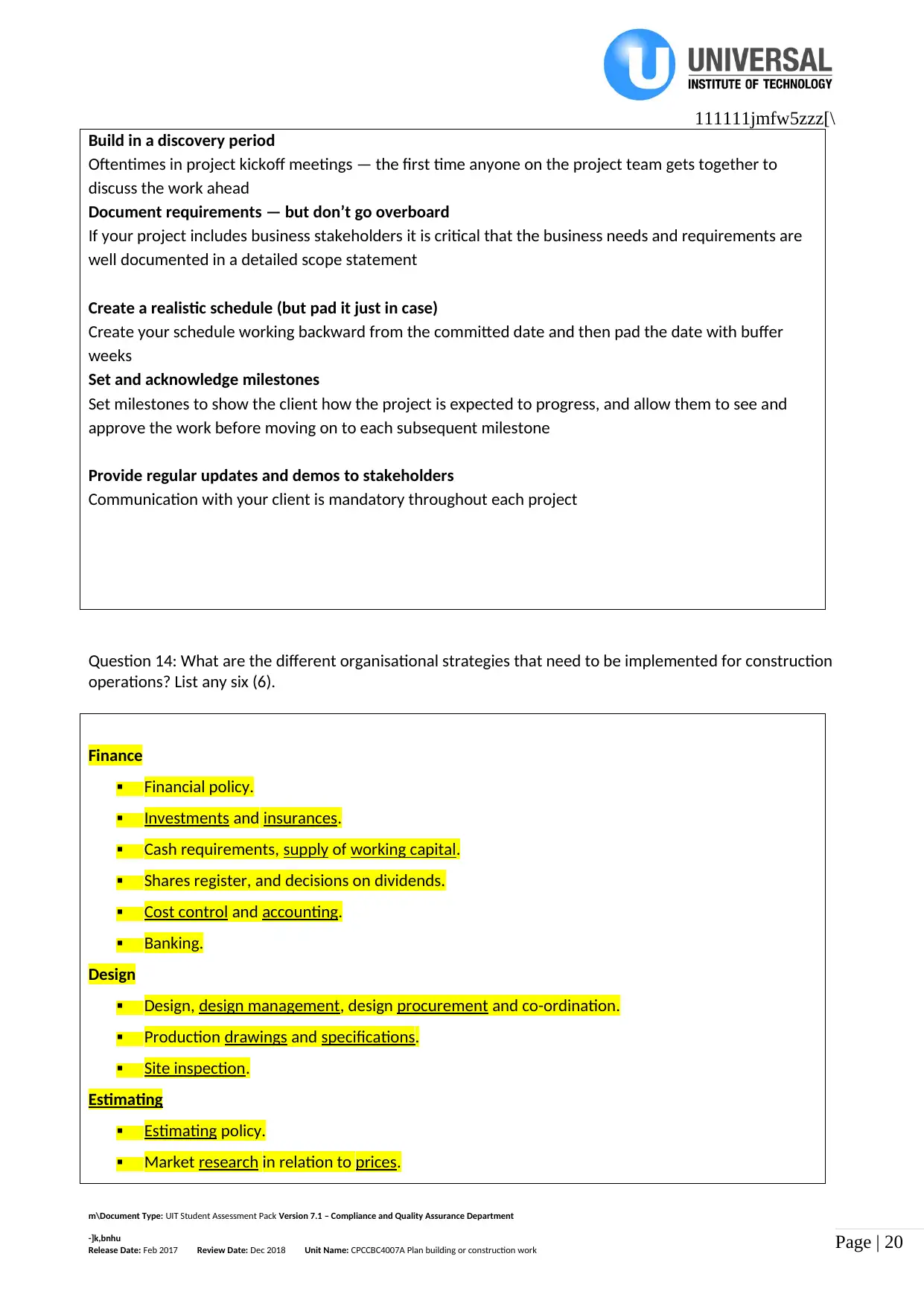
Page | 20
111111jmfw5zzz[\
Build in a discovery period
Oftentimes in project kickoff meetings — the first time anyone on the project team gets together to
discuss the work ahead
Document requirements — but don’t go overboard
If your project includes business stakeholders it is critical that the business needs and requirements are
well documented in a detailed scope statement
Create a realistic schedule (but pad it just in case)
Create your schedule working backward from the committed date and then pad the date with buffer
weeks
Set and acknowledge milestones
Set milestones to show the client how the project is expected to progress, and allow them to see and
approve the work before moving on to each subsequent milestone
Provide regular updates and demos to stakeholders
Communication with your client is mandatory throughout each project
Question 14: What are the different organisational strategies that need to be implemented for construction
operations? List any six (6).
Finance
Financial policy.
Investments and insurances.
Cash requirements, supply of working capital.
Shares register, and decisions on dividends.
Cost control and accounting.
Banking.
Design
Design, design management, design procurement and co-ordination.
Production drawings and specifications.
Site inspection.
Estimating
Estimating policy.
Market research in relation to prices.
m\Document Type: UIT Student Assessment Pack Version 7.1 – Compliance and Quality Assurance Department
-]k,bnhu
Release Date: Feb 2017 Review Date: Dec 2018 Unit Name: CPCCBC4007A Plan building or construction work
111111jmfw5zzz[\
Build in a discovery period
Oftentimes in project kickoff meetings — the first time anyone on the project team gets together to
discuss the work ahead
Document requirements — but don’t go overboard
If your project includes business stakeholders it is critical that the business needs and requirements are
well documented in a detailed scope statement
Create a realistic schedule (but pad it just in case)
Create your schedule working backward from the committed date and then pad the date with buffer
weeks
Set and acknowledge milestones
Set milestones to show the client how the project is expected to progress, and allow them to see and
approve the work before moving on to each subsequent milestone
Provide regular updates and demos to stakeholders
Communication with your client is mandatory throughout each project
Question 14: What are the different organisational strategies that need to be implemented for construction
operations? List any six (6).
Finance
Financial policy.
Investments and insurances.
Cash requirements, supply of working capital.
Shares register, and decisions on dividends.
Cost control and accounting.
Banking.
Design
Design, design management, design procurement and co-ordination.
Production drawings and specifications.
Site inspection.
Estimating
Estimating policy.
Market research in relation to prices.
m\Document Type: UIT Student Assessment Pack Version 7.1 – Compliance and Quality Assurance Department
-]k,bnhu
Release Date: Feb 2017 Review Date: Dec 2018 Unit Name: CPCCBC4007A Plan building or construction work
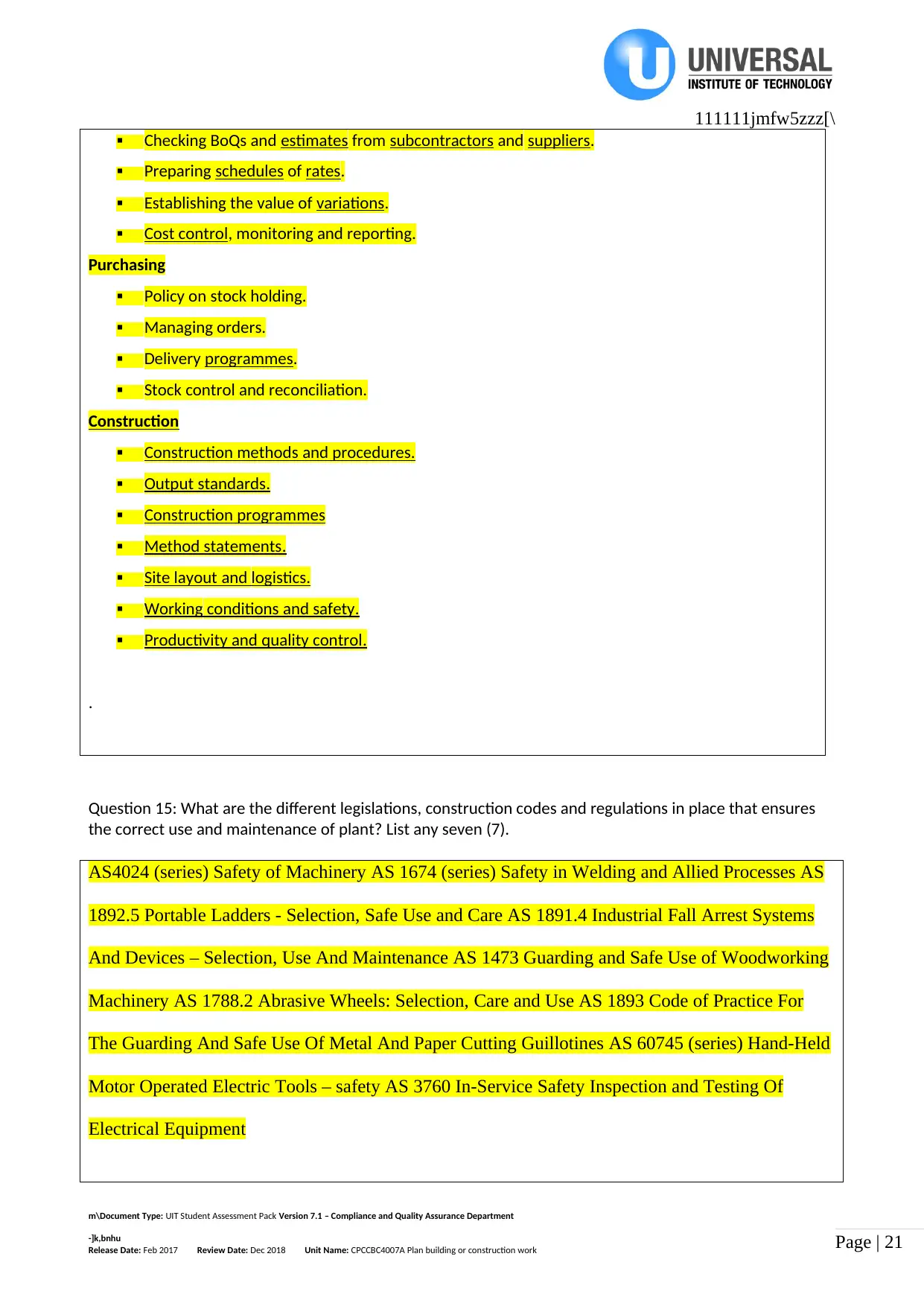
Page | 21
111111jmfw5zzz[\
Checking BoQs and estimates from subcontractors and suppliers.
Preparing schedules of rates.
Establishing the value of variations.
Cost control, monitoring and reporting.
Purchasing
Policy on stock holding.
Managing orders.
Delivery programmes.
Stock control and reconciliation.
Construction
Construction methods and procedures.
Output standards.
Construction programmes
Method statements.
Site layout and logistics.
Working conditions and safety.
Productivity and quality control.
.
Question 15: What are the different legislations, construction codes and regulations in place that ensures
the correct use and maintenance of plant? List any seven (7).
AS4024 (series) Safety of Machinery AS 1674 (series) Safety in Welding and Allied Processes AS
1892.5 Portable Ladders - Selection, Safe Use and Care AS 1891.4 Industrial Fall Arrest Systems
And Devices – Selection, Use And Maintenance AS 1473 Guarding and Safe Use of Woodworking
Machinery AS 1788.2 Abrasive Wheels: Selection, Care and Use AS 1893 Code of Practice For
The Guarding And Safe Use Of Metal And Paper Cutting Guillotines AS 60745 (series) Hand-Held
Motor Operated Electric Tools – safety AS 3760 In-Service Safety Inspection and Testing Of
Electrical Equipment
m\Document Type: UIT Student Assessment Pack Version 7.1 – Compliance and Quality Assurance Department
-]k,bnhu
Release Date: Feb 2017 Review Date: Dec 2018 Unit Name: CPCCBC4007A Plan building or construction work
111111jmfw5zzz[\
Checking BoQs and estimates from subcontractors and suppliers.
Preparing schedules of rates.
Establishing the value of variations.
Cost control, monitoring and reporting.
Purchasing
Policy on stock holding.
Managing orders.
Delivery programmes.
Stock control and reconciliation.
Construction
Construction methods and procedures.
Output standards.
Construction programmes
Method statements.
Site layout and logistics.
Working conditions and safety.
Productivity and quality control.
.
Question 15: What are the different legislations, construction codes and regulations in place that ensures
the correct use and maintenance of plant? List any seven (7).
AS4024 (series) Safety of Machinery AS 1674 (series) Safety in Welding and Allied Processes AS
1892.5 Portable Ladders - Selection, Safe Use and Care AS 1891.4 Industrial Fall Arrest Systems
And Devices – Selection, Use And Maintenance AS 1473 Guarding and Safe Use of Woodworking
Machinery AS 1788.2 Abrasive Wheels: Selection, Care and Use AS 1893 Code of Practice For
The Guarding And Safe Use Of Metal And Paper Cutting Guillotines AS 60745 (series) Hand-Held
Motor Operated Electric Tools – safety AS 3760 In-Service Safety Inspection and Testing Of
Electrical Equipment
m\Document Type: UIT Student Assessment Pack Version 7.1 – Compliance and Quality Assurance Department
-]k,bnhu
Release Date: Feb 2017 Review Date: Dec 2018 Unit Name: CPCCBC4007A Plan building or construction work
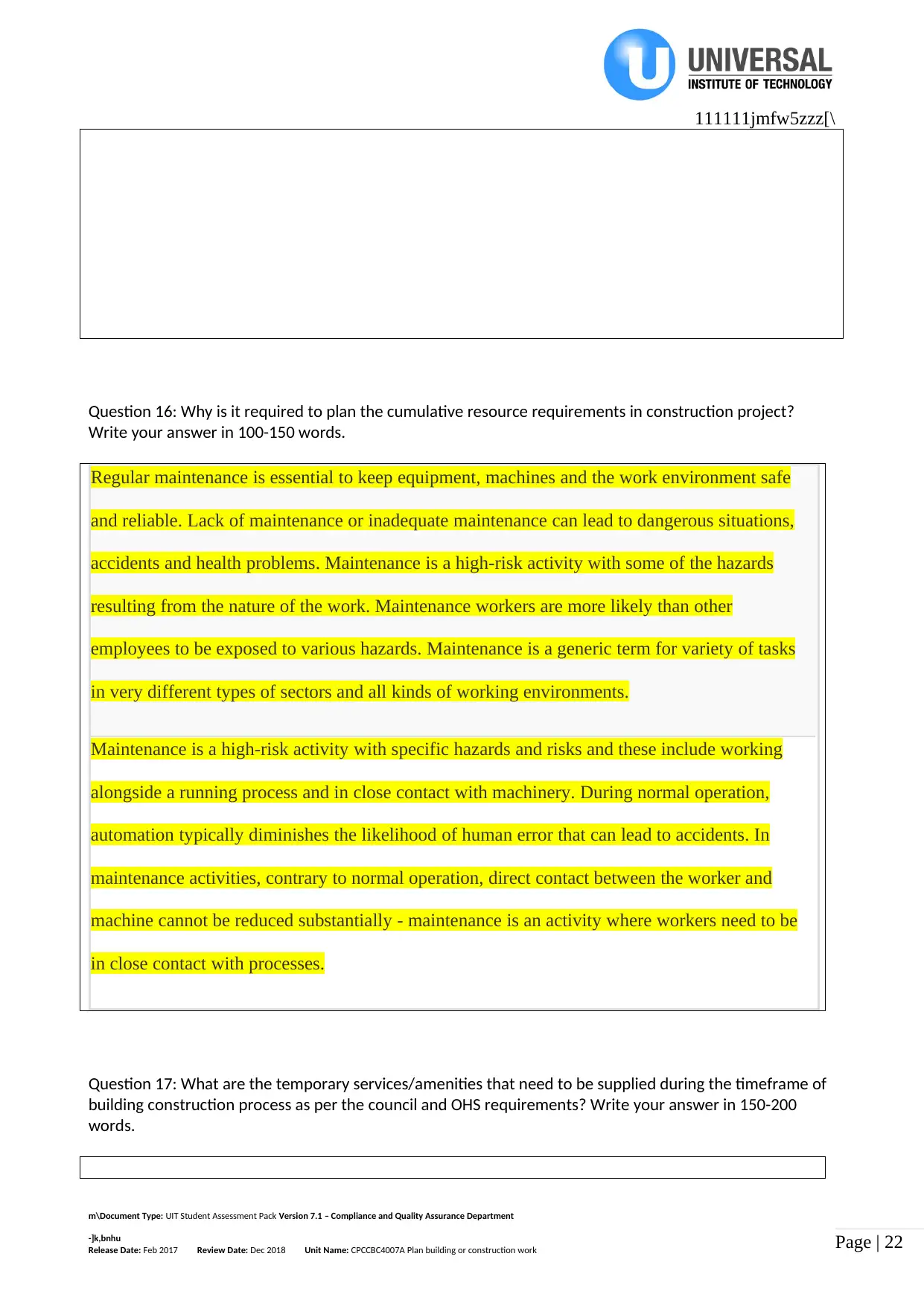
Page | 22
111111jmfw5zzz[\
Question 16: Why is it required to plan the cumulative resource requirements in construction project?
Write your answer in 100-150 words.
Regular maintenance is essential to keep equipment, machines and the work environment safe
and reliable. Lack of maintenance or inadequate maintenance can lead to dangerous situations,
accidents and health problems. Maintenance is a high-risk activity with some of the hazards
resulting from the nature of the work. Maintenance workers are more likely than other
employees to be exposed to various hazards. Maintenance is a generic term for variety of tasks
in very different types of sectors and all kinds of working environments.
Maintenance is a high-risk activity with specific hazards and risks and these include working
alongside a running process and in close contact with machinery. During normal operation,
automation typically diminishes the likelihood of human error that can lead to accidents. In
maintenance activities, contrary to normal operation, direct contact between the worker and
machine cannot be reduced substantially - maintenance is an activity where workers need to be
in close contact with processes.
Question 17: What are the temporary services/amenities that need to be supplied during the timeframe of
building construction process as per the council and OHS requirements? Write your answer in 150-200
words.
m\Document Type: UIT Student Assessment Pack Version 7.1 – Compliance and Quality Assurance Department
-]k,bnhu
Release Date: Feb 2017 Review Date: Dec 2018 Unit Name: CPCCBC4007A Plan building or construction work
111111jmfw5zzz[\
Question 16: Why is it required to plan the cumulative resource requirements in construction project?
Write your answer in 100-150 words.
Regular maintenance is essential to keep equipment, machines and the work environment safe
and reliable. Lack of maintenance or inadequate maintenance can lead to dangerous situations,
accidents and health problems. Maintenance is a high-risk activity with some of the hazards
resulting from the nature of the work. Maintenance workers are more likely than other
employees to be exposed to various hazards. Maintenance is a generic term for variety of tasks
in very different types of sectors and all kinds of working environments.
Maintenance is a high-risk activity with specific hazards and risks and these include working
alongside a running process and in close contact with machinery. During normal operation,
automation typically diminishes the likelihood of human error that can lead to accidents. In
maintenance activities, contrary to normal operation, direct contact between the worker and
machine cannot be reduced substantially - maintenance is an activity where workers need to be
in close contact with processes.
Question 17: What are the temporary services/amenities that need to be supplied during the timeframe of
building construction process as per the council and OHS requirements? Write your answer in 150-200
words.
m\Document Type: UIT Student Assessment Pack Version 7.1 – Compliance and Quality Assurance Department
-]k,bnhu
Release Date: Feb 2017 Review Date: Dec 2018 Unit Name: CPCCBC4007A Plan building or construction work
Secure Best Marks with AI Grader
Need help grading? Try our AI Grader for instant feedback on your assignments.
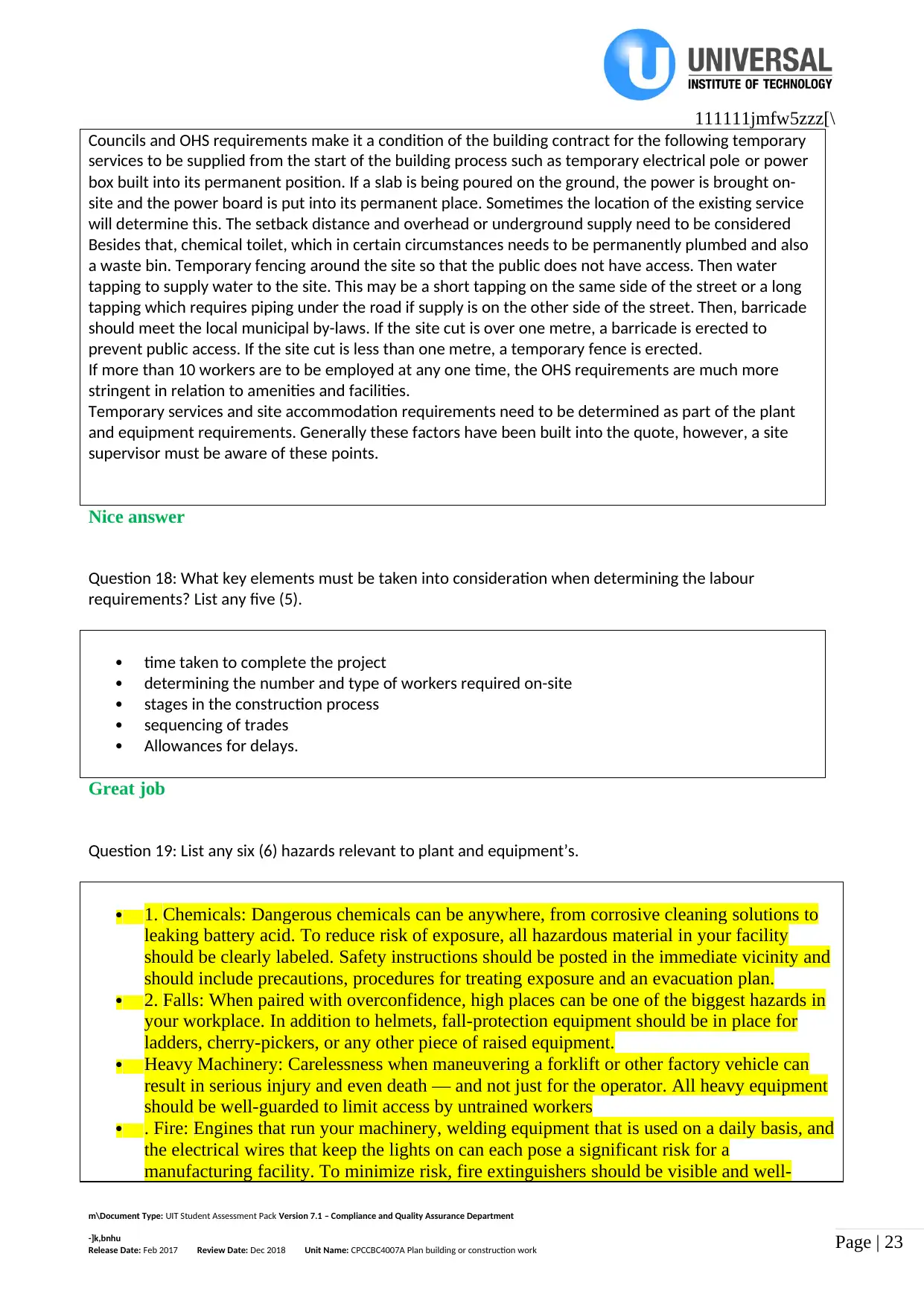
Page | 23
111111jmfw5zzz[\
Councils and OHS requirements make it a condition of the building contract for the following temporary
services to be supplied from the start of the building process such as temporary electrical pole or power
box built into its permanent position. If a slab is being poured on the ground, the power is brought on-
site and the power board is put into its permanent place. Sometimes the location of the existing service
will determine this. The setback distance and overhead or underground supply need to be considered
Besides that, chemical toilet, which in certain circumstances needs to be permanently plumbed and also
a waste bin. Temporary fencing around the site so that the public does not have access. Then water
tapping to supply water to the site. This may be a short tapping on the same side of the street or a long
tapping which requires piping under the road if supply is on the other side of the street. Then, barricade
should meet the local municipal by-laws. If the site cut is over one metre, a barricade is erected to
prevent public access. If the site cut is less than one metre, a temporary fence is erected.
If more than 10 workers are to be employed at any one time, the OHS requirements are much more
stringent in relation to amenities and facilities.
Temporary services and site accommodation requirements need to be determined as part of the plant
and equipment requirements. Generally these factors have been built into the quote, however, a site
supervisor must be aware of these points.
Nice answer
Question 18: What key elements must be taken into consideration when determining the labour
requirements? List any five (5).
time taken to complete the project
determining the number and type of workers required on-site
stages in the construction process
sequencing of trades
Allowances for delays.
Great job
Question 19: List any six (6) hazards relevant to plant and equipment’s.
1. Chemicals: Dangerous chemicals can be anywhere, from corrosive cleaning solutions to
leaking battery acid. To reduce risk of exposure, all hazardous material in your facility
should be clearly labeled. Safety instructions should be posted in the immediate vicinity and
should include precautions, procedures for treating exposure and an evacuation plan.
2. Falls: When paired with overconfidence, high places can be one of the biggest hazards in
your workplace. In addition to helmets, fall-protection equipment should be in place for
ladders, cherry-pickers, or any other piece of raised equipment.
Heavy Machinery: Carelessness when maneuvering a forklift or other factory vehicle can
result in serious injury and even death — and not just for the operator. All heavy equipment
should be well-guarded to limit access by untrained workers
. Fire: Engines that run your machinery, welding equipment that is used on a daily basis, and
the electrical wires that keep the lights on can each pose a significant risk for a
manufacturing facility. To minimize risk, fire extinguishers should be visible and well-
m\Document Type: UIT Student Assessment Pack Version 7.1 – Compliance and Quality Assurance Department
-]k,bnhu
Release Date: Feb 2017 Review Date: Dec 2018 Unit Name: CPCCBC4007A Plan building or construction work
111111jmfw5zzz[\
Councils and OHS requirements make it a condition of the building contract for the following temporary
services to be supplied from the start of the building process such as temporary electrical pole or power
box built into its permanent position. If a slab is being poured on the ground, the power is brought on-
site and the power board is put into its permanent place. Sometimes the location of the existing service
will determine this. The setback distance and overhead or underground supply need to be considered
Besides that, chemical toilet, which in certain circumstances needs to be permanently plumbed and also
a waste bin. Temporary fencing around the site so that the public does not have access. Then water
tapping to supply water to the site. This may be a short tapping on the same side of the street or a long
tapping which requires piping under the road if supply is on the other side of the street. Then, barricade
should meet the local municipal by-laws. If the site cut is over one metre, a barricade is erected to
prevent public access. If the site cut is less than one metre, a temporary fence is erected.
If more than 10 workers are to be employed at any one time, the OHS requirements are much more
stringent in relation to amenities and facilities.
Temporary services and site accommodation requirements need to be determined as part of the plant
and equipment requirements. Generally these factors have been built into the quote, however, a site
supervisor must be aware of these points.
Nice answer
Question 18: What key elements must be taken into consideration when determining the labour
requirements? List any five (5).
time taken to complete the project
determining the number and type of workers required on-site
stages in the construction process
sequencing of trades
Allowances for delays.
Great job
Question 19: List any six (6) hazards relevant to plant and equipment’s.
1. Chemicals: Dangerous chemicals can be anywhere, from corrosive cleaning solutions to
leaking battery acid. To reduce risk of exposure, all hazardous material in your facility
should be clearly labeled. Safety instructions should be posted in the immediate vicinity and
should include precautions, procedures for treating exposure and an evacuation plan.
2. Falls: When paired with overconfidence, high places can be one of the biggest hazards in
your workplace. In addition to helmets, fall-protection equipment should be in place for
ladders, cherry-pickers, or any other piece of raised equipment.
Heavy Machinery: Carelessness when maneuvering a forklift or other factory vehicle can
result in serious injury and even death — and not just for the operator. All heavy equipment
should be well-guarded to limit access by untrained workers
. Fire: Engines that run your machinery, welding equipment that is used on a daily basis, and
the electrical wires that keep the lights on can each pose a significant risk for a
manufacturing facility. To minimize risk, fire extinguishers should be visible and well-
m\Document Type: UIT Student Assessment Pack Version 7.1 – Compliance and Quality Assurance Department
-]k,bnhu
Release Date: Feb 2017 Review Date: Dec 2018 Unit Name: CPCCBC4007A Plan building or construction work
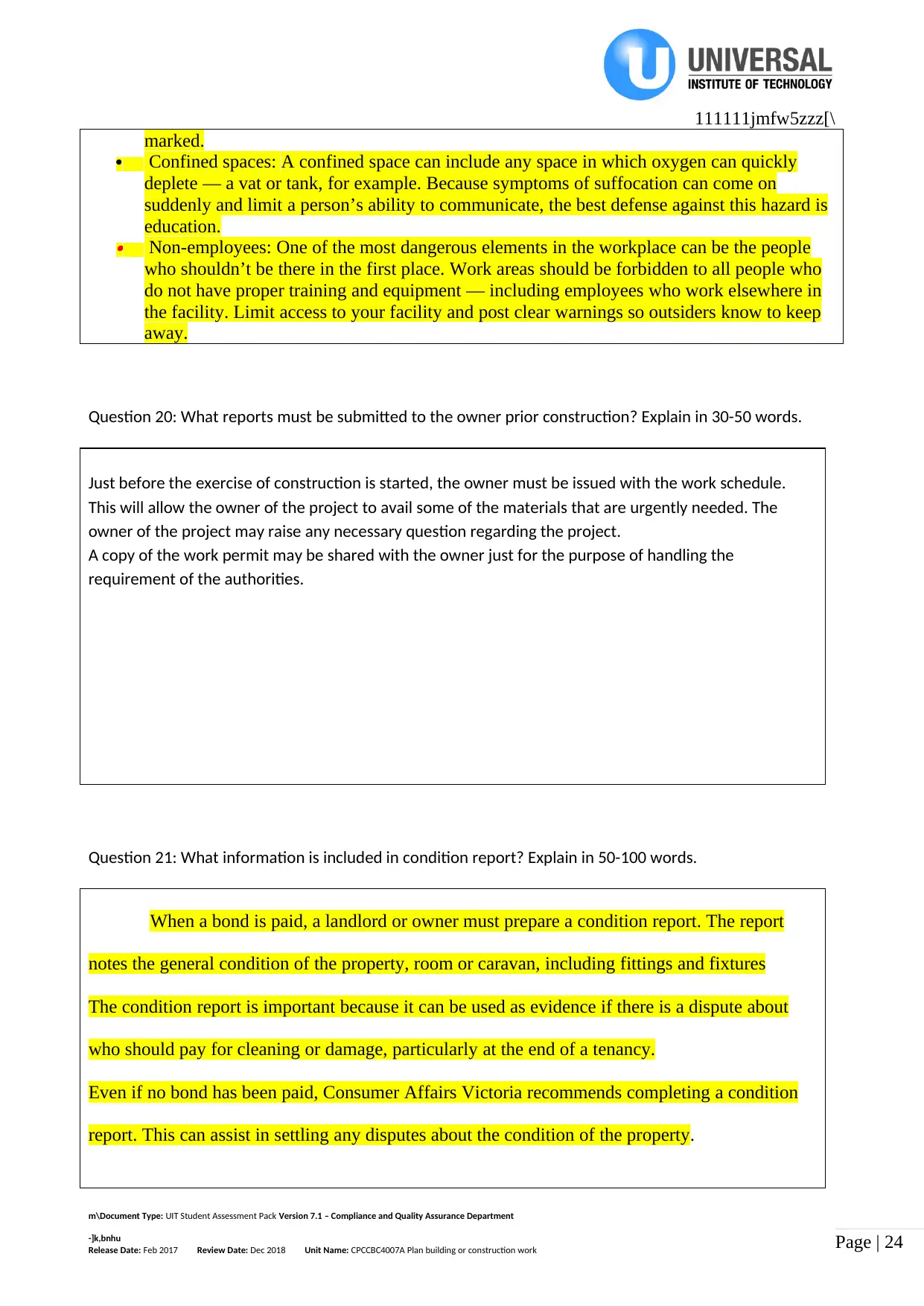
Page | 24
111111jmfw5zzz[\
marked.
Confined spaces: A confined space can include any space in which oxygen can quickly
deplete — a vat or tank, for example. Because symptoms of suffocation can come on
suddenly and limit a person’s ability to communicate, the best defense against this hazard is
education.
Non-employees: One of the most dangerous elements in the workplace can be the people
who shouldn’t be there in the first place. Work areas should be forbidden to all people who
do not have proper training and equipment — including employees who work elsewhere in
the facility. Limit access to your facility and post clear warnings so outsiders know to keep
away.
Question 20: What reports must be submitted to the owner prior construction? Explain in 30-50 words.
Just before the exercise of construction is started, the owner must be issued with the work schedule.
This will allow the owner of the project to avail some of the materials that are urgently needed. The
owner of the project may raise any necessary question regarding the project.
A copy of the work permit may be shared with the owner just for the purpose of handling the
requirement of the authorities.
Question 21: What information is included in condition report? Explain in 50-100 words.
When a bond is paid, a landlord or owner must prepare a condition report. The report
notes the general condition of the property, room or caravan, including fittings and fixtures
The condition report is important because it can be used as evidence if there is a dispute about
who should pay for cleaning or damage, particularly at the end of a tenancy.
Even if no bond has been paid, Consumer Affairs Victoria recommends completing a condition
report. This can assist in settling any disputes about the condition of the property.
m\Document Type: UIT Student Assessment Pack Version 7.1 – Compliance and Quality Assurance Department
-]k,bnhu
Release Date: Feb 2017 Review Date: Dec 2018 Unit Name: CPCCBC4007A Plan building or construction work
111111jmfw5zzz[\
marked.
Confined spaces: A confined space can include any space in which oxygen can quickly
deplete — a vat or tank, for example. Because symptoms of suffocation can come on
suddenly and limit a person’s ability to communicate, the best defense against this hazard is
education.
Non-employees: One of the most dangerous elements in the workplace can be the people
who shouldn’t be there in the first place. Work areas should be forbidden to all people who
do not have proper training and equipment — including employees who work elsewhere in
the facility. Limit access to your facility and post clear warnings so outsiders know to keep
away.
Question 20: What reports must be submitted to the owner prior construction? Explain in 30-50 words.
Just before the exercise of construction is started, the owner must be issued with the work schedule.
This will allow the owner of the project to avail some of the materials that are urgently needed. The
owner of the project may raise any necessary question regarding the project.
A copy of the work permit may be shared with the owner just for the purpose of handling the
requirement of the authorities.
Question 21: What information is included in condition report? Explain in 50-100 words.
When a bond is paid, a landlord or owner must prepare a condition report. The report
notes the general condition of the property, room or caravan, including fittings and fixtures
The condition report is important because it can be used as evidence if there is a dispute about
who should pay for cleaning or damage, particularly at the end of a tenancy.
Even if no bond has been paid, Consumer Affairs Victoria recommends completing a condition
report. This can assist in settling any disputes about the condition of the property.
m\Document Type: UIT Student Assessment Pack Version 7.1 – Compliance and Quality Assurance Department
-]k,bnhu
Release Date: Feb 2017 Review Date: Dec 2018 Unit Name: CPCCBC4007A Plan building or construction work
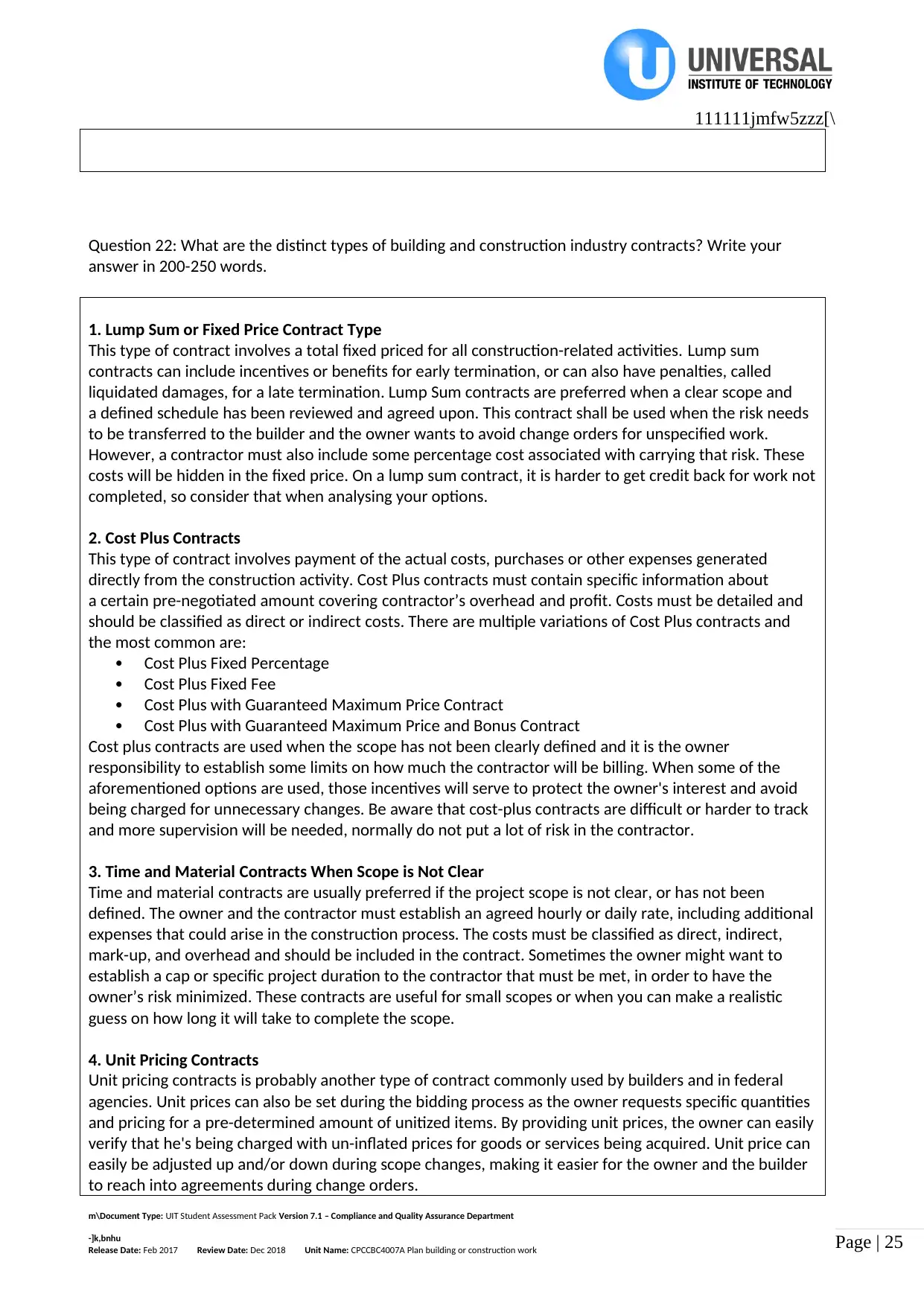
Page | 25
111111jmfw5zzz[\
Question 22: What are the distinct types of building and construction industry contracts? Write your
answer in 200-250 words.
1. Lump Sum or Fixed Price Contract Type
This type of contract involves a total fixed priced for all construction-related activities. Lump sum
contracts can include incentives or benefits for early termination, or can also have penalties, called
liquidated damages, for a late termination. Lump Sum contracts are preferred when a clear scope and
a defined schedule has been reviewed and agreed upon. This contract shall be used when the risk needs
to be transferred to the builder and the owner wants to avoid change orders for unspecified work.
However, a contractor must also include some percentage cost associated with carrying that risk. These
costs will be hidden in the fixed price. On a lump sum contract, it is harder to get credit back for work not
completed, so consider that when analysing your options.
2. Cost Plus Contracts
This type of contract involves payment of the actual costs, purchases or other expenses generated
directly from the construction activity. Cost Plus contracts must contain specific information about
a certain pre-negotiated amount covering contractor’s overhead and profit. Costs must be detailed and
should be classified as direct or indirect costs. There are multiple variations of Cost Plus contracts and
the most common are:
Cost Plus Fixed Percentage
Cost Plus Fixed Fee
Cost Plus with Guaranteed Maximum Price Contract
Cost Plus with Guaranteed Maximum Price and Bonus Contract
Cost plus contracts are used when the scope has not been clearly defined and it is the owner
responsibility to establish some limits on how much the contractor will be billing. When some of the
aforementioned options are used, those incentives will serve to protect the owner's interest and avoid
being charged for unnecessary changes. Be aware that cost-plus contracts are difficult or harder to track
and more supervision will be needed, normally do not put a lot of risk in the contractor.
3. Time and Material Contracts When Scope is Not Clear
Time and material contracts are usually preferred if the project scope is not clear, or has not been
defined. The owner and the contractor must establish an agreed hourly or daily rate, including additional
expenses that could arise in the construction process. The costs must be classified as direct, indirect,
mark-up, and overhead and should be included in the contract. Sometimes the owner might want to
establish a cap or specific project duration to the contractor that must be met, in order to have the
owner’s risk minimized. These contracts are useful for small scopes or when you can make a realistic
guess on how long it will take to complete the scope.
4. Unit Pricing Contracts
Unit pricing contracts is probably another type of contract commonly used by builders and in federal
agencies. Unit prices can also be set during the bidding process as the owner requests specific quantities
and pricing for a pre-determined amount of unitized items. By providing unit prices, the owner can easily
verify that he's being charged with un-inflated prices for goods or services being acquired. Unit price can
easily be adjusted up and/or down during scope changes, making it easier for the owner and the builder
to reach into agreements during change orders.
m\Document Type: UIT Student Assessment Pack Version 7.1 – Compliance and Quality Assurance Department
-]k,bnhu
Release Date: Feb 2017 Review Date: Dec 2018 Unit Name: CPCCBC4007A Plan building or construction work
111111jmfw5zzz[\
Question 22: What are the distinct types of building and construction industry contracts? Write your
answer in 200-250 words.
1. Lump Sum or Fixed Price Contract Type
This type of contract involves a total fixed priced for all construction-related activities. Lump sum
contracts can include incentives or benefits for early termination, or can also have penalties, called
liquidated damages, for a late termination. Lump Sum contracts are preferred when a clear scope and
a defined schedule has been reviewed and agreed upon. This contract shall be used when the risk needs
to be transferred to the builder and the owner wants to avoid change orders for unspecified work.
However, a contractor must also include some percentage cost associated with carrying that risk. These
costs will be hidden in the fixed price. On a lump sum contract, it is harder to get credit back for work not
completed, so consider that when analysing your options.
2. Cost Plus Contracts
This type of contract involves payment of the actual costs, purchases or other expenses generated
directly from the construction activity. Cost Plus contracts must contain specific information about
a certain pre-negotiated amount covering contractor’s overhead and profit. Costs must be detailed and
should be classified as direct or indirect costs. There are multiple variations of Cost Plus contracts and
the most common are:
Cost Plus Fixed Percentage
Cost Plus Fixed Fee
Cost Plus with Guaranteed Maximum Price Contract
Cost Plus with Guaranteed Maximum Price and Bonus Contract
Cost plus contracts are used when the scope has not been clearly defined and it is the owner
responsibility to establish some limits on how much the contractor will be billing. When some of the
aforementioned options are used, those incentives will serve to protect the owner's interest and avoid
being charged for unnecessary changes. Be aware that cost-plus contracts are difficult or harder to track
and more supervision will be needed, normally do not put a lot of risk in the contractor.
3. Time and Material Contracts When Scope is Not Clear
Time and material contracts are usually preferred if the project scope is not clear, or has not been
defined. The owner and the contractor must establish an agreed hourly or daily rate, including additional
expenses that could arise in the construction process. The costs must be classified as direct, indirect,
mark-up, and overhead and should be included in the contract. Sometimes the owner might want to
establish a cap or specific project duration to the contractor that must be met, in order to have the
owner’s risk minimized. These contracts are useful for small scopes or when you can make a realistic
guess on how long it will take to complete the scope.
4. Unit Pricing Contracts
Unit pricing contracts is probably another type of contract commonly used by builders and in federal
agencies. Unit prices can also be set during the bidding process as the owner requests specific quantities
and pricing for a pre-determined amount of unitized items. By providing unit prices, the owner can easily
verify that he's being charged with un-inflated prices for goods or services being acquired. Unit price can
easily be adjusted up and/or down during scope changes, making it easier for the owner and the builder
to reach into agreements during change orders.
m\Document Type: UIT Student Assessment Pack Version 7.1 – Compliance and Quality Assurance Department
-]k,bnhu
Release Date: Feb 2017 Review Date: Dec 2018 Unit Name: CPCCBC4007A Plan building or construction work
Paraphrase This Document
Need a fresh take? Get an instant paraphrase of this document with our AI Paraphraser
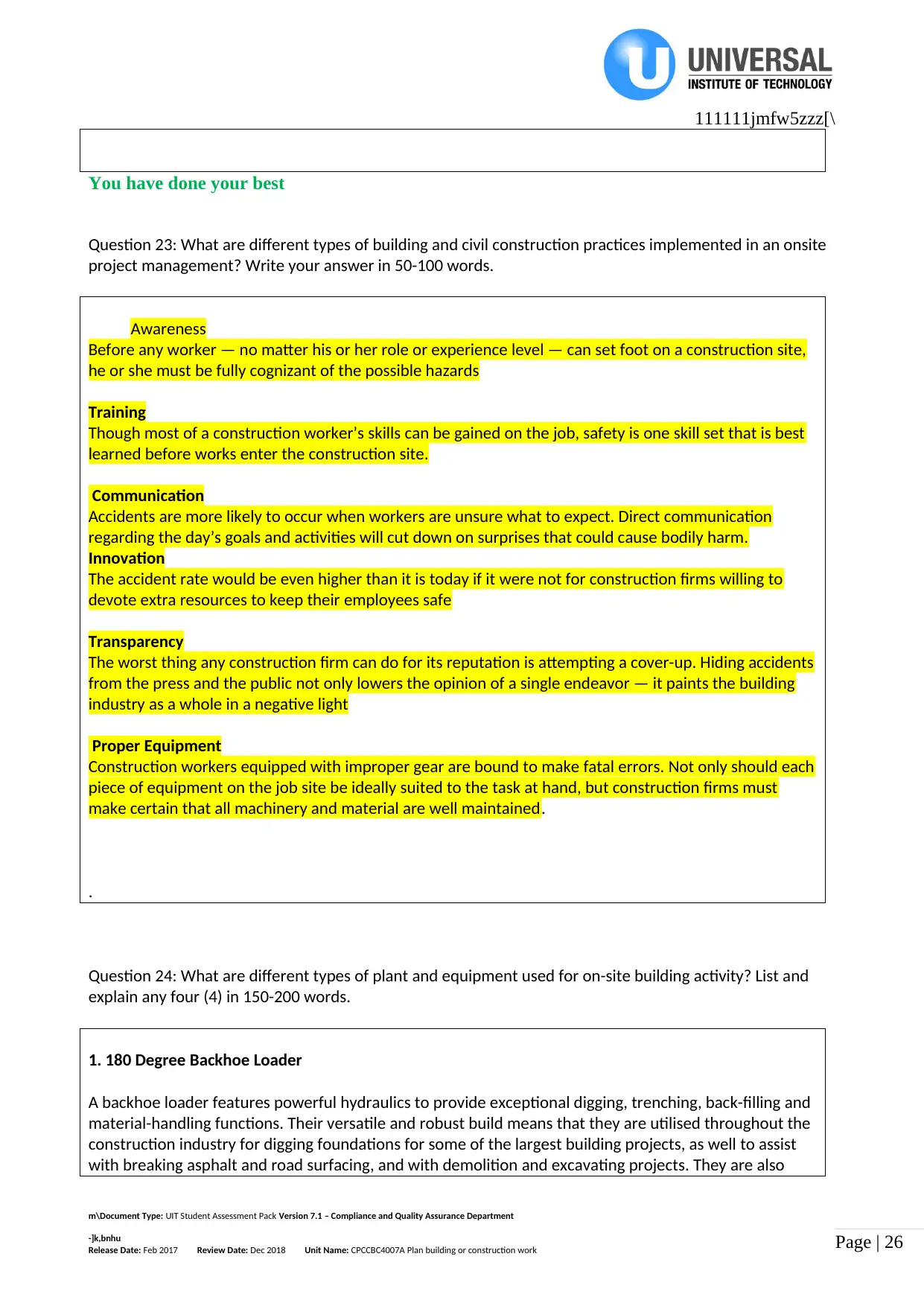
Page | 26
111111jmfw5zzz[\
You have done your best
Question 23: What are different types of building and civil construction practices implemented in an onsite
project management? Write your answer in 50-100 words.
Awareness
Before any worker — no matter his or her role or experience level — can set foot on a construction site,
he or she must be fully cognizant of the possible hazards
Training
Though most of a construction worker’s skills can be gained on the job, safety is one skill set that is best
learned before works enter the construction site.
Communication
Accidents are more likely to occur when workers are unsure what to expect. Direct communication
regarding the day’s goals and activities will cut down on surprises that could cause bodily harm.
Innovation
The accident rate would be even higher than it is today if it were not for construction firms willing to
devote extra resources to keep their employees safe
Transparency
The worst thing any construction firm can do for its reputation is attempting a cover-up. Hiding accidents
from the press and the public not only lowers the opinion of a single endeavor — it paints the building
industry as a whole in a negative light
Proper Equipment
Construction workers equipped with improper gear are bound to make fatal errors. Not only should each
piece of equipment on the job site be ideally suited to the task at hand, but construction firms must
make certain that all machinery and material are well maintained.
.
Question 24: What are different types of plant and equipment used for on-site building activity? List and
explain any four (4) in 150-200 words.
1. 180 Degree Backhoe Loader
A backhoe loader features powerful hydraulics to provide exceptional digging, trenching, back-filling and
material-handling functions. Their versatile and robust build means that they are utilised throughout the
construction industry for digging foundations for some of the largest building projects, as well to assist
with breaking asphalt and road surfacing, and with demolition and excavating projects. They are also
m\Document Type: UIT Student Assessment Pack Version 7.1 – Compliance and Quality Assurance Department
-]k,bnhu
Release Date: Feb 2017 Review Date: Dec 2018 Unit Name: CPCCBC4007A Plan building or construction work
111111jmfw5zzz[\
You have done your best
Question 23: What are different types of building and civil construction practices implemented in an onsite
project management? Write your answer in 50-100 words.
Awareness
Before any worker — no matter his or her role or experience level — can set foot on a construction site,
he or she must be fully cognizant of the possible hazards
Training
Though most of a construction worker’s skills can be gained on the job, safety is one skill set that is best
learned before works enter the construction site.
Communication
Accidents are more likely to occur when workers are unsure what to expect. Direct communication
regarding the day’s goals and activities will cut down on surprises that could cause bodily harm.
Innovation
The accident rate would be even higher than it is today if it were not for construction firms willing to
devote extra resources to keep their employees safe
Transparency
The worst thing any construction firm can do for its reputation is attempting a cover-up. Hiding accidents
from the press and the public not only lowers the opinion of a single endeavor — it paints the building
industry as a whole in a negative light
Proper Equipment
Construction workers equipped with improper gear are bound to make fatal errors. Not only should each
piece of equipment on the job site be ideally suited to the task at hand, but construction firms must
make certain that all machinery and material are well maintained.
.
Question 24: What are different types of plant and equipment used for on-site building activity? List and
explain any four (4) in 150-200 words.
1. 180 Degree Backhoe Loader
A backhoe loader features powerful hydraulics to provide exceptional digging, trenching, back-filling and
material-handling functions. Their versatile and robust build means that they are utilised throughout the
construction industry for digging foundations for some of the largest building projects, as well to assist
with breaking asphalt and road surfacing, and with demolition and excavating projects. They are also
m\Document Type: UIT Student Assessment Pack Version 7.1 – Compliance and Quality Assurance Department
-]k,bnhu
Release Date: Feb 2017 Review Date: Dec 2018 Unit Name: CPCCBC4007A Plan building or construction work

Page | 27
111111jmfw5zzz[\
heavily relied on in the landscaping industry, as they can shift a lot of material in a very short space of
time.
Backhoes provide great power alongside precise handling and performance, allowing you to work in
areas of restricted size, where a larger machine may not be able to gain access or safely operate.
Ultimately, their smaller size and versatility makes them a more effective and productive tool to invest.
2. 360 Degree Excavator
An excavator, sometimes known as a digger or mechanical shovel, is a huge piece of heavy construction
equipment. Its versatility means that it is a very common piece of equipment and is used for everything
from trenching, material handling and digging foundations to forestry, landscaping, mining and even
river dredging.
The cab of the machine is situated on a rotating platform, the ‘house’, which features a boom, stick and
bucket, all on top of the carriage which either has wheels or tracks for manoeuvring.
3. Loading Shovel
A loading shovel is a heavy duty vehicle used throughout the construction industry. Because it is a
wheeled vehicle it is extremely versatile and has been specifically designed to assist with an array of
tasks.
They are most commonly utilised in the moving and loading of materials in a range of applications, such
as quarrying, ground clearance, block handling, waste and recycling handling and agriculture.
4. Overhead Gantry Crane
Overhead gantry cranes (bridge cranes, suspension cranes or overhead travelling cranes) are large pieces
of machinery featuring a crane that can lift heavy objects via a hoist system which is attached to a trolley.
The ends are supported by a gantry beam which rests on wheels and runs along rails. Gantry cranes are
usually installed on the side walls of a factory or large building, as well as docks and outdoor construction
areas, meaning the crane can lift and carry objects the entire length of the building. Most commonly
utilised in the manufacturing of large equipment and vehicles, loading and materials handling.
Acceptable
Question 25: Explain the processes of obtaining approvals for construction building. What are the
different timeframes for regulatory approvals? Write your answer in 150-200 words.
Step 1: Building Approval Application lodgement
Once you have accepted our fee proposal; you will need to lodge your plans for assessment, application
forms completed, payments fully made and supporting documentations to Building Approvals.
Step 2: Assessment period: assessment of proposal and supporting documentation
Building Approvals will assess your plans and supporting documentation against local and state regulatory
m\Document Type: UIT Student Assessment Pack Version 7.1 – Compliance and Quality Assurance Department
-]k,bnhu
Release Date: Feb 2017 Review Date: Dec 2018 Unit Name: CPCCBC4007A Plan building or construction work
111111jmfw5zzz[\
heavily relied on in the landscaping industry, as they can shift a lot of material in a very short space of
time.
Backhoes provide great power alongside precise handling and performance, allowing you to work in
areas of restricted size, where a larger machine may not be able to gain access or safely operate.
Ultimately, their smaller size and versatility makes them a more effective and productive tool to invest.
2. 360 Degree Excavator
An excavator, sometimes known as a digger or mechanical shovel, is a huge piece of heavy construction
equipment. Its versatility means that it is a very common piece of equipment and is used for everything
from trenching, material handling and digging foundations to forestry, landscaping, mining and even
river dredging.
The cab of the machine is situated on a rotating platform, the ‘house’, which features a boom, stick and
bucket, all on top of the carriage which either has wheels or tracks for manoeuvring.
3. Loading Shovel
A loading shovel is a heavy duty vehicle used throughout the construction industry. Because it is a
wheeled vehicle it is extremely versatile and has been specifically designed to assist with an array of
tasks.
They are most commonly utilised in the moving and loading of materials in a range of applications, such
as quarrying, ground clearance, block handling, waste and recycling handling and agriculture.
4. Overhead Gantry Crane
Overhead gantry cranes (bridge cranes, suspension cranes or overhead travelling cranes) are large pieces
of machinery featuring a crane that can lift heavy objects via a hoist system which is attached to a trolley.
The ends are supported by a gantry beam which rests on wheels and runs along rails. Gantry cranes are
usually installed on the side walls of a factory or large building, as well as docks and outdoor construction
areas, meaning the crane can lift and carry objects the entire length of the building. Most commonly
utilised in the manufacturing of large equipment and vehicles, loading and materials handling.
Acceptable
Question 25: Explain the processes of obtaining approvals for construction building. What are the
different timeframes for regulatory approvals? Write your answer in 150-200 words.
Step 1: Building Approval Application lodgement
Once you have accepted our fee proposal; you will need to lodge your plans for assessment, application
forms completed, payments fully made and supporting documentations to Building Approvals.
Step 2: Assessment period: assessment of proposal and supporting documentation
Building Approvals will assess your plans and supporting documentation against local and state regulatory
m\Document Type: UIT Student Assessment Pack Version 7.1 – Compliance and Quality Assurance Department
-]k,bnhu
Release Date: Feb 2017 Review Date: Dec 2018 Unit Name: CPCCBC4007A Plan building or construction work

Page | 28
111111jmfw5zzz[\
measures and building codes. If any further documentation is required to assess your application Building
Approvals will advise.
Step 3: Decision stage
Building Approvals decides to issue the decision notice (building development approval). Local council is
notified of our decision notice and the approved documents are archived with local council as well as
provided to you.
Step 4: Inspections
Building Approvals conducts mandatory inspections (footings/slab, fire separation, etc.) and issue Form 16s
upon satisfactorily inspections.
Step 5: Works Completion and Final Certificates
Once works are completed, and upon satisfactorily inspection Building Approvals United QLD decides to
issue the final inspection certificate. Local Council, owners, and builder are notified of final inspection and
certification results. Building is fully approved and certified.
Acceptable answer.
Unit Assessment Result Sheet (UARS)
Assessment Task 1 – Unit Knowledge Test (UKT)
Student and Trainer/Assessor Details
Unit code CPCCBC4007A
Unit name Plan building or construction work
Outcome of Unit
Assessment Task (UAT)
First attempt:
Outcome (please make sure to tick the correct checkbox):
Satisfactory (S) ☐ or Not Satisfactory (NS) ☒
Date:08___(day)/ 08__(month)/ 2018___(year)
Second attempt:
Outcome (please make sure to tick the correct checkbox):
Satisfactory (S) ☐ or Not Satisfactory (NS) ☐
Date: _______(day)/ _______(month)/ ____________(year)
Feedback to Student First attempt:
m\Document Type: UIT Student Assessment Pack Version 7.1 – Compliance and Quality Assurance Department
-]k,bnhu
Release Date: Feb 2017 Review Date: Dec 2018 Unit Name: CPCCBC4007A Plan building or construction work
111111jmfw5zzz[\
measures and building codes. If any further documentation is required to assess your application Building
Approvals will advise.
Step 3: Decision stage
Building Approvals decides to issue the decision notice (building development approval). Local council is
notified of our decision notice and the approved documents are archived with local council as well as
provided to you.
Step 4: Inspections
Building Approvals conducts mandatory inspections (footings/slab, fire separation, etc.) and issue Form 16s
upon satisfactorily inspections.
Step 5: Works Completion and Final Certificates
Once works are completed, and upon satisfactorily inspection Building Approvals United QLD decides to
issue the final inspection certificate. Local Council, owners, and builder are notified of final inspection and
certification results. Building is fully approved and certified.
Acceptable answer.
Unit Assessment Result Sheet (UARS)
Assessment Task 1 – Unit Knowledge Test (UKT)
Student and Trainer/Assessor Details
Unit code CPCCBC4007A
Unit name Plan building or construction work
Outcome of Unit
Assessment Task (UAT)
First attempt:
Outcome (please make sure to tick the correct checkbox):
Satisfactory (S) ☐ or Not Satisfactory (NS) ☒
Date:08___(day)/ 08__(month)/ 2018___(year)
Second attempt:
Outcome (please make sure to tick the correct checkbox):
Satisfactory (S) ☐ or Not Satisfactory (NS) ☐
Date: _______(day)/ _______(month)/ ____________(year)
Feedback to Student First attempt:
m\Document Type: UIT Student Assessment Pack Version 7.1 – Compliance and Quality Assurance Department
-]k,bnhu
Release Date: Feb 2017 Review Date: Dec 2018 Unit Name: CPCCBC4007A Plan building or construction work
Secure Best Marks with AI Grader
Need help grading? Try our AI Grader for instant feedback on your assignments.
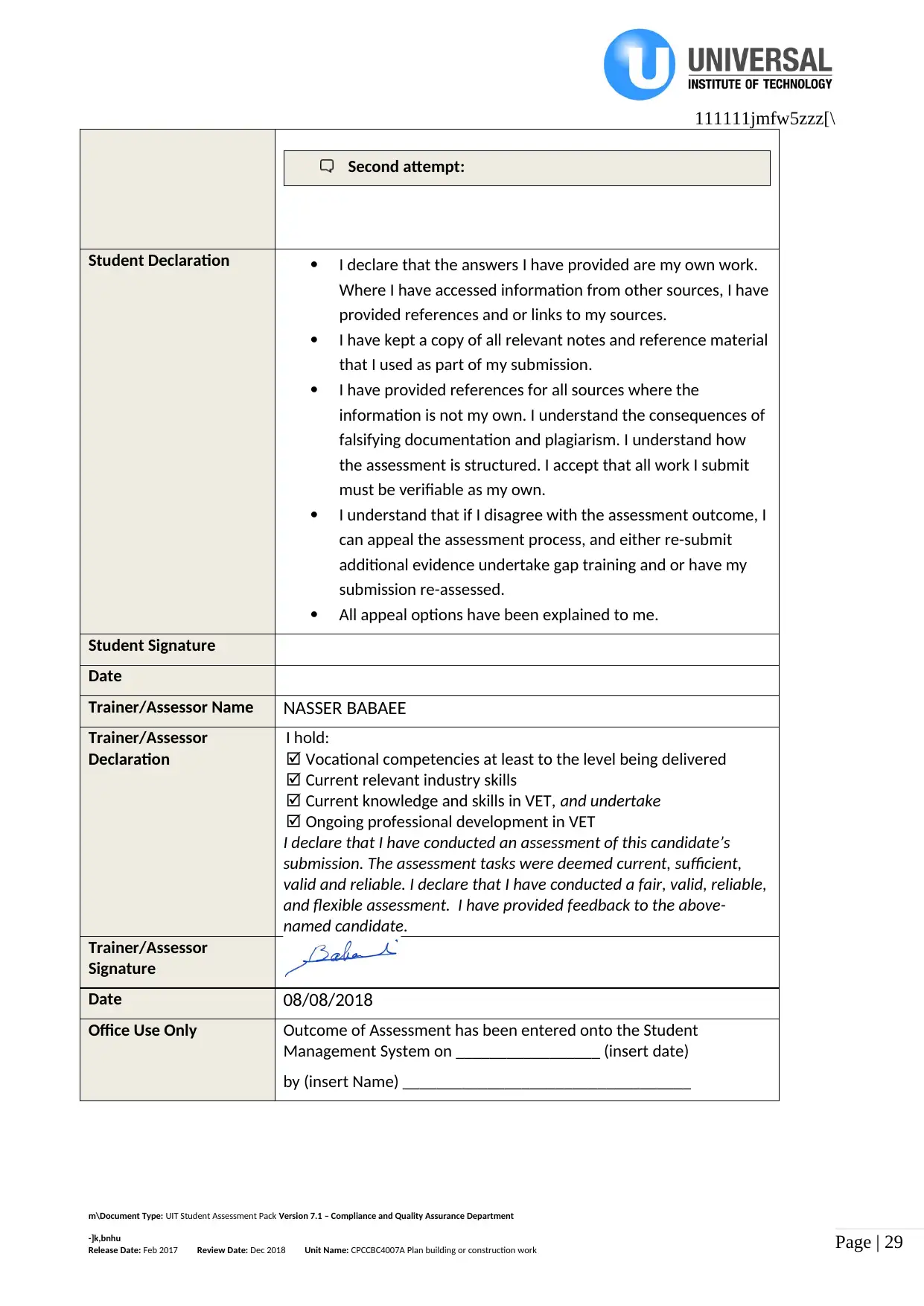
Page | 29
111111jmfw5zzz[\
Second attempt:
Student Declaration I declare that the answers I have provided are my own work.
Where I have accessed information from other sources, I have
provided references and or links to my sources.
I have kept a copy of all relevant notes and reference material
that I used as part of my submission.
I have provided references for all sources where the
information is not my own. I understand the consequences of
falsifying documentation and plagiarism. I understand how
the assessment is structured. I accept that all work I submit
must be verifiable as my own.
I understand that if I disagree with the assessment outcome, I
can appeal the assessment process, and either re-submit
additional evidence undertake gap training and or have my
submission re-assessed.
All appeal options have been explained to me.
Student Signature
Date
Trainer/Assessor Name NASSER BABAEE
Trainer/Assessor
Declaration
I hold:
Vocational competencies at least to the level being delivered
Current relevant industry skills
Current knowledge and skills in VET, and undertake
Ongoing professional development in VET
I declare that I have conducted an assessment of this candidate’s
submission. The assessment tasks were deemed current, sufficient,
valid and reliable. I declare that I have conducted a fair, valid, reliable,
and flexible assessment. I have provided feedback to the above-
named candidate.
Trainer/Assessor
Signature
Date 08/08/2018
Office Use Only Outcome of Assessment has been entered onto the Student
Management System on _________________ (insert date)
by (insert Name) __________________________________
m\Document Type: UIT Student Assessment Pack Version 7.1 – Compliance and Quality Assurance Department
-]k,bnhu
Release Date: Feb 2017 Review Date: Dec 2018 Unit Name: CPCCBC4007A Plan building or construction work
111111jmfw5zzz[\
Second attempt:
Student Declaration I declare that the answers I have provided are my own work.
Where I have accessed information from other sources, I have
provided references and or links to my sources.
I have kept a copy of all relevant notes and reference material
that I used as part of my submission.
I have provided references for all sources where the
information is not my own. I understand the consequences of
falsifying documentation and plagiarism. I understand how
the assessment is structured. I accept that all work I submit
must be verifiable as my own.
I understand that if I disagree with the assessment outcome, I
can appeal the assessment process, and either re-submit
additional evidence undertake gap training and or have my
submission re-assessed.
All appeal options have been explained to me.
Student Signature
Date
Trainer/Assessor Name NASSER BABAEE
Trainer/Assessor
Declaration
I hold:
Vocational competencies at least to the level being delivered
Current relevant industry skills
Current knowledge and skills in VET, and undertake
Ongoing professional development in VET
I declare that I have conducted an assessment of this candidate’s
submission. The assessment tasks were deemed current, sufficient,
valid and reliable. I declare that I have conducted a fair, valid, reliable,
and flexible assessment. I have provided feedback to the above-
named candidate.
Trainer/Assessor
Signature
Date 08/08/2018
Office Use Only Outcome of Assessment has been entered onto the Student
Management System on _________________ (insert date)
by (insert Name) __________________________________
m\Document Type: UIT Student Assessment Pack Version 7.1 – Compliance and Quality Assurance Department
-]k,bnhu
Release Date: Feb 2017 Review Date: Dec 2018 Unit Name: CPCCBC4007A Plan building or construction work
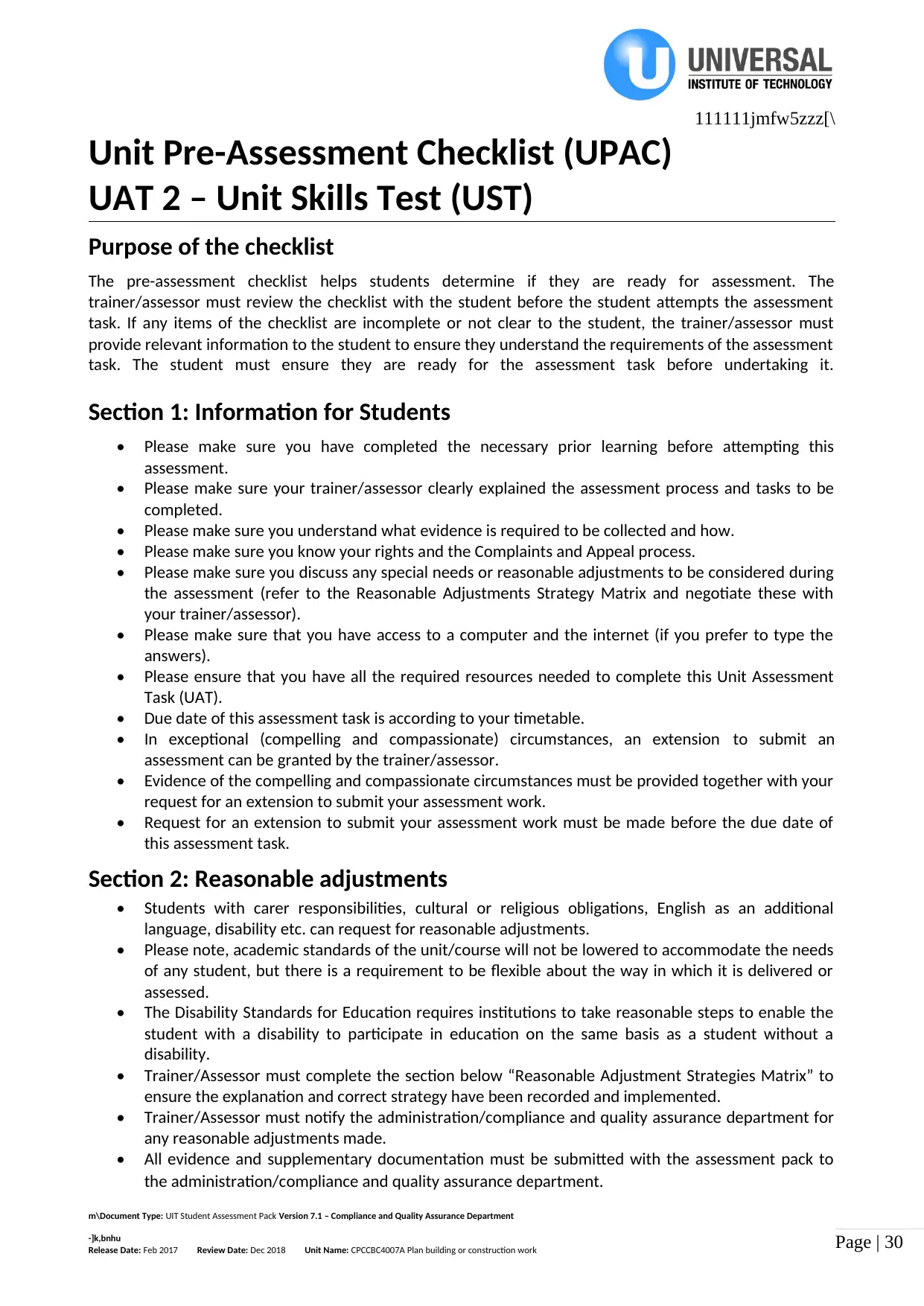
Page | 30
111111jmfw5zzz[\
Unit Pre-Assessment Checklist (UPAC)
UAT 2 – Unit Skills Test (UST)
Purpose of the checklist
The pre-assessment checklist helps students determine if they are ready for assessment. The
trainer/assessor must review the checklist with the student before the student attempts the assessment
task. If any items of the checklist are incomplete or not clear to the student, the trainer/assessor must
provide relevant information to the student to ensure they understand the requirements of the assessment
task. The student must ensure they are ready for the assessment task before undertaking it.
Section 1: Information for Students
• Please make sure you have completed the necessary prior learning before attempting this
assessment.
• Please make sure your trainer/assessor clearly explained the assessment process and tasks to be
completed.
• Please make sure you understand what evidence is required to be collected and how.
• Please make sure you know your rights and the Complaints and Appeal process.
• Please make sure you discuss any special needs or reasonable adjustments to be considered during
the assessment (refer to the Reasonable Adjustments Strategy Matrix and negotiate these with
your trainer/assessor).
• Please make sure that you have access to a computer and the internet (if you prefer to type the
answers).
• Please ensure that you have all the required resources needed to complete this Unit Assessment
Task (UAT).
• Due date of this assessment task is according to your timetable.
• In exceptional (compelling and compassionate) circumstances, an extension to submit an
assessment can be granted by the trainer/assessor.
• Evidence of the compelling and compassionate circumstances must be provided together with your
request for an extension to submit your assessment work.
• Request for an extension to submit your assessment work must be made before the due date of
this assessment task.
Section 2: Reasonable adjustments
• Students with carer responsibilities, cultural or religious obligations, English as an additional
language, disability etc. can request for reasonable adjustments.
• Please note, academic standards of the unit/course will not be lowered to accommodate the needs
of any student, but there is a requirement to be flexible about the way in which it is delivered or
assessed.
• The Disability Standards for Education requires institutions to take reasonable steps to enable the
student with a disability to participate in education on the same basis as a student without a
disability.
• Trainer/Assessor must complete the section below “Reasonable Adjustment Strategies Matrix” to
ensure the explanation and correct strategy have been recorded and implemented.
• Trainer/Assessor must notify the administration/compliance and quality assurance department for
any reasonable adjustments made.
• All evidence and supplementary documentation must be submitted with the assessment pack to
the administration/compliance and quality assurance department.
m\Document Type: UIT Student Assessment Pack Version 7.1 – Compliance and Quality Assurance Department
-]k,bnhu
Release Date: Feb 2017 Review Date: Dec 2018 Unit Name: CPCCBC4007A Plan building or construction work
111111jmfw5zzz[\
Unit Pre-Assessment Checklist (UPAC)
UAT 2 – Unit Skills Test (UST)
Purpose of the checklist
The pre-assessment checklist helps students determine if they are ready for assessment. The
trainer/assessor must review the checklist with the student before the student attempts the assessment
task. If any items of the checklist are incomplete or not clear to the student, the trainer/assessor must
provide relevant information to the student to ensure they understand the requirements of the assessment
task. The student must ensure they are ready for the assessment task before undertaking it.
Section 1: Information for Students
• Please make sure you have completed the necessary prior learning before attempting this
assessment.
• Please make sure your trainer/assessor clearly explained the assessment process and tasks to be
completed.
• Please make sure you understand what evidence is required to be collected and how.
• Please make sure you know your rights and the Complaints and Appeal process.
• Please make sure you discuss any special needs or reasonable adjustments to be considered during
the assessment (refer to the Reasonable Adjustments Strategy Matrix and negotiate these with
your trainer/assessor).
• Please make sure that you have access to a computer and the internet (if you prefer to type the
answers).
• Please ensure that you have all the required resources needed to complete this Unit Assessment
Task (UAT).
• Due date of this assessment task is according to your timetable.
• In exceptional (compelling and compassionate) circumstances, an extension to submit an
assessment can be granted by the trainer/assessor.
• Evidence of the compelling and compassionate circumstances must be provided together with your
request for an extension to submit your assessment work.
• Request for an extension to submit your assessment work must be made before the due date of
this assessment task.
Section 2: Reasonable adjustments
• Students with carer responsibilities, cultural or religious obligations, English as an additional
language, disability etc. can request for reasonable adjustments.
• Please note, academic standards of the unit/course will not be lowered to accommodate the needs
of any student, but there is a requirement to be flexible about the way in which it is delivered or
assessed.
• The Disability Standards for Education requires institutions to take reasonable steps to enable the
student with a disability to participate in education on the same basis as a student without a
disability.
• Trainer/Assessor must complete the section below “Reasonable Adjustment Strategies Matrix” to
ensure the explanation and correct strategy have been recorded and implemented.
• Trainer/Assessor must notify the administration/compliance and quality assurance department for
any reasonable adjustments made.
• All evidence and supplementary documentation must be submitted with the assessment pack to
the administration/compliance and quality assurance department.
m\Document Type: UIT Student Assessment Pack Version 7.1 – Compliance and Quality Assurance Department
-]k,bnhu
Release Date: Feb 2017 Review Date: Dec 2018 Unit Name: CPCCBC4007A Plan building or construction work
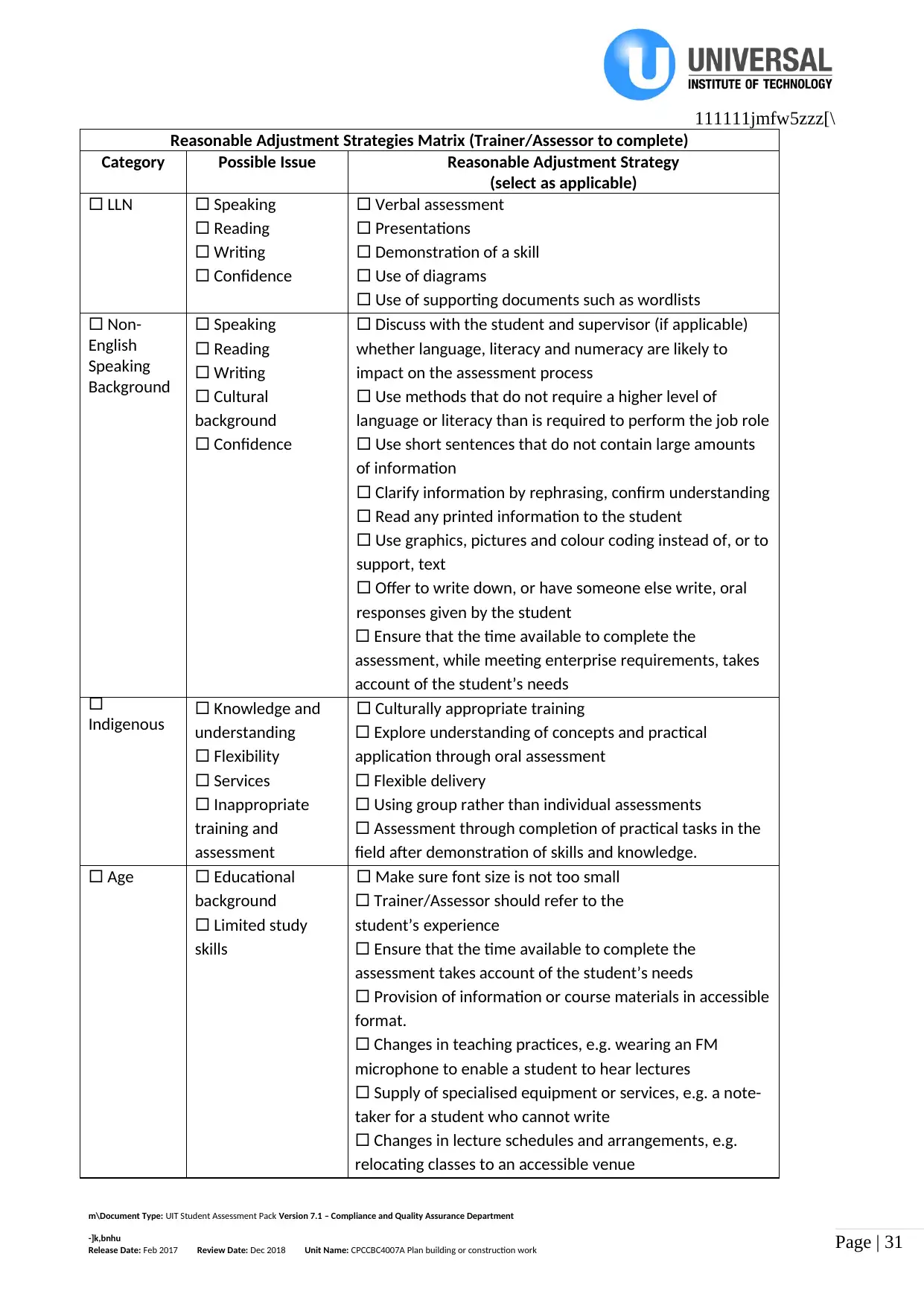
Page | 31
111111jmfw5zzz[\
Reasonable Adjustment Strategies Matrix (Trainer/Assessor to complete)
Category Possible Issue Reasonable Adjustment Strategy
(select as applicable)
LLN Speaking
Reading
Writing
Confidence
Verbal assessment
Presentations
Demonstration of a skill
Use of diagrams
Use of supporting documents such as wordlists
Non-
English
Speaking
Background
Speaking
Reading
Writing
Cultural
background
Confidence
Discuss with the student and supervisor (if applicable)
whether language, literacy and numeracy are likely to
impact on the assessment process
Use methods that do not require a higher level of
language or literacy than is required to perform the job role
Use short sentences that do not contain large amounts
of information
Clarify information by rephrasing, confirm understanding
Read any printed information to the student
Use graphics, pictures and colour coding instead of, or to
support, text
Offer to write down, or have someone else write, oral
responses given by the student
Ensure that the time available to complete the
assessment, while meeting enterprise requirements, takes
account of the student’s needs
Indigenous Knowledge and
understanding
Flexibility
Services
Inappropriate
training and
assessment
Culturally appropriate training
Explore understanding of concepts and practical
application through oral assessment
Flexible delivery
Using group rather than individual assessments
Assessment through completion of practical tasks in the
field after demonstration of skills and knowledge.
Age Educational
background
Limited study
skills
Make sure font size is not too small
Trainer/Assessor should refer to the
student’s experience
Ensure that the time available to complete the
assessment takes account of the student’s needs
Provision of information or course materials in accessible
format.
Changes in teaching practices, e.g. wearing an FM
microphone to enable a student to hear lectures
Supply of specialised equipment or services, e.g. a note-
taker for a student who cannot write
Changes in lecture schedules and arrangements, e.g.
relocating classes to an accessible venue
m\Document Type: UIT Student Assessment Pack Version 7.1 – Compliance and Quality Assurance Department
-]k,bnhu
Release Date: Feb 2017 Review Date: Dec 2018 Unit Name: CPCCBC4007A Plan building or construction work
111111jmfw5zzz[\
Reasonable Adjustment Strategies Matrix (Trainer/Assessor to complete)
Category Possible Issue Reasonable Adjustment Strategy
(select as applicable)
LLN Speaking
Reading
Writing
Confidence
Verbal assessment
Presentations
Demonstration of a skill
Use of diagrams
Use of supporting documents such as wordlists
Non-
English
Speaking
Background
Speaking
Reading
Writing
Cultural
background
Confidence
Discuss with the student and supervisor (if applicable)
whether language, literacy and numeracy are likely to
impact on the assessment process
Use methods that do not require a higher level of
language or literacy than is required to perform the job role
Use short sentences that do not contain large amounts
of information
Clarify information by rephrasing, confirm understanding
Read any printed information to the student
Use graphics, pictures and colour coding instead of, or to
support, text
Offer to write down, or have someone else write, oral
responses given by the student
Ensure that the time available to complete the
assessment, while meeting enterprise requirements, takes
account of the student’s needs
Indigenous Knowledge and
understanding
Flexibility
Services
Inappropriate
training and
assessment
Culturally appropriate training
Explore understanding of concepts and practical
application through oral assessment
Flexible delivery
Using group rather than individual assessments
Assessment through completion of practical tasks in the
field after demonstration of skills and knowledge.
Age Educational
background
Limited study
skills
Make sure font size is not too small
Trainer/Assessor should refer to the
student’s experience
Ensure that the time available to complete the
assessment takes account of the student’s needs
Provision of information or course materials in accessible
format.
Changes in teaching practices, e.g. wearing an FM
microphone to enable a student to hear lectures
Supply of specialised equipment or services, e.g. a note-
taker for a student who cannot write
Changes in lecture schedules and arrangements, e.g.
relocating classes to an accessible venue
m\Document Type: UIT Student Assessment Pack Version 7.1 – Compliance and Quality Assurance Department
-]k,bnhu
Release Date: Feb 2017 Review Date: Dec 2018 Unit Name: CPCCBC4007A Plan building or construction work
Paraphrase This Document
Need a fresh take? Get an instant paraphrase of this document with our AI Paraphraser
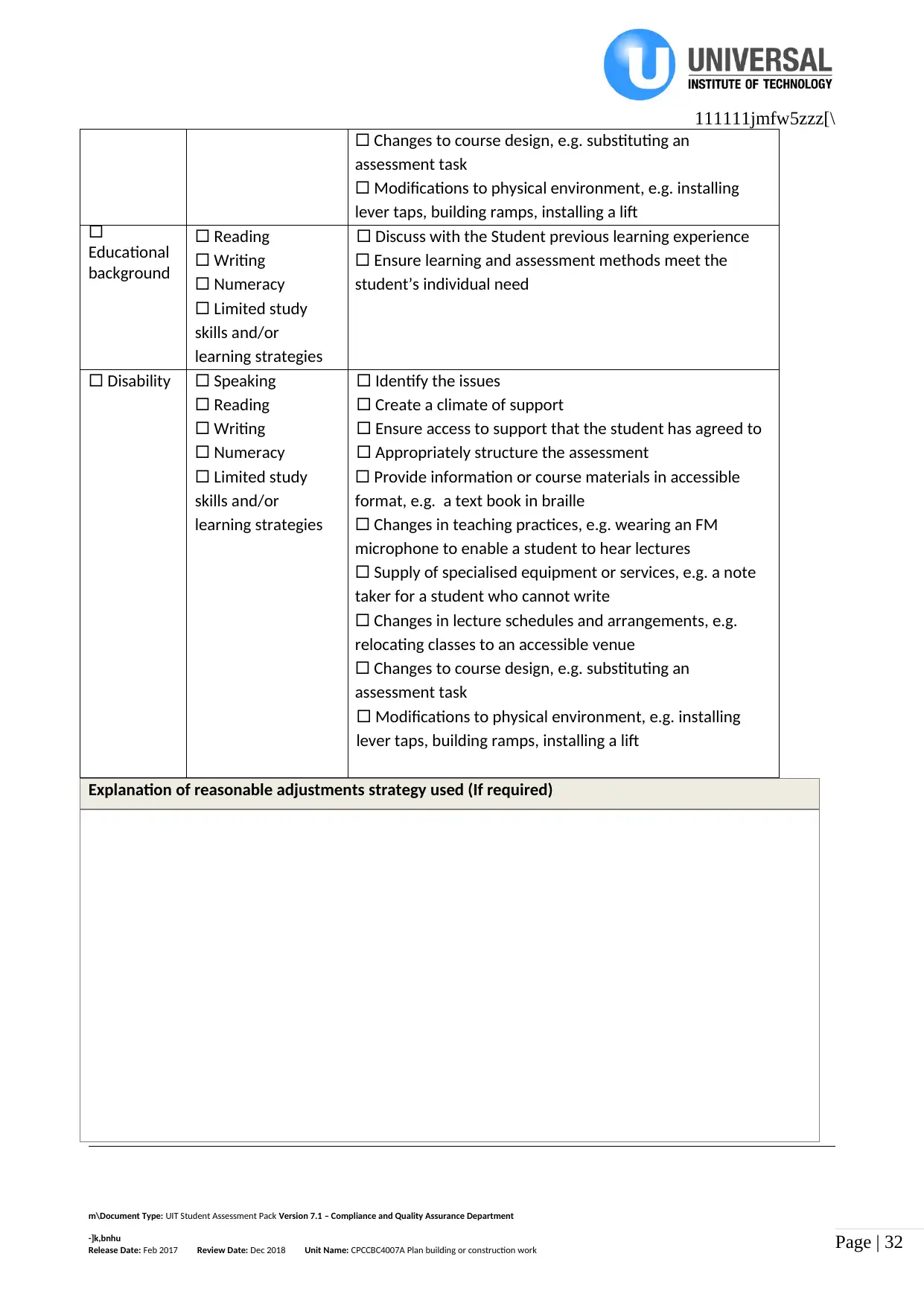
Page | 32
111111jmfw5zzz[\
Changes to course design, e.g. substituting an
assessment task
Modifications to physical environment, e.g. installing
lever taps, building ramps, installing a lift
Educational
background
Reading
Writing
Numeracy
Limited study
skills and/or
learning strategies
Discuss with the Student previous learning experience
Ensure learning and assessment methods meet the
student’s individual need
Disability Speaking
Reading
Writing
Numeracy
Limited study
skills and/or
learning strategies
Identify the issues
Create a climate of support
Ensure access to support that the student has agreed to
Appropriately structure the assessment
Provide information or course materials in accessible
format, e.g. a text book in braille
Changes in teaching practices, e.g. wearing an FM
microphone to enable a student to hear lectures
Supply of specialised equipment or services, e.g. a note
taker for a student who cannot write
Changes in lecture schedules and arrangements, e.g.
relocating classes to an accessible venue
Changes to course design, e.g. substituting an
assessment task
Modifications to physical environment, e.g. installing
lever taps, building ramps, installing a lift
Explanation of reasonable adjustments strategy used (If required)
m\Document Type: UIT Student Assessment Pack Version 7.1 – Compliance and Quality Assurance Department
-]k,bnhu
Release Date: Feb 2017 Review Date: Dec 2018 Unit Name: CPCCBC4007A Plan building or construction work
111111jmfw5zzz[\
Changes to course design, e.g. substituting an
assessment task
Modifications to physical environment, e.g. installing
lever taps, building ramps, installing a lift
Educational
background
Reading
Writing
Numeracy
Limited study
skills and/or
learning strategies
Discuss with the Student previous learning experience
Ensure learning and assessment methods meet the
student’s individual need
Disability Speaking
Reading
Writing
Numeracy
Limited study
skills and/or
learning strategies
Identify the issues
Create a climate of support
Ensure access to support that the student has agreed to
Appropriately structure the assessment
Provide information or course materials in accessible
format, e.g. a text book in braille
Changes in teaching practices, e.g. wearing an FM
microphone to enable a student to hear lectures
Supply of specialised equipment or services, e.g. a note
taker for a student who cannot write
Changes in lecture schedules and arrangements, e.g.
relocating classes to an accessible venue
Changes to course design, e.g. substituting an
assessment task
Modifications to physical environment, e.g. installing
lever taps, building ramps, installing a lift
Explanation of reasonable adjustments strategy used (If required)
m\Document Type: UIT Student Assessment Pack Version 7.1 – Compliance and Quality Assurance Department
-]k,bnhu
Release Date: Feb 2017 Review Date: Dec 2018 Unit Name: CPCCBC4007A Plan building or construction work

Page | 33
111111jmfw5zzz[\
Assessment Task 2 – Unit Skills Test (UST)
Assessment type:
Unit Skills Test - Prepare condition report and project schedule
Assessment task description:
This is the second (2) unit assessment task you have to successfully complete to be deemed
competent in this unit of competency.
This assessment task is comprised of a Unit Skills Test (UST).
You are required to prepare condition report and project schedule in this assessment task.
You must attempt all criteria to the required level, e.g. Assessment criteria mentioned in the
performance checklist to be deemed satisfactory in this task.
You must prepare condition report and project schedule by following all given instructions, for your
trainer/assessor to assess your competency in this assessment task.
You will receive your feedback within two weeks - you will be notified by your Trainer/Assessor
when results are available.
Applicable conditions:
This skill test is untimed and conducted as an open book test (this means you are able to refer to
your textbook or other learner materials during the test).
Condition report and project schedule must be completed in template.
You will be assessed independently on this assessment task.
No marks or grades are allocated for this assessment task. The outcome of the task will be
Satisfactory or Not Satisfactory.
As you complete this assessment task you are predominately demonstrating your practical skills,
techniques and knowledge to your trainer/assessor.
Trainer/Assessor may ask you relevant questions during this assessment task.
Resubmissions and reattempts:
Where a student’s answers are deemed not satisfactory after the first attempt, a resubmission
attempt will be allowed.
You must speak to your Trainer/Assessor if you have any difficulty in completing this task and
require reasonable adjustments (e.g. can be given as an oral assessment).
For more information, please refer to your RTO Student Handbook.
Location:
This assessment task may be completed in a learning management system (i.e. Moodle etc.) or
independent learning environment.
Your trainer/assessor will provide you further information regarding the location of completing this
assessment task.
General Instructions for attempting the skills test:
You will be required to correctly attempt all activities of this assessment task.
You will prepare condition report and project schedule in this assessment task.
Instructions to prepare condition report and project schedule are provided within the assessment
task.
How your trainer/assessor will assess your work?
m\Document Type: UIT Student Assessment Pack Version 7.1 – Compliance and Quality Assurance Department
-]k,bnhu
Release Date: Feb 2017 Review Date: Dec 2018 Unit Name: CPCCBC4007A Plan building or construction work
111111jmfw5zzz[\
Assessment Task 2 – Unit Skills Test (UST)
Assessment type:
Unit Skills Test - Prepare condition report and project schedule
Assessment task description:
This is the second (2) unit assessment task you have to successfully complete to be deemed
competent in this unit of competency.
This assessment task is comprised of a Unit Skills Test (UST).
You are required to prepare condition report and project schedule in this assessment task.
You must attempt all criteria to the required level, e.g. Assessment criteria mentioned in the
performance checklist to be deemed satisfactory in this task.
You must prepare condition report and project schedule by following all given instructions, for your
trainer/assessor to assess your competency in this assessment task.
You will receive your feedback within two weeks - you will be notified by your Trainer/Assessor
when results are available.
Applicable conditions:
This skill test is untimed and conducted as an open book test (this means you are able to refer to
your textbook or other learner materials during the test).
Condition report and project schedule must be completed in template.
You will be assessed independently on this assessment task.
No marks or grades are allocated for this assessment task. The outcome of the task will be
Satisfactory or Not Satisfactory.
As you complete this assessment task you are predominately demonstrating your practical skills,
techniques and knowledge to your trainer/assessor.
Trainer/Assessor may ask you relevant questions during this assessment task.
Resubmissions and reattempts:
Where a student’s answers are deemed not satisfactory after the first attempt, a resubmission
attempt will be allowed.
You must speak to your Trainer/Assessor if you have any difficulty in completing this task and
require reasonable adjustments (e.g. can be given as an oral assessment).
For more information, please refer to your RTO Student Handbook.
Location:
This assessment task may be completed in a learning management system (i.e. Moodle etc.) or
independent learning environment.
Your trainer/assessor will provide you further information regarding the location of completing this
assessment task.
General Instructions for attempting the skills test:
You will be required to correctly attempt all activities of this assessment task.
You will prepare condition report and project schedule in this assessment task.
Instructions to prepare condition report and project schedule are provided within the assessment
task.
How your trainer/assessor will assess your work?
m\Document Type: UIT Student Assessment Pack Version 7.1 – Compliance and Quality Assurance Department
-]k,bnhu
Release Date: Feb 2017 Review Date: Dec 2018 Unit Name: CPCCBC4007A Plan building or construction work
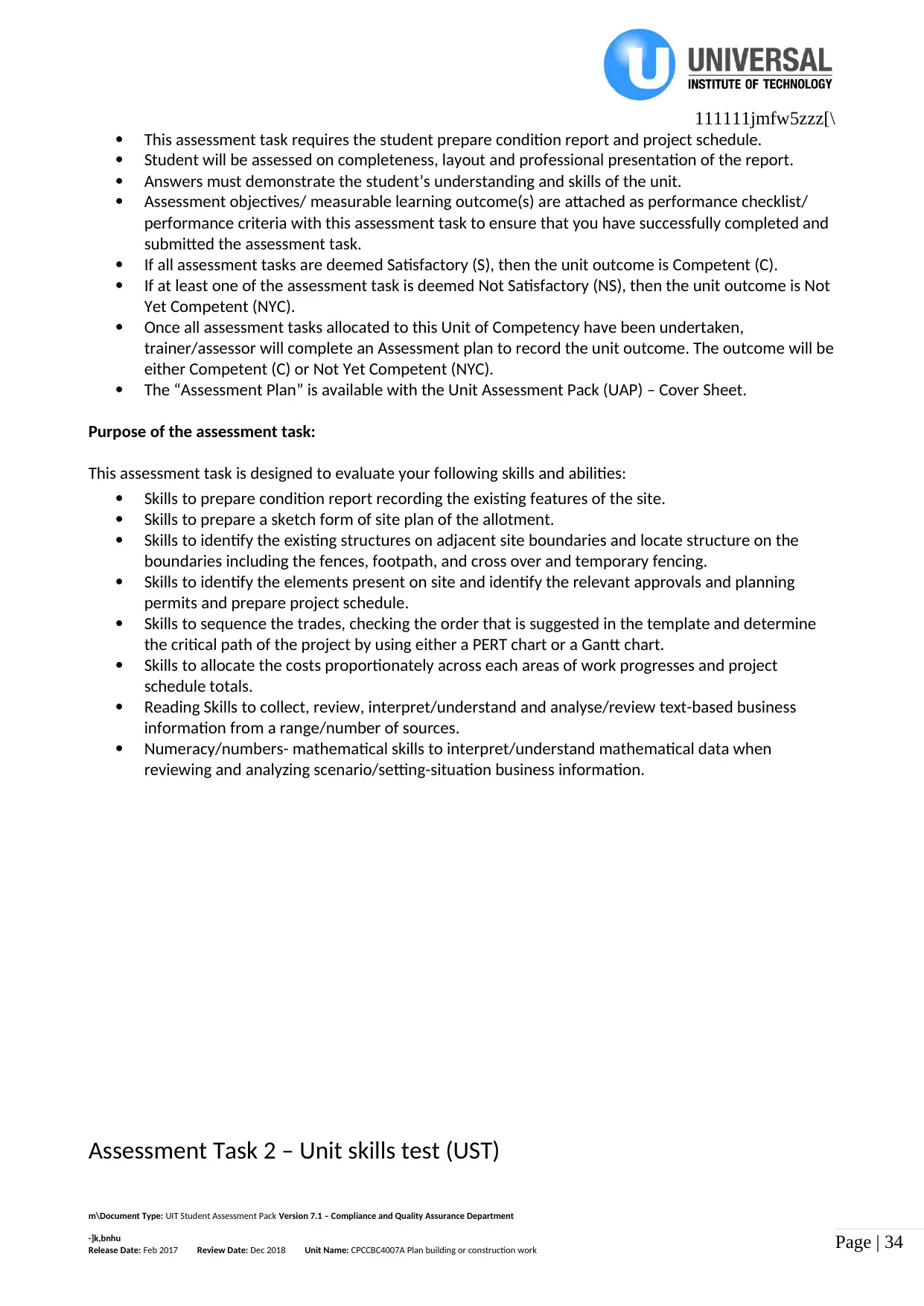
Page | 34
111111jmfw5zzz[\
This assessment task requires the student prepare condition report and project schedule.
Student will be assessed on completeness, layout and professional presentation of the report.
Answers must demonstrate the student’s understanding and skills of the unit.
Assessment objectives/ measurable learning outcome(s) are attached as performance checklist/
performance criteria with this assessment task to ensure that you have successfully completed and
submitted the assessment task.
If all assessment tasks are deemed Satisfactory (S), then the unit outcome is Competent (C).
If at least one of the assessment task is deemed Not Satisfactory (NS), then the unit outcome is Not
Yet Competent (NYC).
Once all assessment tasks allocated to this Unit of Competency have been undertaken,
trainer/assessor will complete an Assessment plan to record the unit outcome. The outcome will be
either Competent (C) or Not Yet Competent (NYC).
The “Assessment Plan” is available with the Unit Assessment Pack (UAP) – Cover Sheet.
Purpose of the assessment task:
This assessment task is designed to evaluate your following skills and abilities:
Skills to prepare condition report recording the existing features of the site.
Skills to prepare a sketch form of site plan of the allotment.
Skills to identify the existing structures on adjacent site boundaries and locate structure on the
boundaries including the fences, footpath, and cross over and temporary fencing.
Skills to identify the elements present on site and identify the relevant approvals and planning
permits and prepare project schedule.
Skills to sequence the trades, checking the order that is suggested in the template and determine
the critical path of the project by using either a PERT chart or a Gantt chart.
Skills to allocate the costs proportionately across each areas of work progresses and project
schedule totals.
Reading Skills to collect, review, interpret/understand and analyse/review text-based business
information from a range/number of sources.
Numeracy/numbers- mathematical skills to interpret/understand mathematical data when
reviewing and analyzing scenario/setting-situation business information.
Assessment Task 2 – Unit skills test (UST)
m\Document Type: UIT Student Assessment Pack Version 7.1 – Compliance and Quality Assurance Department
-]k,bnhu
Release Date: Feb 2017 Review Date: Dec 2018 Unit Name: CPCCBC4007A Plan building or construction work
111111jmfw5zzz[\
This assessment task requires the student prepare condition report and project schedule.
Student will be assessed on completeness, layout and professional presentation of the report.
Answers must demonstrate the student’s understanding and skills of the unit.
Assessment objectives/ measurable learning outcome(s) are attached as performance checklist/
performance criteria with this assessment task to ensure that you have successfully completed and
submitted the assessment task.
If all assessment tasks are deemed Satisfactory (S), then the unit outcome is Competent (C).
If at least one of the assessment task is deemed Not Satisfactory (NS), then the unit outcome is Not
Yet Competent (NYC).
Once all assessment tasks allocated to this Unit of Competency have been undertaken,
trainer/assessor will complete an Assessment plan to record the unit outcome. The outcome will be
either Competent (C) or Not Yet Competent (NYC).
The “Assessment Plan” is available with the Unit Assessment Pack (UAP) – Cover Sheet.
Purpose of the assessment task:
This assessment task is designed to evaluate your following skills and abilities:
Skills to prepare condition report recording the existing features of the site.
Skills to prepare a sketch form of site plan of the allotment.
Skills to identify the existing structures on adjacent site boundaries and locate structure on the
boundaries including the fences, footpath, and cross over and temporary fencing.
Skills to identify the elements present on site and identify the relevant approvals and planning
permits and prepare project schedule.
Skills to sequence the trades, checking the order that is suggested in the template and determine
the critical path of the project by using either a PERT chart or a Gantt chart.
Skills to allocate the costs proportionately across each areas of work progresses and project
schedule totals.
Reading Skills to collect, review, interpret/understand and analyse/review text-based business
information from a range/number of sources.
Numeracy/numbers- mathematical skills to interpret/understand mathematical data when
reviewing and analyzing scenario/setting-situation business information.
Assessment Task 2 – Unit skills test (UST)
m\Document Type: UIT Student Assessment Pack Version 7.1 – Compliance and Quality Assurance Department
-]k,bnhu
Release Date: Feb 2017 Review Date: Dec 2018 Unit Name: CPCCBC4007A Plan building or construction work
Secure Best Marks with AI Grader
Need help grading? Try our AI Grader for instant feedback on your assignments.
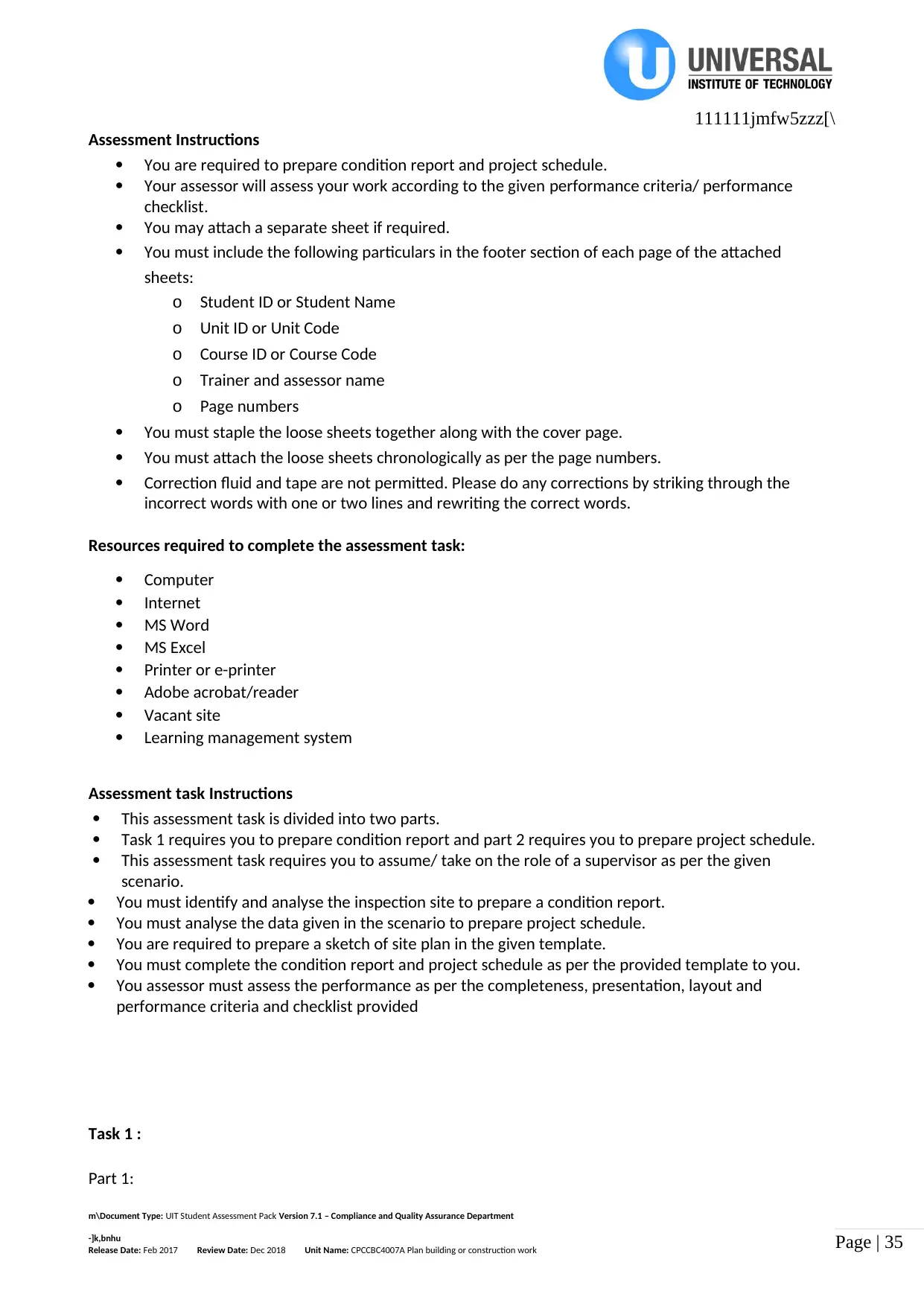
Page | 35
111111jmfw5zzz[\
Assessment Instructions
You are required to prepare condition report and project schedule.
Your assessor will assess your work according to the given performance criteria/ performance
checklist.
You may attach a separate sheet if required.
You must include the following particulars in the footer section of each page of the attached
sheets:
o Student ID or Student Name
o Unit ID or Unit Code
o Course ID or Course Code
o Trainer and assessor name
o Page numbers
You must staple the loose sheets together along with the cover page.
You must attach the loose sheets chronologically as per the page numbers.
Correction fluid and tape are not permitted. Please do any corrections by striking through the
incorrect words with one or two lines and rewriting the correct words.
Resources required to complete the assessment task:
Computer
Internet
MS Word
MS Excel
Printer or e-printer
Adobe acrobat/reader
Vacant site
Learning management system
Assessment task Instructions
This assessment task is divided into two parts.
Task 1 requires you to prepare condition report and part 2 requires you to prepare project schedule.
This assessment task requires you to assume/ take on the role of a supervisor as per the given
scenario.
You must identify and analyse the inspection site to prepare a condition report.
You must analyse the data given in the scenario to prepare project schedule.
You are required to prepare a sketch of site plan in the given template.
You must complete the condition report and project schedule as per the provided template to you.
You assessor must assess the performance as per the completeness, presentation, layout and
performance criteria and checklist provided
Task 1 :
Part 1:
m\Document Type: UIT Student Assessment Pack Version 7.1 – Compliance and Quality Assurance Department
-]k,bnhu
Release Date: Feb 2017 Review Date: Dec 2018 Unit Name: CPCCBC4007A Plan building or construction work
111111jmfw5zzz[\
Assessment Instructions
You are required to prepare condition report and project schedule.
Your assessor will assess your work according to the given performance criteria/ performance
checklist.
You may attach a separate sheet if required.
You must include the following particulars in the footer section of each page of the attached
sheets:
o Student ID or Student Name
o Unit ID or Unit Code
o Course ID or Course Code
o Trainer and assessor name
o Page numbers
You must staple the loose sheets together along with the cover page.
You must attach the loose sheets chronologically as per the page numbers.
Correction fluid and tape are not permitted. Please do any corrections by striking through the
incorrect words with one or two lines and rewriting the correct words.
Resources required to complete the assessment task:
Computer
Internet
MS Word
MS Excel
Printer or e-printer
Adobe acrobat/reader
Vacant site
Learning management system
Assessment task Instructions
This assessment task is divided into two parts.
Task 1 requires you to prepare condition report and part 2 requires you to prepare project schedule.
This assessment task requires you to assume/ take on the role of a supervisor as per the given
scenario.
You must identify and analyse the inspection site to prepare a condition report.
You must analyse the data given in the scenario to prepare project schedule.
You are required to prepare a sketch of site plan in the given template.
You must complete the condition report and project schedule as per the provided template to you.
You assessor must assess the performance as per the completeness, presentation, layout and
performance criteria and checklist provided
Task 1 :
Part 1:
m\Document Type: UIT Student Assessment Pack Version 7.1 – Compliance and Quality Assurance Department
-]k,bnhu
Release Date: Feb 2017 Review Date: Dec 2018 Unit Name: CPCCBC4007A Plan building or construction work
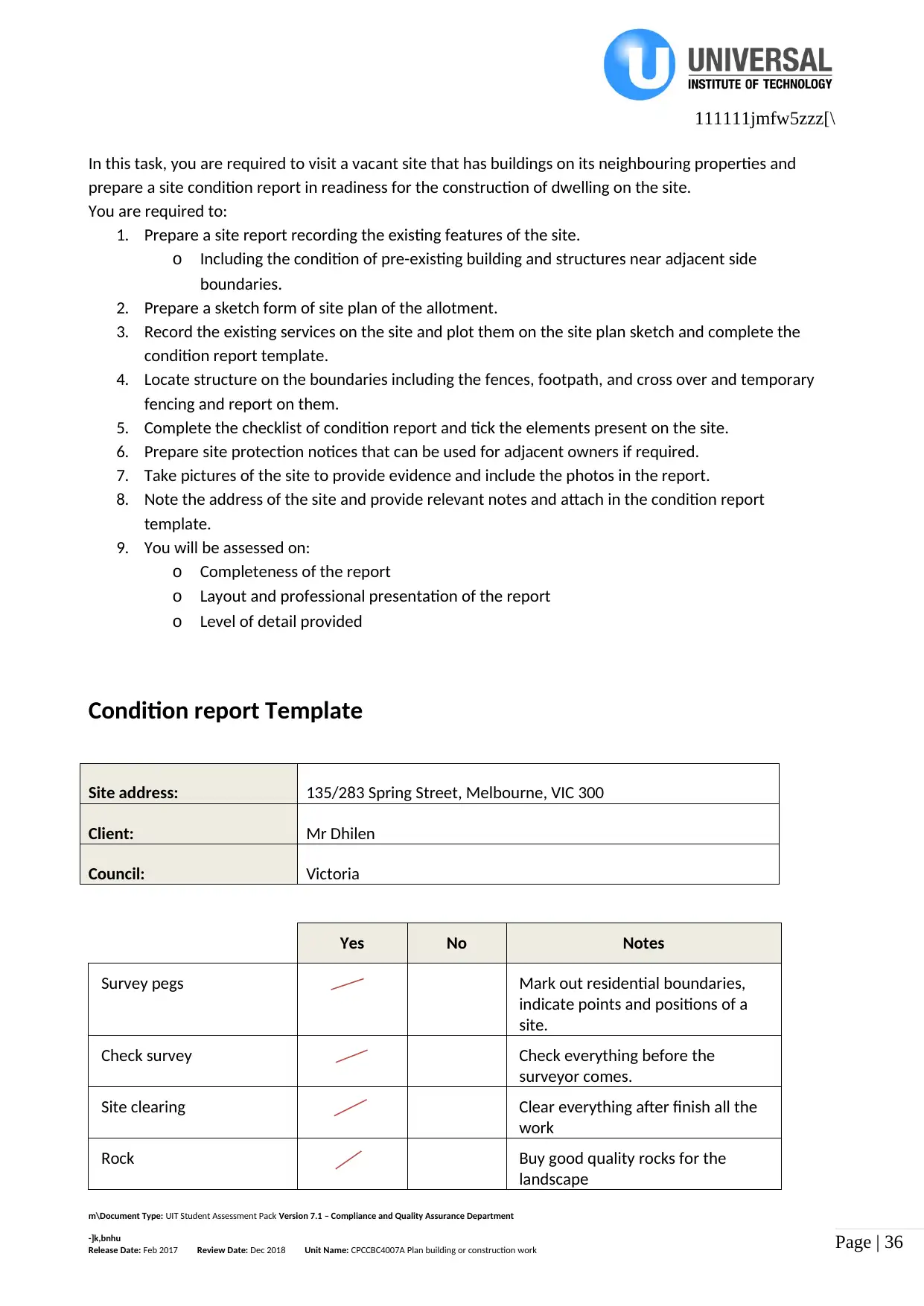
Page | 36
111111jmfw5zzz[\
In this task, you are required to visit a vacant site that has buildings on its neighbouring properties and
prepare a site condition report in readiness for the construction of dwelling on the site.
You are required to:
1. Prepare a site report recording the existing features of the site.
o Including the condition of pre-existing building and structures near adjacent side
boundaries.
2. Prepare a sketch form of site plan of the allotment.
3. Record the existing services on the site and plot them on the site plan sketch and complete the
condition report template.
4. Locate structure on the boundaries including the fences, footpath, and cross over and temporary
fencing and report on them.
5. Complete the checklist of condition report and tick the elements present on the site.
6. Prepare site protection notices that can be used for adjacent owners if required.
7. Take pictures of the site to provide evidence and include the photos in the report.
8. Note the address of the site and provide relevant notes and attach in the condition report
template.
9. You will be assessed on:
o Completeness of the report
o Layout and professional presentation of the report
o Level of detail provided
Condition report Template
Site address: 135/283 Spring Street, Melbourne, VIC 300
Client: Mr Dhilen
Council: Victoria
Yes No Notes
Survey pegs Mark out residential boundaries,
indicate points and positions of a
site.
Check survey Check everything before the
surveyor comes.
Site clearing Clear everything after finish all the
work
Rock Buy good quality rocks for the
landscape
m\Document Type: UIT Student Assessment Pack Version 7.1 – Compliance and Quality Assurance Department
-]k,bnhu
Release Date: Feb 2017 Review Date: Dec 2018 Unit Name: CPCCBC4007A Plan building or construction work
111111jmfw5zzz[\
In this task, you are required to visit a vacant site that has buildings on its neighbouring properties and
prepare a site condition report in readiness for the construction of dwelling on the site.
You are required to:
1. Prepare a site report recording the existing features of the site.
o Including the condition of pre-existing building and structures near adjacent side
boundaries.
2. Prepare a sketch form of site plan of the allotment.
3. Record the existing services on the site and plot them on the site plan sketch and complete the
condition report template.
4. Locate structure on the boundaries including the fences, footpath, and cross over and temporary
fencing and report on them.
5. Complete the checklist of condition report and tick the elements present on the site.
6. Prepare site protection notices that can be used for adjacent owners if required.
7. Take pictures of the site to provide evidence and include the photos in the report.
8. Note the address of the site and provide relevant notes and attach in the condition report
template.
9. You will be assessed on:
o Completeness of the report
o Layout and professional presentation of the report
o Level of detail provided
Condition report Template
Site address: 135/283 Spring Street, Melbourne, VIC 300
Client: Mr Dhilen
Council: Victoria
Yes No Notes
Survey pegs Mark out residential boundaries,
indicate points and positions of a
site.
Check survey Check everything before the
surveyor comes.
Site clearing Clear everything after finish all the
work
Rock Buy good quality rocks for the
landscape
m\Document Type: UIT Student Assessment Pack Version 7.1 – Compliance and Quality Assurance Department
-]k,bnhu
Release Date: Feb 2017 Review Date: Dec 2018 Unit Name: CPCCBC4007A Plan building or construction work
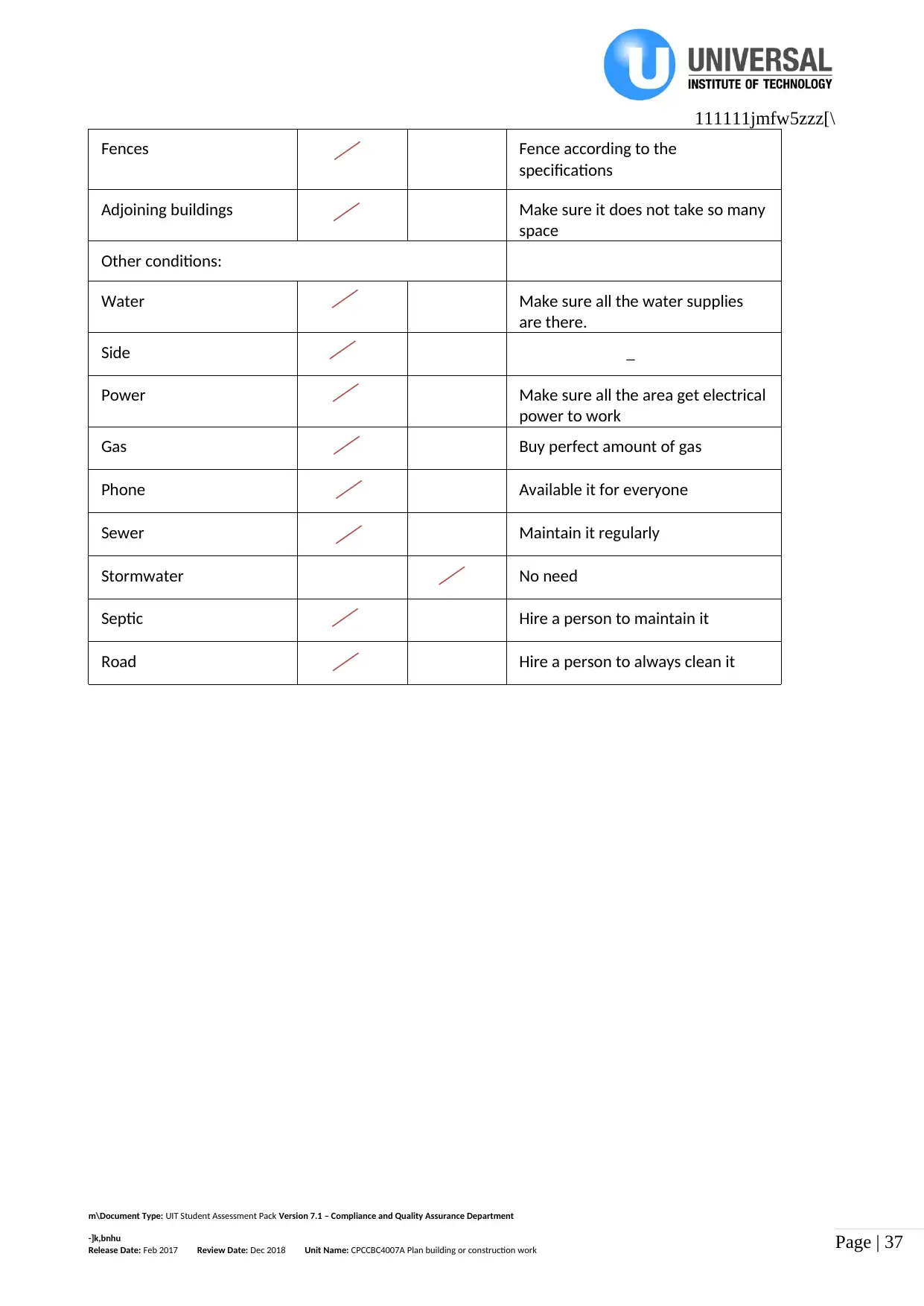
Page | 37
111111jmfw5zzz[\
Fences Fence according to the
specifications
Adjoining buildings Make sure it does not take so many
space
Other conditions:
Water Make sure all the water supplies
are there.
Side _
Power Make sure all the area get electrical
power to work
Gas Buy perfect amount of gas
Phone Available it for everyone
Sewer Maintain it regularly
Stormwater No need
Septic Hire a person to maintain it
Road Hire a person to always clean it
m\Document Type: UIT Student Assessment Pack Version 7.1 – Compliance and Quality Assurance Department
-]k,bnhu
Release Date: Feb 2017 Review Date: Dec 2018 Unit Name: CPCCBC4007A Plan building or construction work
111111jmfw5zzz[\
Fences Fence according to the
specifications
Adjoining buildings Make sure it does not take so many
space
Other conditions:
Water Make sure all the water supplies
are there.
Side _
Power Make sure all the area get electrical
power to work
Gas Buy perfect amount of gas
Phone Available it for everyone
Sewer Maintain it regularly
Stormwater No need
Septic Hire a person to maintain it
Road Hire a person to always clean it
m\Document Type: UIT Student Assessment Pack Version 7.1 – Compliance and Quality Assurance Department
-]k,bnhu
Release Date: Feb 2017 Review Date: Dec 2018 Unit Name: CPCCBC4007A Plan building or construction work
Paraphrase This Document
Need a fresh take? Get an instant paraphrase of this document with our AI Paraphraser
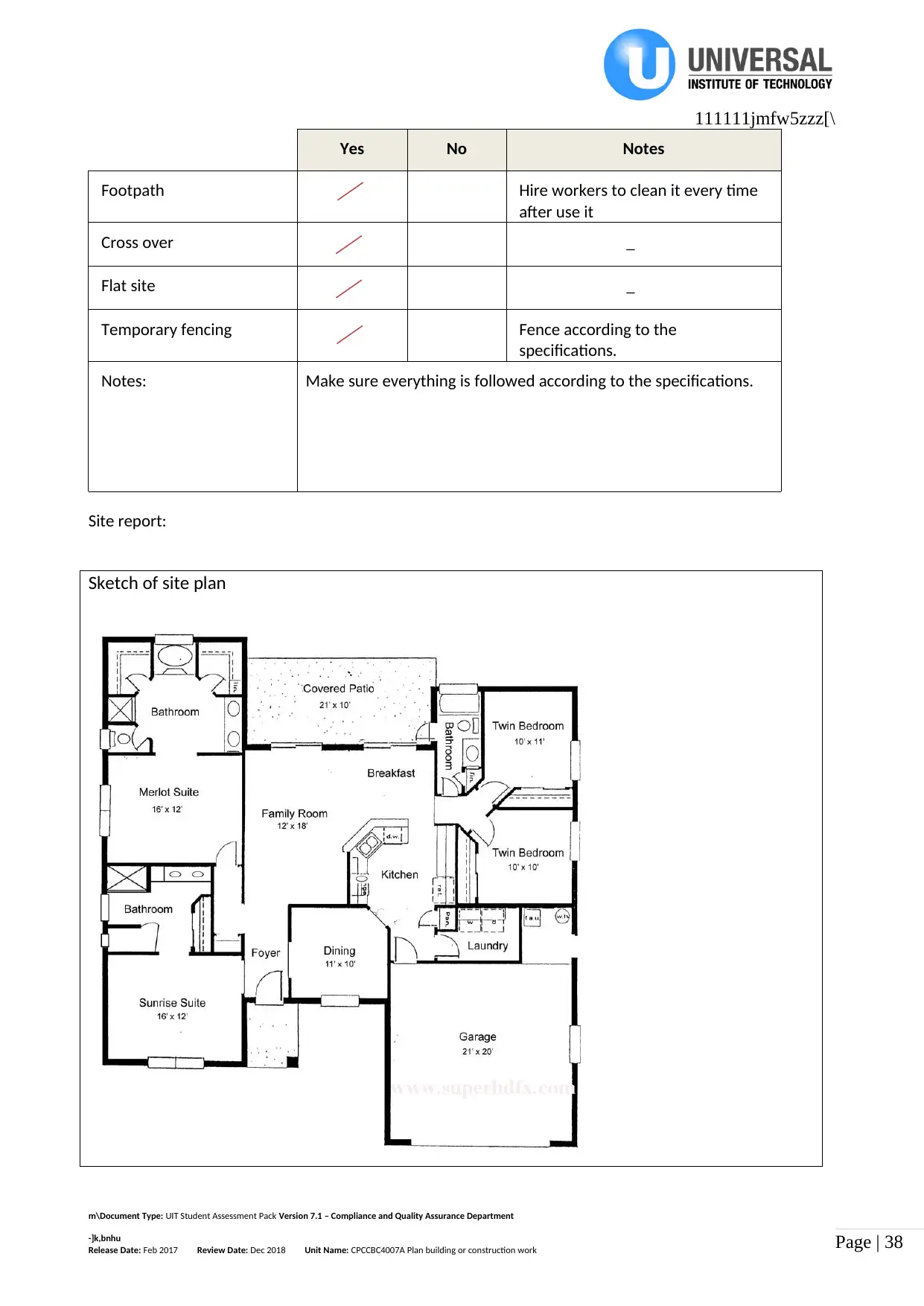
Page | 38
111111jmfw5zzz[\
Yes No Notes
Footpath Hire workers to clean it every time
after use it
Cross over _
Flat site _
Temporary fencing Fence according to the
specifications.
Notes: Make sure everything is followed according to the specifications.
Site report:
Sketch of site plan
m\Document Type: UIT Student Assessment Pack Version 7.1 – Compliance and Quality Assurance Department
-]k,bnhu
Release Date: Feb 2017 Review Date: Dec 2018 Unit Name: CPCCBC4007A Plan building or construction work
111111jmfw5zzz[\
Yes No Notes
Footpath Hire workers to clean it every time
after use it
Cross over _
Flat site _
Temporary fencing Fence according to the
specifications.
Notes: Make sure everything is followed according to the specifications.
Site report:
Sketch of site plan
m\Document Type: UIT Student Assessment Pack Version 7.1 – Compliance and Quality Assurance Department
-]k,bnhu
Release Date: Feb 2017 Review Date: Dec 2018 Unit Name: CPCCBC4007A Plan building or construction work
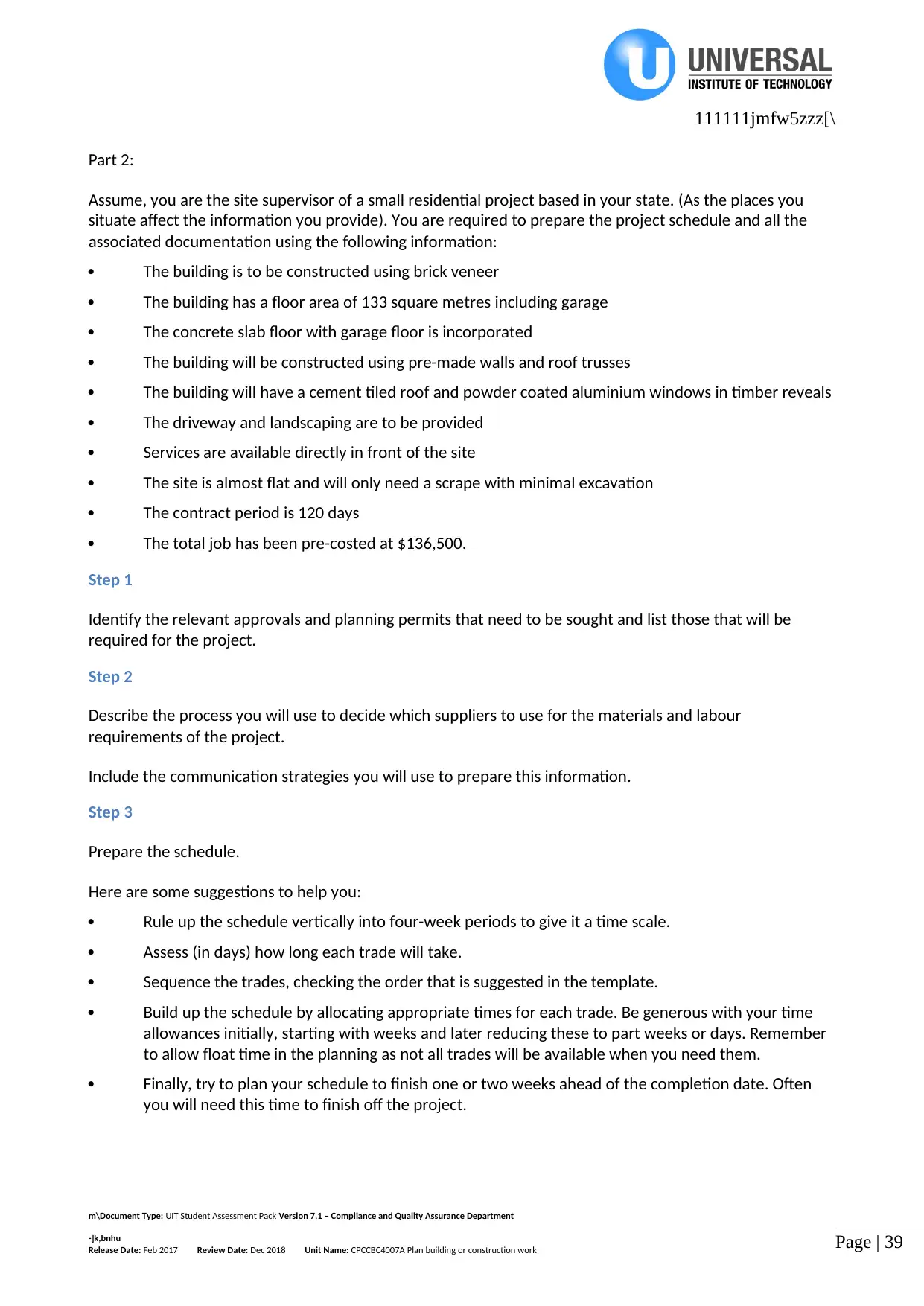
Page | 39
111111jmfw5zzz[\
Part 2:
Assume, you are the site supervisor of a small residential project based in your state. (As the places you
situate affect the information you provide). You are required to prepare the project schedule and all the
associated documentation using the following information:
The building is to be constructed using brick veneer
The building has a floor area of 133 square metres including garage
The concrete slab floor with garage floor is incorporated
The building will be constructed using pre-made walls and roof trusses
The building will have a cement tiled roof and powder coated aluminium windows in timber reveals
The driveway and landscaping are to be provided
Services are available directly in front of the site
The site is almost flat and will only need a scrape with minimal excavation
The contract period is 120 days
The total job has been pre-costed at $136,500.
Step 1
Identify the relevant approvals and planning permits that need to be sought and list those that will be
required for the project.
Step 2
Describe the process you will use to decide which suppliers to use for the materials and labour
requirements of the project.
Include the communication strategies you will use to prepare this information.
Step 3
Prepare the schedule.
Here are some suggestions to help you:
Rule up the schedule vertically into four-week periods to give it a time scale.
Assess (in days) how long each trade will take.
Sequence the trades, checking the order that is suggested in the template.
Build up the schedule by allocating appropriate times for each trade. Be generous with your time
allowances initially, starting with weeks and later reducing these to part weeks or days. Remember
to allow float time in the planning as not all trades will be available when you need them.
Finally, try to plan your schedule to finish one or two weeks ahead of the completion date. Often
you will need this time to finish off the project.
m\Document Type: UIT Student Assessment Pack Version 7.1 – Compliance and Quality Assurance Department
-]k,bnhu
Release Date: Feb 2017 Review Date: Dec 2018 Unit Name: CPCCBC4007A Plan building or construction work
111111jmfw5zzz[\
Part 2:
Assume, you are the site supervisor of a small residential project based in your state. (As the places you
situate affect the information you provide). You are required to prepare the project schedule and all the
associated documentation using the following information:
The building is to be constructed using brick veneer
The building has a floor area of 133 square metres including garage
The concrete slab floor with garage floor is incorporated
The building will be constructed using pre-made walls and roof trusses
The building will have a cement tiled roof and powder coated aluminium windows in timber reveals
The driveway and landscaping are to be provided
Services are available directly in front of the site
The site is almost flat and will only need a scrape with minimal excavation
The contract period is 120 days
The total job has been pre-costed at $136,500.
Step 1
Identify the relevant approvals and planning permits that need to be sought and list those that will be
required for the project.
Step 2
Describe the process you will use to decide which suppliers to use for the materials and labour
requirements of the project.
Include the communication strategies you will use to prepare this information.
Step 3
Prepare the schedule.
Here are some suggestions to help you:
Rule up the schedule vertically into four-week periods to give it a time scale.
Assess (in days) how long each trade will take.
Sequence the trades, checking the order that is suggested in the template.
Build up the schedule by allocating appropriate times for each trade. Be generous with your time
allowances initially, starting with weeks and later reducing these to part weeks or days. Remember
to allow float time in the planning as not all trades will be available when you need them.
Finally, try to plan your schedule to finish one or two weeks ahead of the completion date. Often
you will need this time to finish off the project.
m\Document Type: UIT Student Assessment Pack Version 7.1 – Compliance and Quality Assurance Department
-]k,bnhu
Release Date: Feb 2017 Review Date: Dec 2018 Unit Name: CPCCBC4007A Plan building or construction work
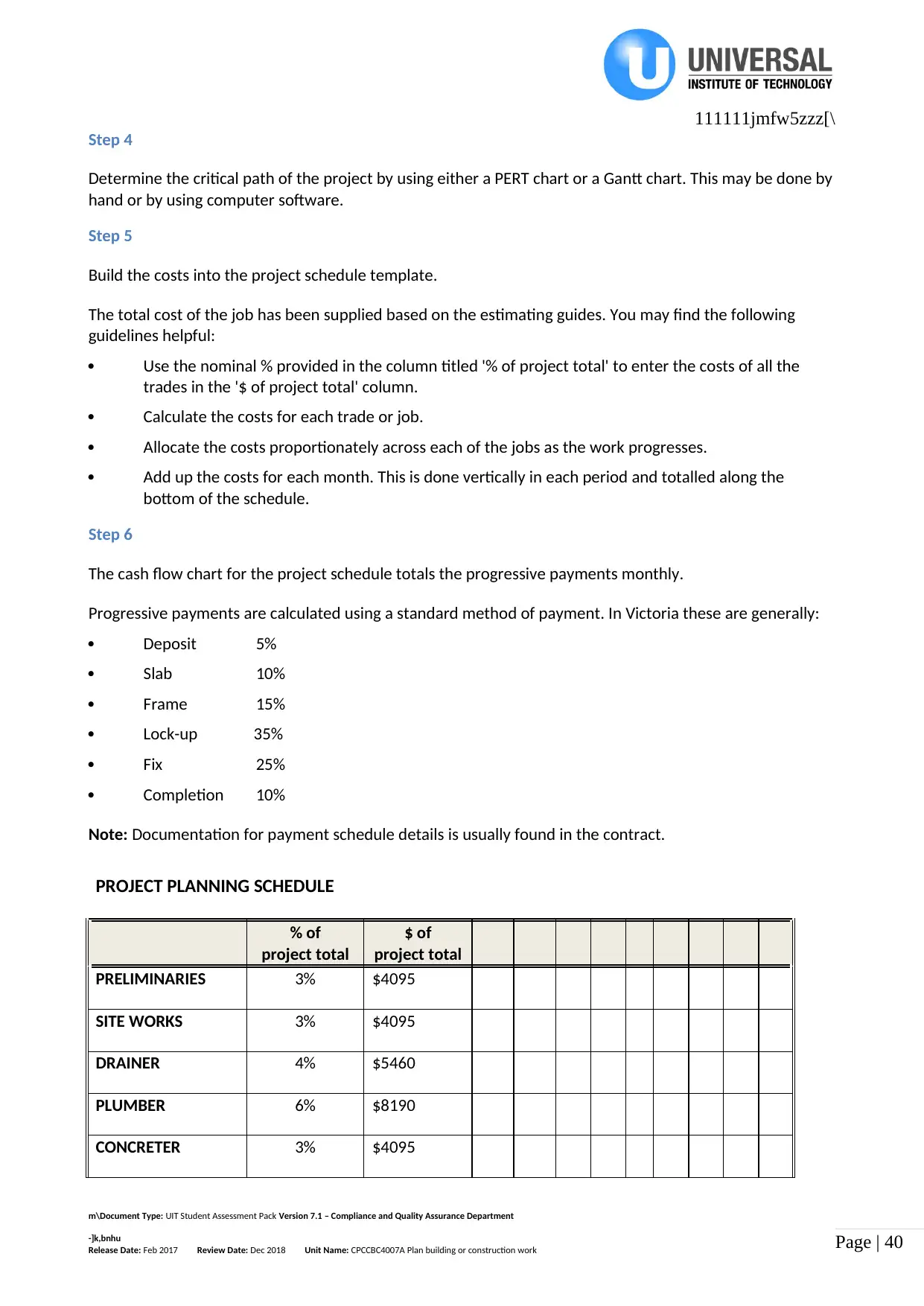
Page | 40
111111jmfw5zzz[\
Step 4
Determine the critical path of the project by using either a PERT chart or a Gantt chart. This may be done by
hand or by using computer software.
Step 5
Build the costs into the project schedule template.
The total cost of the job has been supplied based on the estimating guides. You may find the following
guidelines helpful:
Use the nominal % provided in the column titled '% of project total' to enter the costs of all the
trades in the '$ of project total' column.
Calculate the costs for each trade or job.
Allocate the costs proportionately across each of the jobs as the work progresses.
Add up the costs for each month. This is done vertically in each period and totalled along the
bottom of the schedule.
Step 6
The cash flow chart for the project schedule totals the progressive payments monthly.
Progressive payments are calculated using a standard method of payment. In Victoria these are generally:
Deposit 5%
Slab 10%
Frame 15%
Lock-up 35%
Fix 25%
Completion 10%
Note: Documentation for payment schedule details is usually found in the contract.
PROJECT PLANNING SCHEDULE
% of $ of
project total project total
PRELIMINARIES 3% $4095
SITE WORKS 3% $4095
DRAINER 4% $5460
PLUMBER 6% $8190
CONCRETER 3% $4095
m\Document Type: UIT Student Assessment Pack Version 7.1 – Compliance and Quality Assurance Department
-]k,bnhu
Release Date: Feb 2017 Review Date: Dec 2018 Unit Name: CPCCBC4007A Plan building or construction work
111111jmfw5zzz[\
Step 4
Determine the critical path of the project by using either a PERT chart or a Gantt chart. This may be done by
hand or by using computer software.
Step 5
Build the costs into the project schedule template.
The total cost of the job has been supplied based on the estimating guides. You may find the following
guidelines helpful:
Use the nominal % provided in the column titled '% of project total' to enter the costs of all the
trades in the '$ of project total' column.
Calculate the costs for each trade or job.
Allocate the costs proportionately across each of the jobs as the work progresses.
Add up the costs for each month. This is done vertically in each period and totalled along the
bottom of the schedule.
Step 6
The cash flow chart for the project schedule totals the progressive payments monthly.
Progressive payments are calculated using a standard method of payment. In Victoria these are generally:
Deposit 5%
Slab 10%
Frame 15%
Lock-up 35%
Fix 25%
Completion 10%
Note: Documentation for payment schedule details is usually found in the contract.
PROJECT PLANNING SCHEDULE
% of $ of
project total project total
PRELIMINARIES 3% $4095
SITE WORKS 3% $4095
DRAINER 4% $5460
PLUMBER 6% $8190
CONCRETER 3% $4095
m\Document Type: UIT Student Assessment Pack Version 7.1 – Compliance and Quality Assurance Department
-]k,bnhu
Release Date: Feb 2017 Review Date: Dec 2018 Unit Name: CPCCBC4007A Plan building or construction work
Secure Best Marks with AI Grader
Need help grading? Try our AI Grader for instant feedback on your assignments.
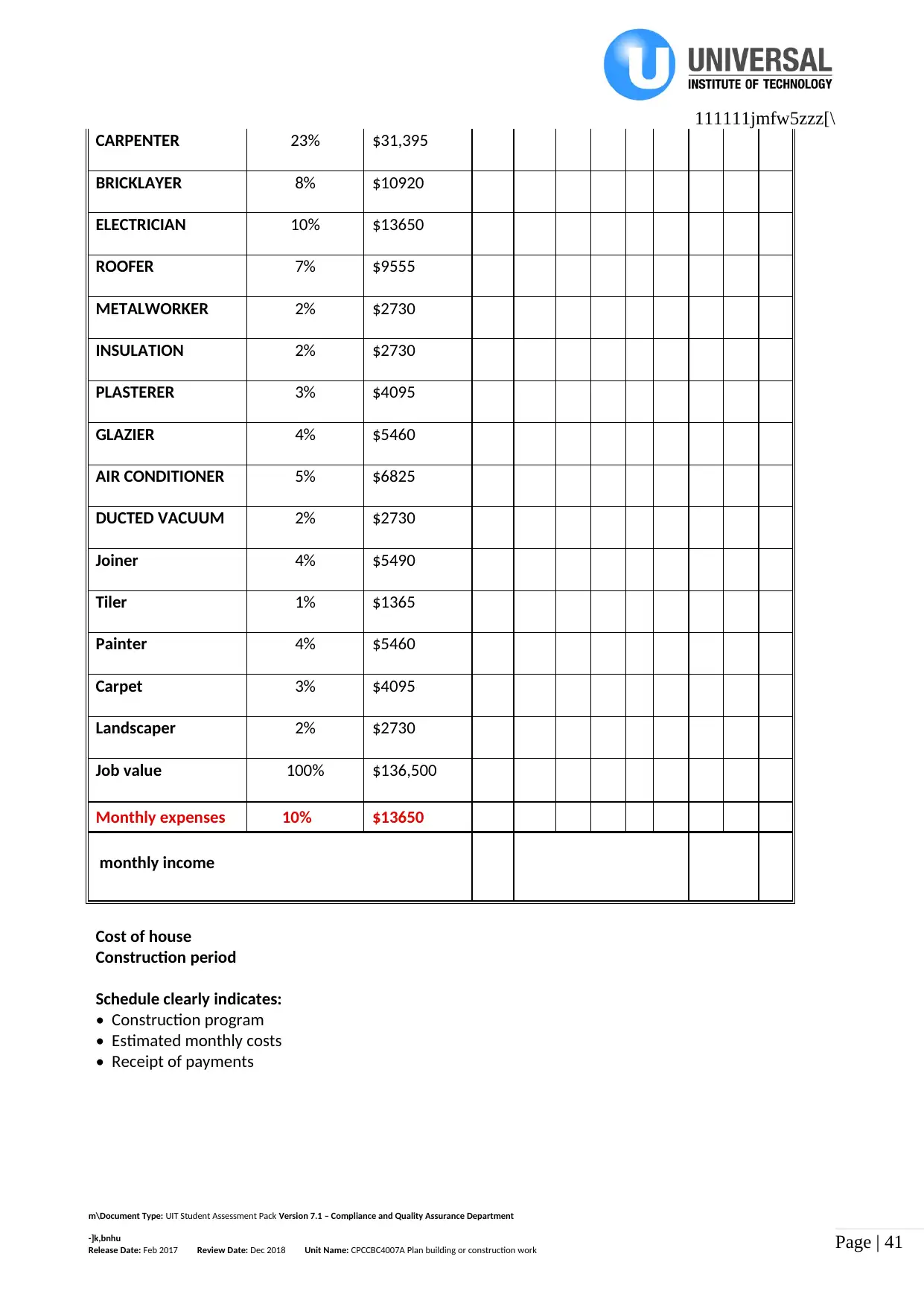
Page | 41
111111jmfw5zzz[\
CARPENTER 23% $31,395
BRICKLAYER 8% $10920
ELECTRICIAN 10% $13650
ROOFER 7% $9555
METALWORKER 2% $2730
INSULATION 2% $2730
PLASTERER 3% $4095
GLAZIER 4% $5460
AIR CONDITIONER 5% $6825
DUCTED VACUUM 2% $2730
Joiner 4% $5490
Tiler 1% $1365
Painter 4% $5460
Carpet 3% $4095
Landscaper 2% $2730
Job value 100% $136,500
Monthly expenses 10% $13650
monthly income
Cost of house
Construction period
Schedule clearly indicates:
• Construction program
• Estimated monthly costs
• Receipt of payments
m\Document Type: UIT Student Assessment Pack Version 7.1 – Compliance and Quality Assurance Department
-]k,bnhu
Release Date: Feb 2017 Review Date: Dec 2018 Unit Name: CPCCBC4007A Plan building or construction work
111111jmfw5zzz[\
CARPENTER 23% $31,395
BRICKLAYER 8% $10920
ELECTRICIAN 10% $13650
ROOFER 7% $9555
METALWORKER 2% $2730
INSULATION 2% $2730
PLASTERER 3% $4095
GLAZIER 4% $5460
AIR CONDITIONER 5% $6825
DUCTED VACUUM 2% $2730
Joiner 4% $5490
Tiler 1% $1365
Painter 4% $5460
Carpet 3% $4095
Landscaper 2% $2730
Job value 100% $136,500
Monthly expenses 10% $13650
monthly income
Cost of house
Construction period
Schedule clearly indicates:
• Construction program
• Estimated monthly costs
• Receipt of payments
m\Document Type: UIT Student Assessment Pack Version 7.1 – Compliance and Quality Assurance Department
-]k,bnhu
Release Date: Feb 2017 Review Date: Dec 2018 Unit Name: CPCCBC4007A Plan building or construction work
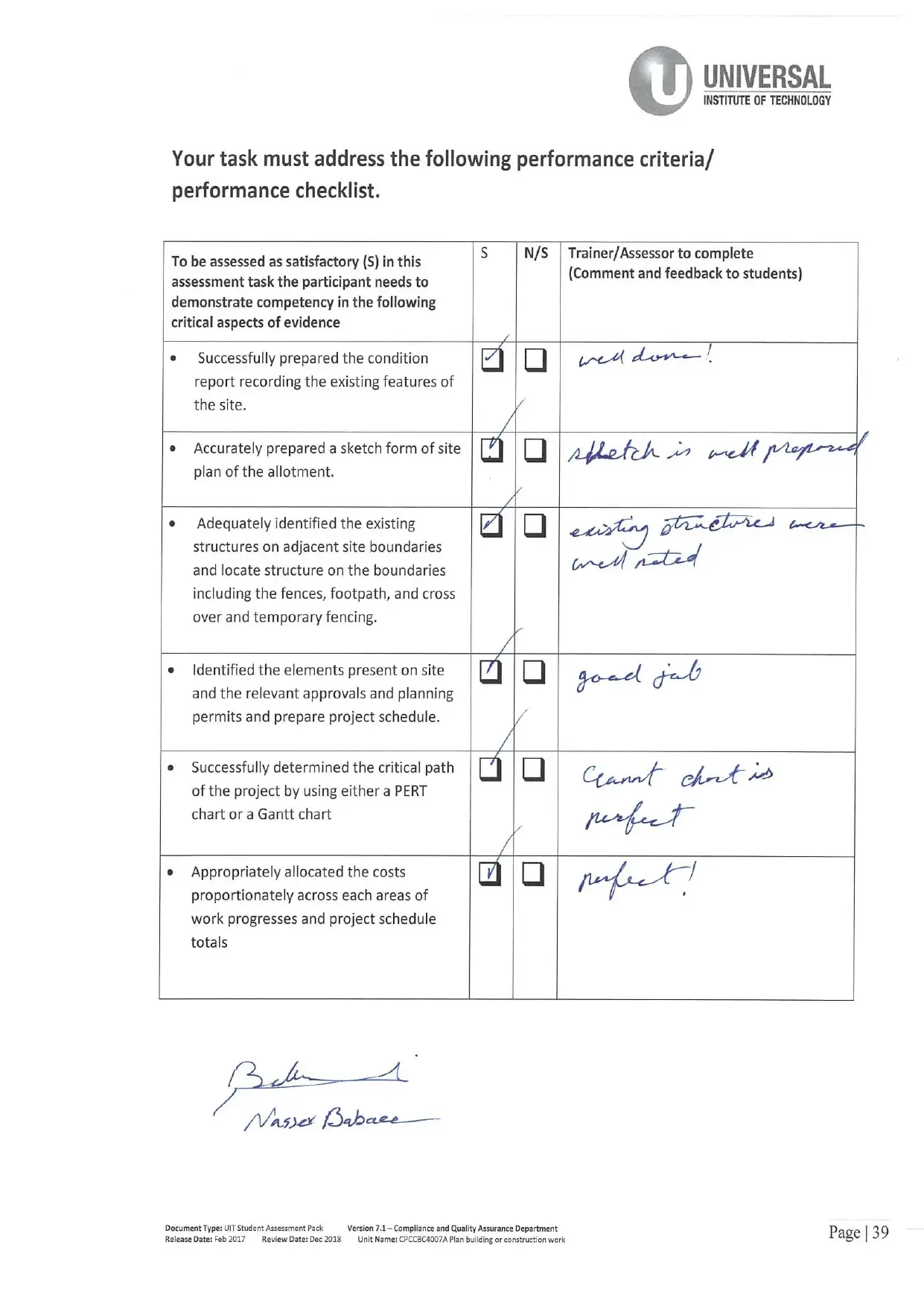
Page | 42
111111jmfw5zzz[\
m\Document Type: UIT Student Assessment Pack Version 7.1 – Compliance and Quality Assurance Department
-]k,bnhu
Release Date: Feb 2017 Review Date: Dec 2018 Unit Name: CPCCBC4007A Plan building or construction work
111111jmfw5zzz[\
m\Document Type: UIT Student Assessment Pack Version 7.1 – Compliance and Quality Assurance Department
-]k,bnhu
Release Date: Feb 2017 Review Date: Dec 2018 Unit Name: CPCCBC4007A Plan building or construction work

Page | 43
111111jmfw5zzz[\
Unit Assessment Result Sheet (UARS)
Assessment Task 2 – Unit skills test (UST)
Student and Trainer/Assessor Details
Unit code CPCCBC4007A
Unit name Plan building or construction work
Outcome of Unit
Assessment Task (UAT)
First attempt:
Outcome (please make sure to tick the correct checkbox):
Satisfactory (S) ☐ or Not Satisfactory (NS) ☒
Date: ___08____(day)/ ___08____(month)/ __2018___(year)
Second attempt:
Outcome (please make sure to tick the correct checkbox):
Satisfactory (S) ☐ or Not Satisfactory (NS) ☐
Date: _______(day)/ _______(month)/ ____________(year)
Feedback to Student First attempt:
Incomplete
Second attempt:
Student Declaration I declare that the answers I have provided are my own work.
Where I have accessed information from other sources, I have
provided references and or links to my sources.
I have kept a copy of all relevant notes and reference material
that I used as part of my submission.
I have provided references for all sources where the
information is not my own. I understand the consequences of
m\Document Type: UIT Student Assessment Pack Version 7.1 – Compliance and Quality Assurance Department
-]k,bnhu
Release Date: Feb 2017 Review Date: Dec 2018 Unit Name: CPCCBC4007A Plan building or construction work
111111jmfw5zzz[\
Unit Assessment Result Sheet (UARS)
Assessment Task 2 – Unit skills test (UST)
Student and Trainer/Assessor Details
Unit code CPCCBC4007A
Unit name Plan building or construction work
Outcome of Unit
Assessment Task (UAT)
First attempt:
Outcome (please make sure to tick the correct checkbox):
Satisfactory (S) ☐ or Not Satisfactory (NS) ☒
Date: ___08____(day)/ ___08____(month)/ __2018___(year)
Second attempt:
Outcome (please make sure to tick the correct checkbox):
Satisfactory (S) ☐ or Not Satisfactory (NS) ☐
Date: _______(day)/ _______(month)/ ____________(year)
Feedback to Student First attempt:
Incomplete
Second attempt:
Student Declaration I declare that the answers I have provided are my own work.
Where I have accessed information from other sources, I have
provided references and or links to my sources.
I have kept a copy of all relevant notes and reference material
that I used as part of my submission.
I have provided references for all sources where the
information is not my own. I understand the consequences of
m\Document Type: UIT Student Assessment Pack Version 7.1 – Compliance and Quality Assurance Department
-]k,bnhu
Release Date: Feb 2017 Review Date: Dec 2018 Unit Name: CPCCBC4007A Plan building or construction work
Paraphrase This Document
Need a fresh take? Get an instant paraphrase of this document with our AI Paraphraser

Page | 44
111111jmfw5zzz[\
falsifying documentation and plagiarism. I understand how
the assessment is structured. I accept that all work I submit
must be verifiable as my own.
I understand that if I disagree with the assessment outcome, I
can appeal the assessment process, and either re-submit
additional evidence undertake gap training and or have my
submission re-assessed.
All appeal options have been explained to me.
Student Signature
Date
Trainer/Assessor Name NASSER BABAEE
Trainer/Assessor
Declaration
I hold:
Vocational competencies at least to the level being delivered
Current relevant industry skills
Current knowledge and skills in VET, and undertake
Ongoing professional development in VET
I declare that I have conducted an assessment of this candidate’s
submission. The assessment tasks were deemed current, sufficient,
valid and reliable. I declare that I have conducted a fair, valid, reliable,
and flexible assessment. I have provided feedback to the above-
named candidate.
Trainer/Assessor
Signature
Date 08/08/2018
Office Use Only Outcome of Assessment has been entered onto the Student
Management System on _________________ (insert date)
by (insert Name) __________________________________
m\Document Type: UIT Student Assessment Pack Version 7.1 – Compliance and Quality Assurance Department
-]k,bnhu
Release Date: Feb 2017 Review Date: Dec 2018 Unit Name: CPCCBC4007A Plan building or construction work
111111jmfw5zzz[\
falsifying documentation and plagiarism. I understand how
the assessment is structured. I accept that all work I submit
must be verifiable as my own.
I understand that if I disagree with the assessment outcome, I
can appeal the assessment process, and either re-submit
additional evidence undertake gap training and or have my
submission re-assessed.
All appeal options have been explained to me.
Student Signature
Date
Trainer/Assessor Name NASSER BABAEE
Trainer/Assessor
Declaration
I hold:
Vocational competencies at least to the level being delivered
Current relevant industry skills
Current knowledge and skills in VET, and undertake
Ongoing professional development in VET
I declare that I have conducted an assessment of this candidate’s
submission. The assessment tasks were deemed current, sufficient,
valid and reliable. I declare that I have conducted a fair, valid, reliable,
and flexible assessment. I have provided feedback to the above-
named candidate.
Trainer/Assessor
Signature
Date 08/08/2018
Office Use Only Outcome of Assessment has been entered onto the Student
Management System on _________________ (insert date)
by (insert Name) __________________________________
m\Document Type: UIT Student Assessment Pack Version 7.1 – Compliance and Quality Assurance Department
-]k,bnhu
Release Date: Feb 2017 Review Date: Dec 2018 Unit Name: CPCCBC4007A Plan building or construction work
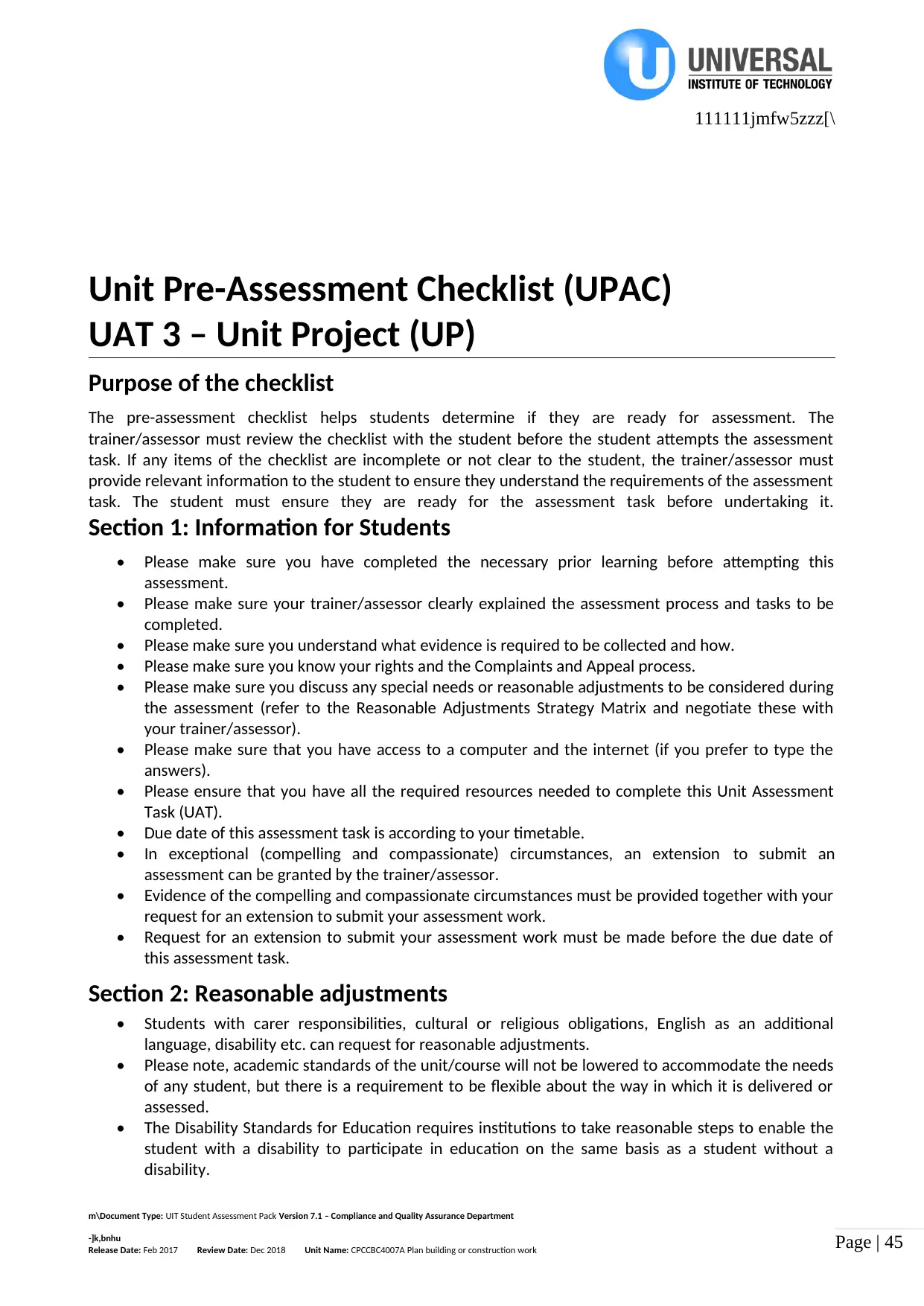
Page | 45
111111jmfw5zzz[\
Unit Pre-Assessment Checklist (UPAC)
UAT 3 – Unit Project (UP)
Purpose of the checklist
The pre-assessment checklist helps students determine if they are ready for assessment. The
trainer/assessor must review the checklist with the student before the student attempts the assessment
task. If any items of the checklist are incomplete or not clear to the student, the trainer/assessor must
provide relevant information to the student to ensure they understand the requirements of the assessment
task. The student must ensure they are ready for the assessment task before undertaking it.
Section 1: Information for Students
• Please make sure you have completed the necessary prior learning before attempting this
assessment.
• Please make sure your trainer/assessor clearly explained the assessment process and tasks to be
completed.
• Please make sure you understand what evidence is required to be collected and how.
• Please make sure you know your rights and the Complaints and Appeal process.
• Please make sure you discuss any special needs or reasonable adjustments to be considered during
the assessment (refer to the Reasonable Adjustments Strategy Matrix and negotiate these with
your trainer/assessor).
• Please make sure that you have access to a computer and the internet (if you prefer to type the
answers).
• Please ensure that you have all the required resources needed to complete this Unit Assessment
Task (UAT).
• Due date of this assessment task is according to your timetable.
• In exceptional (compelling and compassionate) circumstances, an extension to submit an
assessment can be granted by the trainer/assessor.
• Evidence of the compelling and compassionate circumstances must be provided together with your
request for an extension to submit your assessment work.
• Request for an extension to submit your assessment work must be made before the due date of
this assessment task.
Section 2: Reasonable adjustments
• Students with carer responsibilities, cultural or religious obligations, English as an additional
language, disability etc. can request for reasonable adjustments.
• Please note, academic standards of the unit/course will not be lowered to accommodate the needs
of any student, but there is a requirement to be flexible about the way in which it is delivered or
assessed.
• The Disability Standards for Education requires institutions to take reasonable steps to enable the
student with a disability to participate in education on the same basis as a student without a
disability.
m\Document Type: UIT Student Assessment Pack Version 7.1 – Compliance and Quality Assurance Department
-]k,bnhu
Release Date: Feb 2017 Review Date: Dec 2018 Unit Name: CPCCBC4007A Plan building or construction work
111111jmfw5zzz[\
Unit Pre-Assessment Checklist (UPAC)
UAT 3 – Unit Project (UP)
Purpose of the checklist
The pre-assessment checklist helps students determine if they are ready for assessment. The
trainer/assessor must review the checklist with the student before the student attempts the assessment
task. If any items of the checklist are incomplete or not clear to the student, the trainer/assessor must
provide relevant information to the student to ensure they understand the requirements of the assessment
task. The student must ensure they are ready for the assessment task before undertaking it.
Section 1: Information for Students
• Please make sure you have completed the necessary prior learning before attempting this
assessment.
• Please make sure your trainer/assessor clearly explained the assessment process and tasks to be
completed.
• Please make sure you understand what evidence is required to be collected and how.
• Please make sure you know your rights and the Complaints and Appeal process.
• Please make sure you discuss any special needs or reasonable adjustments to be considered during
the assessment (refer to the Reasonable Adjustments Strategy Matrix and negotiate these with
your trainer/assessor).
• Please make sure that you have access to a computer and the internet (if you prefer to type the
answers).
• Please ensure that you have all the required resources needed to complete this Unit Assessment
Task (UAT).
• Due date of this assessment task is according to your timetable.
• In exceptional (compelling and compassionate) circumstances, an extension to submit an
assessment can be granted by the trainer/assessor.
• Evidence of the compelling and compassionate circumstances must be provided together with your
request for an extension to submit your assessment work.
• Request for an extension to submit your assessment work must be made before the due date of
this assessment task.
Section 2: Reasonable adjustments
• Students with carer responsibilities, cultural or religious obligations, English as an additional
language, disability etc. can request for reasonable adjustments.
• Please note, academic standards of the unit/course will not be lowered to accommodate the needs
of any student, but there is a requirement to be flexible about the way in which it is delivered or
assessed.
• The Disability Standards for Education requires institutions to take reasonable steps to enable the
student with a disability to participate in education on the same basis as a student without a
disability.
m\Document Type: UIT Student Assessment Pack Version 7.1 – Compliance and Quality Assurance Department
-]k,bnhu
Release Date: Feb 2017 Review Date: Dec 2018 Unit Name: CPCCBC4007A Plan building or construction work
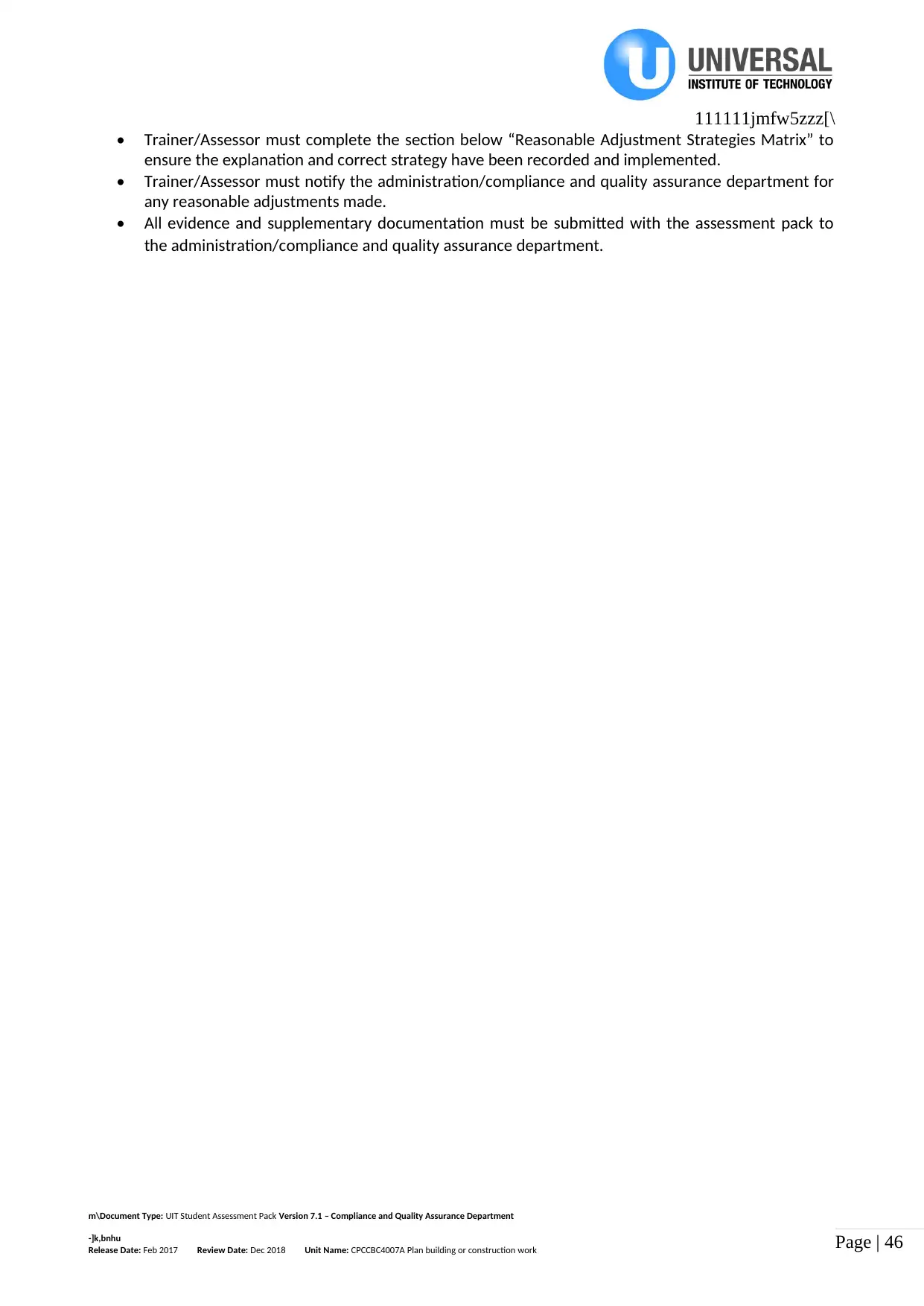
Page | 46
111111jmfw5zzz[\
• Trainer/Assessor must complete the section below “Reasonable Adjustment Strategies Matrix” to
ensure the explanation and correct strategy have been recorded and implemented.
• Trainer/Assessor must notify the administration/compliance and quality assurance department for
any reasonable adjustments made.
• All evidence and supplementary documentation must be submitted with the assessment pack to
the administration/compliance and quality assurance department.
m\Document Type: UIT Student Assessment Pack Version 7.1 – Compliance and Quality Assurance Department
-]k,bnhu
Release Date: Feb 2017 Review Date: Dec 2018 Unit Name: CPCCBC4007A Plan building or construction work
111111jmfw5zzz[\
• Trainer/Assessor must complete the section below “Reasonable Adjustment Strategies Matrix” to
ensure the explanation and correct strategy have been recorded and implemented.
• Trainer/Assessor must notify the administration/compliance and quality assurance department for
any reasonable adjustments made.
• All evidence and supplementary documentation must be submitted with the assessment pack to
the administration/compliance and quality assurance department.
m\Document Type: UIT Student Assessment Pack Version 7.1 – Compliance and Quality Assurance Department
-]k,bnhu
Release Date: Feb 2017 Review Date: Dec 2018 Unit Name: CPCCBC4007A Plan building or construction work
Secure Best Marks with AI Grader
Need help grading? Try our AI Grader for instant feedback on your assignments.
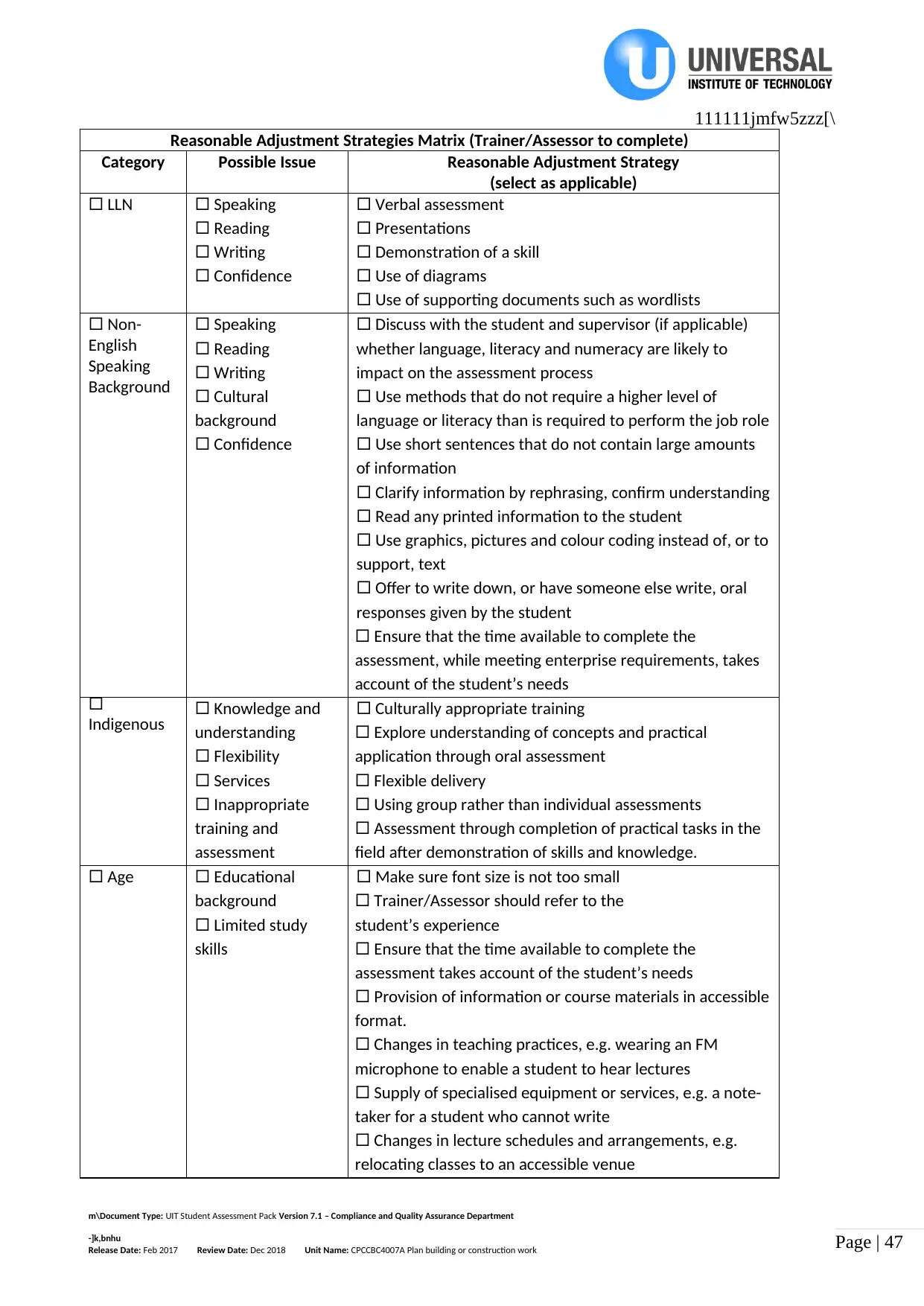
Page | 47
111111jmfw5zzz[\
Reasonable Adjustment Strategies Matrix (Trainer/Assessor to complete)
Category Possible Issue Reasonable Adjustment Strategy
(select as applicable)
LLN Speaking
Reading
Writing
Confidence
Verbal assessment
Presentations
Demonstration of a skill
Use of diagrams
Use of supporting documents such as wordlists
Non-
English
Speaking
Background
Speaking
Reading
Writing
Cultural
background
Confidence
Discuss with the student and supervisor (if applicable)
whether language, literacy and numeracy are likely to
impact on the assessment process
Use methods that do not require a higher level of
language or literacy than is required to perform the job role
Use short sentences that do not contain large amounts
of information
Clarify information by rephrasing, confirm understanding
Read any printed information to the student
Use graphics, pictures and colour coding instead of, or to
support, text
Offer to write down, or have someone else write, oral
responses given by the student
Ensure that the time available to complete the
assessment, while meeting enterprise requirements, takes
account of the student’s needs
Indigenous Knowledge and
understanding
Flexibility
Services
Inappropriate
training and
assessment
Culturally appropriate training
Explore understanding of concepts and practical
application through oral assessment
Flexible delivery
Using group rather than individual assessments
Assessment through completion of practical tasks in the
field after demonstration of skills and knowledge.
Age Educational
background
Limited study
skills
Make sure font size is not too small
Trainer/Assessor should refer to the
student’s experience
Ensure that the time available to complete the
assessment takes account of the student’s needs
Provision of information or course materials in accessible
format.
Changes in teaching practices, e.g. wearing an FM
microphone to enable a student to hear lectures
Supply of specialised equipment or services, e.g. a note-
taker for a student who cannot write
Changes in lecture schedules and arrangements, e.g.
relocating classes to an accessible venue
m\Document Type: UIT Student Assessment Pack Version 7.1 – Compliance and Quality Assurance Department
-]k,bnhu
Release Date: Feb 2017 Review Date: Dec 2018 Unit Name: CPCCBC4007A Plan building or construction work
111111jmfw5zzz[\
Reasonable Adjustment Strategies Matrix (Trainer/Assessor to complete)
Category Possible Issue Reasonable Adjustment Strategy
(select as applicable)
LLN Speaking
Reading
Writing
Confidence
Verbal assessment
Presentations
Demonstration of a skill
Use of diagrams
Use of supporting documents such as wordlists
Non-
English
Speaking
Background
Speaking
Reading
Writing
Cultural
background
Confidence
Discuss with the student and supervisor (if applicable)
whether language, literacy and numeracy are likely to
impact on the assessment process
Use methods that do not require a higher level of
language or literacy than is required to perform the job role
Use short sentences that do not contain large amounts
of information
Clarify information by rephrasing, confirm understanding
Read any printed information to the student
Use graphics, pictures and colour coding instead of, or to
support, text
Offer to write down, or have someone else write, oral
responses given by the student
Ensure that the time available to complete the
assessment, while meeting enterprise requirements, takes
account of the student’s needs
Indigenous Knowledge and
understanding
Flexibility
Services
Inappropriate
training and
assessment
Culturally appropriate training
Explore understanding of concepts and practical
application through oral assessment
Flexible delivery
Using group rather than individual assessments
Assessment through completion of practical tasks in the
field after demonstration of skills and knowledge.
Age Educational
background
Limited study
skills
Make sure font size is not too small
Trainer/Assessor should refer to the
student’s experience
Ensure that the time available to complete the
assessment takes account of the student’s needs
Provision of information or course materials in accessible
format.
Changes in teaching practices, e.g. wearing an FM
microphone to enable a student to hear lectures
Supply of specialised equipment or services, e.g. a note-
taker for a student who cannot write
Changes in lecture schedules and arrangements, e.g.
relocating classes to an accessible venue
m\Document Type: UIT Student Assessment Pack Version 7.1 – Compliance and Quality Assurance Department
-]k,bnhu
Release Date: Feb 2017 Review Date: Dec 2018 Unit Name: CPCCBC4007A Plan building or construction work
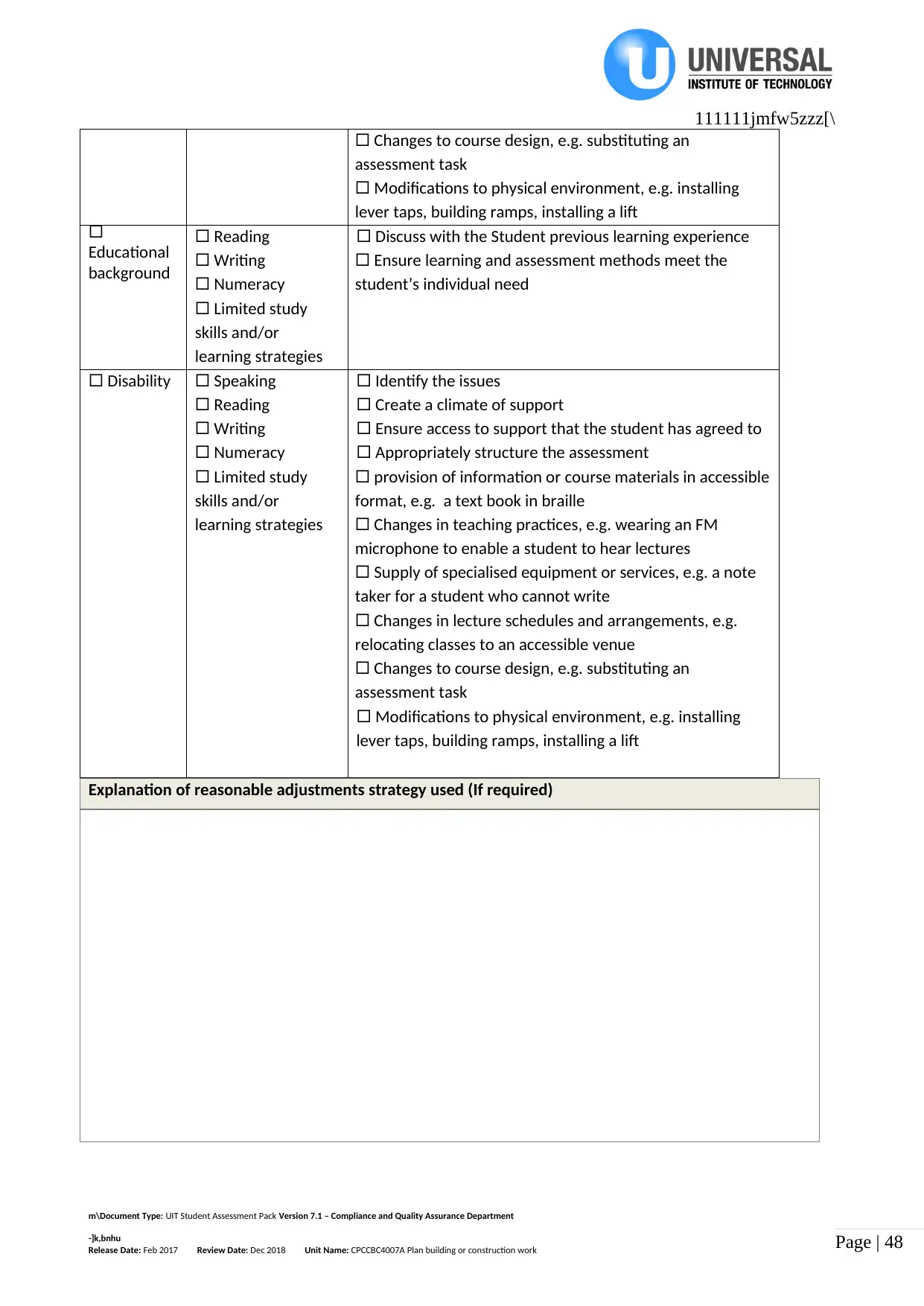
Page | 48
111111jmfw5zzz[\
Changes to course design, e.g. substituting an
assessment task
Modifications to physical environment, e.g. installing
lever taps, building ramps, installing a lift
Educational
background
Reading
Writing
Numeracy
Limited study
skills and/or
learning strategies
Discuss with the Student previous learning experience
Ensure learning and assessment methods meet the
student’s individual need
Disability Speaking
Reading
Writing
Numeracy
Limited study
skills and/or
learning strategies
Identify the issues
Create a climate of support
Ensure access to support that the student has agreed to
Appropriately structure the assessment
provision of information or course materials in accessible
format, e.g. a text book in braille
Changes in teaching practices, e.g. wearing an FM
microphone to enable a student to hear lectures
Supply of specialised equipment or services, e.g. a note
taker for a student who cannot write
Changes in lecture schedules and arrangements, e.g.
relocating classes to an accessible venue
Changes to course design, e.g. substituting an
assessment task
Modifications to physical environment, e.g. installing
lever taps, building ramps, installing a lift
Explanation of reasonable adjustments strategy used (If required)
m\Document Type: UIT Student Assessment Pack Version 7.1 – Compliance and Quality Assurance Department
-]k,bnhu
Release Date: Feb 2017 Review Date: Dec 2018 Unit Name: CPCCBC4007A Plan building or construction work
111111jmfw5zzz[\
Changes to course design, e.g. substituting an
assessment task
Modifications to physical environment, e.g. installing
lever taps, building ramps, installing a lift
Educational
background
Reading
Writing
Numeracy
Limited study
skills and/or
learning strategies
Discuss with the Student previous learning experience
Ensure learning and assessment methods meet the
student’s individual need
Disability Speaking
Reading
Writing
Numeracy
Limited study
skills and/or
learning strategies
Identify the issues
Create a climate of support
Ensure access to support that the student has agreed to
Appropriately structure the assessment
provision of information or course materials in accessible
format, e.g. a text book in braille
Changes in teaching practices, e.g. wearing an FM
microphone to enable a student to hear lectures
Supply of specialised equipment or services, e.g. a note
taker for a student who cannot write
Changes in lecture schedules and arrangements, e.g.
relocating classes to an accessible venue
Changes to course design, e.g. substituting an
assessment task
Modifications to physical environment, e.g. installing
lever taps, building ramps, installing a lift
Explanation of reasonable adjustments strategy used (If required)
m\Document Type: UIT Student Assessment Pack Version 7.1 – Compliance and Quality Assurance Department
-]k,bnhu
Release Date: Feb 2017 Review Date: Dec 2018 Unit Name: CPCCBC4007A Plan building or construction work

Page | 49
111111jmfw5zzz[\
Unit Assessment Task (UAT)
Assessment Task 3 – Unit Project (UP)
Assessment type:
Unit Project (UP) - Perform calculations and prepare project report based on given house plan
Assessment task description:
This is the third (3) assessment task you have to successfully complete to be deemed competent in
this unit of competency.
This assessment task requires you to complete a project.
You must perform calculations and prepare project report based on given house plan in order to
successfully complete this project.
You will receive your feedback within two weeks - you will be notified by your trainer/assessor
when results are available.
You must attempt all activities of the project for your trainer/assessor to assess your competency in
this assessment task.
Applicable conditions:
This project is untimed and is conducted as open book tests (this means you are able to refer to
your textbook).
You must read and respond to all criteria of the project.
Word limit to complete the project report is 500-600 words.
You may handwrite/use computers to answer the criteria of the project.
You must complete the task independently.
No marks or grades are allocated for this assessment task. The outcome of the task will be
Satisfactory or Not Satisfactory.
As you complete this assessment task you are predominately demonstrating your practical skills,
techniques and knowledge to your trainer/assessor.
The trainer/assessor may ask you relevant questions on this assessment task to ensure that this is
your own work.
Resubmissions and reattempts:
Where a student’s answers are deemed not satisfactory after the first attempt, a resubmission
attempt will be allowed.
You must speak to your Trainer/Assessor if you have any difficulty in completing this task and
require reasonable adjustments (e.g. can be given as an oral assessment).
For more information, please refer to your RTO Student Handbook.
Location:
This assessment task may be completed in an independent learning environment or learning
management system.
Your trainer/assessor will provide you further information regarding the location of completing this
assessment task.
General Instructions for attempting the project:
You will perform calculations and prepare project report based on given house plan in this
assessment task.
m\Document Type: UIT Student Assessment Pack Version 7.1 – Compliance and Quality Assurance Department
-]k,bnhu
Release Date: Feb 2017 Review Date: Dec 2018 Unit Name: CPCCBC4007A Plan building or construction work
111111jmfw5zzz[\
Unit Assessment Task (UAT)
Assessment Task 3 – Unit Project (UP)
Assessment type:
Unit Project (UP) - Perform calculations and prepare project report based on given house plan
Assessment task description:
This is the third (3) assessment task you have to successfully complete to be deemed competent in
this unit of competency.
This assessment task requires you to complete a project.
You must perform calculations and prepare project report based on given house plan in order to
successfully complete this project.
You will receive your feedback within two weeks - you will be notified by your trainer/assessor
when results are available.
You must attempt all activities of the project for your trainer/assessor to assess your competency in
this assessment task.
Applicable conditions:
This project is untimed and is conducted as open book tests (this means you are able to refer to
your textbook).
You must read and respond to all criteria of the project.
Word limit to complete the project report is 500-600 words.
You may handwrite/use computers to answer the criteria of the project.
You must complete the task independently.
No marks or grades are allocated for this assessment task. The outcome of the task will be
Satisfactory or Not Satisfactory.
As you complete this assessment task you are predominately demonstrating your practical skills,
techniques and knowledge to your trainer/assessor.
The trainer/assessor may ask you relevant questions on this assessment task to ensure that this is
your own work.
Resubmissions and reattempts:
Where a student’s answers are deemed not satisfactory after the first attempt, a resubmission
attempt will be allowed.
You must speak to your Trainer/Assessor if you have any difficulty in completing this task and
require reasonable adjustments (e.g. can be given as an oral assessment).
For more information, please refer to your RTO Student Handbook.
Location:
This assessment task may be completed in an independent learning environment or learning
management system.
Your trainer/assessor will provide you further information regarding the location of completing this
assessment task.
General Instructions for attempting the project:
You will perform calculations and prepare project report based on given house plan in this
assessment task.
m\Document Type: UIT Student Assessment Pack Version 7.1 – Compliance and Quality Assurance Department
-]k,bnhu
Release Date: Feb 2017 Review Date: Dec 2018 Unit Name: CPCCBC4007A Plan building or construction work
Paraphrase This Document
Need a fresh take? Get an instant paraphrase of this document with our AI Paraphraser

Page | 50
111111jmfw5zzz[\
Instructions to perform calculations and prepare project report based on given house plan are
provided within the assessment task.
You will be required to correctly attempt all activities of this assessment task.
How your trainer/assessor will assess your work?
This assessment task requires the student to successfully complete and submit the project.
Answers must demonstrate the student’s understanding and skills of the unit.
You will be assessed according to the provided performance checklist/ performance criteria.
Assessment objectives/ measurable learning outcome(s) are attached as performance checklist/
performance criteria with this assessment task to ensure that you have successfully completed and
submitted the assessment task.
If all assessment tasks are deemed Satisfactory (S), then the unit outcome is Competent (C).
If at least one of the assessment tasks is deemed Not Satisfactory (NS), then the unit outcome is
Not Yet Competent (NYC).
Once all assessment tasks allocated to this Unit of Competency have been undertaken,
trainer/assessor will complete an Assessment plan to record the unit outcome. The outcome will be
either Competent (C) or Not Yet Competent (NYC).
The “Assessment Plan” is available with the Unit Assessment Pack (UAP) – Cover Sheet.
Purpose of the assessment
This assessment task is designed to evaluate student’s skills regarding to the following:
Skills to identify any usual aspects of construction, use of appropriate material by reviewing
contract documentation.
Skills to assess availability of material, confirm with supplier and identify site access requirements
and limitations and choose appropriate actions to facilitate entry.
Skills to prepare documentation for authorities controlling construction and determine project
commencement date and implement procedures for controlling and recording site deliveries.
Skills to identify organisational strategies for implementing construction operations and implement
procedures for recording hire of equipment.
Skills to implement organisational OHS policy and procedures, including hazard and risk
management and procedures for the removal of existing services and hazardous materials.
Skills to determine and document temporary services, labour requirements, site accommodation
requirements and plan requirements and availability dates with reference to contract
documentation.
Reading skills to identify, analyse and interpret information given in the floor plan and perform a
range of calculations.
Assessment Task 3 - Unit Project (UP)
m\Document Type: UIT Student Assessment Pack Version 7.1 – Compliance and Quality Assurance Department
-]k,bnhu
Release Date: Feb 2017 Review Date: Dec 2018 Unit Name: CPCCBC4007A Plan building or construction work
111111jmfw5zzz[\
Instructions to perform calculations and prepare project report based on given house plan are
provided within the assessment task.
You will be required to correctly attempt all activities of this assessment task.
How your trainer/assessor will assess your work?
This assessment task requires the student to successfully complete and submit the project.
Answers must demonstrate the student’s understanding and skills of the unit.
You will be assessed according to the provided performance checklist/ performance criteria.
Assessment objectives/ measurable learning outcome(s) are attached as performance checklist/
performance criteria with this assessment task to ensure that you have successfully completed and
submitted the assessment task.
If all assessment tasks are deemed Satisfactory (S), then the unit outcome is Competent (C).
If at least one of the assessment tasks is deemed Not Satisfactory (NS), then the unit outcome is
Not Yet Competent (NYC).
Once all assessment tasks allocated to this Unit of Competency have been undertaken,
trainer/assessor will complete an Assessment plan to record the unit outcome. The outcome will be
either Competent (C) or Not Yet Competent (NYC).
The “Assessment Plan” is available with the Unit Assessment Pack (UAP) – Cover Sheet.
Purpose of the assessment
This assessment task is designed to evaluate student’s skills regarding to the following:
Skills to identify any usual aspects of construction, use of appropriate material by reviewing
contract documentation.
Skills to assess availability of material, confirm with supplier and identify site access requirements
and limitations and choose appropriate actions to facilitate entry.
Skills to prepare documentation for authorities controlling construction and determine project
commencement date and implement procedures for controlling and recording site deliveries.
Skills to identify organisational strategies for implementing construction operations and implement
procedures for recording hire of equipment.
Skills to implement organisational OHS policy and procedures, including hazard and risk
management and procedures for the removal of existing services and hazardous materials.
Skills to determine and document temporary services, labour requirements, site accommodation
requirements and plan requirements and availability dates with reference to contract
documentation.
Reading skills to identify, analyse and interpret information given in the floor plan and perform a
range of calculations.
Assessment Task 3 - Unit Project (UP)
m\Document Type: UIT Student Assessment Pack Version 7.1 – Compliance and Quality Assurance Department
-]k,bnhu
Release Date: Feb 2017 Review Date: Dec 2018 Unit Name: CPCCBC4007A Plan building or construction work
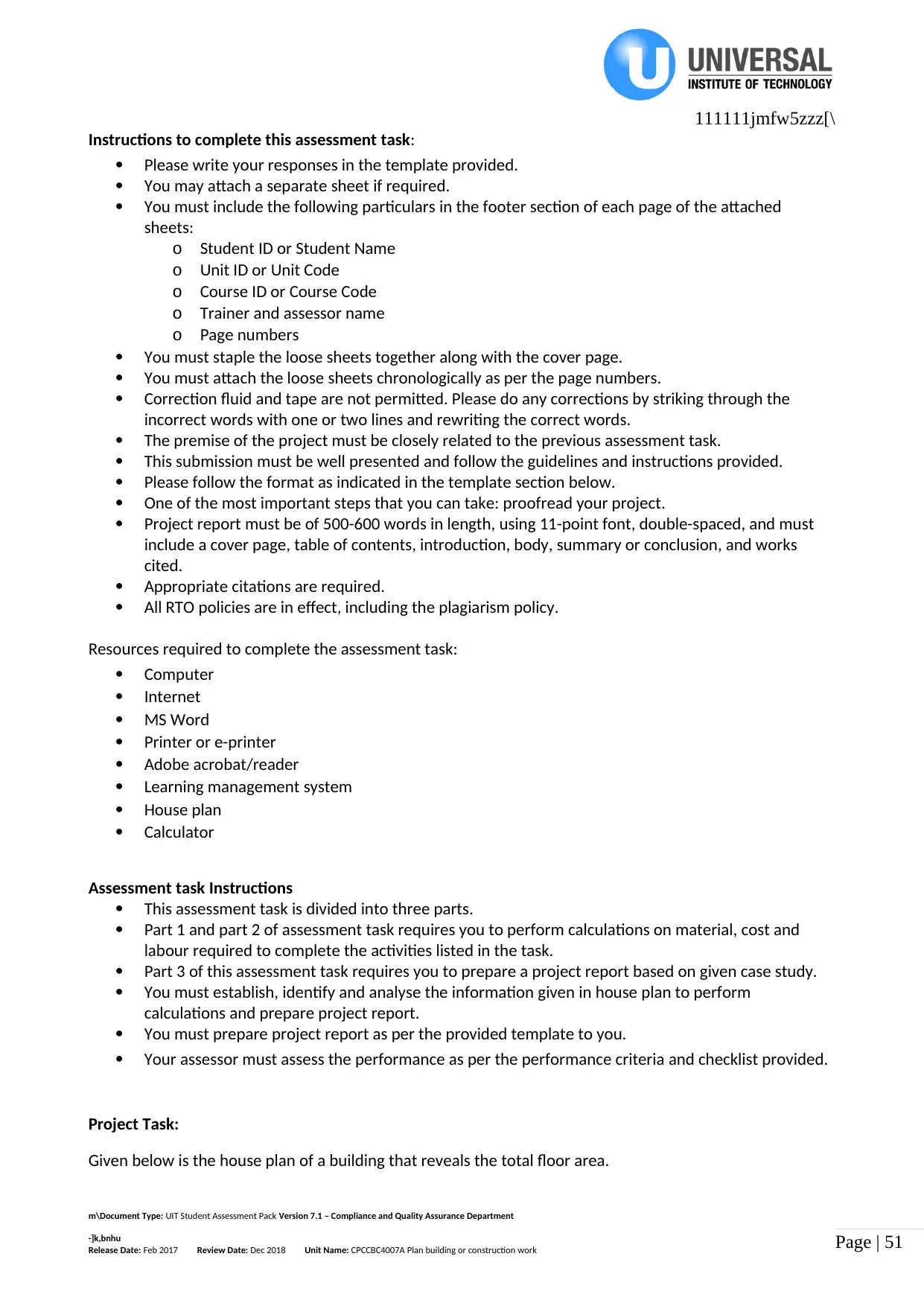
Page | 51
111111jmfw5zzz[\
Instructions to complete this assessment task:
Please write your responses in the template provided.
You may attach a separate sheet if required.
You must include the following particulars in the footer section of each page of the attached
sheets:
o Student ID or Student Name
o Unit ID or Unit Code
o Course ID or Course Code
o Trainer and assessor name
o Page numbers
You must staple the loose sheets together along with the cover page.
You must attach the loose sheets chronologically as per the page numbers.
Correction fluid and tape are not permitted. Please do any corrections by striking through the
incorrect words with one or two lines and rewriting the correct words.
The premise of the project must be closely related to the previous assessment task.
This submission must be well presented and follow the guidelines and instructions provided.
Please follow the format as indicated in the template section below.
One of the most important steps that you can take: proofread your project.
Project report must be of 500-600 words in length, using 11-point font, double-spaced, and must
include a cover page, table of contents, introduction, body, summary or conclusion, and works
cited.
Appropriate citations are required.
All RTO policies are in effect, including the plagiarism policy.
Resources required to complete the assessment task:
Computer
Internet
MS Word
Printer or e-printer
Adobe acrobat/reader
Learning management system
House plan
Calculator
Assessment task Instructions
This assessment task is divided into three parts.
Part 1 and part 2 of assessment task requires you to perform calculations on material, cost and
labour required to complete the activities listed in the task.
Part 3 of this assessment task requires you to prepare a project report based on given case study.
You must establish, identify and analyse the information given in house plan to perform
calculations and prepare project report.
You must prepare project report as per the provided template to you.
Your assessor must assess the performance as per the performance criteria and checklist provided.
Project Task:
Given below is the house plan of a building that reveals the total floor area.
m\Document Type: UIT Student Assessment Pack Version 7.1 – Compliance and Quality Assurance Department
-]k,bnhu
Release Date: Feb 2017 Review Date: Dec 2018 Unit Name: CPCCBC4007A Plan building or construction work
111111jmfw5zzz[\
Instructions to complete this assessment task:
Please write your responses in the template provided.
You may attach a separate sheet if required.
You must include the following particulars in the footer section of each page of the attached
sheets:
o Student ID or Student Name
o Unit ID or Unit Code
o Course ID or Course Code
o Trainer and assessor name
o Page numbers
You must staple the loose sheets together along with the cover page.
You must attach the loose sheets chronologically as per the page numbers.
Correction fluid and tape are not permitted. Please do any corrections by striking through the
incorrect words with one or two lines and rewriting the correct words.
The premise of the project must be closely related to the previous assessment task.
This submission must be well presented and follow the guidelines and instructions provided.
Please follow the format as indicated in the template section below.
One of the most important steps that you can take: proofread your project.
Project report must be of 500-600 words in length, using 11-point font, double-spaced, and must
include a cover page, table of contents, introduction, body, summary or conclusion, and works
cited.
Appropriate citations are required.
All RTO policies are in effect, including the plagiarism policy.
Resources required to complete the assessment task:
Computer
Internet
MS Word
Printer or e-printer
Adobe acrobat/reader
Learning management system
House plan
Calculator
Assessment task Instructions
This assessment task is divided into three parts.
Part 1 and part 2 of assessment task requires you to perform calculations on material, cost and
labour required to complete the activities listed in the task.
Part 3 of this assessment task requires you to prepare a project report based on given case study.
You must establish, identify and analyse the information given in house plan to perform
calculations and prepare project report.
You must prepare project report as per the provided template to you.
Your assessor must assess the performance as per the performance criteria and checklist provided.
Project Task:
Given below is the house plan of a building that reveals the total floor area.
m\Document Type: UIT Student Assessment Pack Version 7.1 – Compliance and Quality Assurance Department
-]k,bnhu
Release Date: Feb 2017 Review Date: Dec 2018 Unit Name: CPCCBC4007A Plan building or construction work

Page | 52
111111jmfw5zzz[\
Part 1:
Based on the above given house plan, you are required to calculate:
1. Quantities of timber to frame the living room shown in the drawing of house plan. This
small brick veneer house is on a concrete slab and has a cement tiled roof.
Note: The door length is included as part of total wall length.
o Calculate the total length of timber that is required to construct the frame for the living
room shown on the plan for:
a. Top and bottom plates
b. Noggings
c. Studs
d. Lintel
o Use the following information and calculate the cost of framing for the living room:
m\Document Type: UIT Student Assessment Pack Version 7.1 – Compliance and Quality Assurance Department
-]k,bnhu
Release Date: Feb 2017 Review Date: Dec 2018 Unit Name: CPCCBC4007A Plan building or construction work
111111jmfw5zzz[\
Part 1:
Based on the above given house plan, you are required to calculate:
1. Quantities of timber to frame the living room shown in the drawing of house plan. This
small brick veneer house is on a concrete slab and has a cement tiled roof.
Note: The door length is included as part of total wall length.
o Calculate the total length of timber that is required to construct the frame for the living
room shown on the plan for:
a. Top and bottom plates
b. Noggings
c. Studs
d. Lintel
o Use the following information and calculate the cost of framing for the living room:
m\Document Type: UIT Student Assessment Pack Version 7.1 – Compliance and Quality Assurance Department
-]k,bnhu
Release Date: Feb 2017 Review Date: Dec 2018 Unit Name: CPCCBC4007A Plan building or construction work
Secure Best Marks with AI Grader
Need help grading? Try our AI Grader for instant feedback on your assignments.
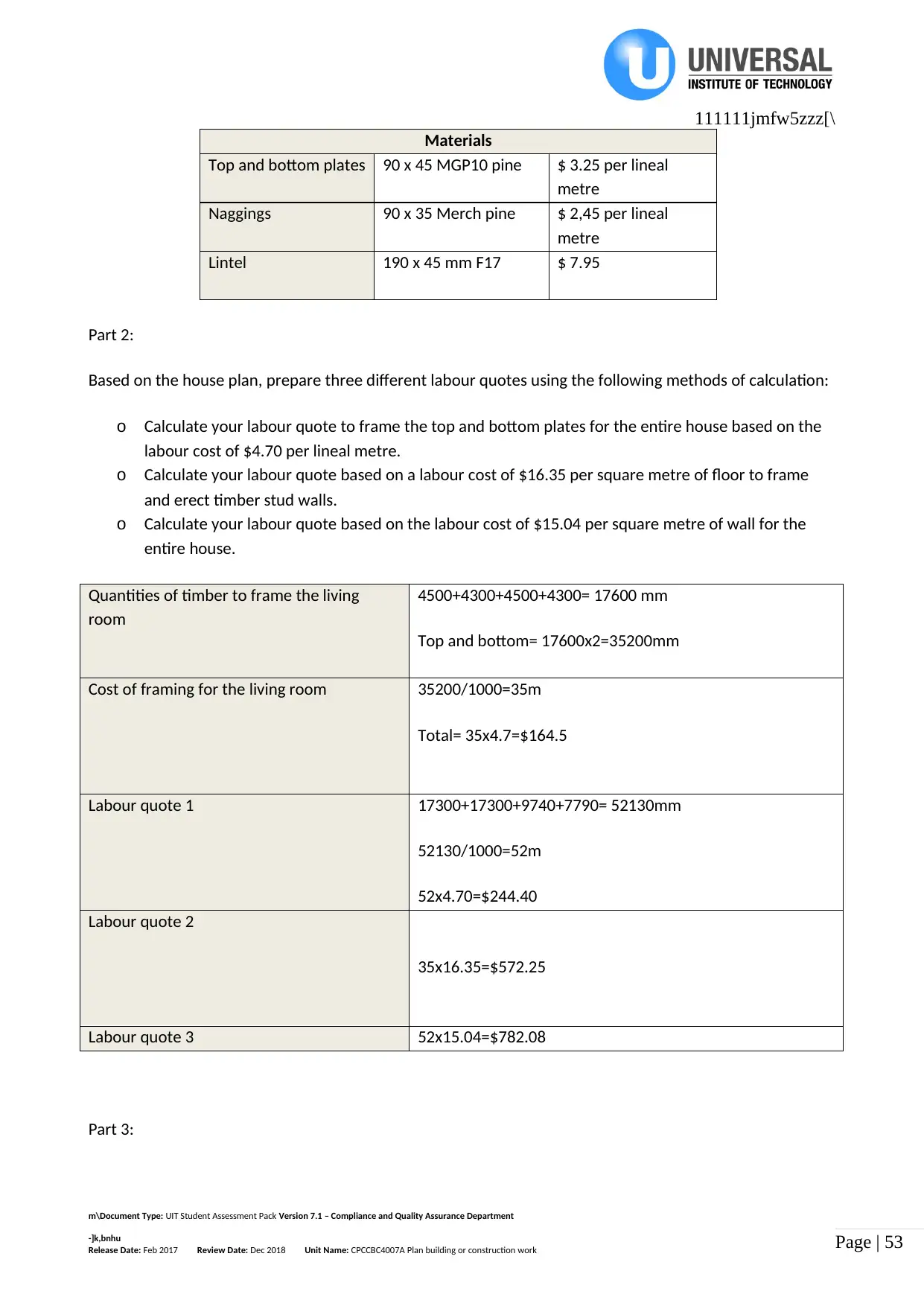
Page | 53
111111jmfw5zzz[\
Materials
Top and bottom plates 90 x 45 MGP10 pine $ 3.25 per lineal
metre
Naggings 90 x 35 Merch pine $ 2,45 per lineal
metre
Lintel 190 x 45 mm F17 $ 7.95
Part 2:
Based on the house plan, prepare three different labour quotes using the following methods of calculation:
o Calculate your labour quote to frame the top and bottom plates for the entire house based on the
labour cost of $4.70 per lineal metre.
o Calculate your labour quote based on a labour cost of $16.35 per square metre of floor to frame
and erect timber stud walls.
o Calculate your labour quote based on the labour cost of $15.04 per square metre of wall for the
entire house.
Quantities of timber to frame the living
room
4500+4300+4500+4300= 17600 mm
Top and bottom= 17600x2=35200mm
Cost of framing for the living room 35200/1000=35m
Total= 35x4.7=$164.5
Labour quote 1 17300+17300+9740+7790= 52130mm
52130/1000=52m
52x4.70=$244.40
Labour quote 2
35x16.35=$572.25
Labour quote 3 52x15.04=$782.08
Part 3:
m\Document Type: UIT Student Assessment Pack Version 7.1 – Compliance and Quality Assurance Department
-]k,bnhu
Release Date: Feb 2017 Review Date: Dec 2018 Unit Name: CPCCBC4007A Plan building or construction work
111111jmfw5zzz[\
Materials
Top and bottom plates 90 x 45 MGP10 pine $ 3.25 per lineal
metre
Naggings 90 x 35 Merch pine $ 2,45 per lineal
metre
Lintel 190 x 45 mm F17 $ 7.95
Part 2:
Based on the house plan, prepare three different labour quotes using the following methods of calculation:
o Calculate your labour quote to frame the top and bottom plates for the entire house based on the
labour cost of $4.70 per lineal metre.
o Calculate your labour quote based on a labour cost of $16.35 per square metre of floor to frame
and erect timber stud walls.
o Calculate your labour quote based on the labour cost of $15.04 per square metre of wall for the
entire house.
Quantities of timber to frame the living
room
4500+4300+4500+4300= 17600 mm
Top and bottom= 17600x2=35200mm
Cost of framing for the living room 35200/1000=35m
Total= 35x4.7=$164.5
Labour quote 1 17300+17300+9740+7790= 52130mm
52130/1000=52m
52x4.70=$244.40
Labour quote 2
35x16.35=$572.25
Labour quote 3 52x15.04=$782.08
Part 3:
m\Document Type: UIT Student Assessment Pack Version 7.1 – Compliance and Quality Assurance Department
-]k,bnhu
Release Date: Feb 2017 Review Date: Dec 2018 Unit Name: CPCCBC4007A Plan building or construction work
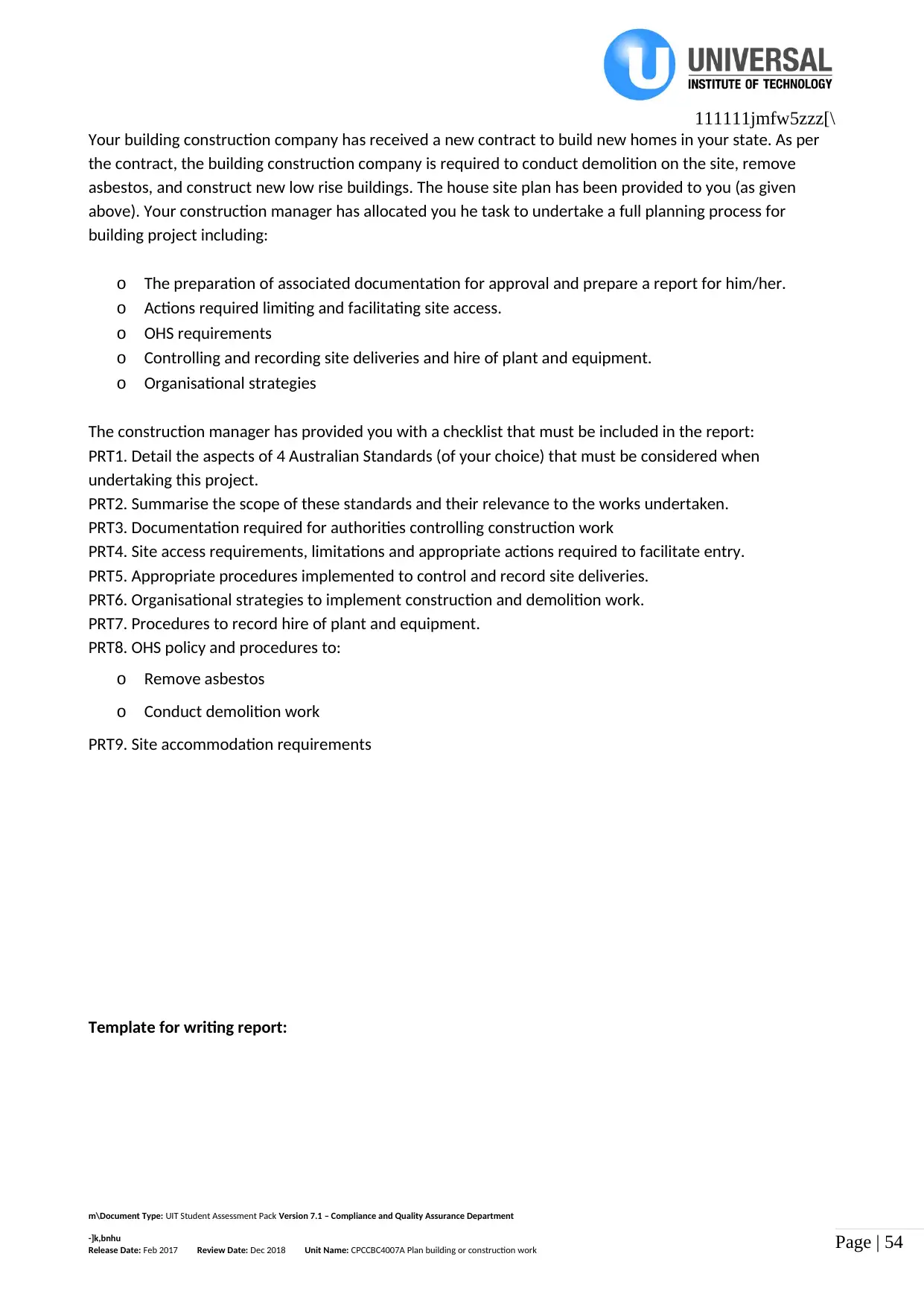
Page | 54
111111jmfw5zzz[\
Your building construction company has received a new contract to build new homes in your state. As per
the contract, the building construction company is required to conduct demolition on the site, remove
asbestos, and construct new low rise buildings. The house site plan has been provided to you (as given
above). Your construction manager has allocated you he task to undertake a full planning process for
building project including:
o The preparation of associated documentation for approval and prepare a report for him/her.
o Actions required limiting and facilitating site access.
o OHS requirements
o Controlling and recording site deliveries and hire of plant and equipment.
o Organisational strategies
The construction manager has provided you with a checklist that must be included in the report:
PRT1. Detail the aspects of 4 Australian Standards (of your choice) that must be considered when
undertaking this project.
PRT2. Summarise the scope of these standards and their relevance to the works undertaken.
PRT3. Documentation required for authorities controlling construction work
PRT4. Site access requirements, limitations and appropriate actions required to facilitate entry.
PRT5. Appropriate procedures implemented to control and record site deliveries.
PRT6. Organisational strategies to implement construction and demolition work.
PRT7. Procedures to record hire of plant and equipment.
PRT8. OHS policy and procedures to:
o Remove asbestos
o Conduct demolition work
PRT9. Site accommodation requirements
Template for writing report:
m\Document Type: UIT Student Assessment Pack Version 7.1 – Compliance and Quality Assurance Department
-]k,bnhu
Release Date: Feb 2017 Review Date: Dec 2018 Unit Name: CPCCBC4007A Plan building or construction work
111111jmfw5zzz[\
Your building construction company has received a new contract to build new homes in your state. As per
the contract, the building construction company is required to conduct demolition on the site, remove
asbestos, and construct new low rise buildings. The house site plan has been provided to you (as given
above). Your construction manager has allocated you he task to undertake a full planning process for
building project including:
o The preparation of associated documentation for approval and prepare a report for him/her.
o Actions required limiting and facilitating site access.
o OHS requirements
o Controlling and recording site deliveries and hire of plant and equipment.
o Organisational strategies
The construction manager has provided you with a checklist that must be included in the report:
PRT1. Detail the aspects of 4 Australian Standards (of your choice) that must be considered when
undertaking this project.
PRT2. Summarise the scope of these standards and their relevance to the works undertaken.
PRT3. Documentation required for authorities controlling construction work
PRT4. Site access requirements, limitations and appropriate actions required to facilitate entry.
PRT5. Appropriate procedures implemented to control and record site deliveries.
PRT6. Organisational strategies to implement construction and demolition work.
PRT7. Procedures to record hire of plant and equipment.
PRT8. OHS policy and procedures to:
o Remove asbestos
o Conduct demolition work
PRT9. Site accommodation requirements
Template for writing report:
m\Document Type: UIT Student Assessment Pack Version 7.1 – Compliance and Quality Assurance Department
-]k,bnhu
Release Date: Feb 2017 Review Date: Dec 2018 Unit Name: CPCCBC4007A Plan building or construction work
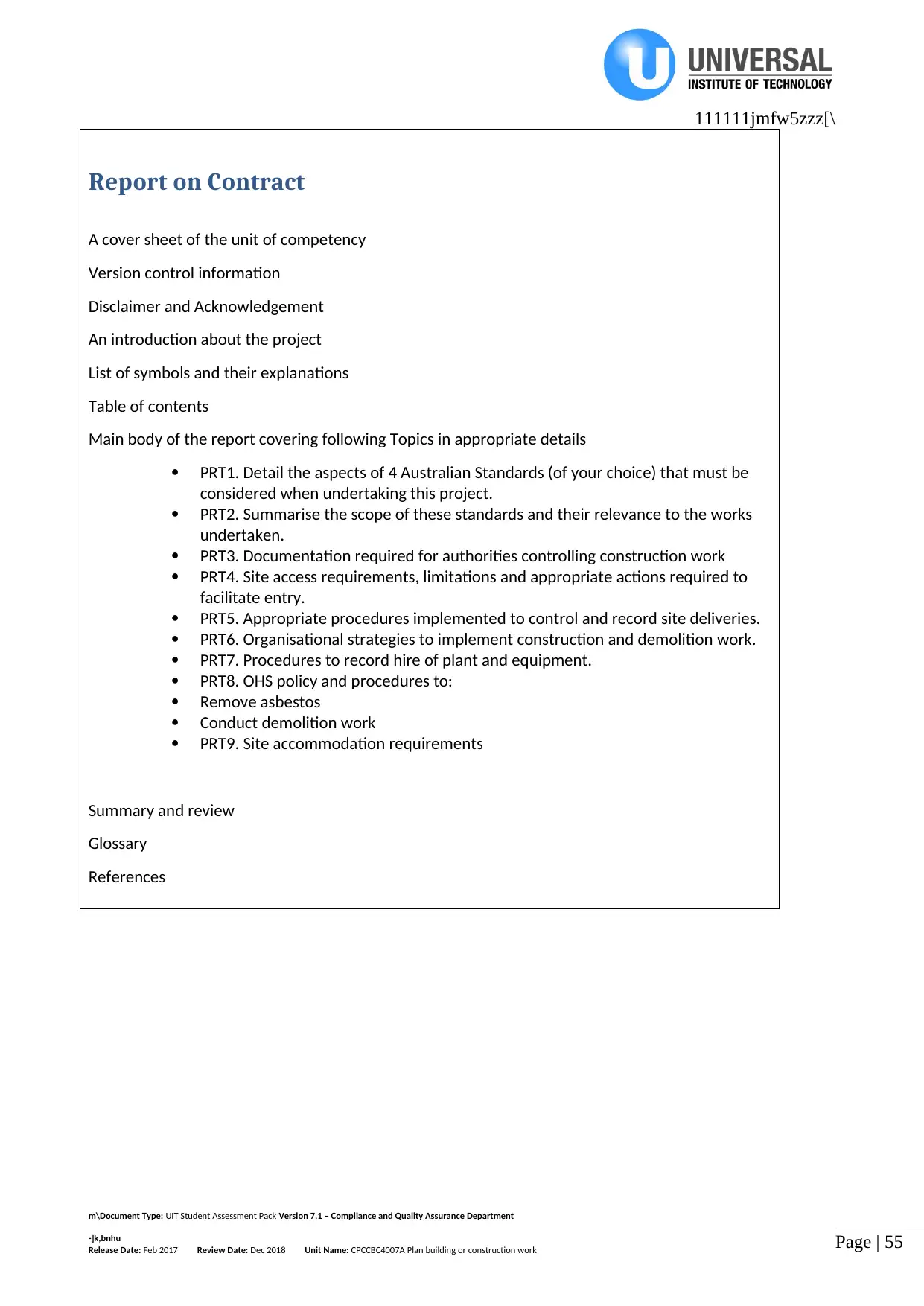
Page | 55
111111jmfw5zzz[\
Report on Contract
A cover sheet of the unit of competency
Version control information
Disclaimer and Acknowledgement
An introduction about the project
List of symbols and their explanations
Table of contents
Main body of the report covering following Topics in appropriate details
PRT1. Detail the aspects of 4 Australian Standards (of your choice) that must be
considered when undertaking this project.
PRT2. Summarise the scope of these standards and their relevance to the works
undertaken.
PRT3. Documentation required for authorities controlling construction work
PRT4. Site access requirements, limitations and appropriate actions required to
facilitate entry.
PRT5. Appropriate procedures implemented to control and record site deliveries.
PRT6. Organisational strategies to implement construction and demolition work.
PRT7. Procedures to record hire of plant and equipment.
PRT8. OHS policy and procedures to:
Remove asbestos
Conduct demolition work
PRT9. Site accommodation requirements
Summary and review
Glossary
References
m\Document Type: UIT Student Assessment Pack Version 7.1 – Compliance and Quality Assurance Department
-]k,bnhu
Release Date: Feb 2017 Review Date: Dec 2018 Unit Name: CPCCBC4007A Plan building or construction work
111111jmfw5zzz[\
Report on Contract
A cover sheet of the unit of competency
Version control information
Disclaimer and Acknowledgement
An introduction about the project
List of symbols and their explanations
Table of contents
Main body of the report covering following Topics in appropriate details
PRT1. Detail the aspects of 4 Australian Standards (of your choice) that must be
considered when undertaking this project.
PRT2. Summarise the scope of these standards and their relevance to the works
undertaken.
PRT3. Documentation required for authorities controlling construction work
PRT4. Site access requirements, limitations and appropriate actions required to
facilitate entry.
PRT5. Appropriate procedures implemented to control and record site deliveries.
PRT6. Organisational strategies to implement construction and demolition work.
PRT7. Procedures to record hire of plant and equipment.
PRT8. OHS policy and procedures to:
Remove asbestos
Conduct demolition work
PRT9. Site accommodation requirements
Summary and review
Glossary
References
m\Document Type: UIT Student Assessment Pack Version 7.1 – Compliance and Quality Assurance Department
-]k,bnhu
Release Date: Feb 2017 Review Date: Dec 2018 Unit Name: CPCCBC4007A Plan building or construction work
Paraphrase This Document
Need a fresh take? Get an instant paraphrase of this document with our AI Paraphraser
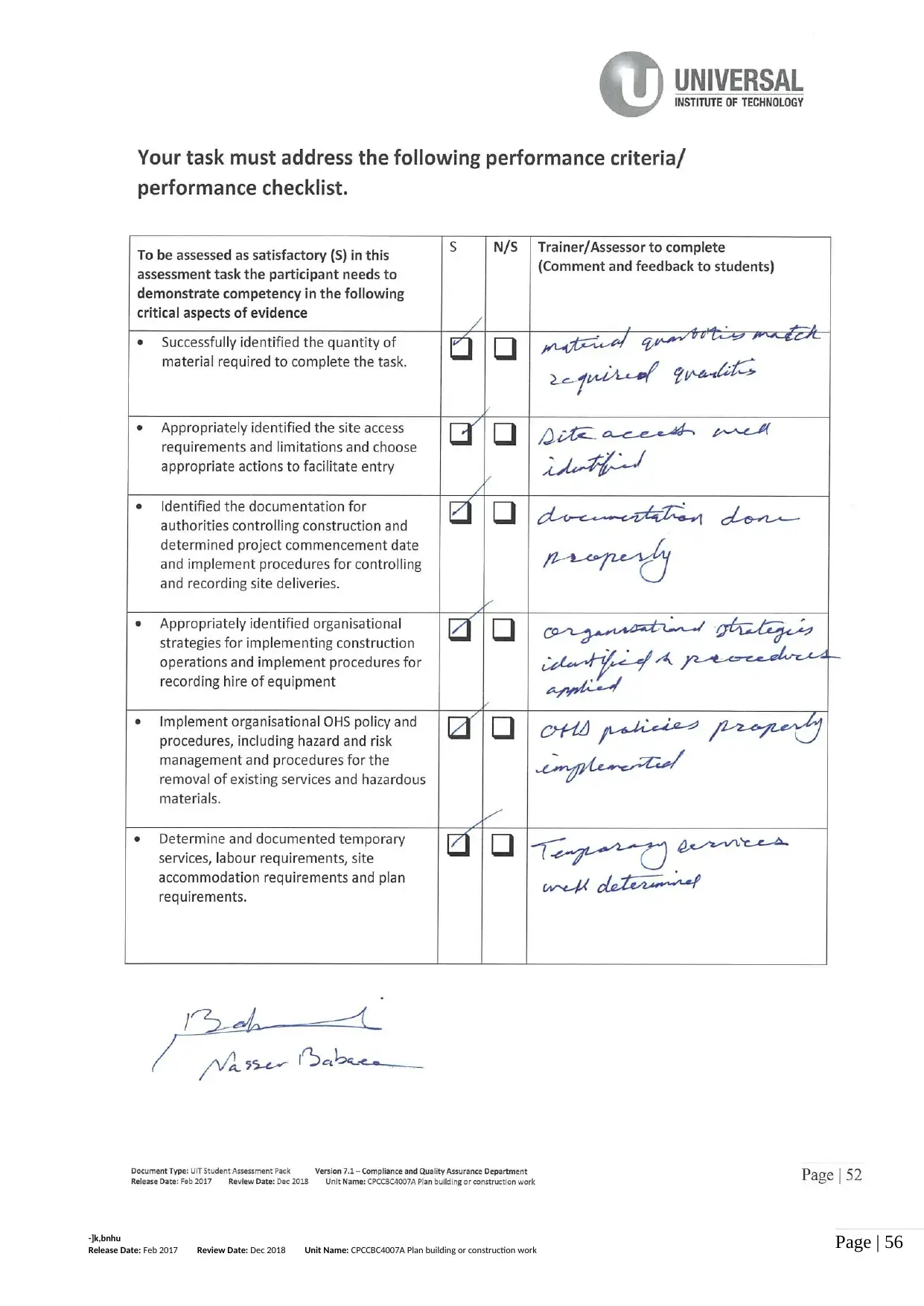
Page | 56
111111jmfw5zzz[\
m\Document Type: UIT Student Assessment Pack Version 7.1 – Compliance and Quality Assurance Department
-]k,bnhu
Release Date: Feb 2017 Review Date: Dec 2018 Unit Name: CPCCBC4007A Plan building or construction work
111111jmfw5zzz[\
m\Document Type: UIT Student Assessment Pack Version 7.1 – Compliance and Quality Assurance Department
-]k,bnhu
Release Date: Feb 2017 Review Date: Dec 2018 Unit Name: CPCCBC4007A Plan building or construction work

Page | 57
111111jmfw5zzz[\
Unit Assessment Result Sheet (UARS)
Assessment Task 3 – Unit Project (UP)
Student and Trainer/Assessor Details
Unit code CPCCBC4007A
Unit name Plan building or construction work
Outcome of Unit
Assessment Task (UAT)
First attempt:
Outcome (please make sure to tick the correct checkbox):
Satisfactory (S) ☐ or Not Satisfactory (NS) ☒
Date: __08___(day)/ __08__(month)/ __2018____(year)
Second attempt:
Outcome (please make sure to tick the correct checkbox):
Satisfactory (S) ☐ or Not Satisfactory (NS) ☐
Date: _______(day)/ _______(month)/ ____________(year)
Feedback to Student First attempt:
INCOMPLETE
Second attempt:
Student Declaration I declare that the answers I have provided are my own work.
Where I have accessed information from other sources, I have
provided references and or links to my sources.
I have kept a copy of all relevant notes and reference material
that I used as part of my submission.
I have provided references for all sources where the
information is not my own. I understand the consequences of
falsifying documentation and plagiarism. I understand how
the assessment is structured. I accept that all work I submit
must be verifiable as my own.
I understand that if I disagree with the assessment outcome, I
can appeal the assessment process, and either re-submit
additional evidence undertake gap training and or have my
m\Document Type: UIT Student Assessment Pack Version 7.1 – Compliance and Quality Assurance Department
-]k,bnhu
Release Date: Feb 2017 Review Date: Dec 2018 Unit Name: CPCCBC4007A Plan building or construction work
111111jmfw5zzz[\
Unit Assessment Result Sheet (UARS)
Assessment Task 3 – Unit Project (UP)
Student and Trainer/Assessor Details
Unit code CPCCBC4007A
Unit name Plan building or construction work
Outcome of Unit
Assessment Task (UAT)
First attempt:
Outcome (please make sure to tick the correct checkbox):
Satisfactory (S) ☐ or Not Satisfactory (NS) ☒
Date: __08___(day)/ __08__(month)/ __2018____(year)
Second attempt:
Outcome (please make sure to tick the correct checkbox):
Satisfactory (S) ☐ or Not Satisfactory (NS) ☐
Date: _______(day)/ _______(month)/ ____________(year)
Feedback to Student First attempt:
INCOMPLETE
Second attempt:
Student Declaration I declare that the answers I have provided are my own work.
Where I have accessed information from other sources, I have
provided references and or links to my sources.
I have kept a copy of all relevant notes and reference material
that I used as part of my submission.
I have provided references for all sources where the
information is not my own. I understand the consequences of
falsifying documentation and plagiarism. I understand how
the assessment is structured. I accept that all work I submit
must be verifiable as my own.
I understand that if I disagree with the assessment outcome, I
can appeal the assessment process, and either re-submit
additional evidence undertake gap training and or have my
m\Document Type: UIT Student Assessment Pack Version 7.1 – Compliance and Quality Assurance Department
-]k,bnhu
Release Date: Feb 2017 Review Date: Dec 2018 Unit Name: CPCCBC4007A Plan building or construction work
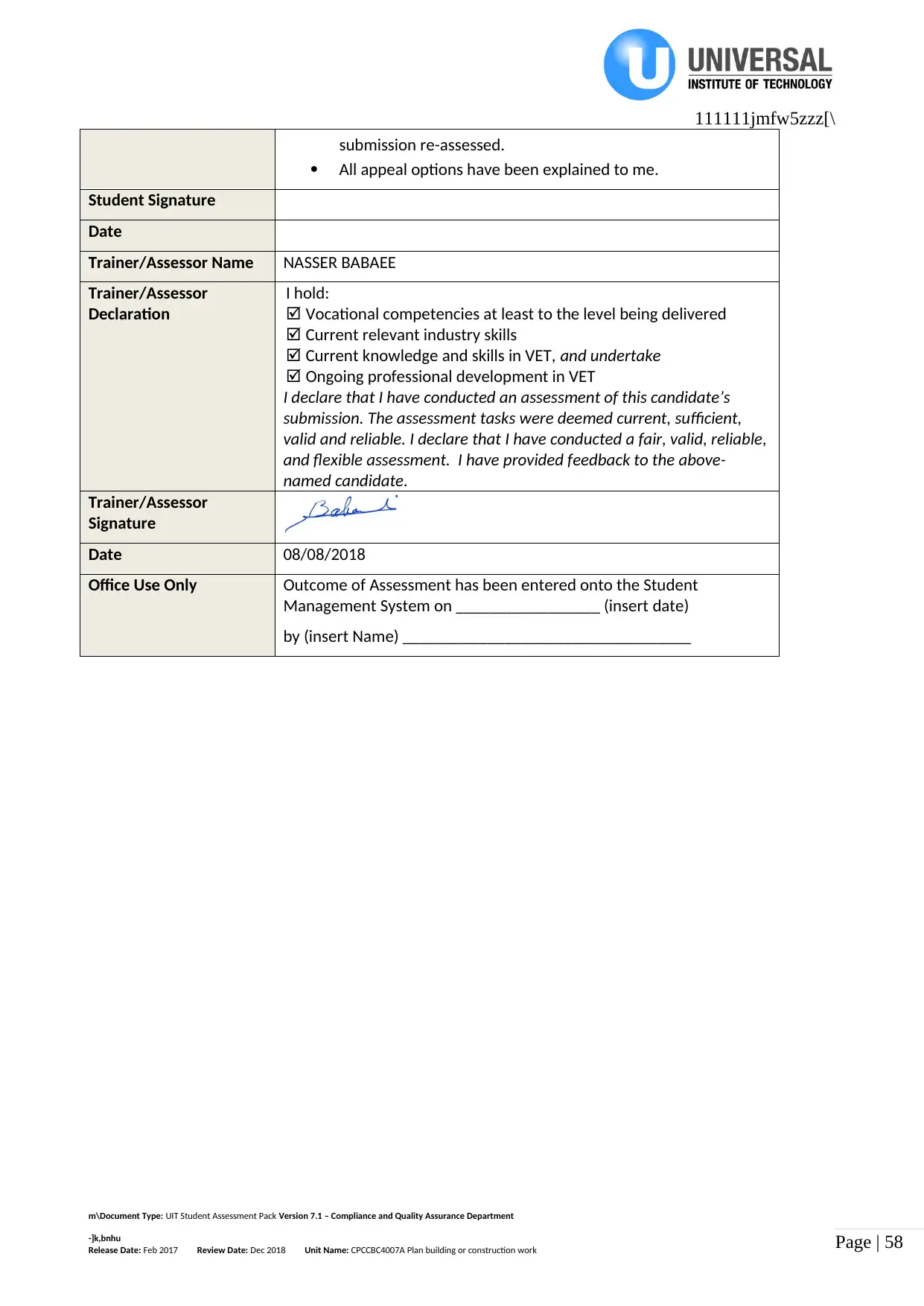
Page | 58
111111jmfw5zzz[\
submission re-assessed.
All appeal options have been explained to me.
Student Signature
Date
Trainer/Assessor Name NASSER BABAEE
Trainer/Assessor
Declaration
I hold:
Vocational competencies at least to the level being delivered
Current relevant industry skills
Current knowledge and skills in VET, and undertake
Ongoing professional development in VET
I declare that I have conducted an assessment of this candidate’s
submission. The assessment tasks were deemed current, sufficient,
valid and reliable. I declare that I have conducted a fair, valid, reliable,
and flexible assessment. I have provided feedback to the above-
named candidate.
Trainer/Assessor
Signature
Date 08/08/2018
Office Use Only Outcome of Assessment has been entered onto the Student
Management System on _________________ (insert date)
by (insert Name) __________________________________
m\Document Type: UIT Student Assessment Pack Version 7.1 – Compliance and Quality Assurance Department
-]k,bnhu
Release Date: Feb 2017 Review Date: Dec 2018 Unit Name: CPCCBC4007A Plan building or construction work
111111jmfw5zzz[\
submission re-assessed.
All appeal options have been explained to me.
Student Signature
Date
Trainer/Assessor Name NASSER BABAEE
Trainer/Assessor
Declaration
I hold:
Vocational competencies at least to the level being delivered
Current relevant industry skills
Current knowledge and skills in VET, and undertake
Ongoing professional development in VET
I declare that I have conducted an assessment of this candidate’s
submission. The assessment tasks were deemed current, sufficient,
valid and reliable. I declare that I have conducted a fair, valid, reliable,
and flexible assessment. I have provided feedback to the above-
named candidate.
Trainer/Assessor
Signature
Date 08/08/2018
Office Use Only Outcome of Assessment has been entered onto the Student
Management System on _________________ (insert date)
by (insert Name) __________________________________
m\Document Type: UIT Student Assessment Pack Version 7.1 – Compliance and Quality Assurance Department
-]k,bnhu
Release Date: Feb 2017 Review Date: Dec 2018 Unit Name: CPCCBC4007A Plan building or construction work
Secure Best Marks with AI Grader
Need help grading? Try our AI Grader for instant feedback on your assignments.
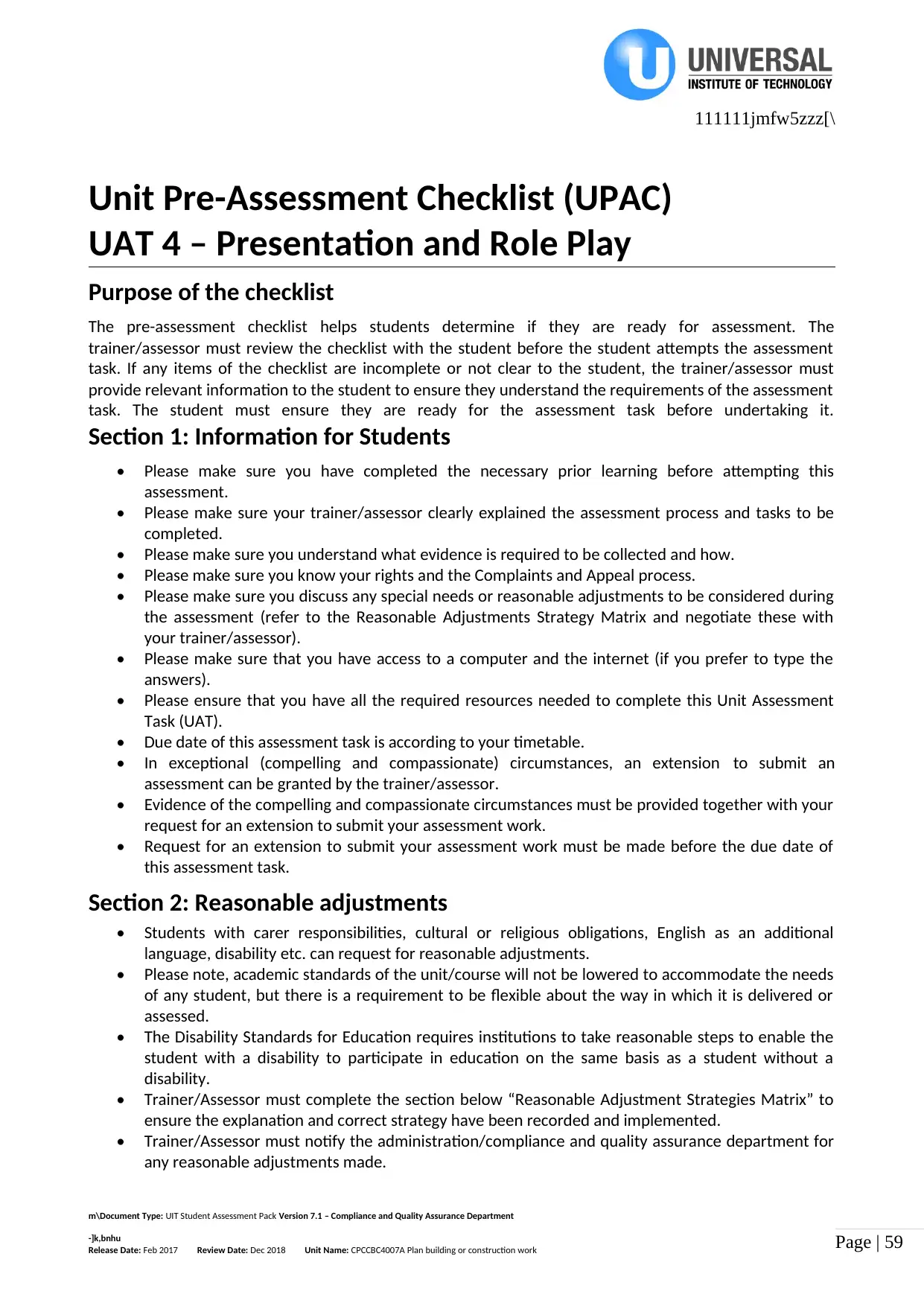
Page | 59
111111jmfw5zzz[\
Unit Pre-Assessment Checklist (UPAC)
UAT 4 – Presentation and Role Play
Purpose of the checklist
The pre-assessment checklist helps students determine if they are ready for assessment. The
trainer/assessor must review the checklist with the student before the student attempts the assessment
task. If any items of the checklist are incomplete or not clear to the student, the trainer/assessor must
provide relevant information to the student to ensure they understand the requirements of the assessment
task. The student must ensure they are ready for the assessment task before undertaking it.
Section 1: Information for Students
• Please make sure you have completed the necessary prior learning before attempting this
assessment.
• Please make sure your trainer/assessor clearly explained the assessment process and tasks to be
completed.
• Please make sure you understand what evidence is required to be collected and how.
• Please make sure you know your rights and the Complaints and Appeal process.
• Please make sure you discuss any special needs or reasonable adjustments to be considered during
the assessment (refer to the Reasonable Adjustments Strategy Matrix and negotiate these with
your trainer/assessor).
• Please make sure that you have access to a computer and the internet (if you prefer to type the
answers).
• Please ensure that you have all the required resources needed to complete this Unit Assessment
Task (UAT).
• Due date of this assessment task is according to your timetable.
• In exceptional (compelling and compassionate) circumstances, an extension to submit an
assessment can be granted by the trainer/assessor.
• Evidence of the compelling and compassionate circumstances must be provided together with your
request for an extension to submit your assessment work.
• Request for an extension to submit your assessment work must be made before the due date of
this assessment task.
Section 2: Reasonable adjustments
• Students with carer responsibilities, cultural or religious obligations, English as an additional
language, disability etc. can request for reasonable adjustments.
• Please note, academic standards of the unit/course will not be lowered to accommodate the needs
of any student, but there is a requirement to be flexible about the way in which it is delivered or
assessed.
• The Disability Standards for Education requires institutions to take reasonable steps to enable the
student with a disability to participate in education on the same basis as a student without a
disability.
• Trainer/Assessor must complete the section below “Reasonable Adjustment Strategies Matrix” to
ensure the explanation and correct strategy have been recorded and implemented.
• Trainer/Assessor must notify the administration/compliance and quality assurance department for
any reasonable adjustments made.
m\Document Type: UIT Student Assessment Pack Version 7.1 – Compliance and Quality Assurance Department
-]k,bnhu
Release Date: Feb 2017 Review Date: Dec 2018 Unit Name: CPCCBC4007A Plan building or construction work
111111jmfw5zzz[\
Unit Pre-Assessment Checklist (UPAC)
UAT 4 – Presentation and Role Play
Purpose of the checklist
The pre-assessment checklist helps students determine if they are ready for assessment. The
trainer/assessor must review the checklist with the student before the student attempts the assessment
task. If any items of the checklist are incomplete or not clear to the student, the trainer/assessor must
provide relevant information to the student to ensure they understand the requirements of the assessment
task. The student must ensure they are ready for the assessment task before undertaking it.
Section 1: Information for Students
• Please make sure you have completed the necessary prior learning before attempting this
assessment.
• Please make sure your trainer/assessor clearly explained the assessment process and tasks to be
completed.
• Please make sure you understand what evidence is required to be collected and how.
• Please make sure you know your rights and the Complaints and Appeal process.
• Please make sure you discuss any special needs or reasonable adjustments to be considered during
the assessment (refer to the Reasonable Adjustments Strategy Matrix and negotiate these with
your trainer/assessor).
• Please make sure that you have access to a computer and the internet (if you prefer to type the
answers).
• Please ensure that you have all the required resources needed to complete this Unit Assessment
Task (UAT).
• Due date of this assessment task is according to your timetable.
• In exceptional (compelling and compassionate) circumstances, an extension to submit an
assessment can be granted by the trainer/assessor.
• Evidence of the compelling and compassionate circumstances must be provided together with your
request for an extension to submit your assessment work.
• Request for an extension to submit your assessment work must be made before the due date of
this assessment task.
Section 2: Reasonable adjustments
• Students with carer responsibilities, cultural or religious obligations, English as an additional
language, disability etc. can request for reasonable adjustments.
• Please note, academic standards of the unit/course will not be lowered to accommodate the needs
of any student, but there is a requirement to be flexible about the way in which it is delivered or
assessed.
• The Disability Standards for Education requires institutions to take reasonable steps to enable the
student with a disability to participate in education on the same basis as a student without a
disability.
• Trainer/Assessor must complete the section below “Reasonable Adjustment Strategies Matrix” to
ensure the explanation and correct strategy have been recorded and implemented.
• Trainer/Assessor must notify the administration/compliance and quality assurance department for
any reasonable adjustments made.
m\Document Type: UIT Student Assessment Pack Version 7.1 – Compliance and Quality Assurance Department
-]k,bnhu
Release Date: Feb 2017 Review Date: Dec 2018 Unit Name: CPCCBC4007A Plan building or construction work
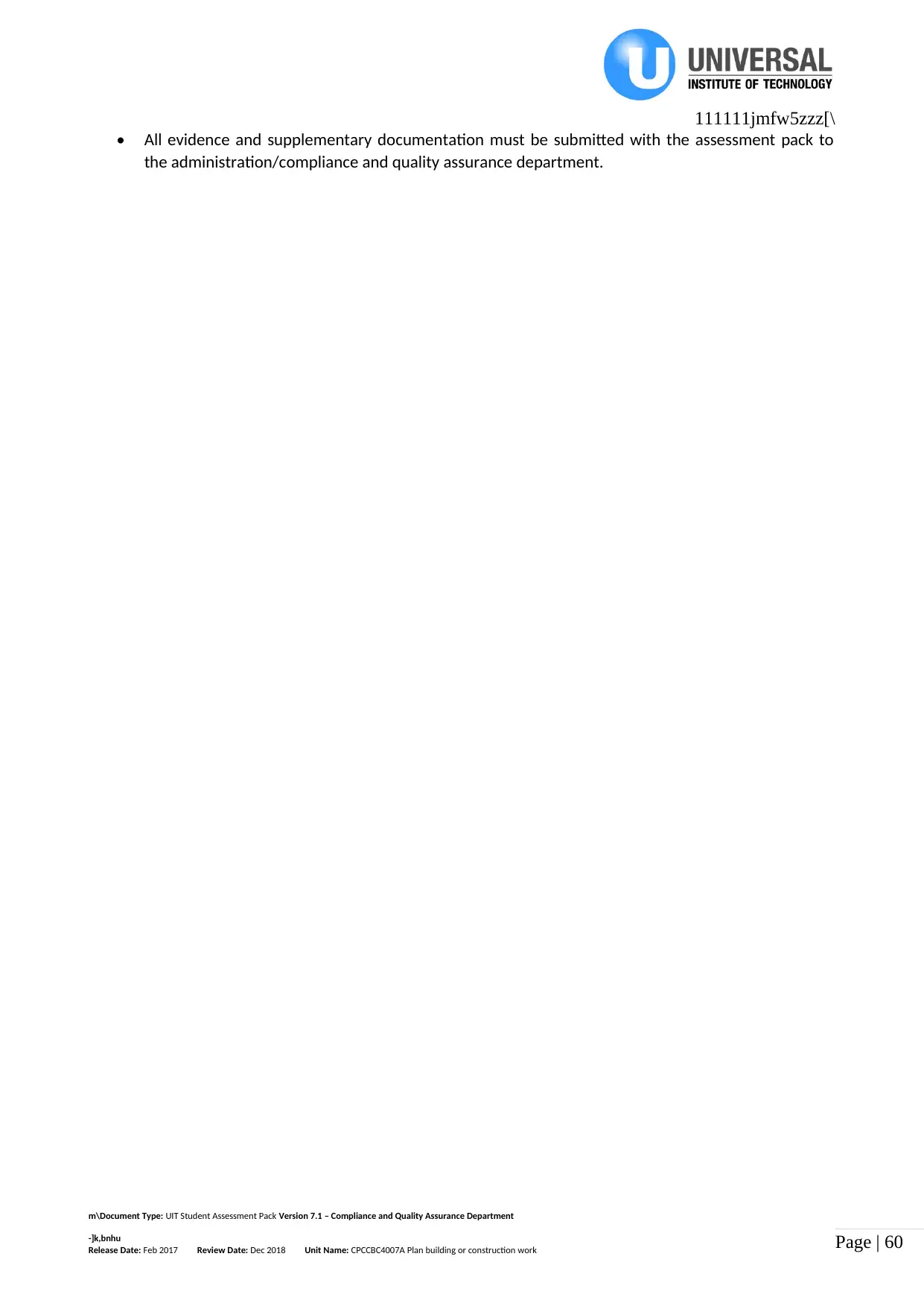
Page | 60
111111jmfw5zzz[\
• All evidence and supplementary documentation must be submitted with the assessment pack to
the administration/compliance and quality assurance department.
m\Document Type: UIT Student Assessment Pack Version 7.1 – Compliance and Quality Assurance Department
-]k,bnhu
Release Date: Feb 2017 Review Date: Dec 2018 Unit Name: CPCCBC4007A Plan building or construction work
111111jmfw5zzz[\
• All evidence and supplementary documentation must be submitted with the assessment pack to
the administration/compliance and quality assurance department.
m\Document Type: UIT Student Assessment Pack Version 7.1 – Compliance and Quality Assurance Department
-]k,bnhu
Release Date: Feb 2017 Review Date: Dec 2018 Unit Name: CPCCBC4007A Plan building or construction work
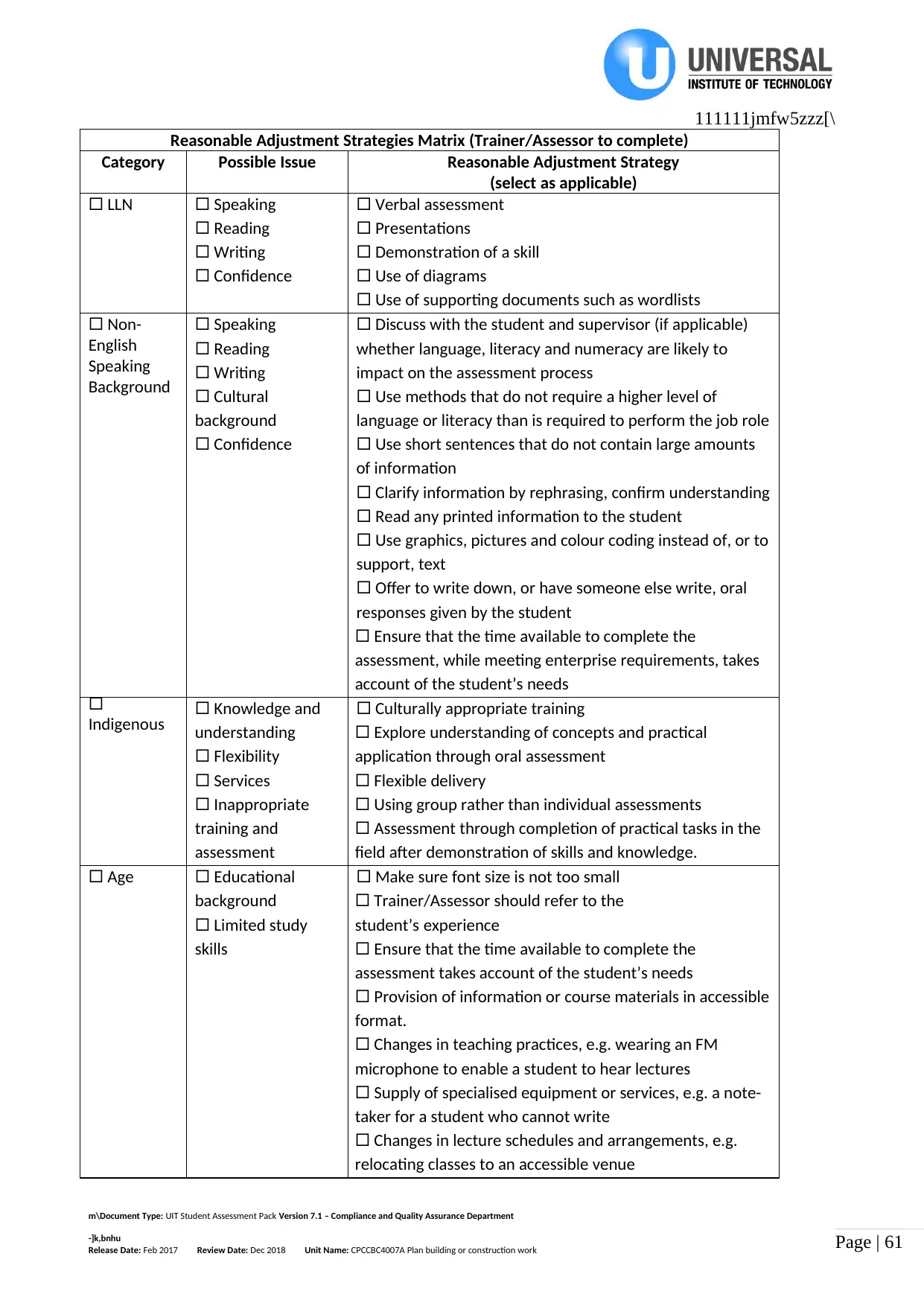
Page | 61
111111jmfw5zzz[\
Reasonable Adjustment Strategies Matrix (Trainer/Assessor to complete)
Category Possible Issue Reasonable Adjustment Strategy
(select as applicable)
LLN Speaking
Reading
Writing
Confidence
Verbal assessment
Presentations
Demonstration of a skill
Use of diagrams
Use of supporting documents such as wordlists
Non-
English
Speaking
Background
Speaking
Reading
Writing
Cultural
background
Confidence
Discuss with the student and supervisor (if applicable)
whether language, literacy and numeracy are likely to
impact on the assessment process
Use methods that do not require a higher level of
language or literacy than is required to perform the job role
Use short sentences that do not contain large amounts
of information
Clarify information by rephrasing, confirm understanding
Read any printed information to the student
Use graphics, pictures and colour coding instead of, or to
support, text
Offer to write down, or have someone else write, oral
responses given by the student
Ensure that the time available to complete the
assessment, while meeting enterprise requirements, takes
account of the student’s needs
Indigenous Knowledge and
understanding
Flexibility
Services
Inappropriate
training and
assessment
Culturally appropriate training
Explore understanding of concepts and practical
application through oral assessment
Flexible delivery
Using group rather than individual assessments
Assessment through completion of practical tasks in the
field after demonstration of skills and knowledge.
Age Educational
background
Limited study
skills
Make sure font size is not too small
Trainer/Assessor should refer to the
student’s experience
Ensure that the time available to complete the
assessment takes account of the student’s needs
Provision of information or course materials in accessible
format.
Changes in teaching practices, e.g. wearing an FM
microphone to enable a student to hear lectures
Supply of specialised equipment or services, e.g. a note-
taker for a student who cannot write
Changes in lecture schedules and arrangements, e.g.
relocating classes to an accessible venue
m\Document Type: UIT Student Assessment Pack Version 7.1 – Compliance and Quality Assurance Department
-]k,bnhu
Release Date: Feb 2017 Review Date: Dec 2018 Unit Name: CPCCBC4007A Plan building or construction work
111111jmfw5zzz[\
Reasonable Adjustment Strategies Matrix (Trainer/Assessor to complete)
Category Possible Issue Reasonable Adjustment Strategy
(select as applicable)
LLN Speaking
Reading
Writing
Confidence
Verbal assessment
Presentations
Demonstration of a skill
Use of diagrams
Use of supporting documents such as wordlists
Non-
English
Speaking
Background
Speaking
Reading
Writing
Cultural
background
Confidence
Discuss with the student and supervisor (if applicable)
whether language, literacy and numeracy are likely to
impact on the assessment process
Use methods that do not require a higher level of
language or literacy than is required to perform the job role
Use short sentences that do not contain large amounts
of information
Clarify information by rephrasing, confirm understanding
Read any printed information to the student
Use graphics, pictures and colour coding instead of, or to
support, text
Offer to write down, or have someone else write, oral
responses given by the student
Ensure that the time available to complete the
assessment, while meeting enterprise requirements, takes
account of the student’s needs
Indigenous Knowledge and
understanding
Flexibility
Services
Inappropriate
training and
assessment
Culturally appropriate training
Explore understanding of concepts and practical
application through oral assessment
Flexible delivery
Using group rather than individual assessments
Assessment through completion of practical tasks in the
field after demonstration of skills and knowledge.
Age Educational
background
Limited study
skills
Make sure font size is not too small
Trainer/Assessor should refer to the
student’s experience
Ensure that the time available to complete the
assessment takes account of the student’s needs
Provision of information or course materials in accessible
format.
Changes in teaching practices, e.g. wearing an FM
microphone to enable a student to hear lectures
Supply of specialised equipment or services, e.g. a note-
taker for a student who cannot write
Changes in lecture schedules and arrangements, e.g.
relocating classes to an accessible venue
m\Document Type: UIT Student Assessment Pack Version 7.1 – Compliance and Quality Assurance Department
-]k,bnhu
Release Date: Feb 2017 Review Date: Dec 2018 Unit Name: CPCCBC4007A Plan building or construction work
Paraphrase This Document
Need a fresh take? Get an instant paraphrase of this document with our AI Paraphraser
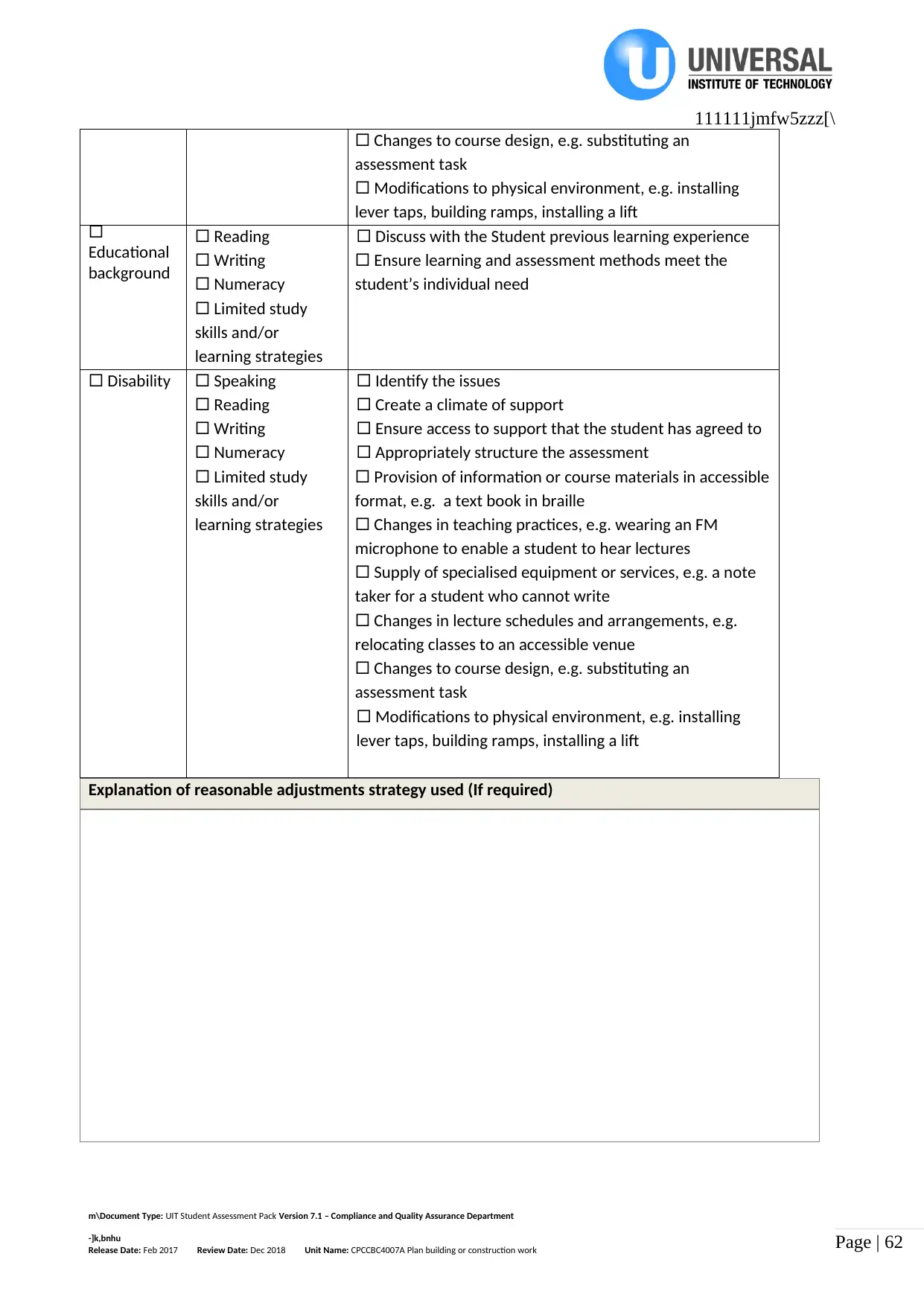
Page | 62
111111jmfw5zzz[\
Changes to course design, e.g. substituting an
assessment task
Modifications to physical environment, e.g. installing
lever taps, building ramps, installing a lift
Educational
background
Reading
Writing
Numeracy
Limited study
skills and/or
learning strategies
Discuss with the Student previous learning experience
Ensure learning and assessment methods meet the
student’s individual need
Disability Speaking
Reading
Writing
Numeracy
Limited study
skills and/or
learning strategies
Identify the issues
Create a climate of support
Ensure access to support that the student has agreed to
Appropriately structure the assessment
Provision of information or course materials in accessible
format, e.g. a text book in braille
Changes in teaching practices, e.g. wearing an FM
microphone to enable a student to hear lectures
Supply of specialised equipment or services, e.g. a note
taker for a student who cannot write
Changes in lecture schedules and arrangements, e.g.
relocating classes to an accessible venue
Changes to course design, e.g. substituting an
assessment task
Modifications to physical environment, e.g. installing
lever taps, building ramps, installing a lift
Explanation of reasonable adjustments strategy used (If required)
m\Document Type: UIT Student Assessment Pack Version 7.1 – Compliance and Quality Assurance Department
-]k,bnhu
Release Date: Feb 2017 Review Date: Dec 2018 Unit Name: CPCCBC4007A Plan building or construction work
111111jmfw5zzz[\
Changes to course design, e.g. substituting an
assessment task
Modifications to physical environment, e.g. installing
lever taps, building ramps, installing a lift
Educational
background
Reading
Writing
Numeracy
Limited study
skills and/or
learning strategies
Discuss with the Student previous learning experience
Ensure learning and assessment methods meet the
student’s individual need
Disability Speaking
Reading
Writing
Numeracy
Limited study
skills and/or
learning strategies
Identify the issues
Create a climate of support
Ensure access to support that the student has agreed to
Appropriately structure the assessment
Provision of information or course materials in accessible
format, e.g. a text book in braille
Changes in teaching practices, e.g. wearing an FM
microphone to enable a student to hear lectures
Supply of specialised equipment or services, e.g. a note
taker for a student who cannot write
Changes in lecture schedules and arrangements, e.g.
relocating classes to an accessible venue
Changes to course design, e.g. substituting an
assessment task
Modifications to physical environment, e.g. installing
lever taps, building ramps, installing a lift
Explanation of reasonable adjustments strategy used (If required)
m\Document Type: UIT Student Assessment Pack Version 7.1 – Compliance and Quality Assurance Department
-]k,bnhu
Release Date: Feb 2017 Review Date: Dec 2018 Unit Name: CPCCBC4007A Plan building or construction work
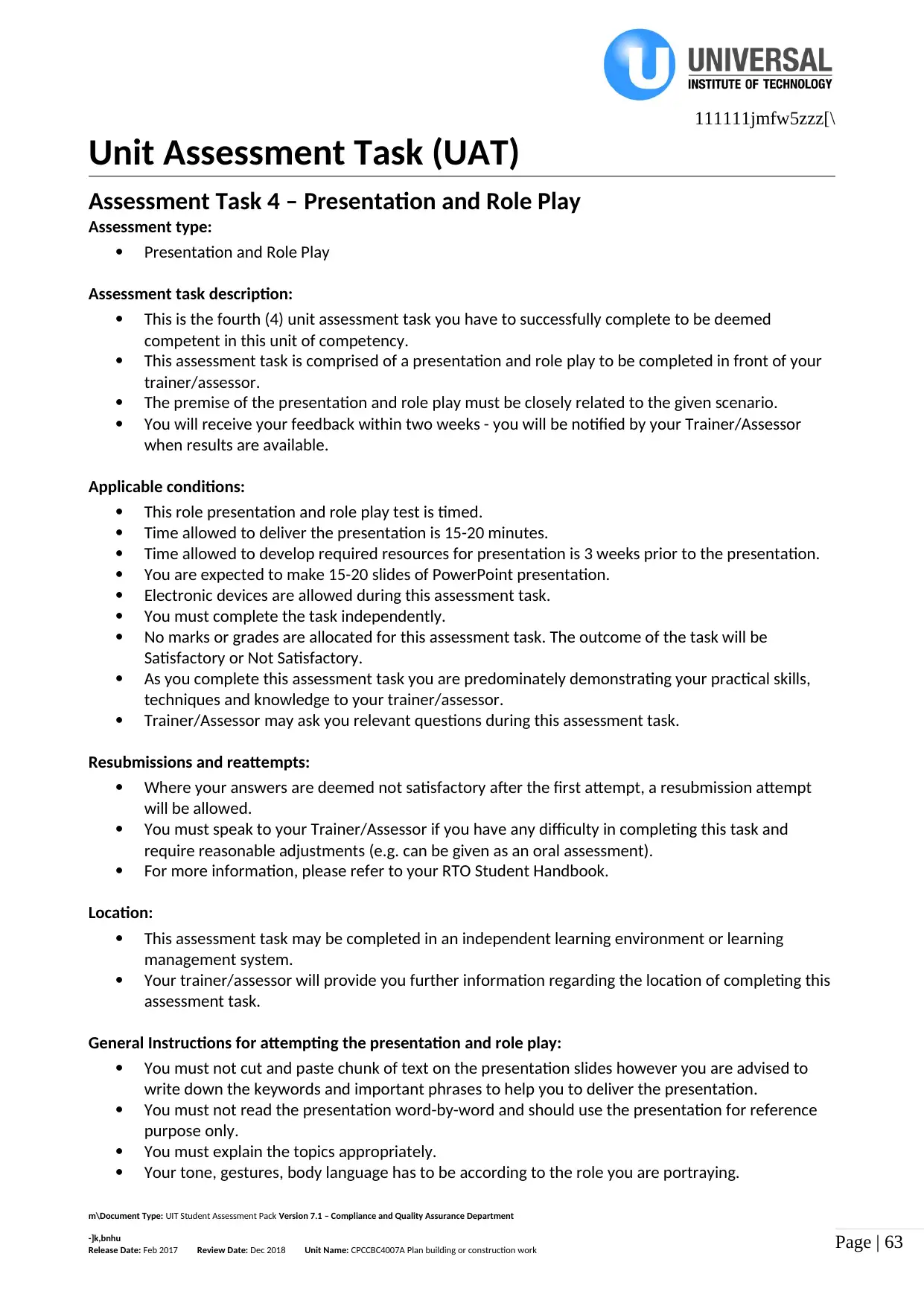
Page | 63
111111jmfw5zzz[\
Unit Assessment Task (UAT)
Assessment Task 4 – Presentation and Role Play
Assessment type:
Presentation and Role Play
Assessment task description:
This is the fourth (4) unit assessment task you have to successfully complete to be deemed
competent in this unit of competency.
This assessment task is comprised of a presentation and role play to be completed in front of your
trainer/assessor.
The premise of the presentation and role play must be closely related to the given scenario.
You will receive your feedback within two weeks - you will be notified by your Trainer/Assessor
when results are available.
Applicable conditions:
This role presentation and role play test is timed.
Time allowed to deliver the presentation is 15-20 minutes.
Time allowed to develop required resources for presentation is 3 weeks prior to the presentation.
You are expected to make 15-20 slides of PowerPoint presentation.
Electronic devices are allowed during this assessment task.
You must complete the task independently.
No marks or grades are allocated for this assessment task. The outcome of the task will be
Satisfactory or Not Satisfactory.
As you complete this assessment task you are predominately demonstrating your practical skills,
techniques and knowledge to your trainer/assessor.
Trainer/Assessor may ask you relevant questions during this assessment task.
Resubmissions and reattempts:
Where your answers are deemed not satisfactory after the first attempt, a resubmission attempt
will be allowed.
You must speak to your Trainer/Assessor if you have any difficulty in completing this task and
require reasonable adjustments (e.g. can be given as an oral assessment).
For more information, please refer to your RTO Student Handbook.
Location:
This assessment task may be completed in an independent learning environment or learning
management system.
Your trainer/assessor will provide you further information regarding the location of completing this
assessment task.
General Instructions for attempting the presentation and role play:
You must not cut and paste chunk of text on the presentation slides however you are advised to
write down the keywords and important phrases to help you to deliver the presentation.
You must not read the presentation word-by-word and should use the presentation for reference
purpose only.
You must explain the topics appropriately.
Your tone, gestures, body language has to be according to the role you are portraying.
m\Document Type: UIT Student Assessment Pack Version 7.1 – Compliance and Quality Assurance Department
-]k,bnhu
Release Date: Feb 2017 Review Date: Dec 2018 Unit Name: CPCCBC4007A Plan building or construction work
111111jmfw5zzz[\
Unit Assessment Task (UAT)
Assessment Task 4 – Presentation and Role Play
Assessment type:
Presentation and Role Play
Assessment task description:
This is the fourth (4) unit assessment task you have to successfully complete to be deemed
competent in this unit of competency.
This assessment task is comprised of a presentation and role play to be completed in front of your
trainer/assessor.
The premise of the presentation and role play must be closely related to the given scenario.
You will receive your feedback within two weeks - you will be notified by your Trainer/Assessor
when results are available.
Applicable conditions:
This role presentation and role play test is timed.
Time allowed to deliver the presentation is 15-20 minutes.
Time allowed to develop required resources for presentation is 3 weeks prior to the presentation.
You are expected to make 15-20 slides of PowerPoint presentation.
Electronic devices are allowed during this assessment task.
You must complete the task independently.
No marks or grades are allocated for this assessment task. The outcome of the task will be
Satisfactory or Not Satisfactory.
As you complete this assessment task you are predominately demonstrating your practical skills,
techniques and knowledge to your trainer/assessor.
Trainer/Assessor may ask you relevant questions during this assessment task.
Resubmissions and reattempts:
Where your answers are deemed not satisfactory after the first attempt, a resubmission attempt
will be allowed.
You must speak to your Trainer/Assessor if you have any difficulty in completing this task and
require reasonable adjustments (e.g. can be given as an oral assessment).
For more information, please refer to your RTO Student Handbook.
Location:
This assessment task may be completed in an independent learning environment or learning
management system.
Your trainer/assessor will provide you further information regarding the location of completing this
assessment task.
General Instructions for attempting the presentation and role play:
You must not cut and paste chunk of text on the presentation slides however you are advised to
write down the keywords and important phrases to help you to deliver the presentation.
You must not read the presentation word-by-word and should use the presentation for reference
purpose only.
You must explain the topics appropriately.
Your tone, gestures, body language has to be according to the role you are portraying.
m\Document Type: UIT Student Assessment Pack Version 7.1 – Compliance and Quality Assurance Department
-]k,bnhu
Release Date: Feb 2017 Review Date: Dec 2018 Unit Name: CPCCBC4007A Plan building or construction work
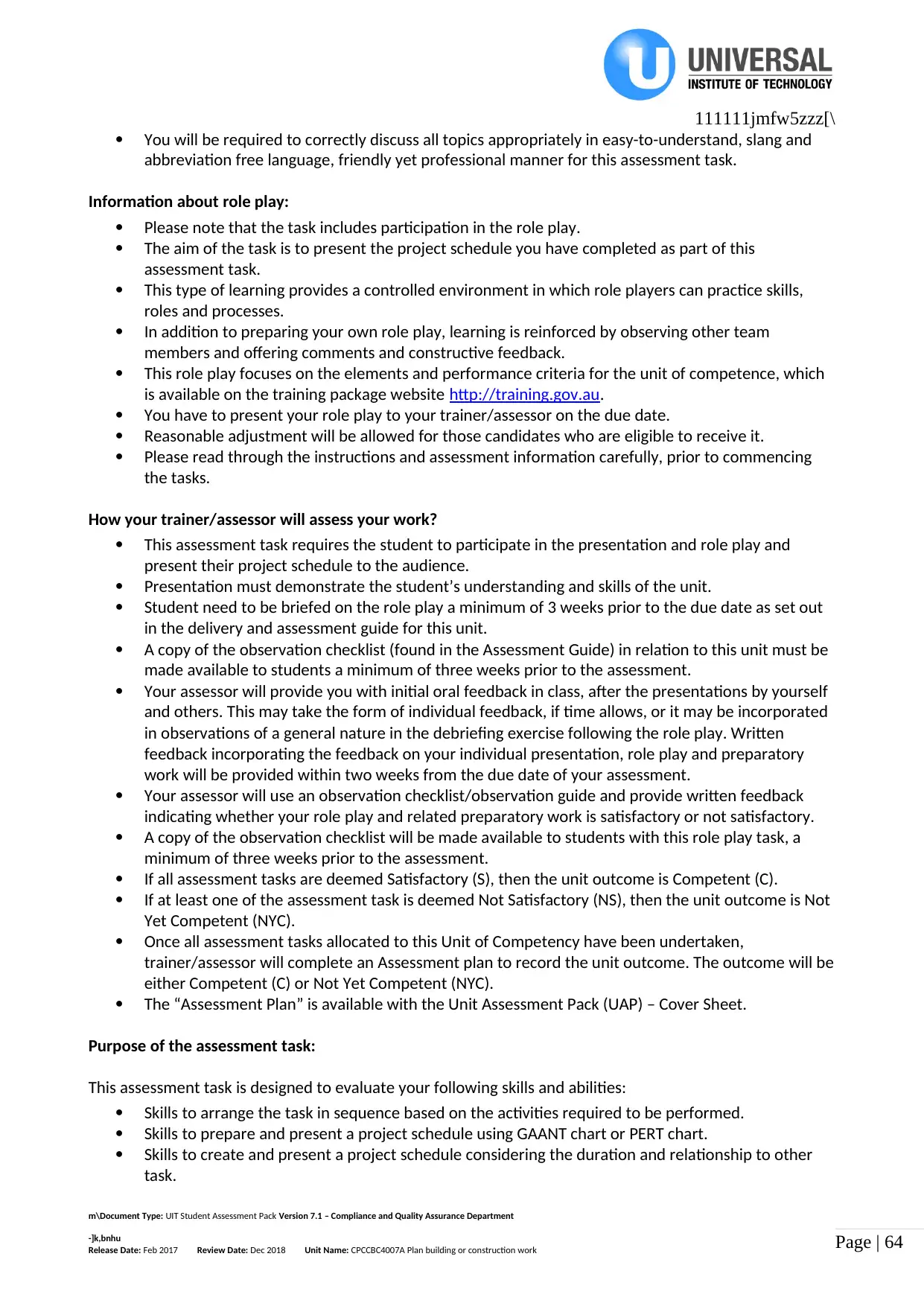
Page | 64
111111jmfw5zzz[\
You will be required to correctly discuss all topics appropriately in easy-to-understand, slang and
abbreviation free language, friendly yet professional manner for this assessment task.
Information about role play:
Please note that the task includes participation in the role play.
The aim of the task is to present the project schedule you have completed as part of this
assessment task.
This type of learning provides a controlled environment in which role players can practice skills,
roles and processes.
In addition to preparing your own role play, learning is reinforced by observing other team
members and offering comments and constructive feedback.
This role play focuses on the elements and performance criteria for the unit of competence, which
is available on the training package website http://training.gov.au.
You have to present your role play to your trainer/assessor on the due date.
Reasonable adjustment will be allowed for those candidates who are eligible to receive it.
Please read through the instructions and assessment information carefully, prior to commencing
the tasks.
How your trainer/assessor will assess your work?
This assessment task requires the student to participate in the presentation and role play and
present their project schedule to the audience.
Presentation must demonstrate the student’s understanding and skills of the unit.
Student need to be briefed on the role play a minimum of 3 weeks prior to the due date as set out
in the delivery and assessment guide for this unit.
A copy of the observation checklist (found in the Assessment Guide) in relation to this unit must be
made available to students a minimum of three weeks prior to the assessment.
Your assessor will provide you with initial oral feedback in class, after the presentations by yourself
and others. This may take the form of individual feedback, if time allows, or it may be incorporated
in observations of a general nature in the debriefing exercise following the role play. Written
feedback incorporating the feedback on your individual presentation, role play and preparatory
work will be provided within two weeks from the due date of your assessment.
Your assessor will use an observation checklist/observation guide and provide written feedback
indicating whether your role play and related preparatory work is satisfactory or not satisfactory.
A copy of the observation checklist will be made available to students with this role play task, a
minimum of three weeks prior to the assessment.
If all assessment tasks are deemed Satisfactory (S), then the unit outcome is Competent (C).
If at least one of the assessment task is deemed Not Satisfactory (NS), then the unit outcome is Not
Yet Competent (NYC).
Once all assessment tasks allocated to this Unit of Competency have been undertaken,
trainer/assessor will complete an Assessment plan to record the unit outcome. The outcome will be
either Competent (C) or Not Yet Competent (NYC).
The “Assessment Plan” is available with the Unit Assessment Pack (UAP) – Cover Sheet.
Purpose of the assessment task:
This assessment task is designed to evaluate your following skills and abilities:
Skills to arrange the task in sequence based on the activities required to be performed.
Skills to prepare and present a project schedule using GAANT chart or PERT chart.
Skills to create and present a project schedule considering the duration and relationship to other
task.
m\Document Type: UIT Student Assessment Pack Version 7.1 – Compliance and Quality Assurance Department
-]k,bnhu
Release Date: Feb 2017 Review Date: Dec 2018 Unit Name: CPCCBC4007A Plan building or construction work
111111jmfw5zzz[\
You will be required to correctly discuss all topics appropriately in easy-to-understand, slang and
abbreviation free language, friendly yet professional manner for this assessment task.
Information about role play:
Please note that the task includes participation in the role play.
The aim of the task is to present the project schedule you have completed as part of this
assessment task.
This type of learning provides a controlled environment in which role players can practice skills,
roles and processes.
In addition to preparing your own role play, learning is reinforced by observing other team
members and offering comments and constructive feedback.
This role play focuses on the elements and performance criteria for the unit of competence, which
is available on the training package website http://training.gov.au.
You have to present your role play to your trainer/assessor on the due date.
Reasonable adjustment will be allowed for those candidates who are eligible to receive it.
Please read through the instructions and assessment information carefully, prior to commencing
the tasks.
How your trainer/assessor will assess your work?
This assessment task requires the student to participate in the presentation and role play and
present their project schedule to the audience.
Presentation must demonstrate the student’s understanding and skills of the unit.
Student need to be briefed on the role play a minimum of 3 weeks prior to the due date as set out
in the delivery and assessment guide for this unit.
A copy of the observation checklist (found in the Assessment Guide) in relation to this unit must be
made available to students a minimum of three weeks prior to the assessment.
Your assessor will provide you with initial oral feedback in class, after the presentations by yourself
and others. This may take the form of individual feedback, if time allows, or it may be incorporated
in observations of a general nature in the debriefing exercise following the role play. Written
feedback incorporating the feedback on your individual presentation, role play and preparatory
work will be provided within two weeks from the due date of your assessment.
Your assessor will use an observation checklist/observation guide and provide written feedback
indicating whether your role play and related preparatory work is satisfactory or not satisfactory.
A copy of the observation checklist will be made available to students with this role play task, a
minimum of three weeks prior to the assessment.
If all assessment tasks are deemed Satisfactory (S), then the unit outcome is Competent (C).
If at least one of the assessment task is deemed Not Satisfactory (NS), then the unit outcome is Not
Yet Competent (NYC).
Once all assessment tasks allocated to this Unit of Competency have been undertaken,
trainer/assessor will complete an Assessment plan to record the unit outcome. The outcome will be
either Competent (C) or Not Yet Competent (NYC).
The “Assessment Plan” is available with the Unit Assessment Pack (UAP) – Cover Sheet.
Purpose of the assessment task:
This assessment task is designed to evaluate your following skills and abilities:
Skills to arrange the task in sequence based on the activities required to be performed.
Skills to prepare and present a project schedule using GAANT chart or PERT chart.
Skills to create and present a project schedule considering the duration and relationship to other
task.
m\Document Type: UIT Student Assessment Pack Version 7.1 – Compliance and Quality Assurance Department
-]k,bnhu
Release Date: Feb 2017 Review Date: Dec 2018 Unit Name: CPCCBC4007A Plan building or construction work
Secure Best Marks with AI Grader
Need help grading? Try our AI Grader for instant feedback on your assignments.
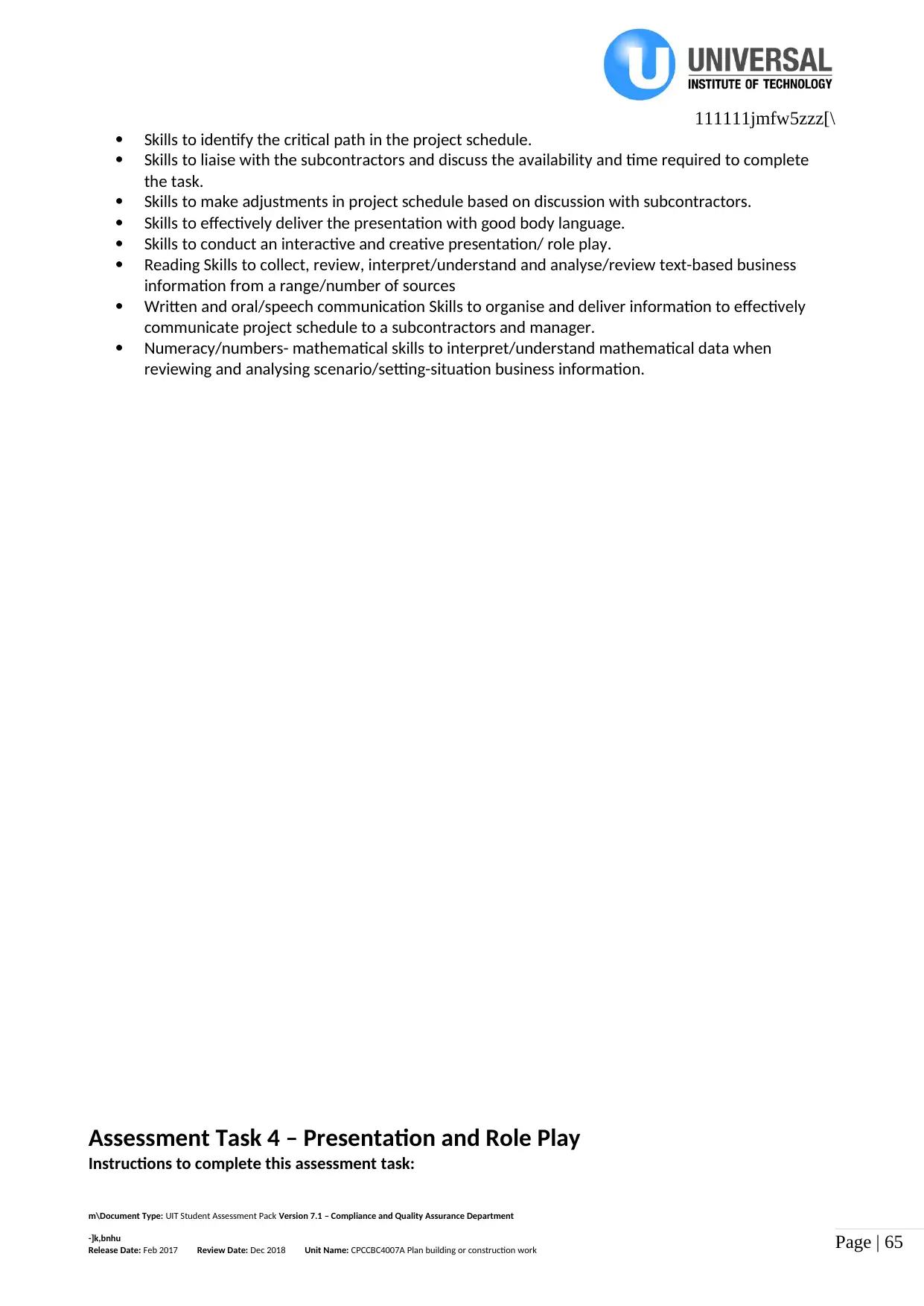
Page | 65
111111jmfw5zzz[\
Skills to identify the critical path in the project schedule.
Skills to liaise with the subcontractors and discuss the availability and time required to complete
the task.
Skills to make adjustments in project schedule based on discussion with subcontractors.
Skills to effectively deliver the presentation with good body language.
Skills to conduct an interactive and creative presentation/ role play.
Reading Skills to collect, review, interpret/understand and analyse/review text-based business
information from a range/number of sources
Written and oral/speech communication Skills to organise and deliver information to effectively
communicate project schedule to a subcontractors and manager.
Numeracy/numbers- mathematical skills to interpret/understand mathematical data when
reviewing and analysing scenario/setting-situation business information.
Assessment Task 4 – Presentation and Role Play
Instructions to complete this assessment task:
m\Document Type: UIT Student Assessment Pack Version 7.1 – Compliance and Quality Assurance Department
-]k,bnhu
Release Date: Feb 2017 Review Date: Dec 2018 Unit Name: CPCCBC4007A Plan building or construction work
111111jmfw5zzz[\
Skills to identify the critical path in the project schedule.
Skills to liaise with the subcontractors and discuss the availability and time required to complete
the task.
Skills to make adjustments in project schedule based on discussion with subcontractors.
Skills to effectively deliver the presentation with good body language.
Skills to conduct an interactive and creative presentation/ role play.
Reading Skills to collect, review, interpret/understand and analyse/review text-based business
information from a range/number of sources
Written and oral/speech communication Skills to organise and deliver information to effectively
communicate project schedule to a subcontractors and manager.
Numeracy/numbers- mathematical skills to interpret/understand mathematical data when
reviewing and analysing scenario/setting-situation business information.
Assessment Task 4 – Presentation and Role Play
Instructions to complete this assessment task:
m\Document Type: UIT Student Assessment Pack Version 7.1 – Compliance and Quality Assurance Department
-]k,bnhu
Release Date: Feb 2017 Review Date: Dec 2018 Unit Name: CPCCBC4007A Plan building or construction work
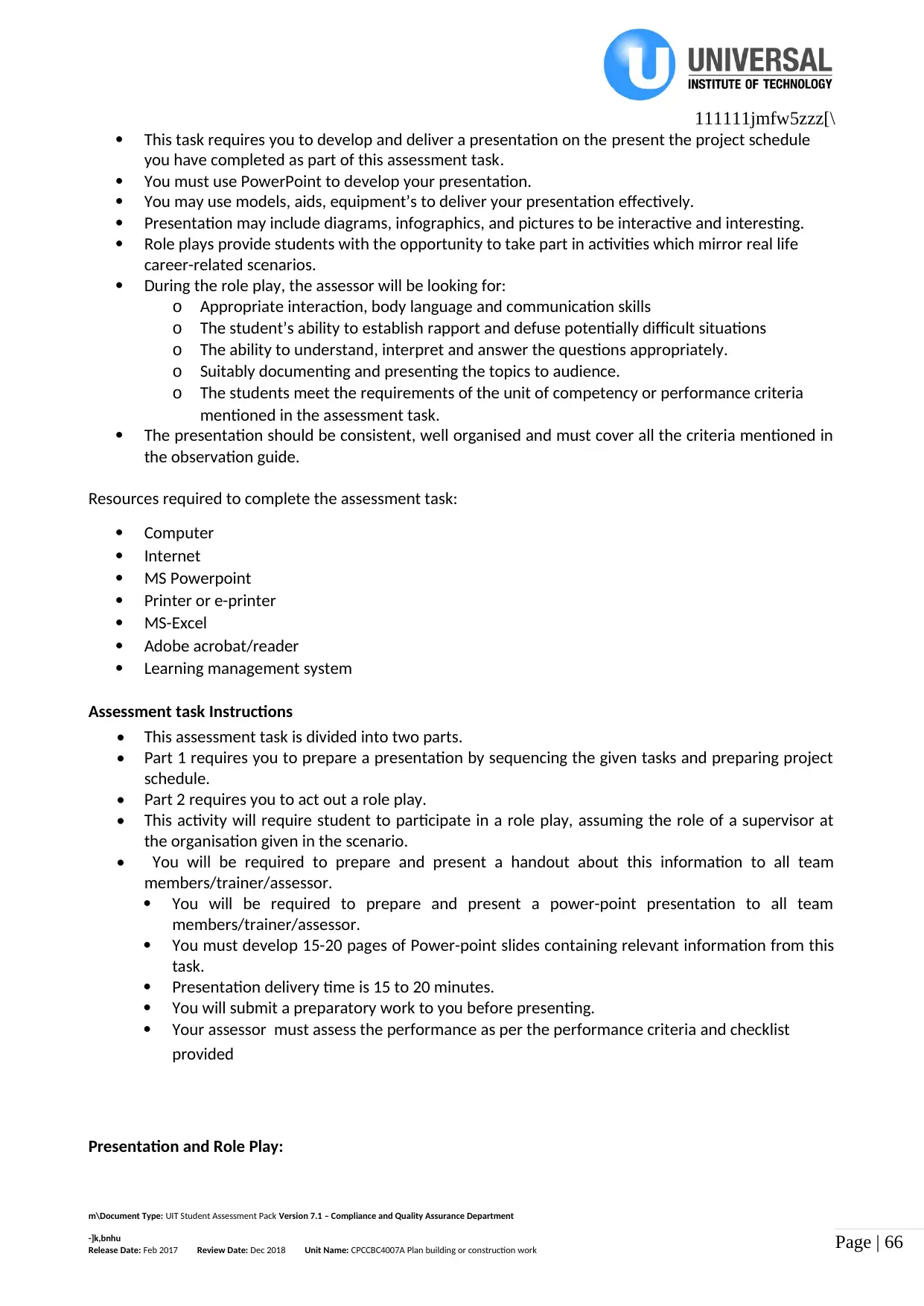
Page | 66
111111jmfw5zzz[\
This task requires you to develop and deliver a presentation on the present the project schedule
you have completed as part of this assessment task.
You must use PowerPoint to develop your presentation.
You may use models, aids, equipment’s to deliver your presentation effectively.
Presentation may include diagrams, infographics, and pictures to be interactive and interesting.
Role plays provide students with the opportunity to take part in activities which mirror real life
career-related scenarios.
During the role play, the assessor will be looking for:
o Appropriate interaction, body language and communication skills
o The student’s ability to establish rapport and defuse potentially difficult situations
o The ability to understand, interpret and answer the questions appropriately.
o Suitably documenting and presenting the topics to audience.
o The students meet the requirements of the unit of competency or performance criteria
mentioned in the assessment task.
The presentation should be consistent, well organised and must cover all the criteria mentioned in
the observation guide.
Resources required to complete the assessment task:
Computer
Internet
MS Powerpoint
Printer or e-printer
MS-Excel
Adobe acrobat/reader
Learning management system
Assessment task Instructions
• This assessment task is divided into two parts.
• Part 1 requires you to prepare a presentation by sequencing the given tasks and preparing project
schedule.
• Part 2 requires you to act out a role play.
• This activity will require student to participate in a role play, assuming the role of a supervisor at
the organisation given in the scenario.
• You will be required to prepare and present a handout about this information to all team
members/trainer/assessor.
You will be required to prepare and present a power-point presentation to all team
members/trainer/assessor.
You must develop 15-20 pages of Power-point slides containing relevant information from this
task.
Presentation delivery time is 15 to 20 minutes.
You will submit a preparatory work to you before presenting.
Your assessor must assess the performance as per the performance criteria and checklist
provided
Presentation and Role Play:
m\Document Type: UIT Student Assessment Pack Version 7.1 – Compliance and Quality Assurance Department
-]k,bnhu
Release Date: Feb 2017 Review Date: Dec 2018 Unit Name: CPCCBC4007A Plan building or construction work
111111jmfw5zzz[\
This task requires you to develop and deliver a presentation on the present the project schedule
you have completed as part of this assessment task.
You must use PowerPoint to develop your presentation.
You may use models, aids, equipment’s to deliver your presentation effectively.
Presentation may include diagrams, infographics, and pictures to be interactive and interesting.
Role plays provide students with the opportunity to take part in activities which mirror real life
career-related scenarios.
During the role play, the assessor will be looking for:
o Appropriate interaction, body language and communication skills
o The student’s ability to establish rapport and defuse potentially difficult situations
o The ability to understand, interpret and answer the questions appropriately.
o Suitably documenting and presenting the topics to audience.
o The students meet the requirements of the unit of competency or performance criteria
mentioned in the assessment task.
The presentation should be consistent, well organised and must cover all the criteria mentioned in
the observation guide.
Resources required to complete the assessment task:
Computer
Internet
MS Powerpoint
Printer or e-printer
MS-Excel
Adobe acrobat/reader
Learning management system
Assessment task Instructions
• This assessment task is divided into two parts.
• Part 1 requires you to prepare a presentation by sequencing the given tasks and preparing project
schedule.
• Part 2 requires you to act out a role play.
• This activity will require student to participate in a role play, assuming the role of a supervisor at
the organisation given in the scenario.
• You will be required to prepare and present a handout about this information to all team
members/trainer/assessor.
You will be required to prepare and present a power-point presentation to all team
members/trainer/assessor.
You must develop 15-20 pages of Power-point slides containing relevant information from this
task.
Presentation delivery time is 15 to 20 minutes.
You will submit a preparatory work to you before presenting.
Your assessor must assess the performance as per the performance criteria and checklist
provided
Presentation and Role Play:
m\Document Type: UIT Student Assessment Pack Version 7.1 – Compliance and Quality Assurance Department
-]k,bnhu
Release Date: Feb 2017 Review Date: Dec 2018 Unit Name: CPCCBC4007A Plan building or construction work
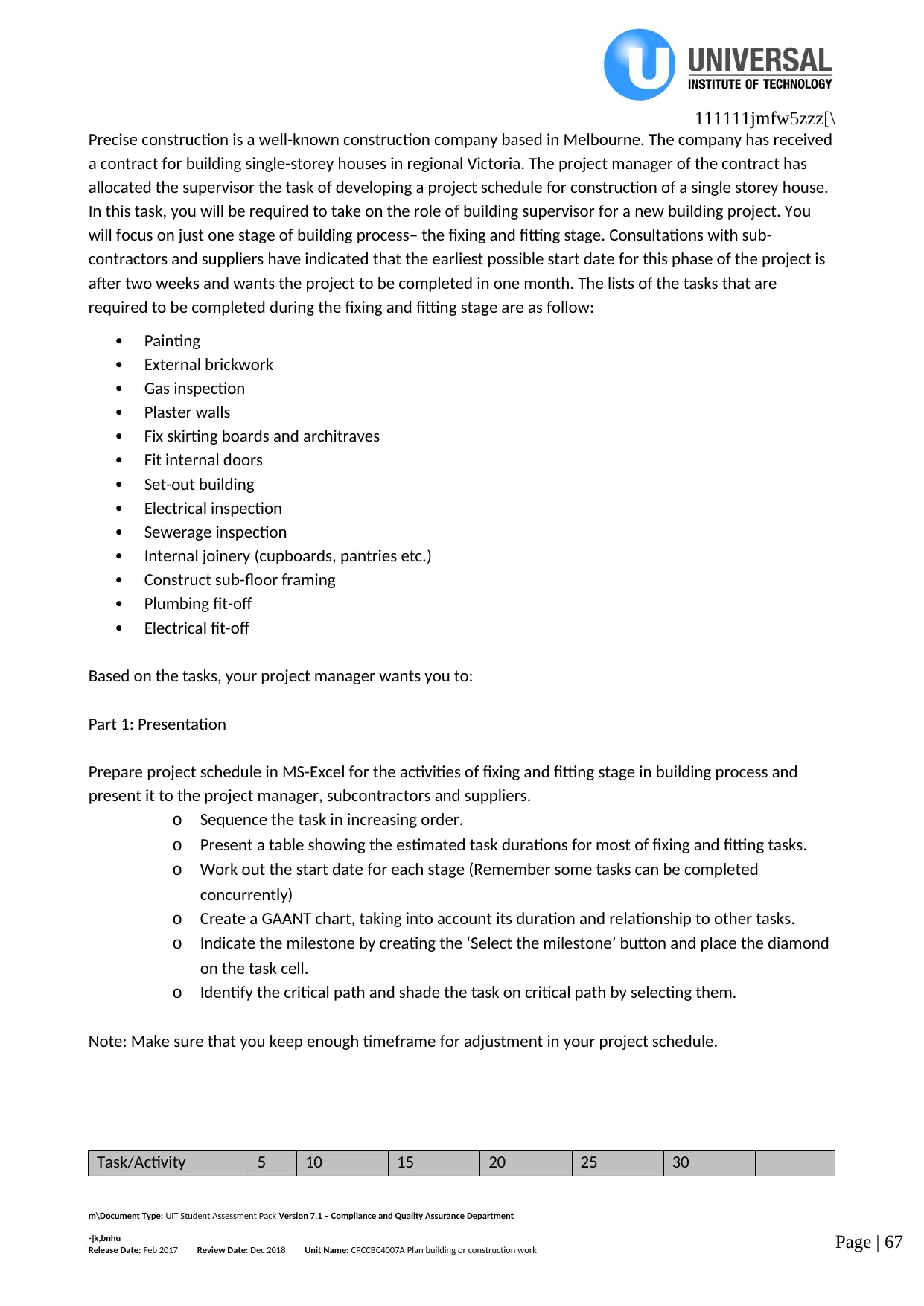
Page | 67
111111jmfw5zzz[\
Precise construction is a well-known construction company based in Melbourne. The company has received
a contract for building single-storey houses in regional Victoria. The project manager of the contract has
allocated the supervisor the task of developing a project schedule for construction of a single storey house.
In this task, you will be required to take on the role of building supervisor for a new building project. You
will focus on just one stage of building process– the fixing and fitting stage. Consultations with sub-
contractors and suppliers have indicated that the earliest possible start date for this phase of the project is
after two weeks and wants the project to be completed in one month. The lists of the tasks that are
required to be completed during the fixing and fitting stage are as follow:
Painting
External brickwork
Gas inspection
Plaster walls
Fix skirting boards and architraves
Fit internal doors
Set-out building
Electrical inspection
Sewerage inspection
Internal joinery (cupboards, pantries etc.)
Construct sub-floor framing
Plumbing fit-off
Electrical fit-off
Based on the tasks, your project manager wants you to:
Part 1: Presentation
Prepare project schedule in MS-Excel for the activities of fixing and fitting stage in building process and
present it to the project manager, subcontractors and suppliers.
o Sequence the task in increasing order.
o Present a table showing the estimated task durations for most of fixing and fitting tasks.
o Work out the start date for each stage (Remember some tasks can be completed
concurrently)
o Create a GAANT chart, taking into account its duration and relationship to other tasks.
o Indicate the milestone by creating the ‘Select the milestone’ button and place the diamond
on the task cell.
o Identify the critical path and shade the task on critical path by selecting them.
Note: Make sure that you keep enough timeframe for adjustment in your project schedule.
Task/Activity 5 10 15 20 25 30
m\Document Type: UIT Student Assessment Pack Version 7.1 – Compliance and Quality Assurance Department
-]k,bnhu
Release Date: Feb 2017 Review Date: Dec 2018 Unit Name: CPCCBC4007A Plan building or construction work
111111jmfw5zzz[\
Precise construction is a well-known construction company based in Melbourne. The company has received
a contract for building single-storey houses in regional Victoria. The project manager of the contract has
allocated the supervisor the task of developing a project schedule for construction of a single storey house.
In this task, you will be required to take on the role of building supervisor for a new building project. You
will focus on just one stage of building process– the fixing and fitting stage. Consultations with sub-
contractors and suppliers have indicated that the earliest possible start date for this phase of the project is
after two weeks and wants the project to be completed in one month. The lists of the tasks that are
required to be completed during the fixing and fitting stage are as follow:
Painting
External brickwork
Gas inspection
Plaster walls
Fix skirting boards and architraves
Fit internal doors
Set-out building
Electrical inspection
Sewerage inspection
Internal joinery (cupboards, pantries etc.)
Construct sub-floor framing
Plumbing fit-off
Electrical fit-off
Based on the tasks, your project manager wants you to:
Part 1: Presentation
Prepare project schedule in MS-Excel for the activities of fixing and fitting stage in building process and
present it to the project manager, subcontractors and suppliers.
o Sequence the task in increasing order.
o Present a table showing the estimated task durations for most of fixing and fitting tasks.
o Work out the start date for each stage (Remember some tasks can be completed
concurrently)
o Create a GAANT chart, taking into account its duration and relationship to other tasks.
o Indicate the milestone by creating the ‘Select the milestone’ button and place the diamond
on the task cell.
o Identify the critical path and shade the task on critical path by selecting them.
Note: Make sure that you keep enough timeframe for adjustment in your project schedule.
Task/Activity 5 10 15 20 25 30
m\Document Type: UIT Student Assessment Pack Version 7.1 – Compliance and Quality Assurance Department
-]k,bnhu
Release Date: Feb 2017 Review Date: Dec 2018 Unit Name: CPCCBC4007A Plan building or construction work
Paraphrase This Document
Need a fresh take? Get an instant paraphrase of this document with our AI Paraphraser
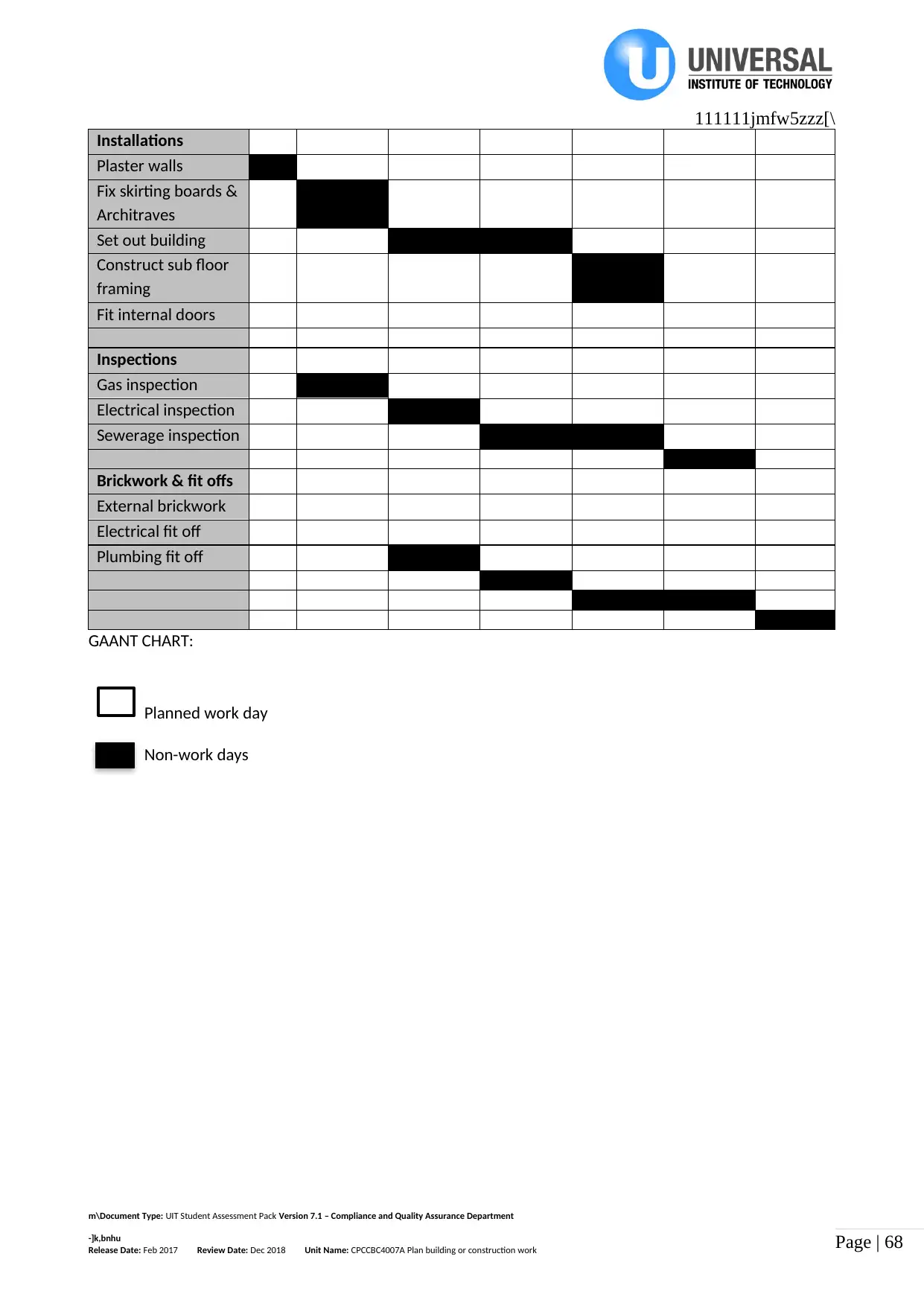
Page | 68
111111jmfw5zzz[\
Installations
Plaster walls
Fix skirting boards &
Architraves
Set out building
Construct sub floor
framing
Fit internal doors
Inspections
Gas inspection
Electrical inspection
Sewerage inspection
Brickwork & fit offs
External brickwork
Electrical fit off
Plumbing fit off
GAANT CHART:
Planned work day
Non-work days
m\Document Type: UIT Student Assessment Pack Version 7.1 – Compliance and Quality Assurance Department
-]k,bnhu
Release Date: Feb 2017 Review Date: Dec 2018 Unit Name: CPCCBC4007A Plan building or construction work
111111jmfw5zzz[\
Installations
Plaster walls
Fix skirting boards &
Architraves
Set out building
Construct sub floor
framing
Fit internal doors
Inspections
Gas inspection
Electrical inspection
Sewerage inspection
Brickwork & fit offs
External brickwork
Electrical fit off
Plumbing fit off
GAANT CHART:
Planned work day
Non-work days
m\Document Type: UIT Student Assessment Pack Version 7.1 – Compliance and Quality Assurance Department
-]k,bnhu
Release Date: Feb 2017 Review Date: Dec 2018 Unit Name: CPCCBC4007A Plan building or construction work
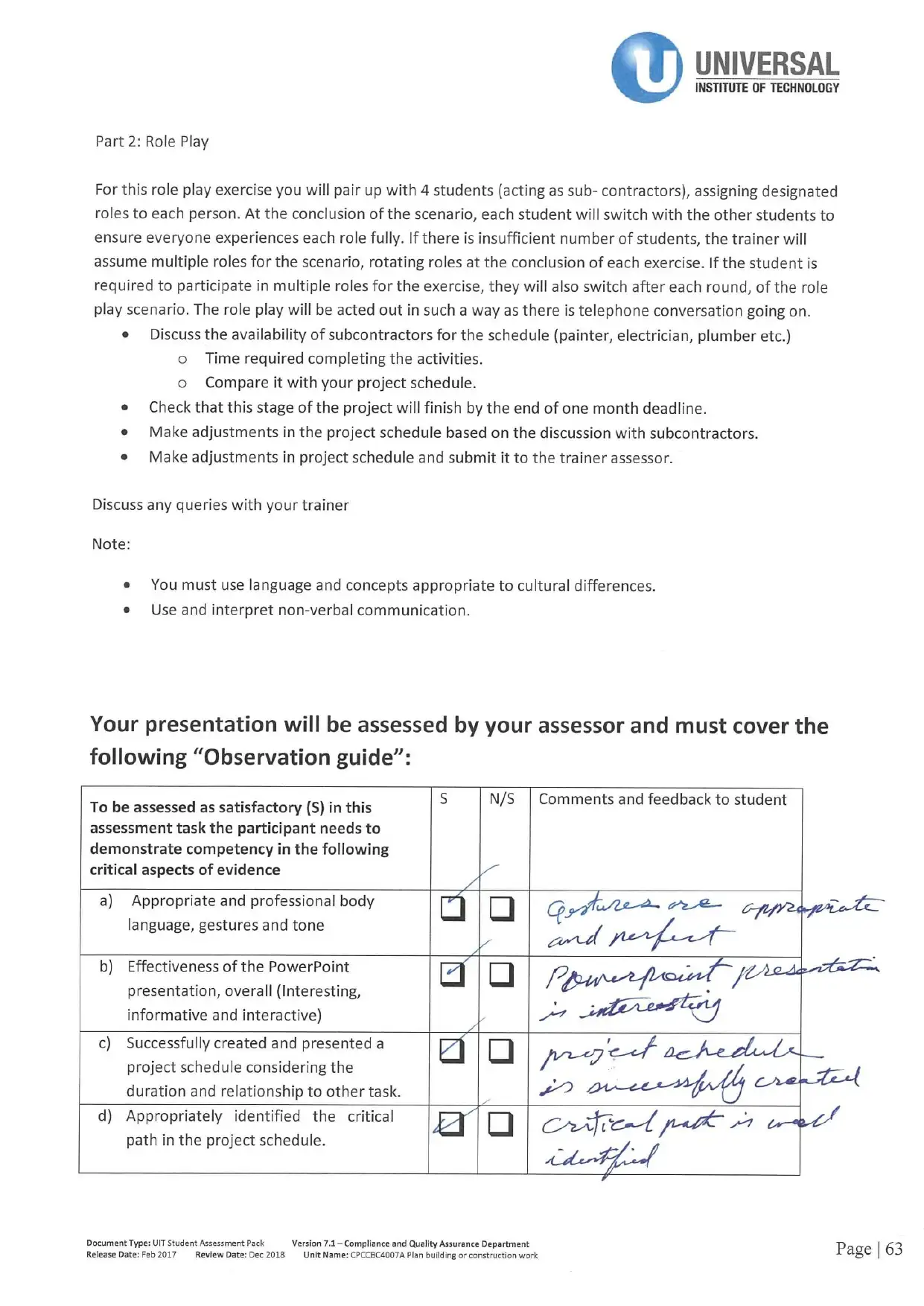
Page | 69
111111jmfw5zzz[\
m\Document Type: UIT Student Assessment Pack Version 7.1 – Compliance and Quality Assurance Department
-]k,bnhu
Release Date: Feb 2017 Review Date: Dec 2018 Unit Name: CPCCBC4007A Plan building or construction work
111111jmfw5zzz[\
m\Document Type: UIT Student Assessment Pack Version 7.1 – Compliance and Quality Assurance Department
-]k,bnhu
Release Date: Feb 2017 Review Date: Dec 2018 Unit Name: CPCCBC4007A Plan building or construction work
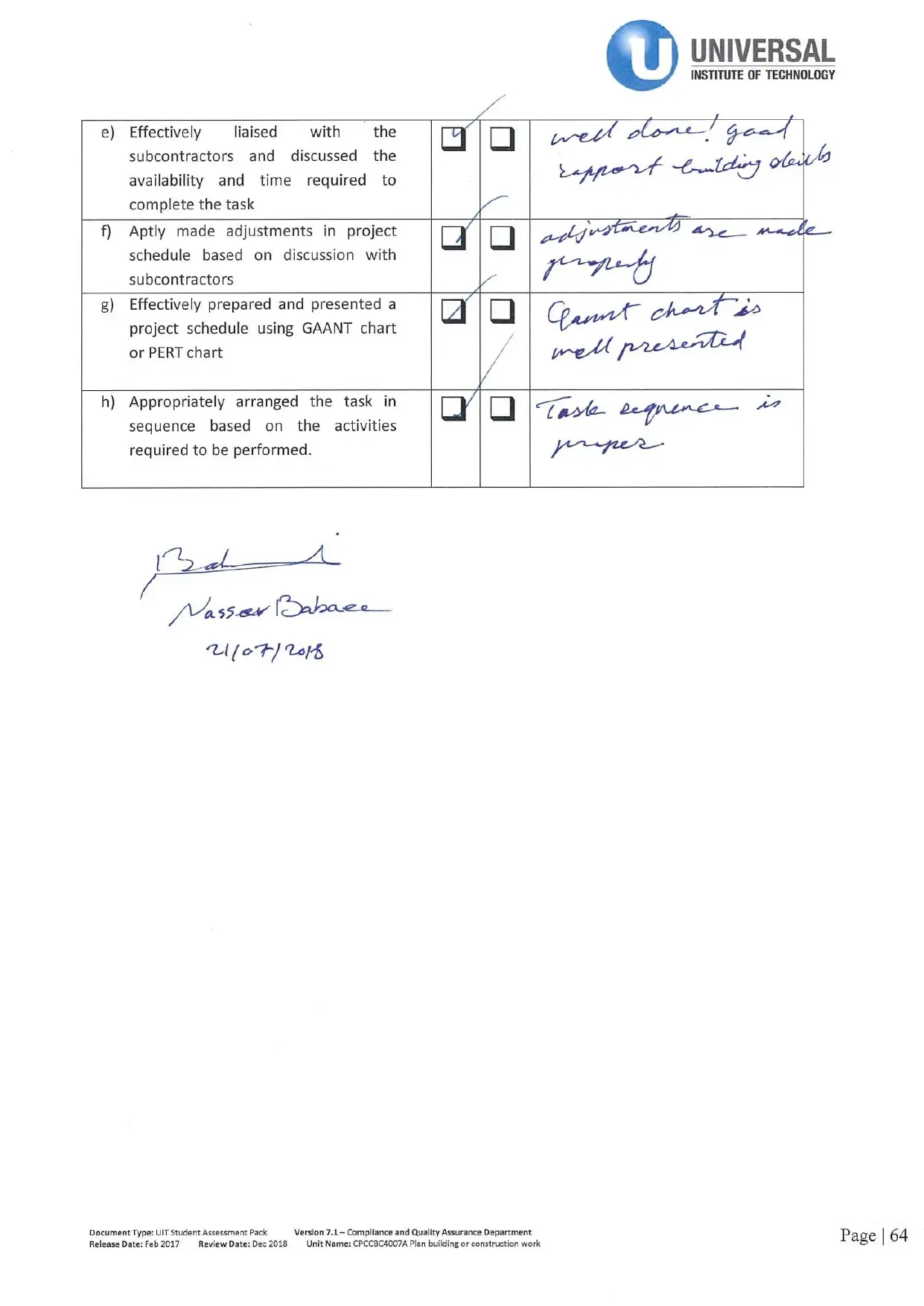
Page | 70
111111jmfw5zzz[\
m\Document Type: UIT Student Assessment Pack Version 7.1 – Compliance and Quality Assurance Department
-]k,bnhu
Release Date: Feb 2017 Review Date: Dec 2018 Unit Name: CPCCBC4007A Plan building or construction work
111111jmfw5zzz[\
m\Document Type: UIT Student Assessment Pack Version 7.1 – Compliance and Quality Assurance Department
-]k,bnhu
Release Date: Feb 2017 Review Date: Dec 2018 Unit Name: CPCCBC4007A Plan building or construction work
Secure Best Marks with AI Grader
Need help grading? Try our AI Grader for instant feedback on your assignments.
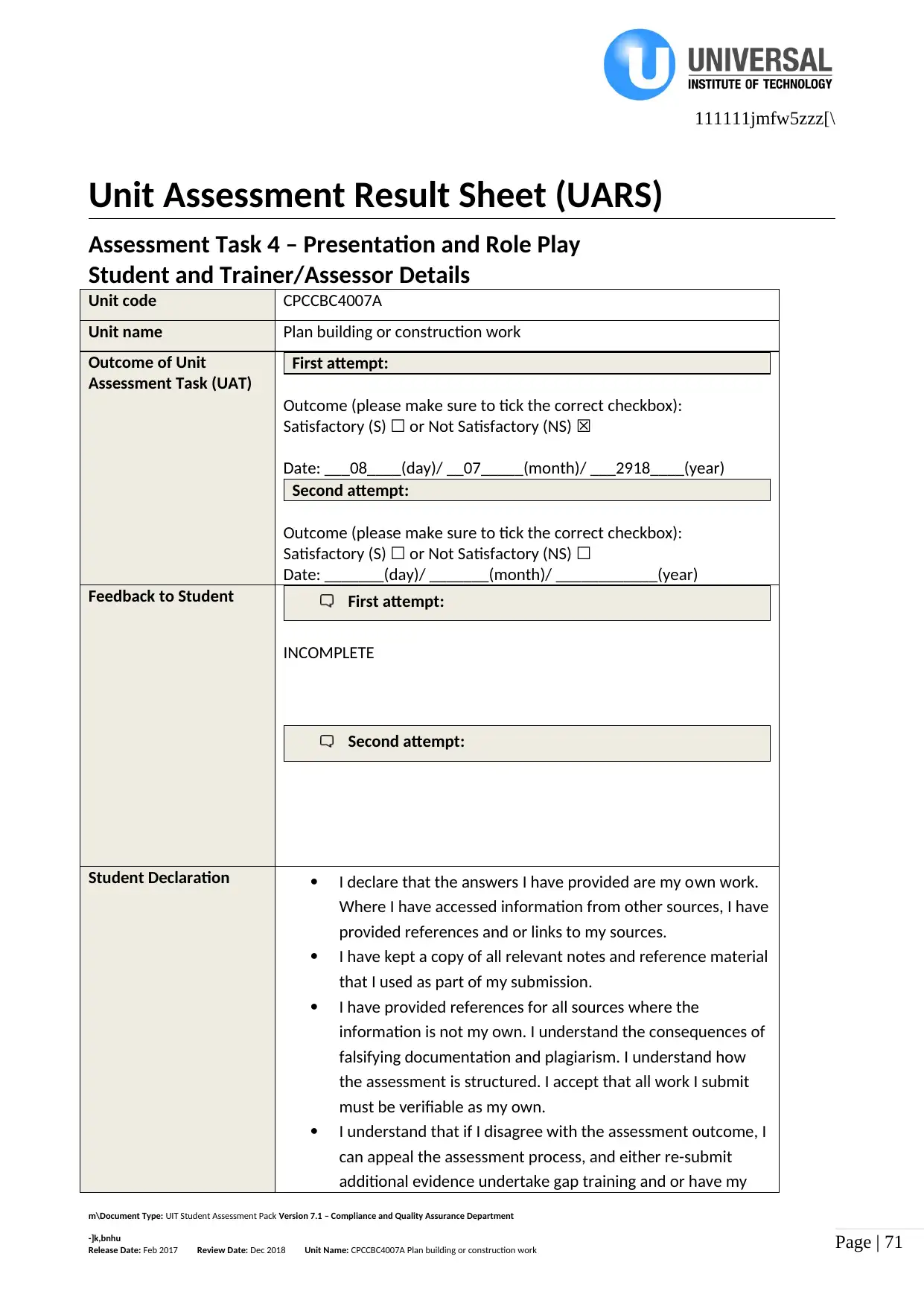
Page | 71
111111jmfw5zzz[\
Unit Assessment Result Sheet (UARS)
Assessment Task 4 – Presentation and Role Play
Student and Trainer/Assessor Details
Unit code CPCCBC4007A
Unit name Plan building or construction work
Outcome of Unit
Assessment Task (UAT)
First attempt:
Outcome (please make sure to tick the correct checkbox):
Satisfactory (S) ☐ or Not Satisfactory (NS) ☒
Date: ___08____(day)/ __07_____(month)/ ___2918____(year)
Second attempt:
Outcome (please make sure to tick the correct checkbox):
Satisfactory (S) ☐ or Not Satisfactory (NS) ☐
Date: _______(day)/ _______(month)/ ____________(year)
Feedback to Student First attempt:
INCOMPLETE
Second attempt:
Student Declaration I declare that the answers I have provided are my own work.
Where I have accessed information from other sources, I have
provided references and or links to my sources.
I have kept a copy of all relevant notes and reference material
that I used as part of my submission.
I have provided references for all sources where the
information is not my own. I understand the consequences of
falsifying documentation and plagiarism. I understand how
the assessment is structured. I accept that all work I submit
must be verifiable as my own.
I understand that if I disagree with the assessment outcome, I
can appeal the assessment process, and either re-submit
additional evidence undertake gap training and or have my
m\Document Type: UIT Student Assessment Pack Version 7.1 – Compliance and Quality Assurance Department
-]k,bnhu
Release Date: Feb 2017 Review Date: Dec 2018 Unit Name: CPCCBC4007A Plan building or construction work
111111jmfw5zzz[\
Unit Assessment Result Sheet (UARS)
Assessment Task 4 – Presentation and Role Play
Student and Trainer/Assessor Details
Unit code CPCCBC4007A
Unit name Plan building or construction work
Outcome of Unit
Assessment Task (UAT)
First attempt:
Outcome (please make sure to tick the correct checkbox):
Satisfactory (S) ☐ or Not Satisfactory (NS) ☒
Date: ___08____(day)/ __07_____(month)/ ___2918____(year)
Second attempt:
Outcome (please make sure to tick the correct checkbox):
Satisfactory (S) ☐ or Not Satisfactory (NS) ☐
Date: _______(day)/ _______(month)/ ____________(year)
Feedback to Student First attempt:
INCOMPLETE
Second attempt:
Student Declaration I declare that the answers I have provided are my own work.
Where I have accessed information from other sources, I have
provided references and or links to my sources.
I have kept a copy of all relevant notes and reference material
that I used as part of my submission.
I have provided references for all sources where the
information is not my own. I understand the consequences of
falsifying documentation and plagiarism. I understand how
the assessment is structured. I accept that all work I submit
must be verifiable as my own.
I understand that if I disagree with the assessment outcome, I
can appeal the assessment process, and either re-submit
additional evidence undertake gap training and or have my
m\Document Type: UIT Student Assessment Pack Version 7.1 – Compliance and Quality Assurance Department
-]k,bnhu
Release Date: Feb 2017 Review Date: Dec 2018 Unit Name: CPCCBC4007A Plan building or construction work

Page | 72
111111jmfw5zzz[\
submission re-assessed.
All appeal options have been explained to me.
Student Signature
Date
Trainer/Assessor Name NASSER BABAEE
Trainer/Assessor
Declaration
I hold:
Vocational competencies at least to the level being delivered
Current relevant industry skills
Current knowledge and skills in VET, and undertake
Ongoing professional development in VET
I declare that I have conducted an assessment of this candidate’s
submission. The assessment tasks were deemed current, sufficient,
valid and reliable. I declare that I have conducted a fair, valid, reliable,
and flexible assessment. I have provided feedback to the above-
named candidate.
Trainer/Assessor
Signature
Date 08/08/2018
Office Use Only Outcome of Assessment has been entered onto the Student
Management System on _________________ (insert date)
by (insert Name) __________________________________
m\Document Type: UIT Student Assessment Pack Version 7.1 – Compliance and Quality Assurance Department
-]k,bnhu
Release Date: Feb 2017 Review Date: Dec 2018 Unit Name: CPCCBC4007A Plan building or construction work
111111jmfw5zzz[\
submission re-assessed.
All appeal options have been explained to me.
Student Signature
Date
Trainer/Assessor Name NASSER BABAEE
Trainer/Assessor
Declaration
I hold:
Vocational competencies at least to the level being delivered
Current relevant industry skills
Current knowledge and skills in VET, and undertake
Ongoing professional development in VET
I declare that I have conducted an assessment of this candidate’s
submission. The assessment tasks were deemed current, sufficient,
valid and reliable. I declare that I have conducted a fair, valid, reliable,
and flexible assessment. I have provided feedback to the above-
named candidate.
Trainer/Assessor
Signature
Date 08/08/2018
Office Use Only Outcome of Assessment has been entered onto the Student
Management System on _________________ (insert date)
by (insert Name) __________________________________
m\Document Type: UIT Student Assessment Pack Version 7.1 – Compliance and Quality Assurance Department
-]k,bnhu
Release Date: Feb 2017 Review Date: Dec 2018 Unit Name: CPCCBC4007A Plan building or construction work
1 out of 72
Related Documents
Your All-in-One AI-Powered Toolkit for Academic Success.
+13062052269
info@desklib.com
Available 24*7 on WhatsApp / Email
![[object Object]](/_next/static/media/star-bottom.7253800d.svg)
Unlock your academic potential
© 2024 | Zucol Services PVT LTD | All rights reserved.




